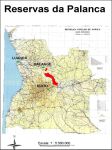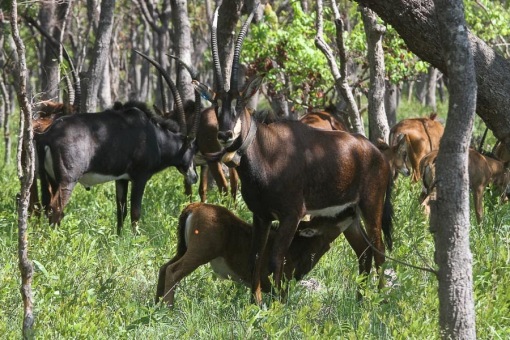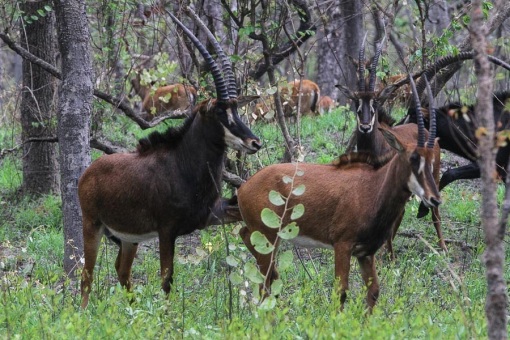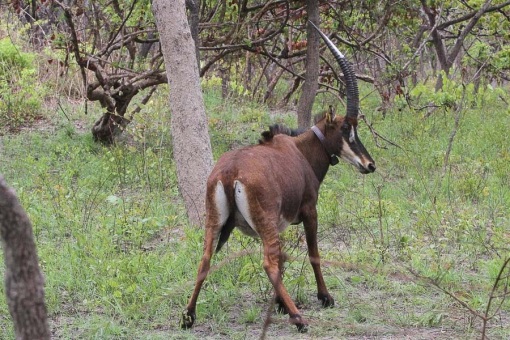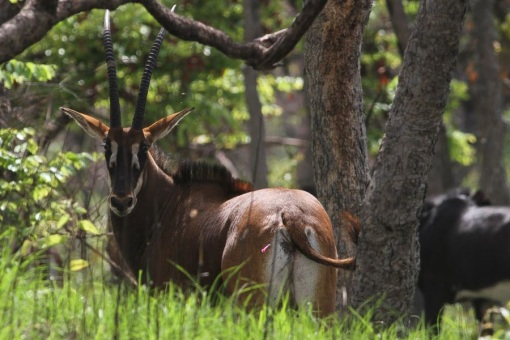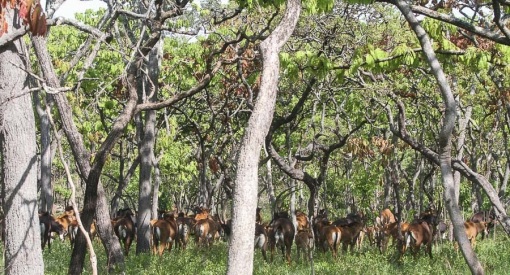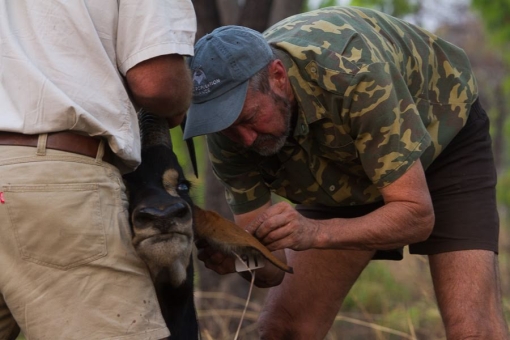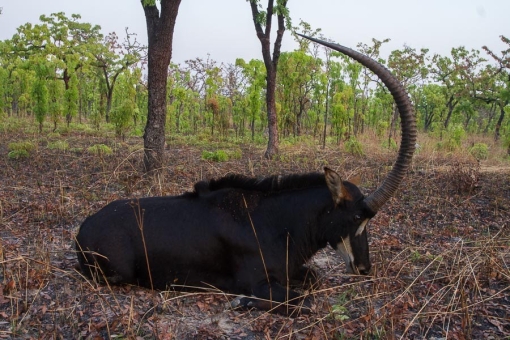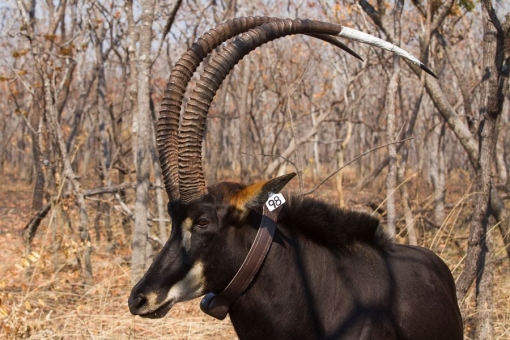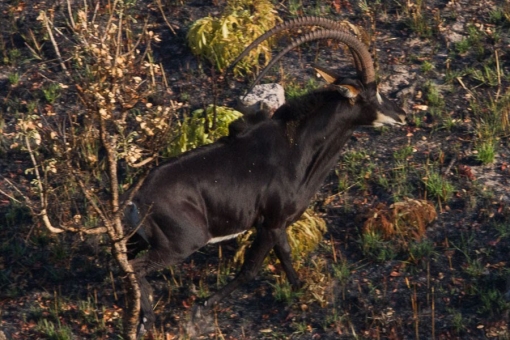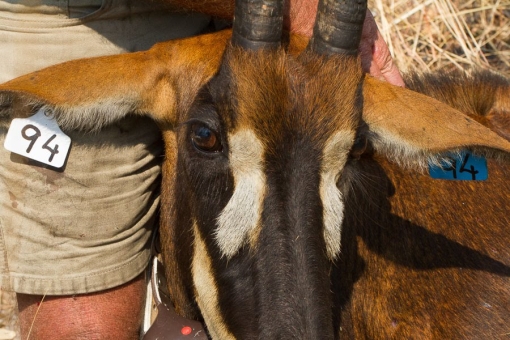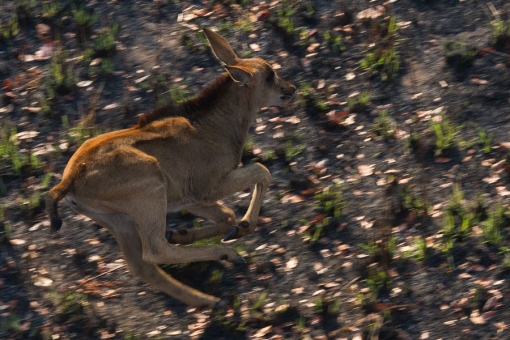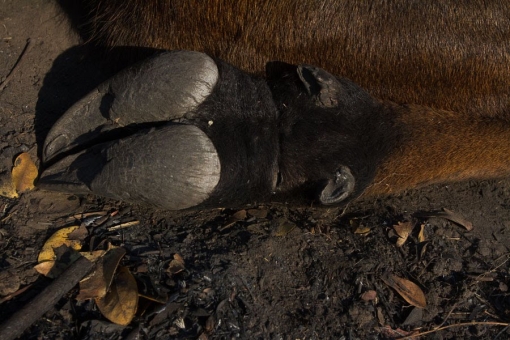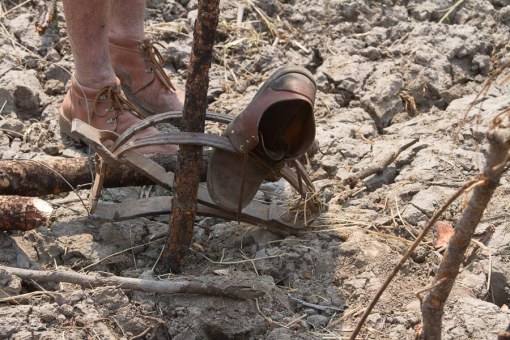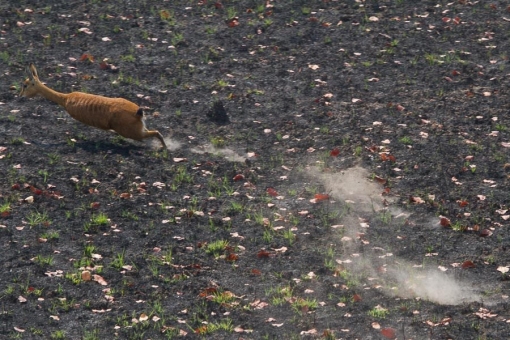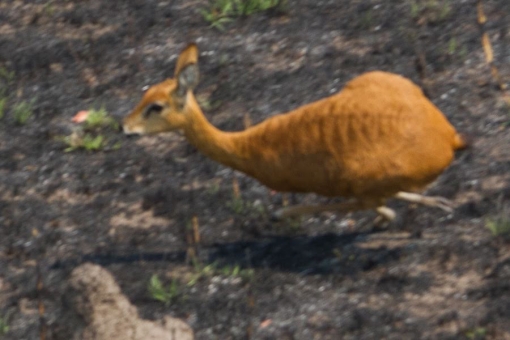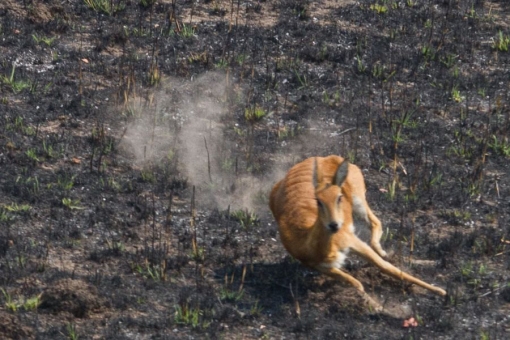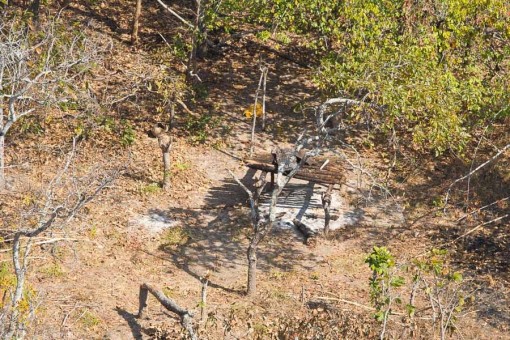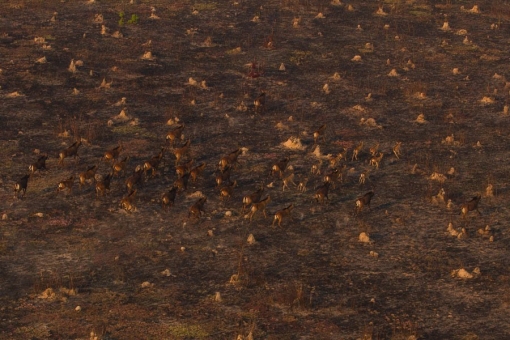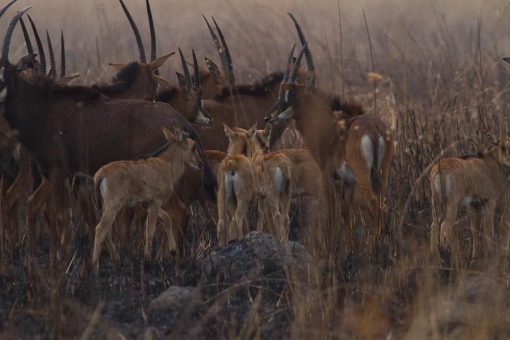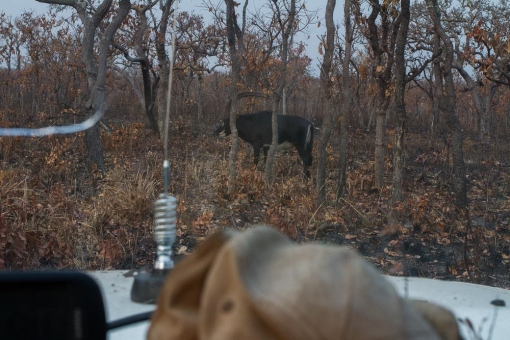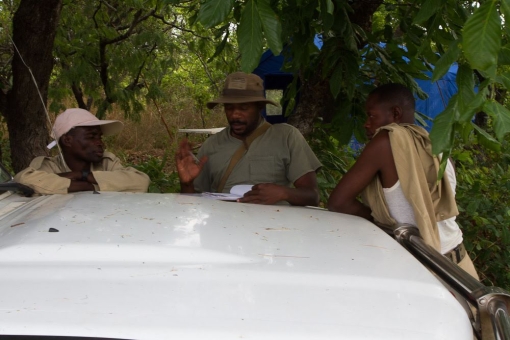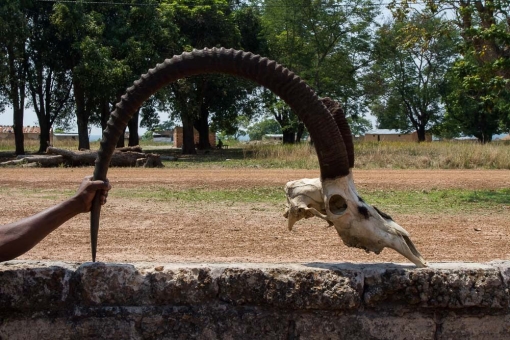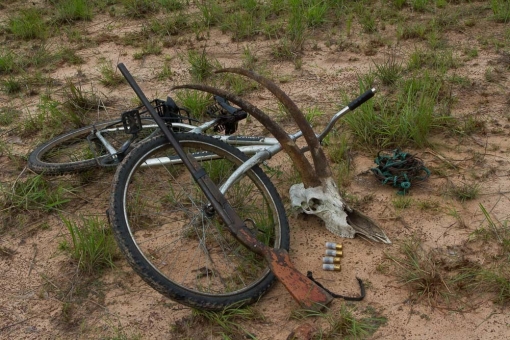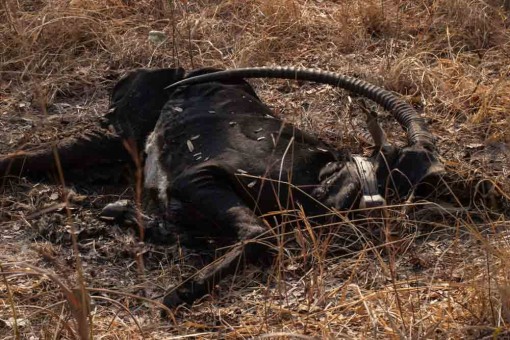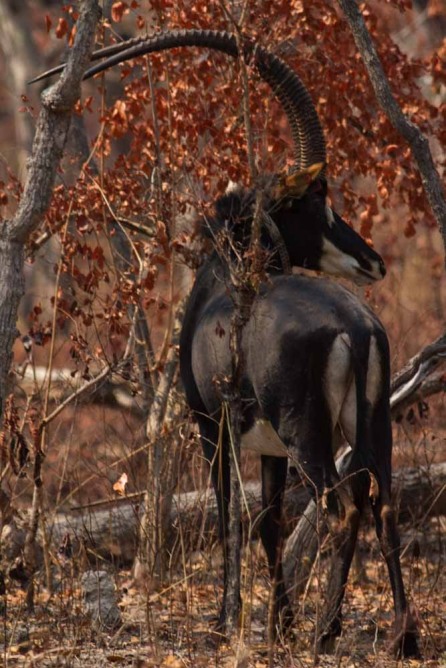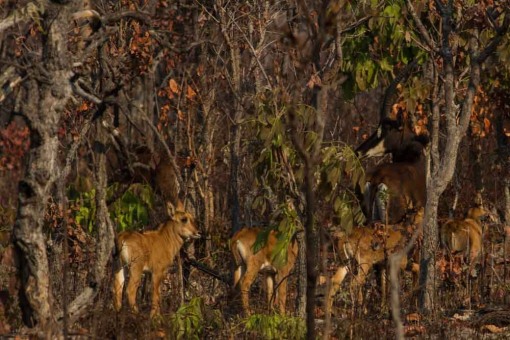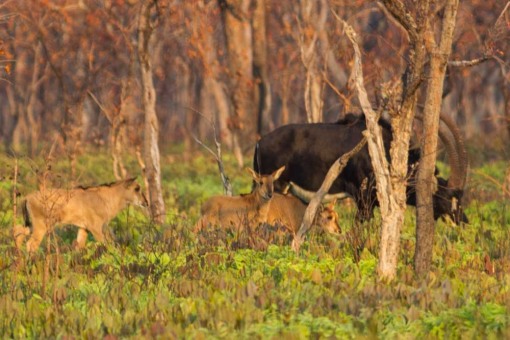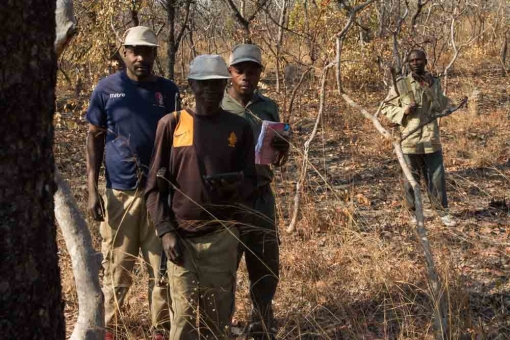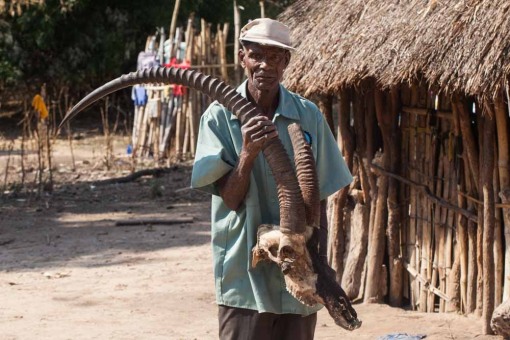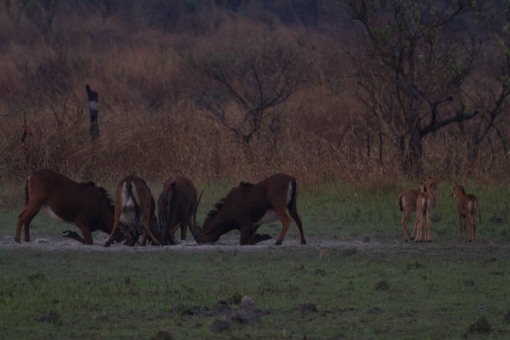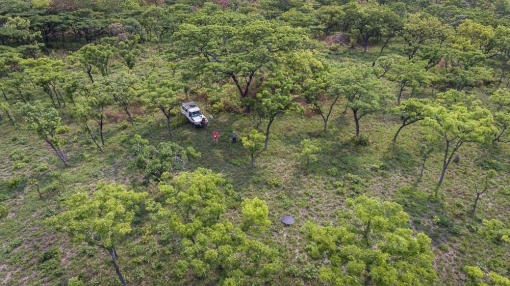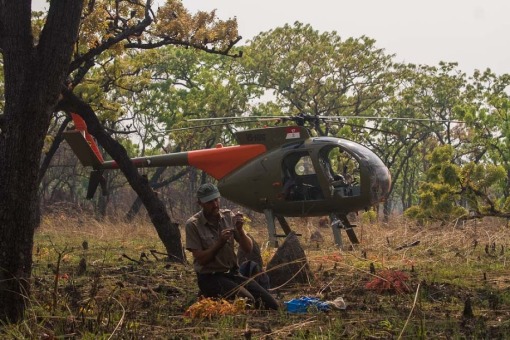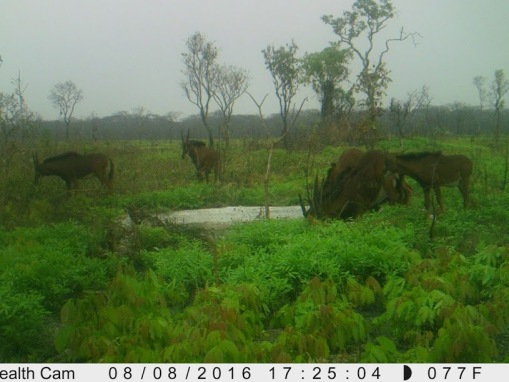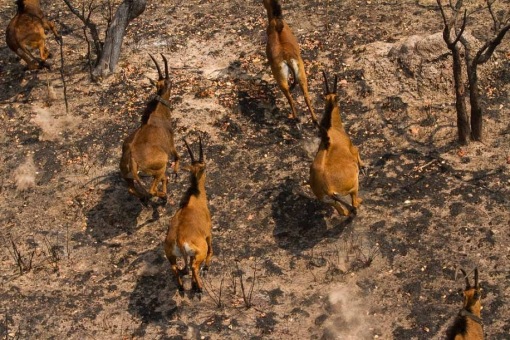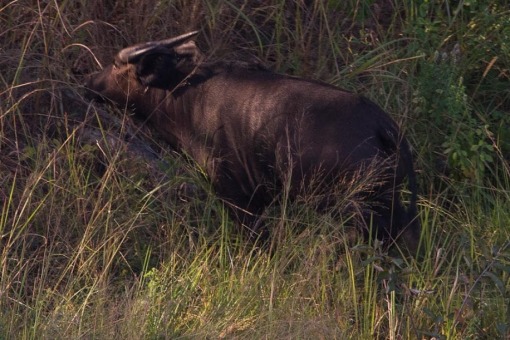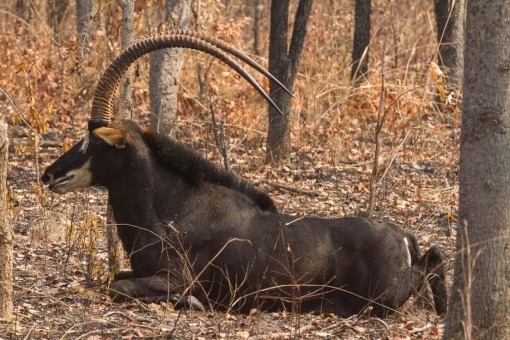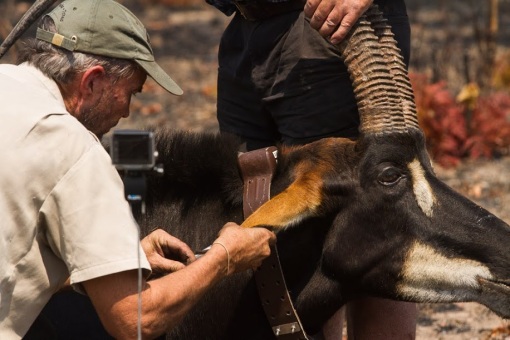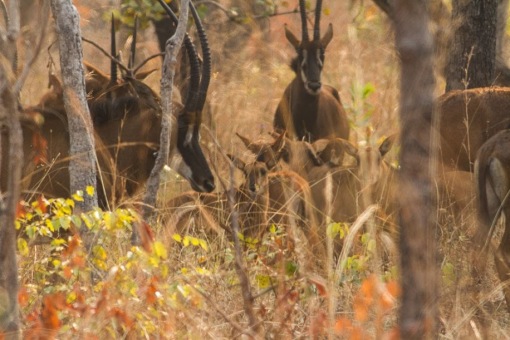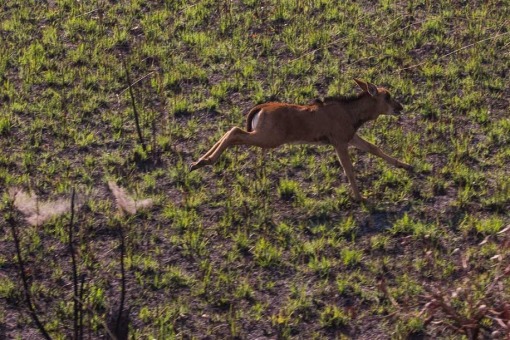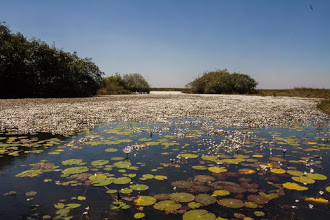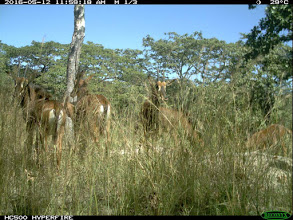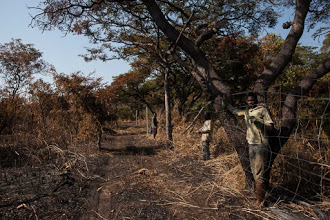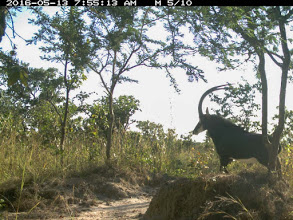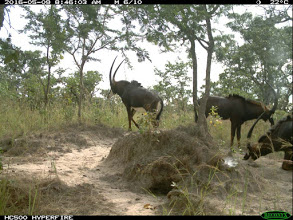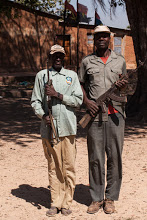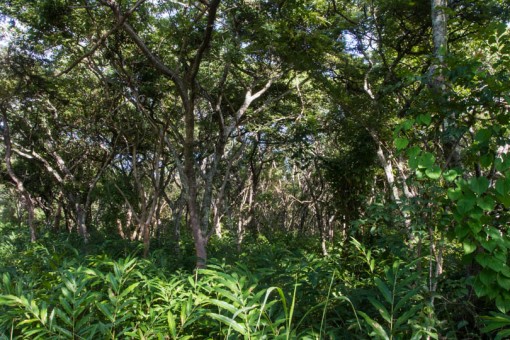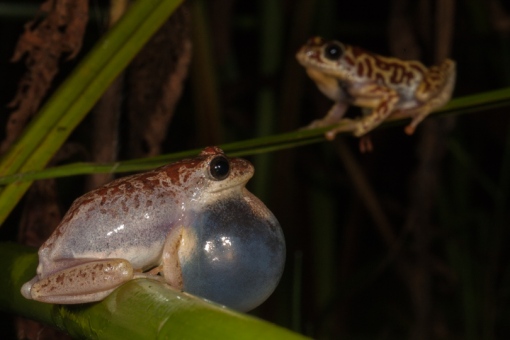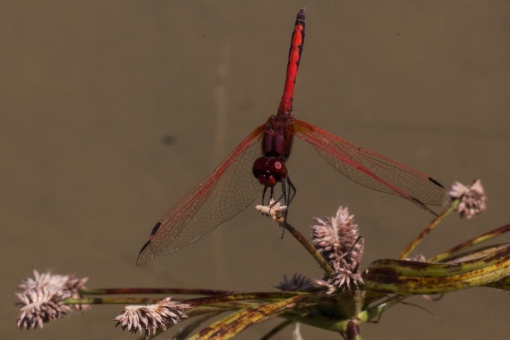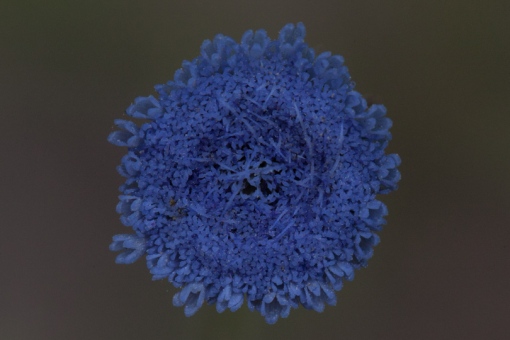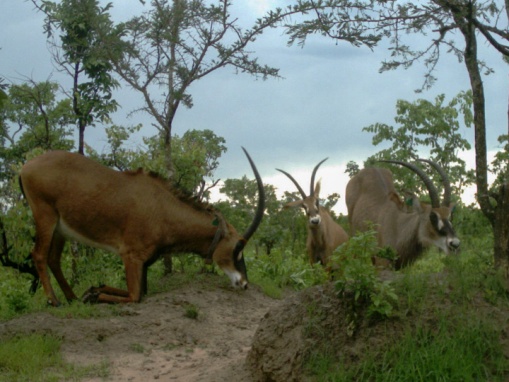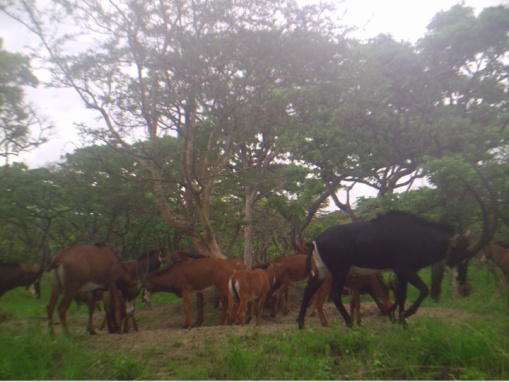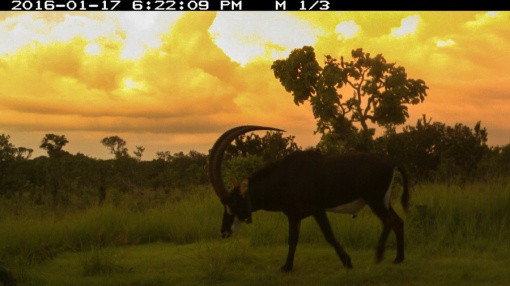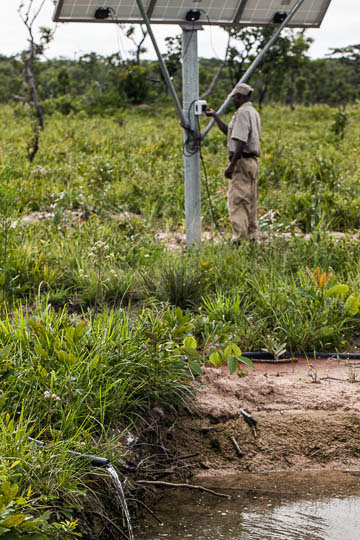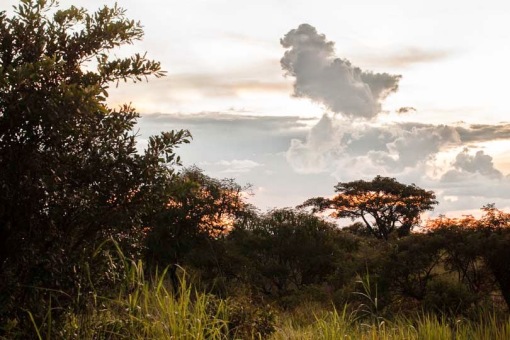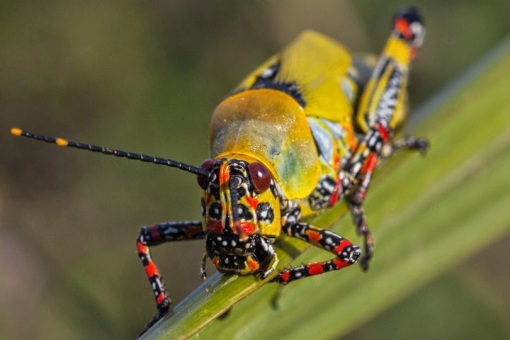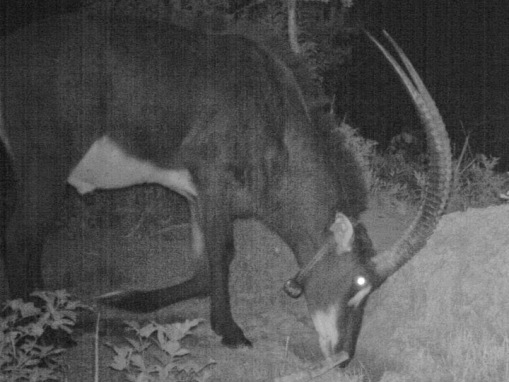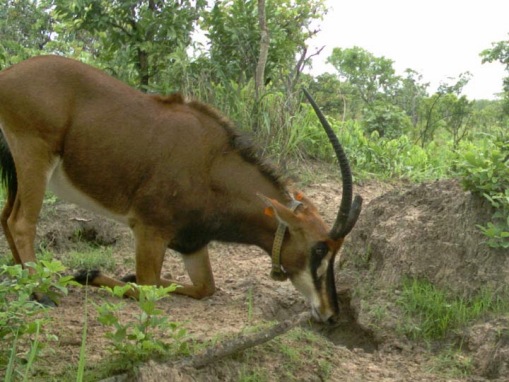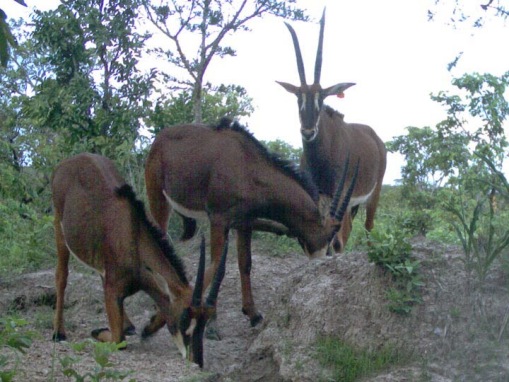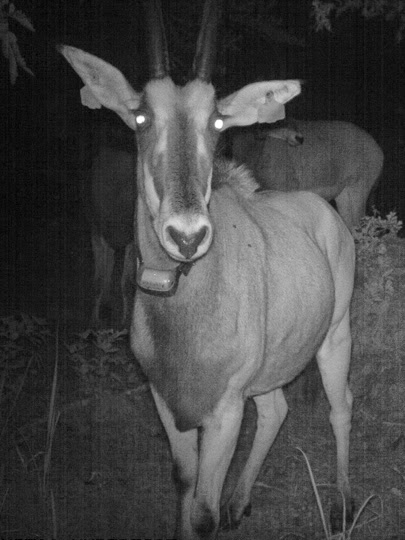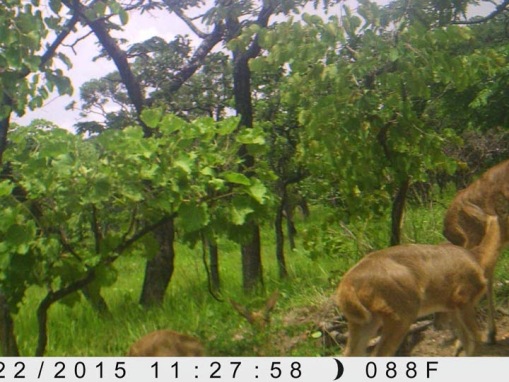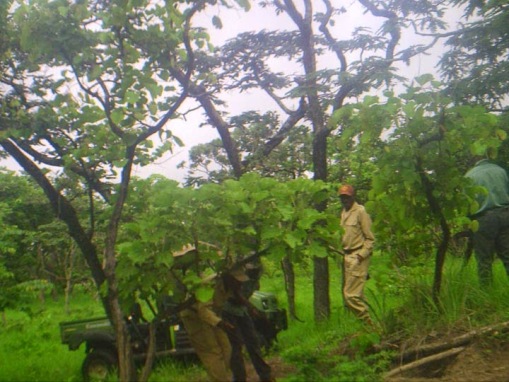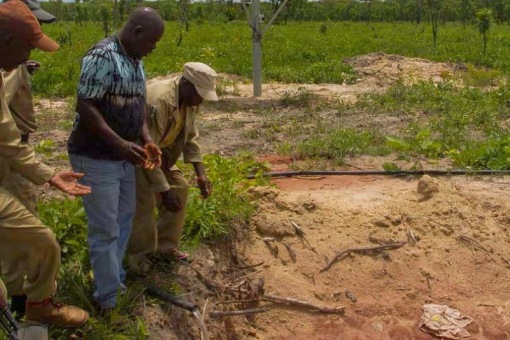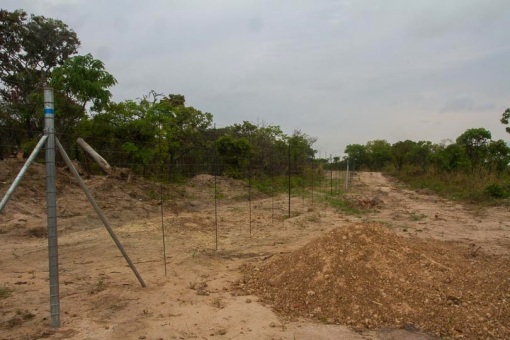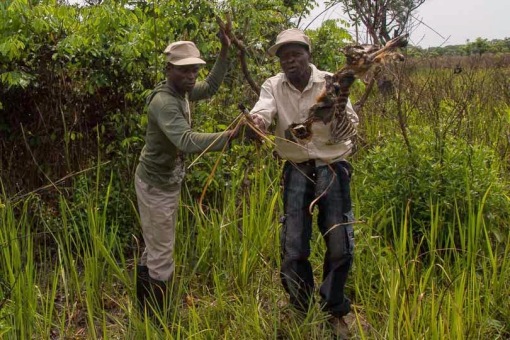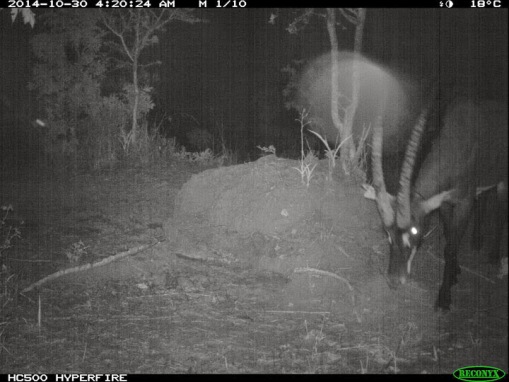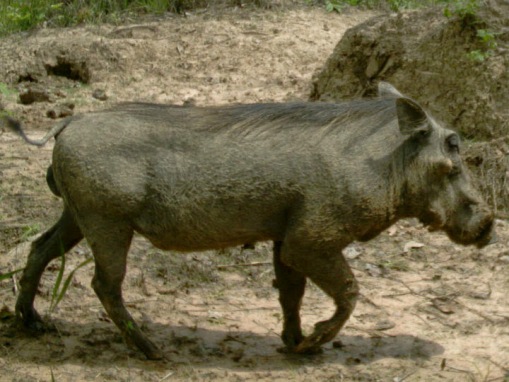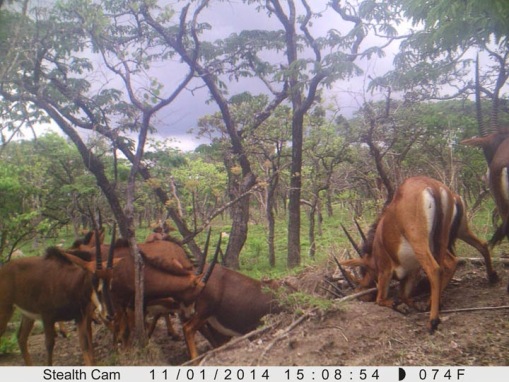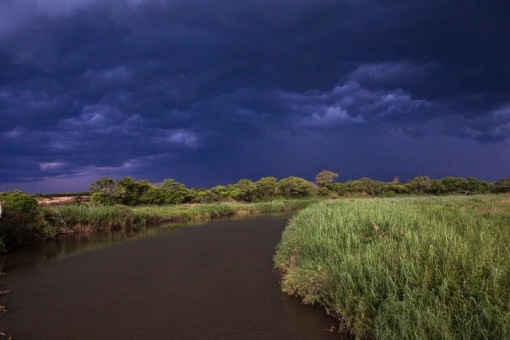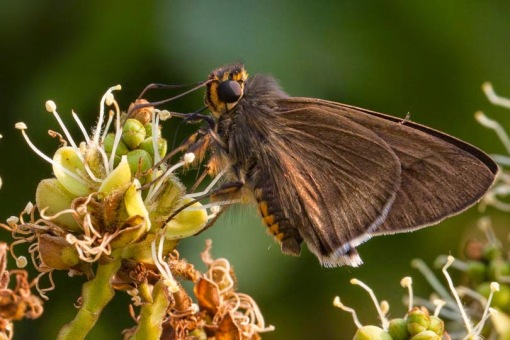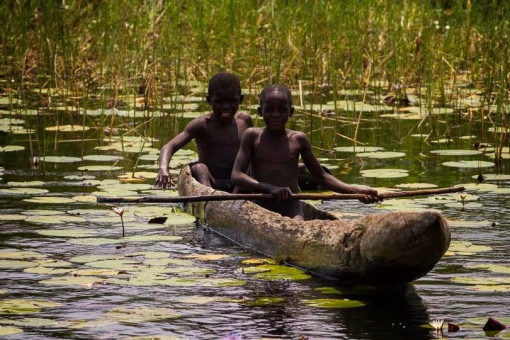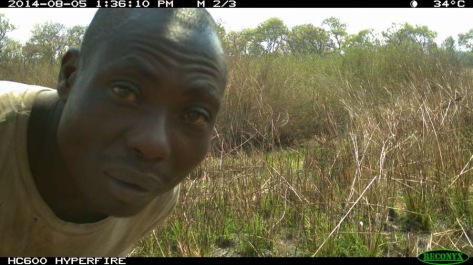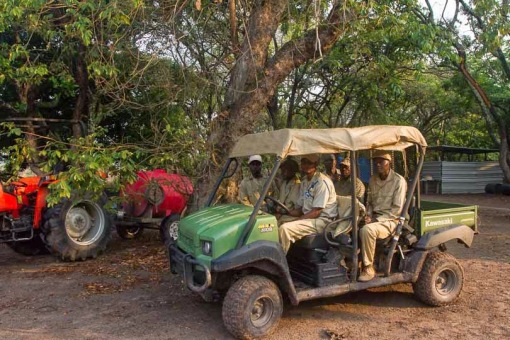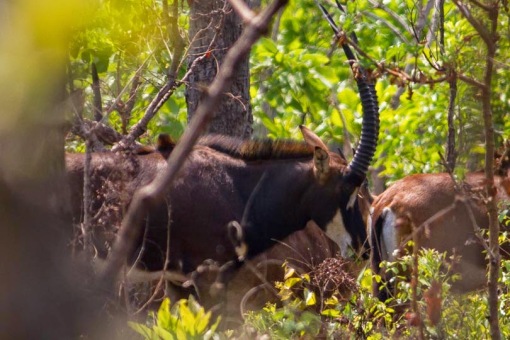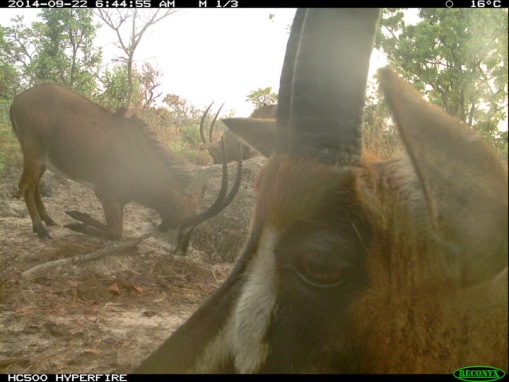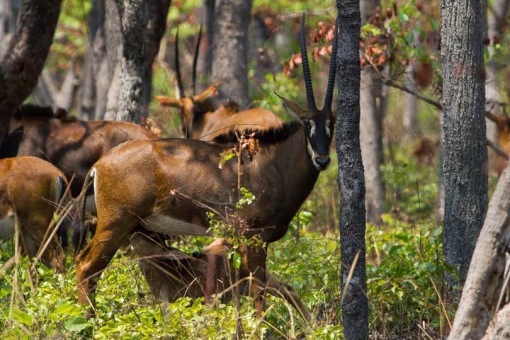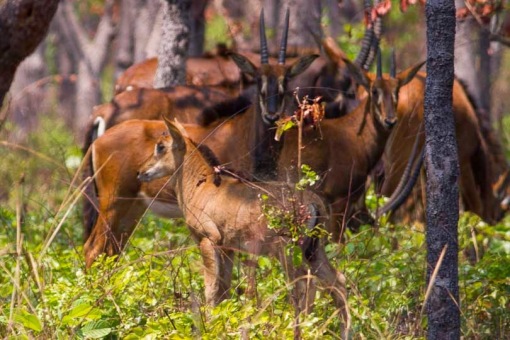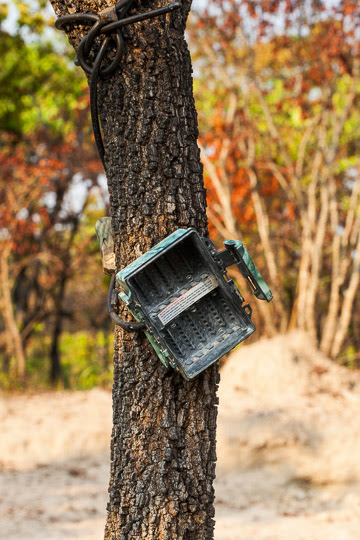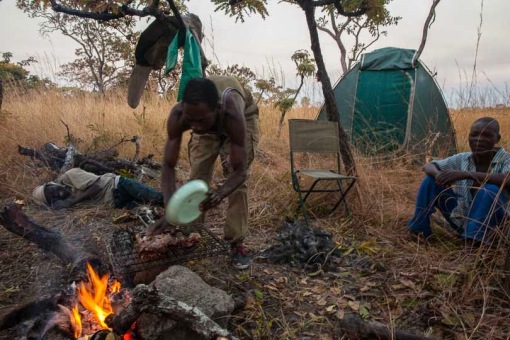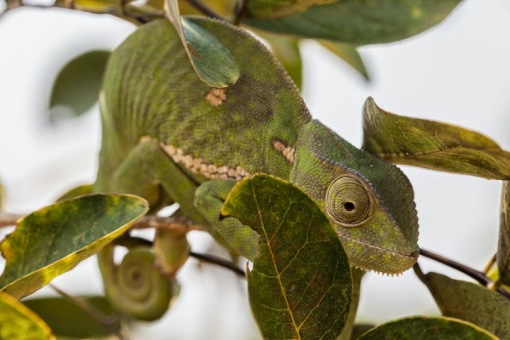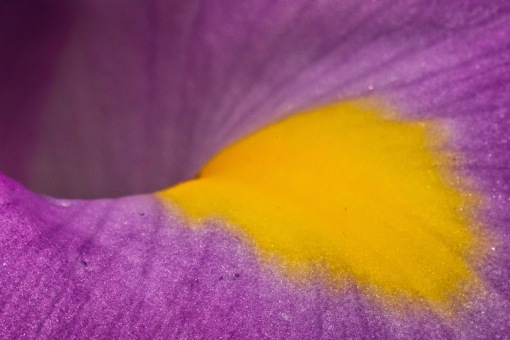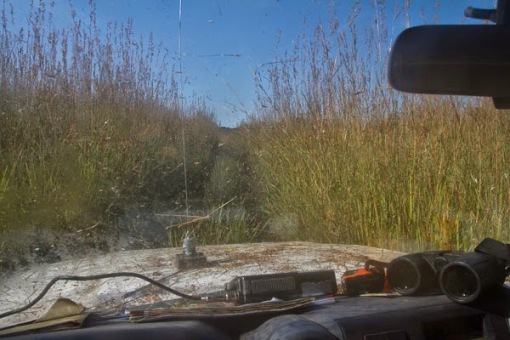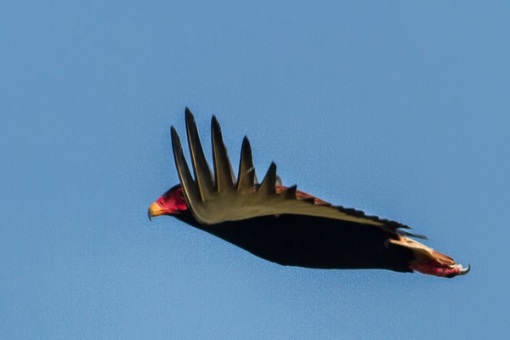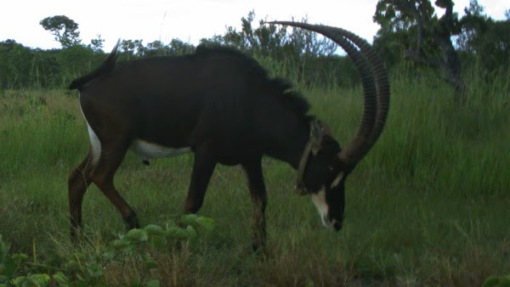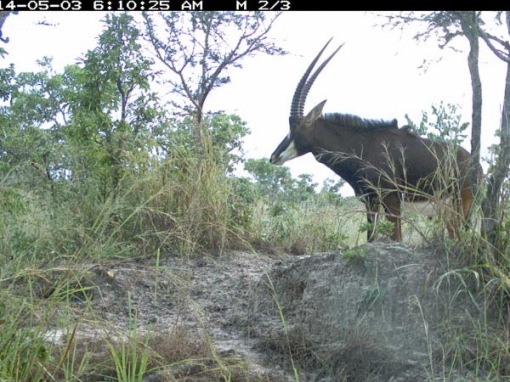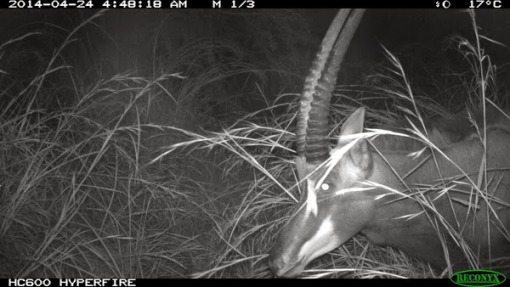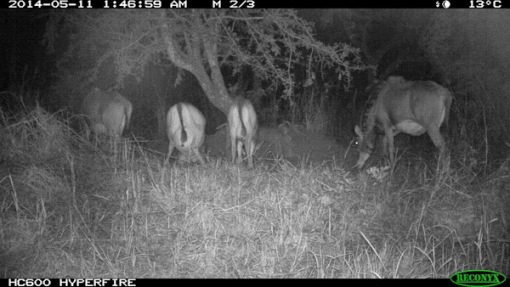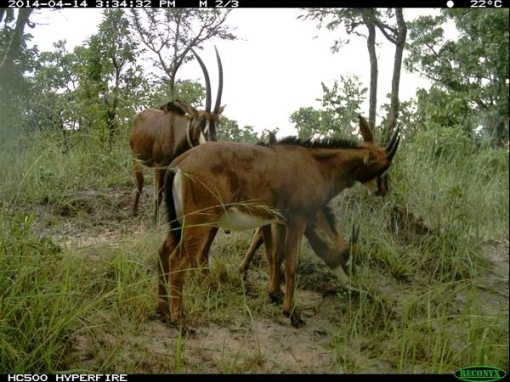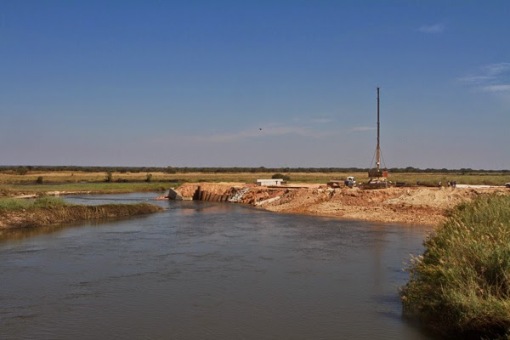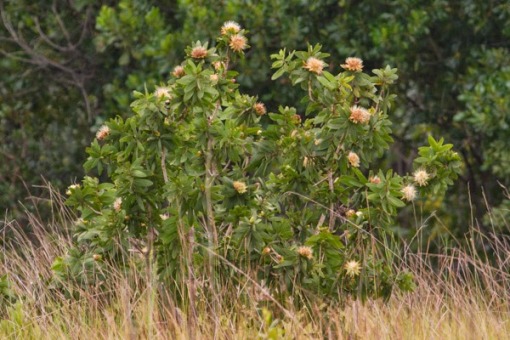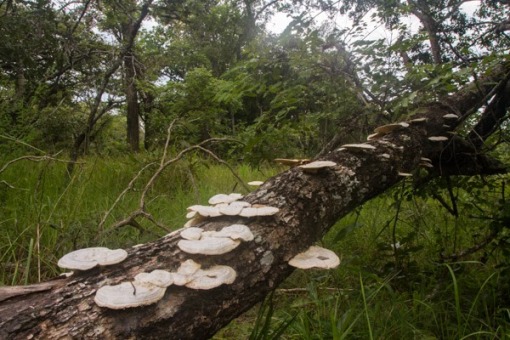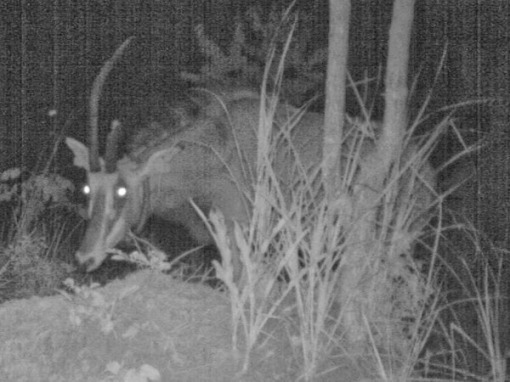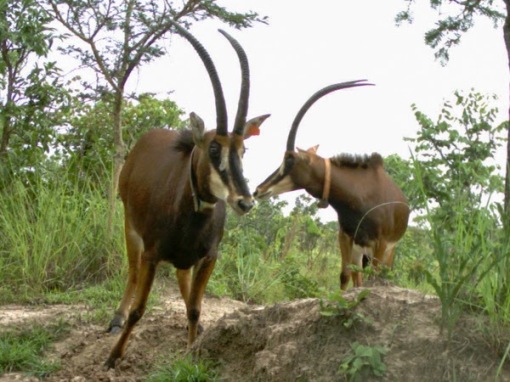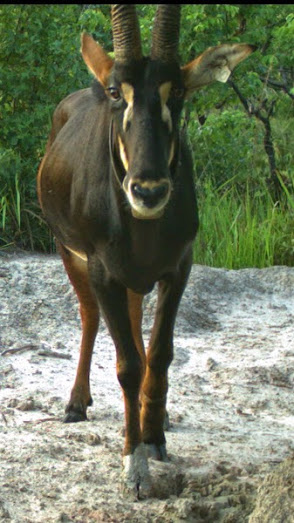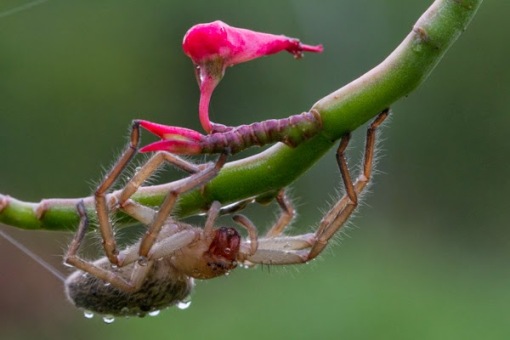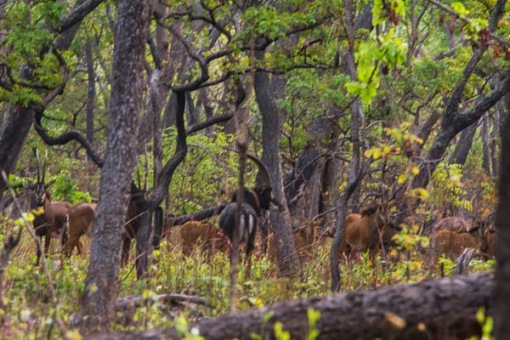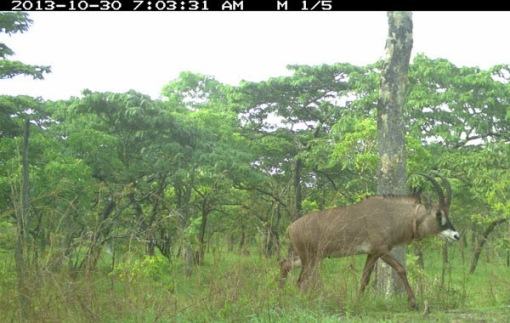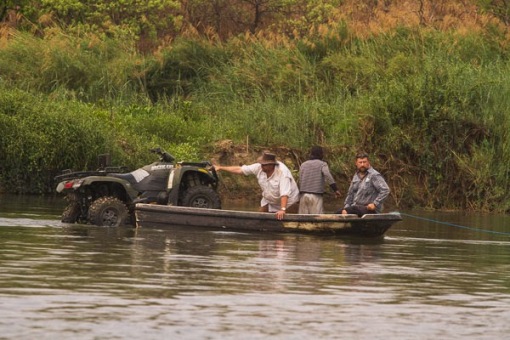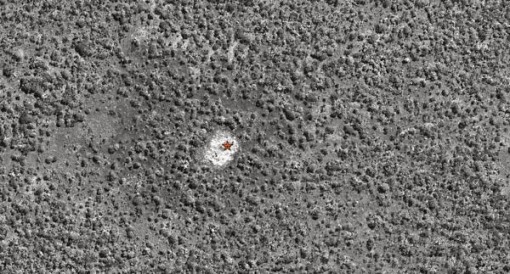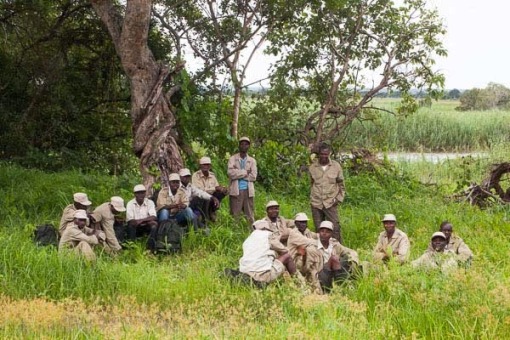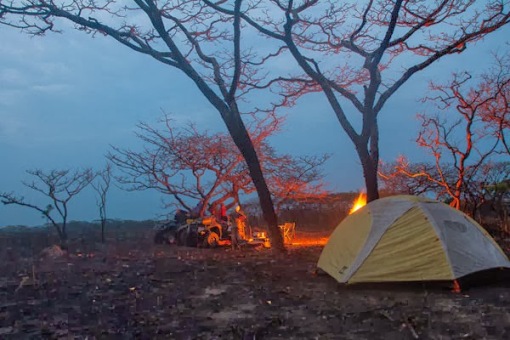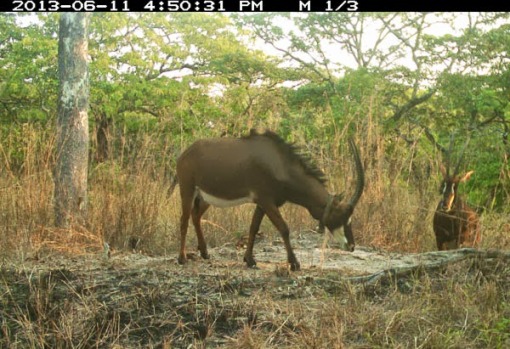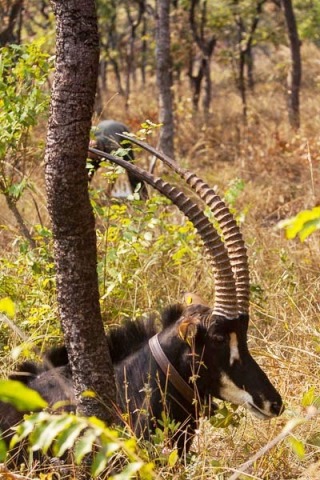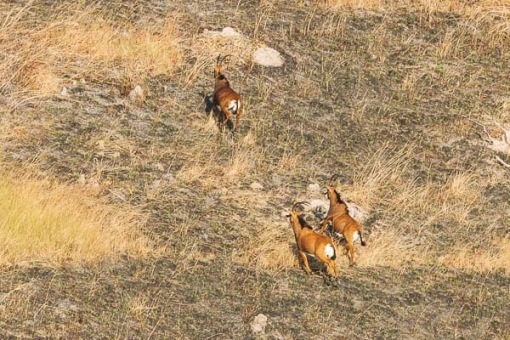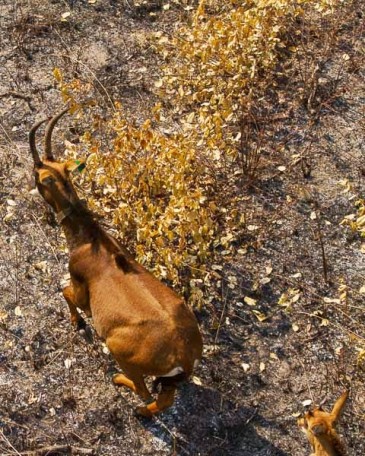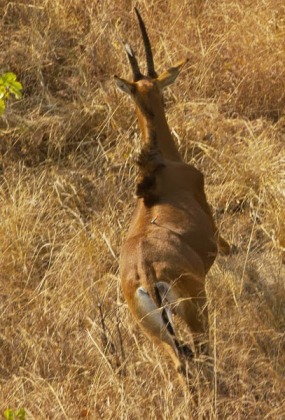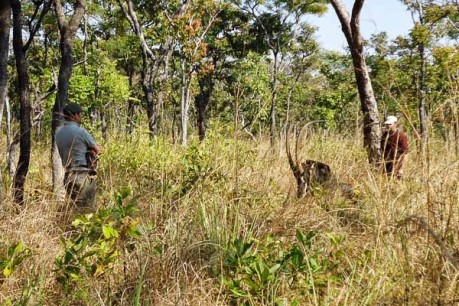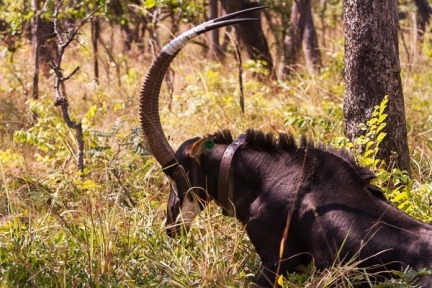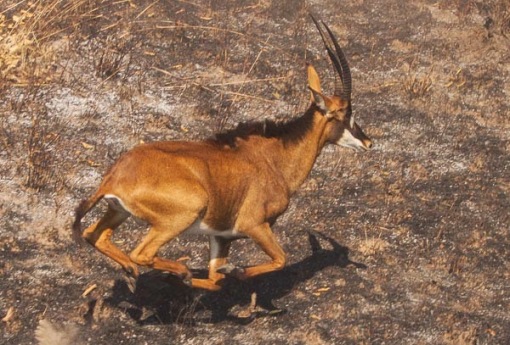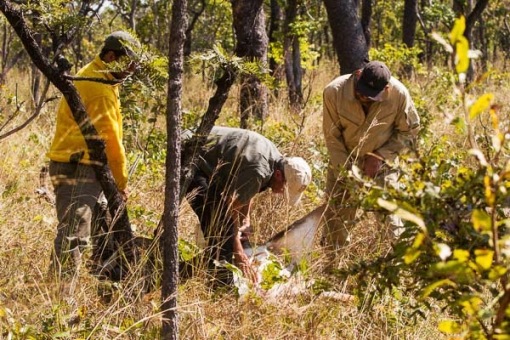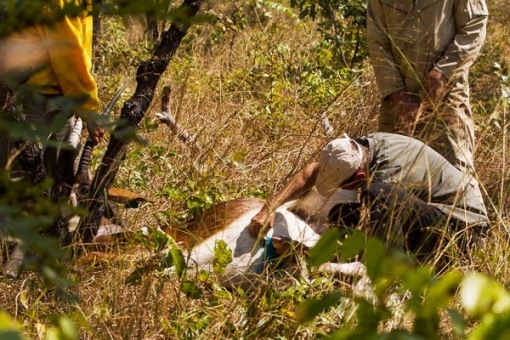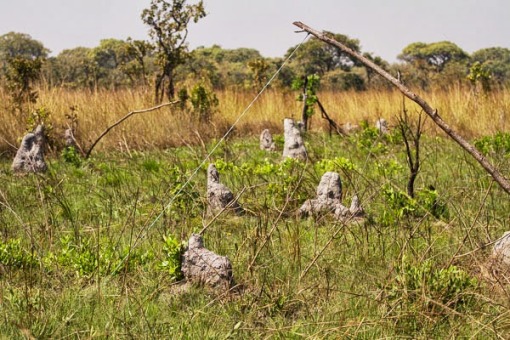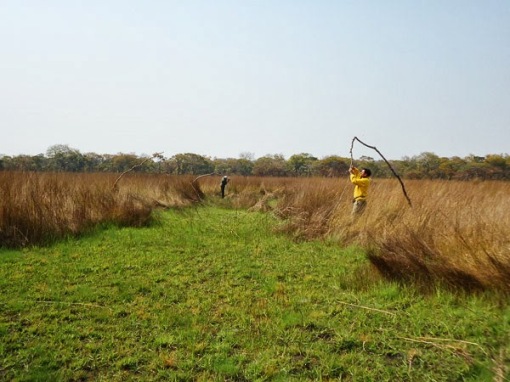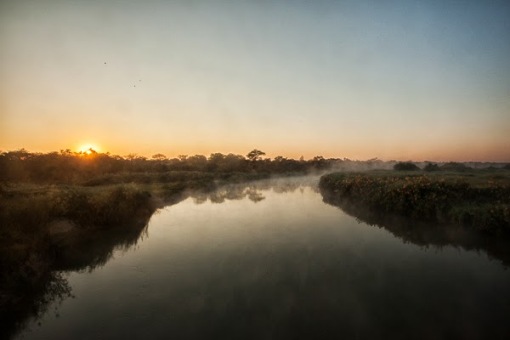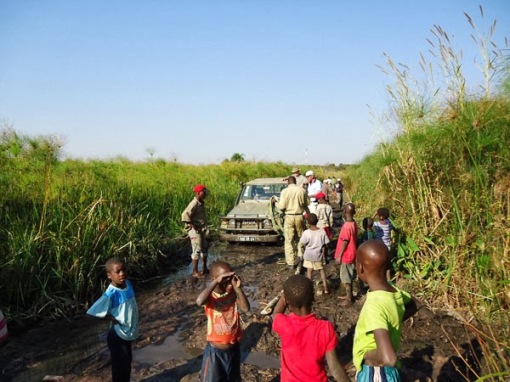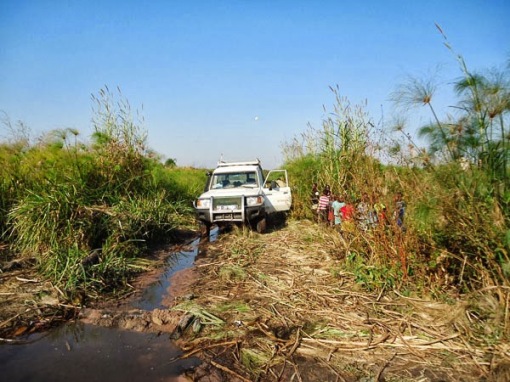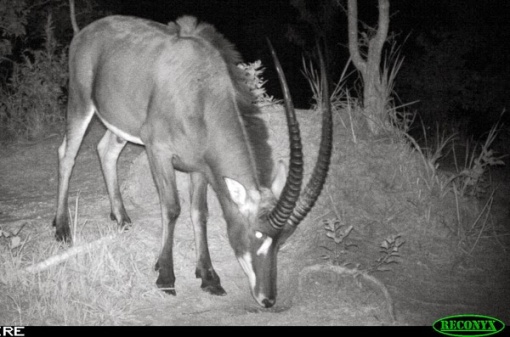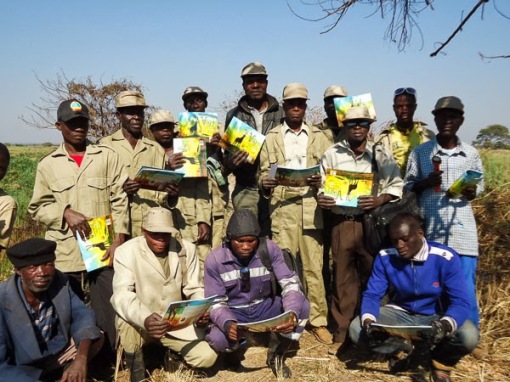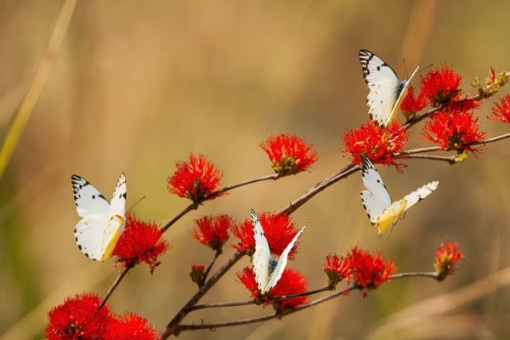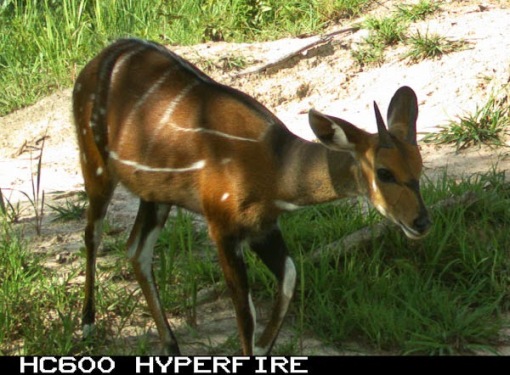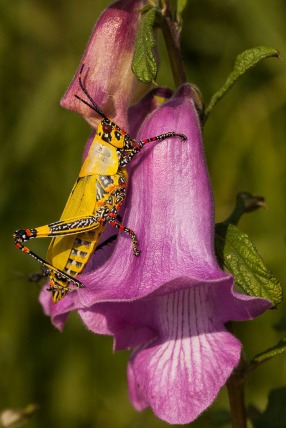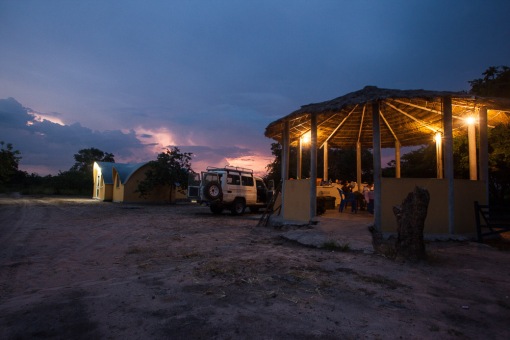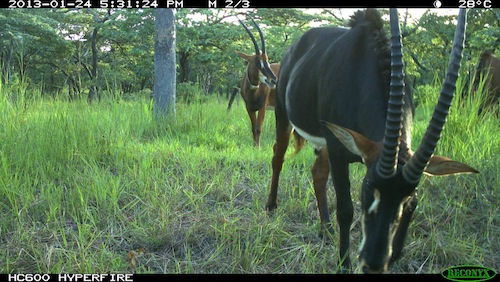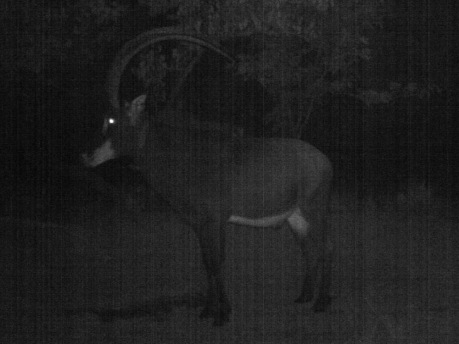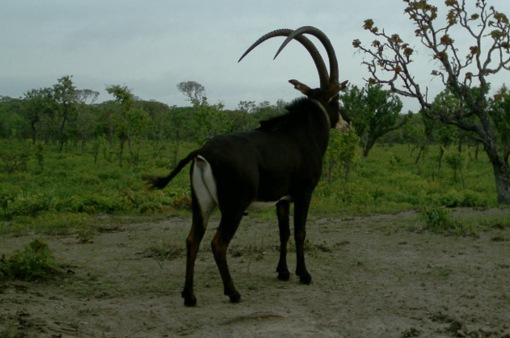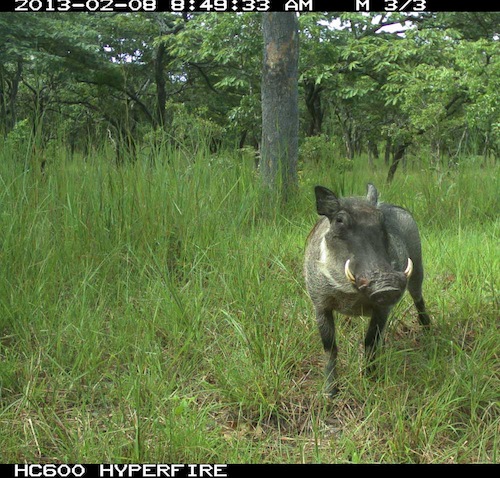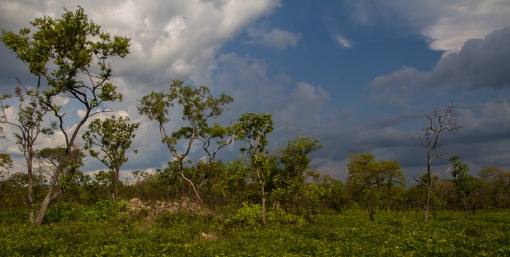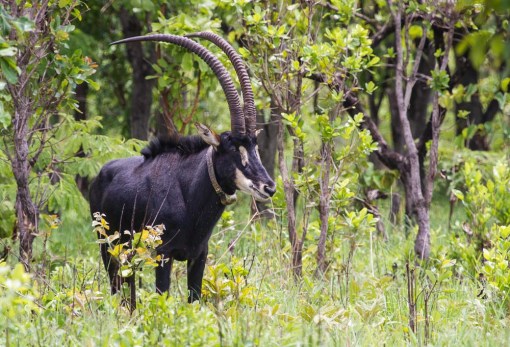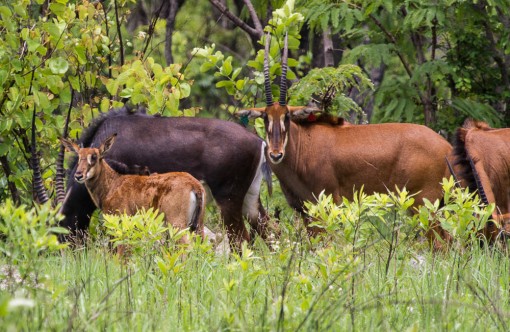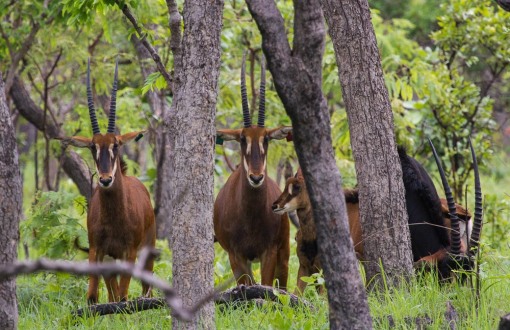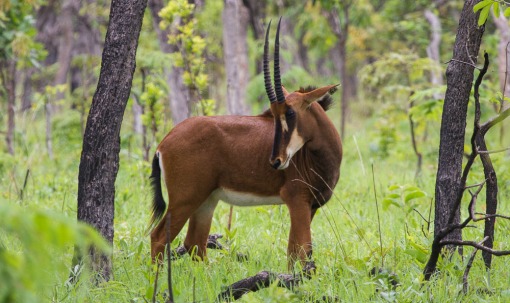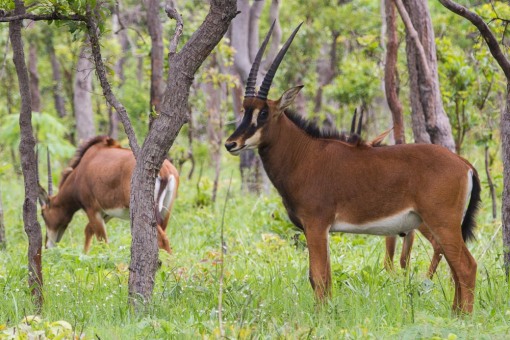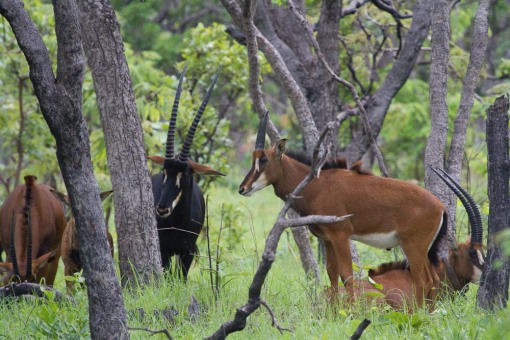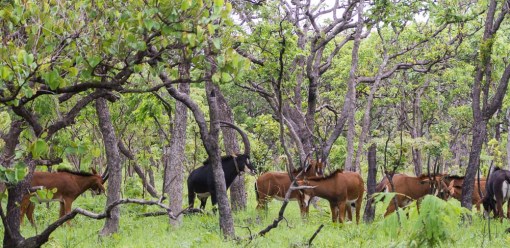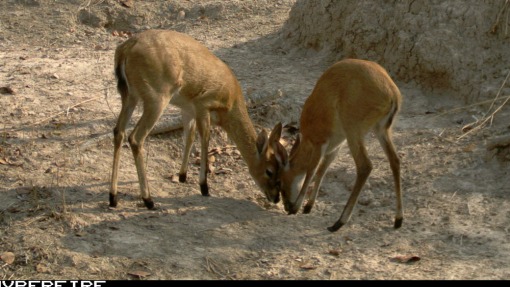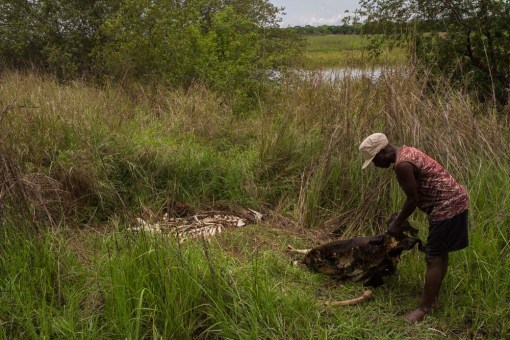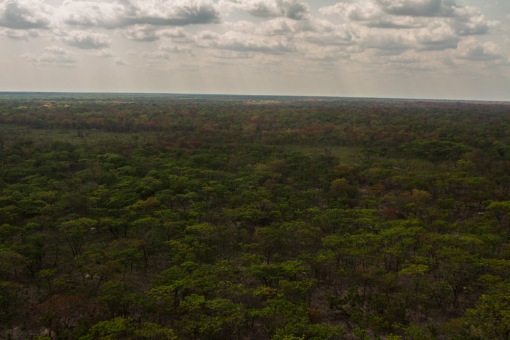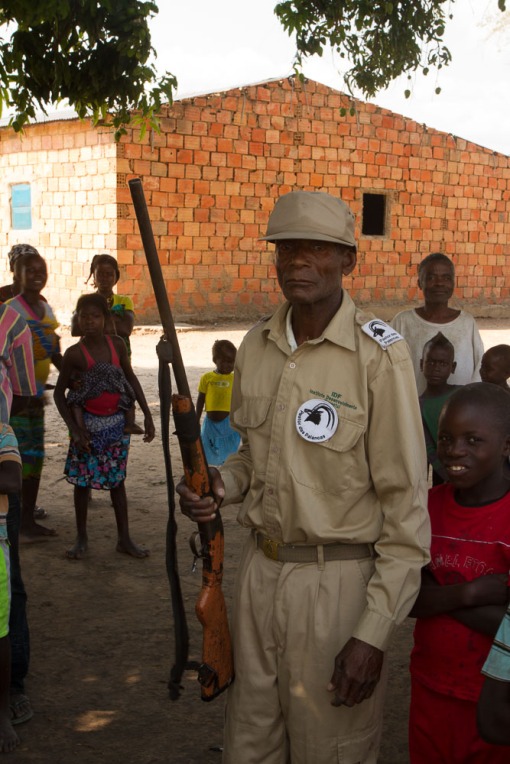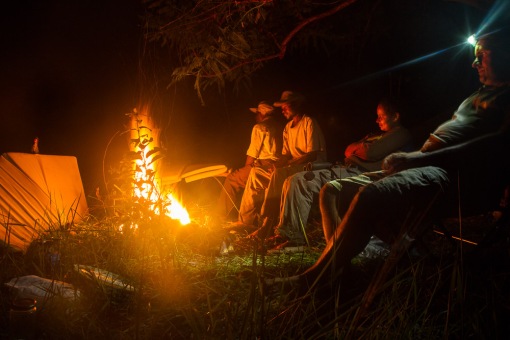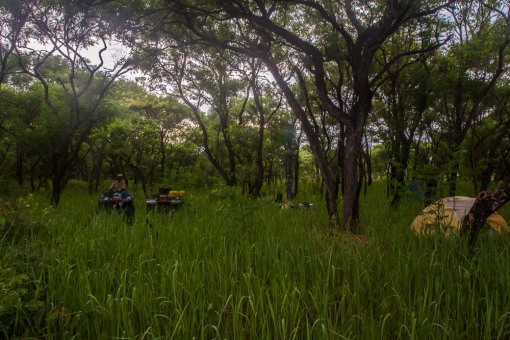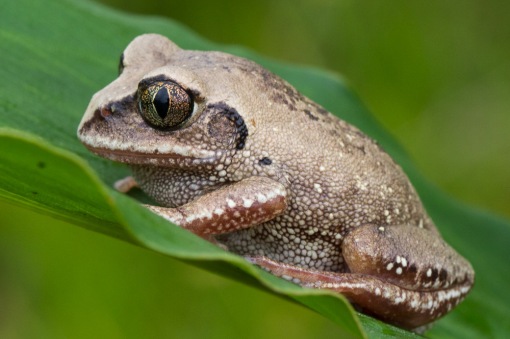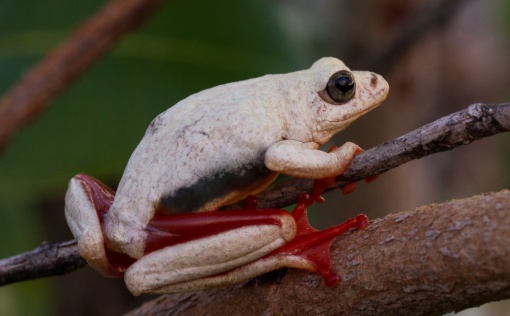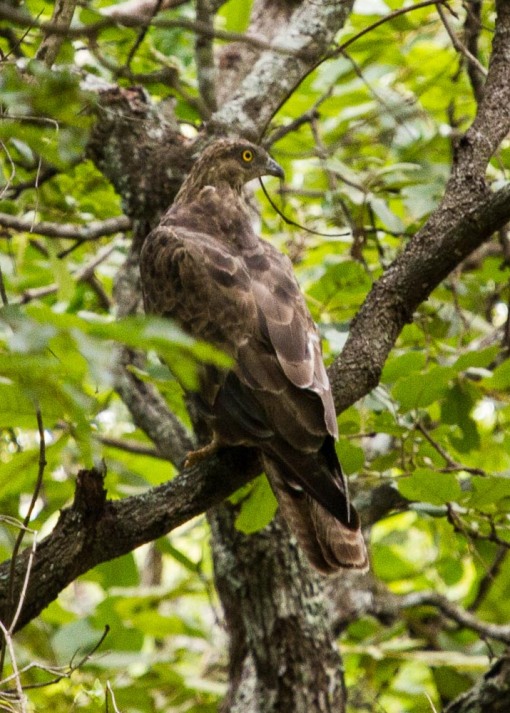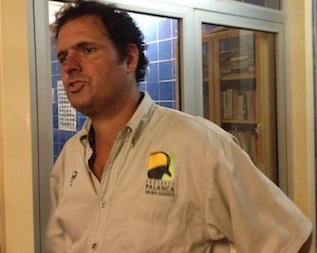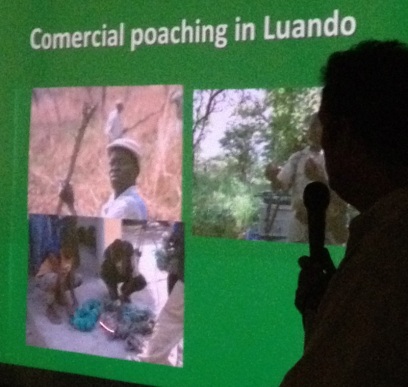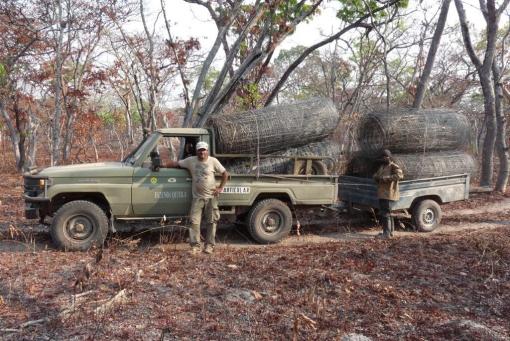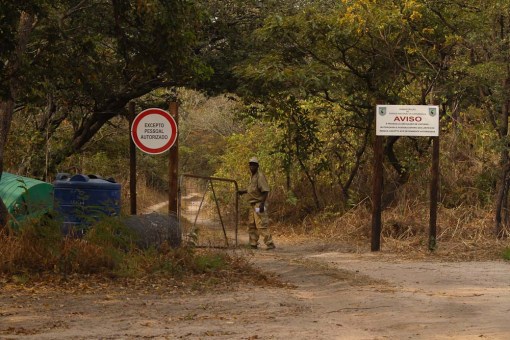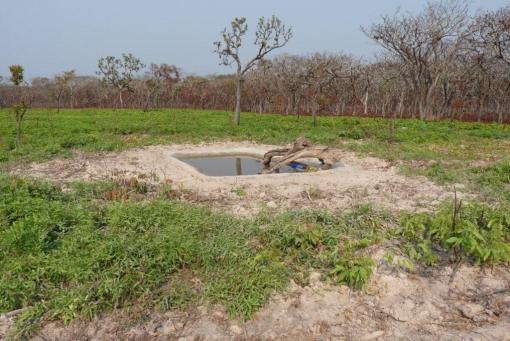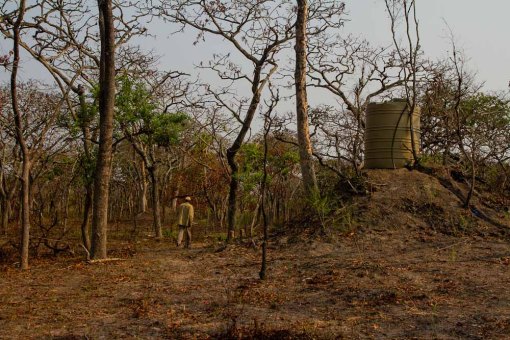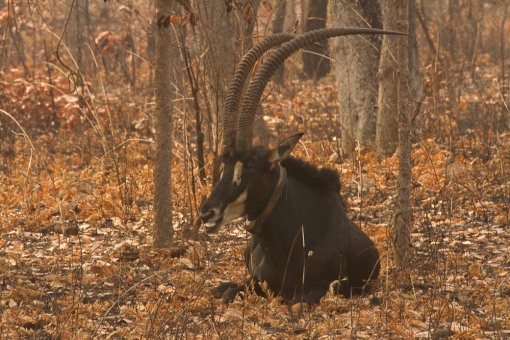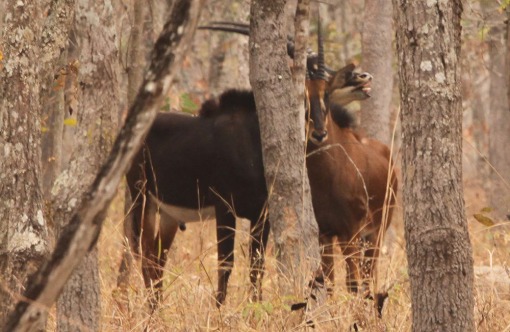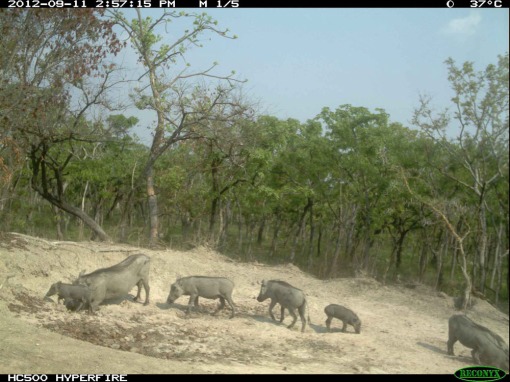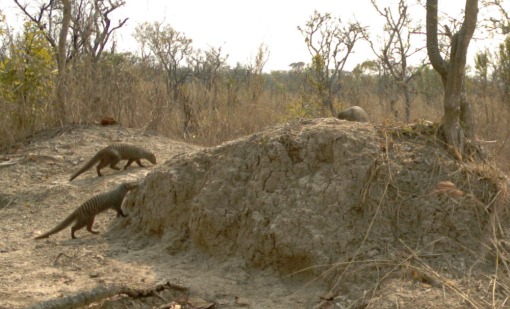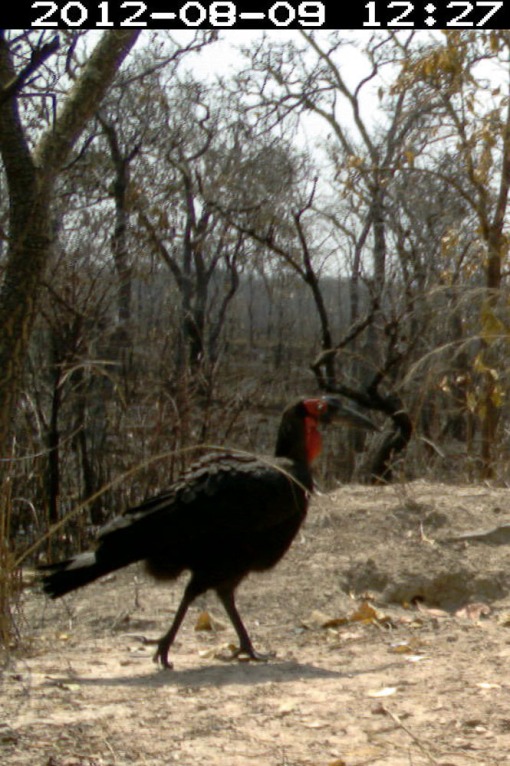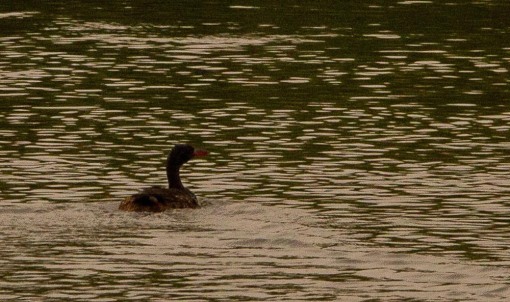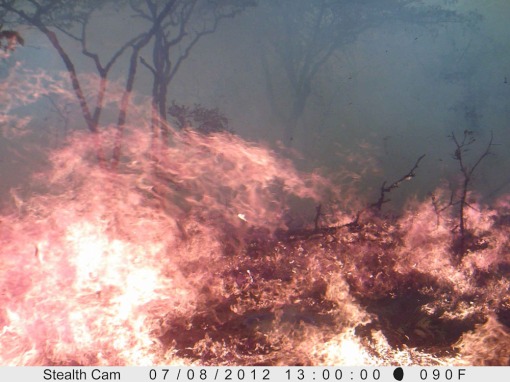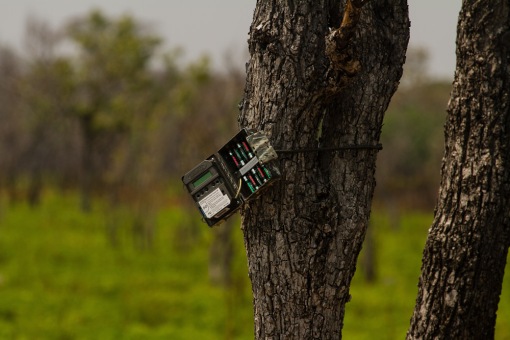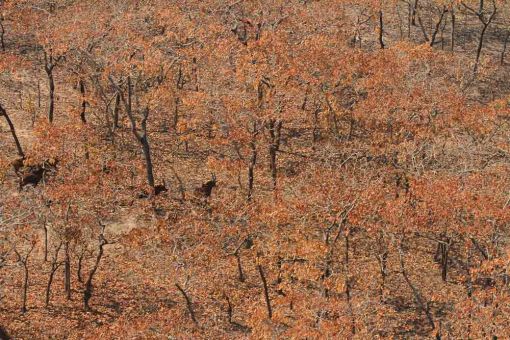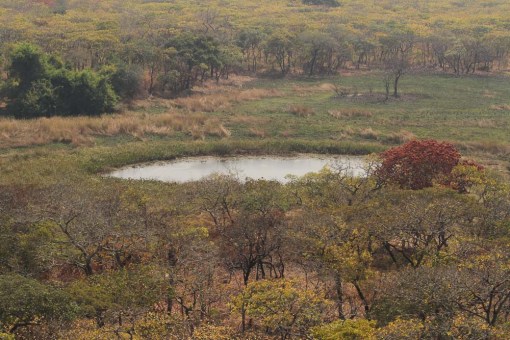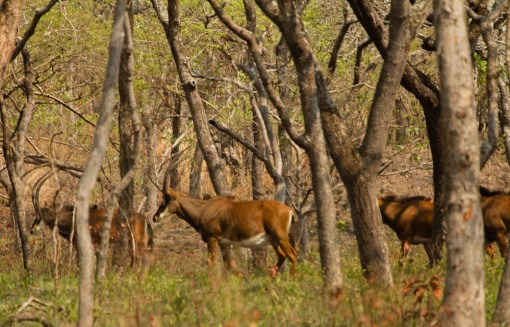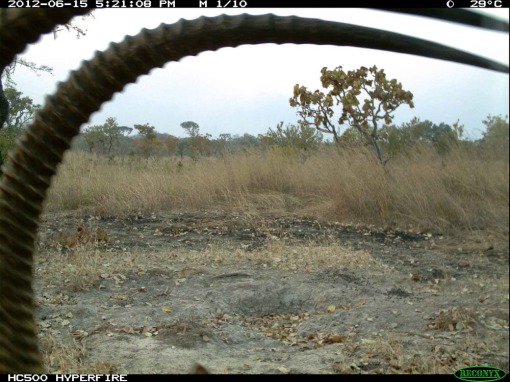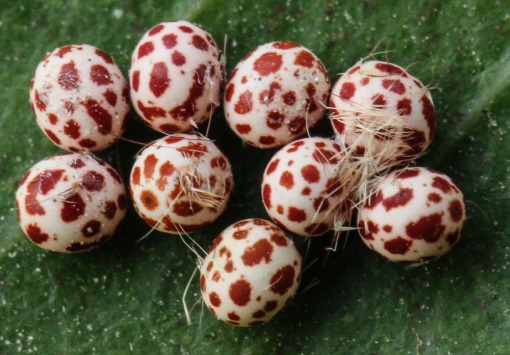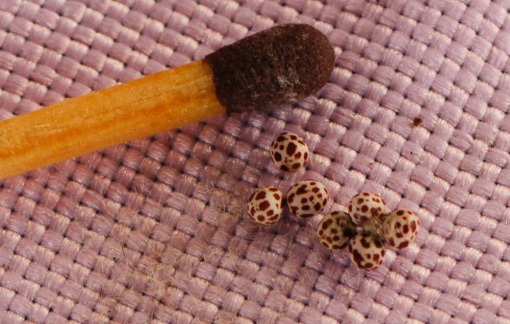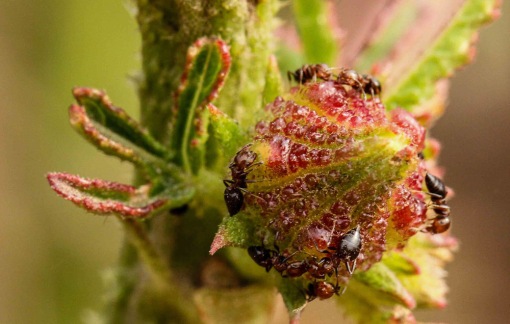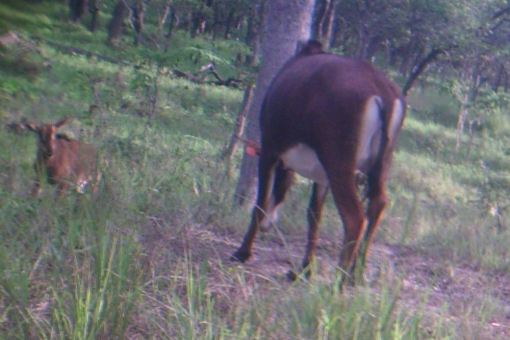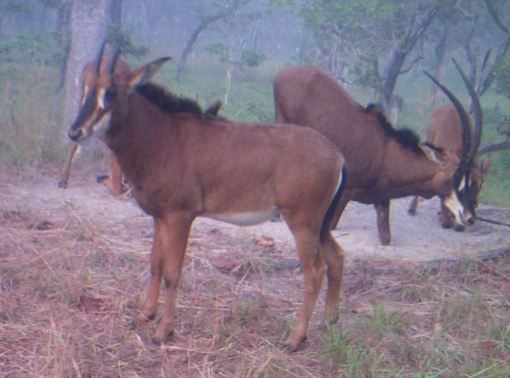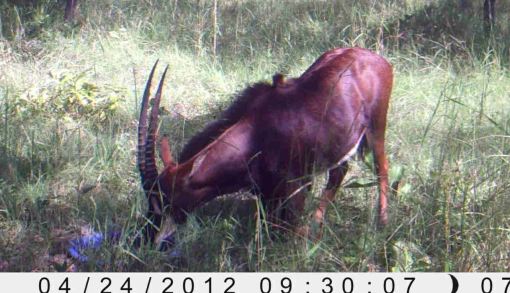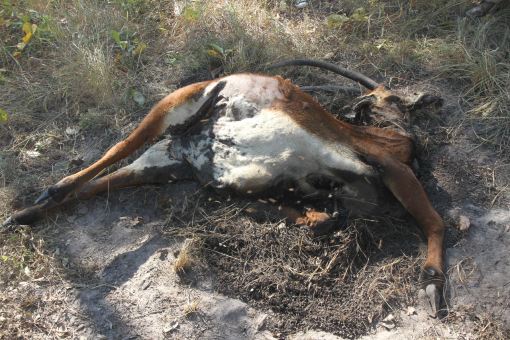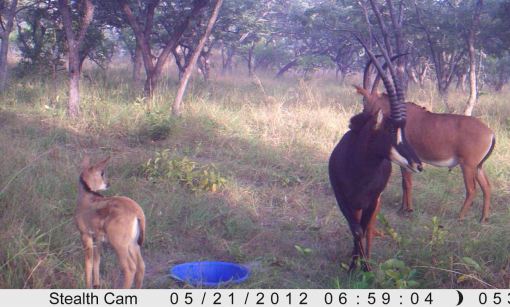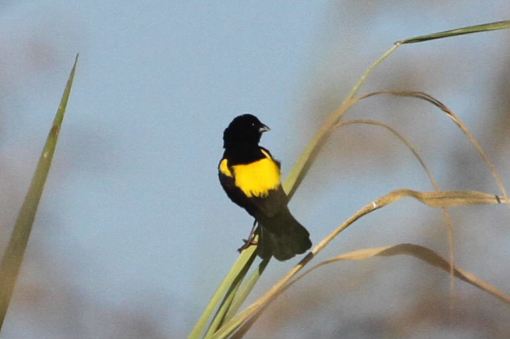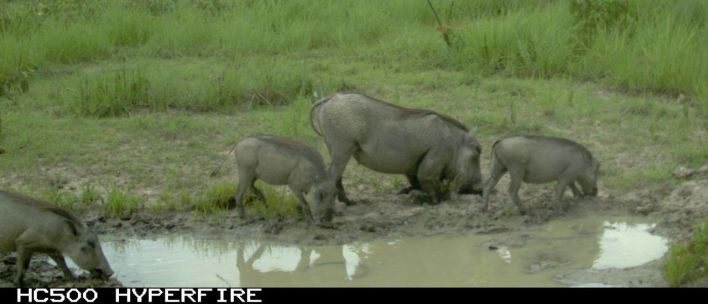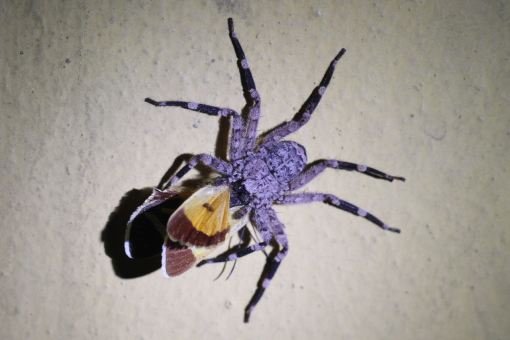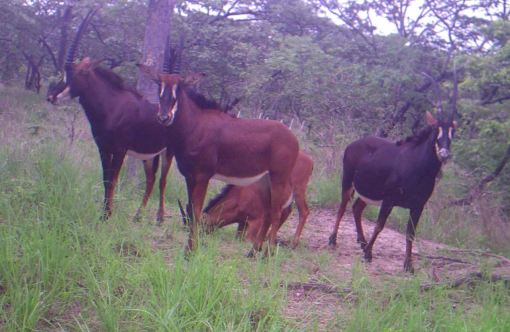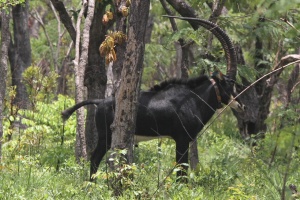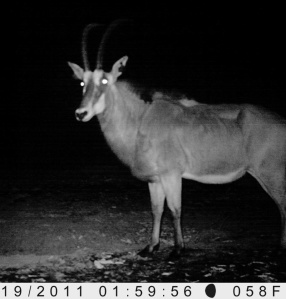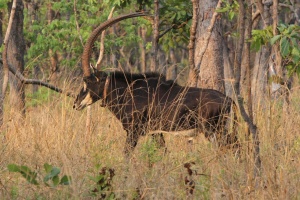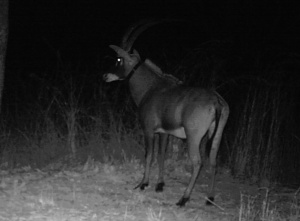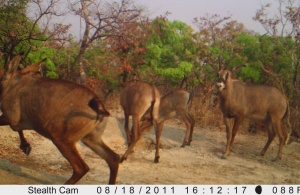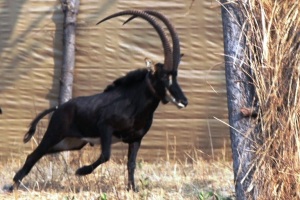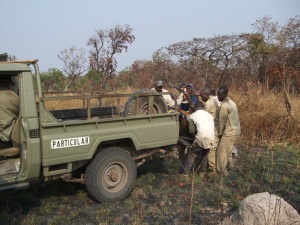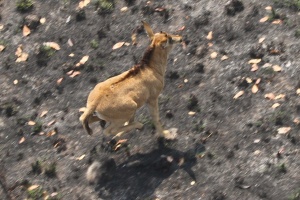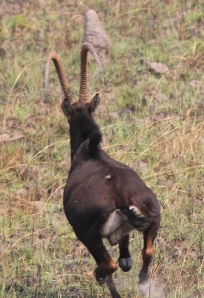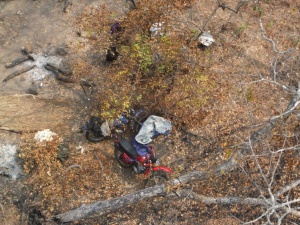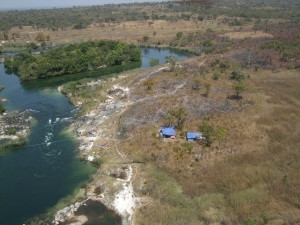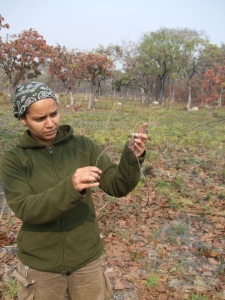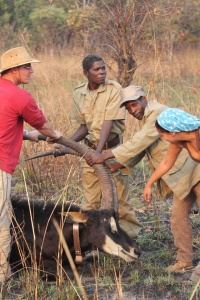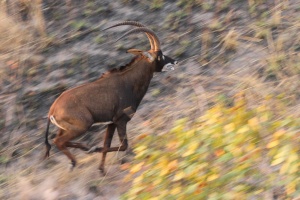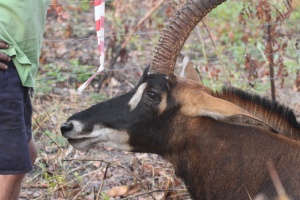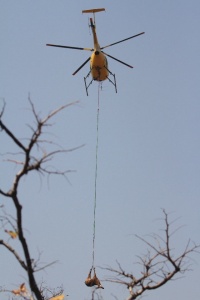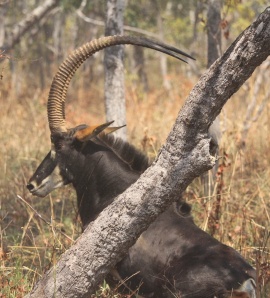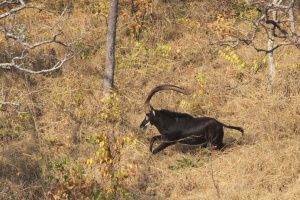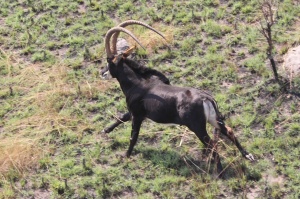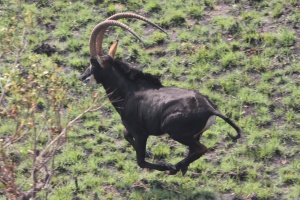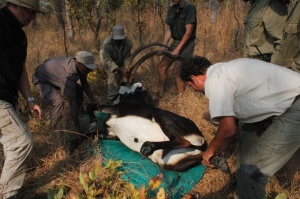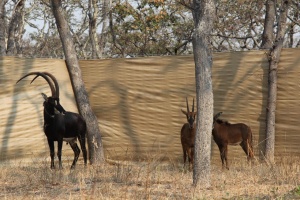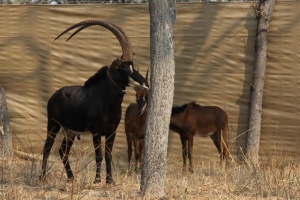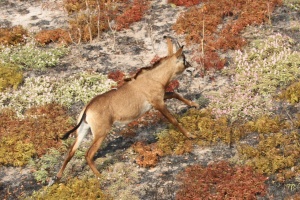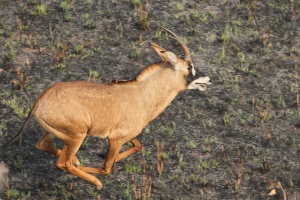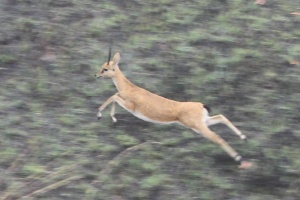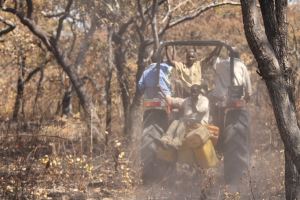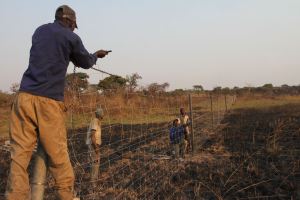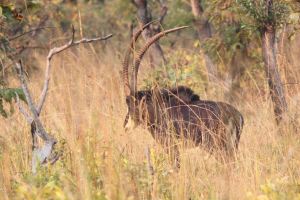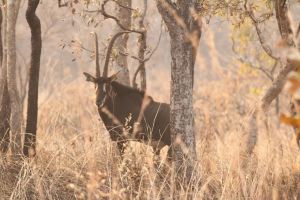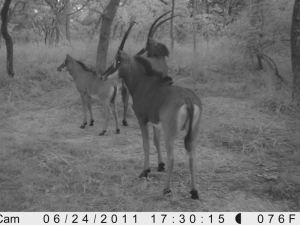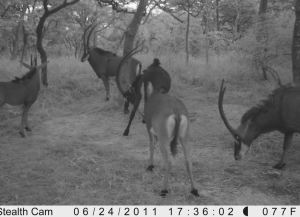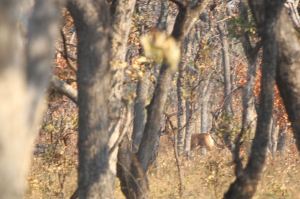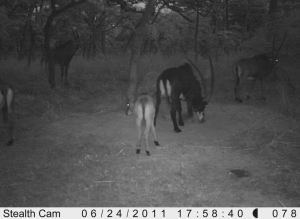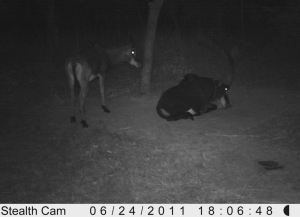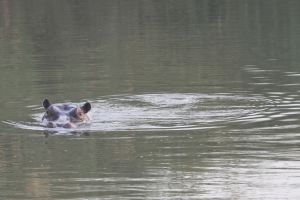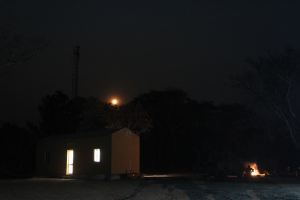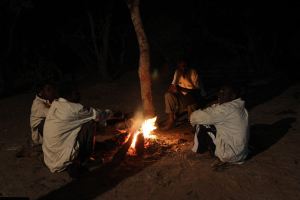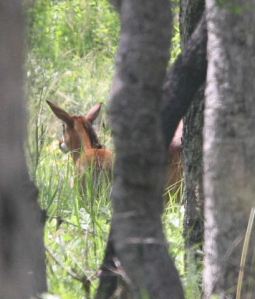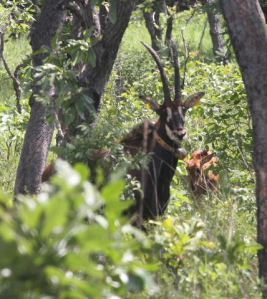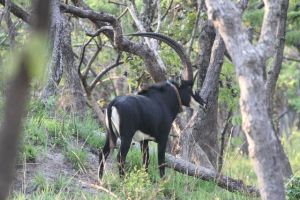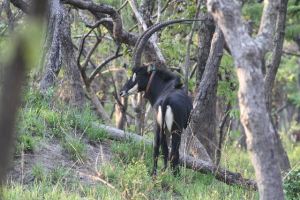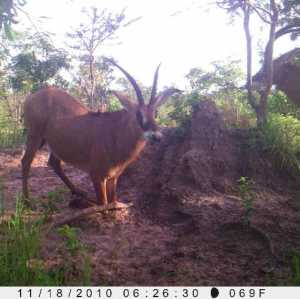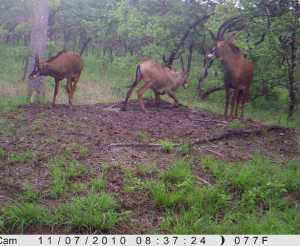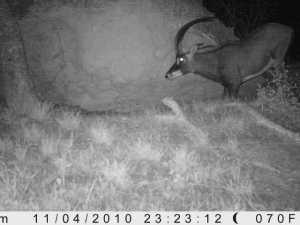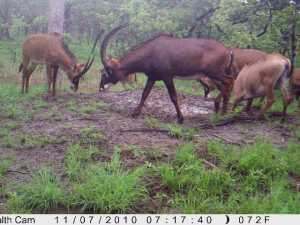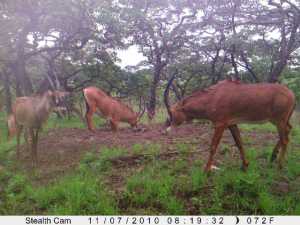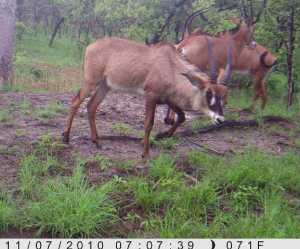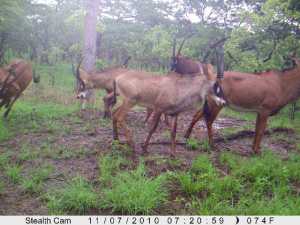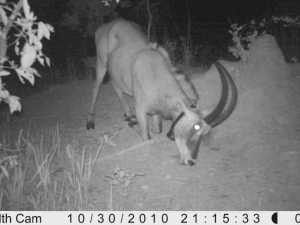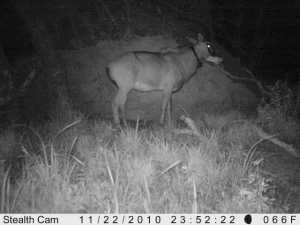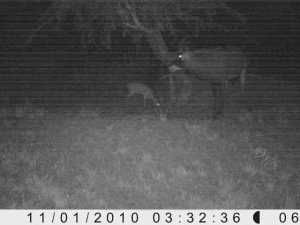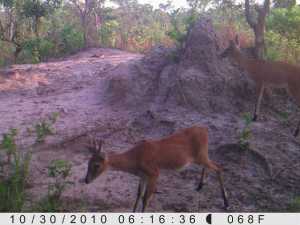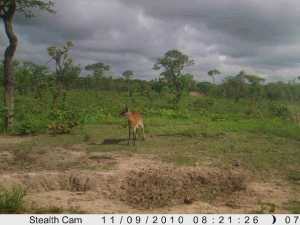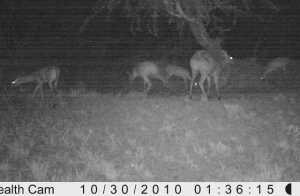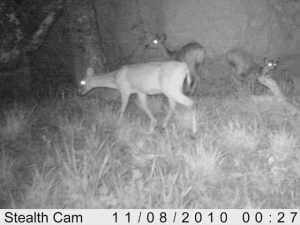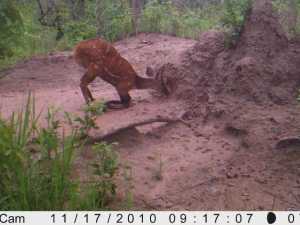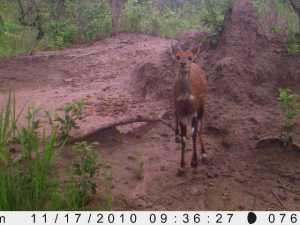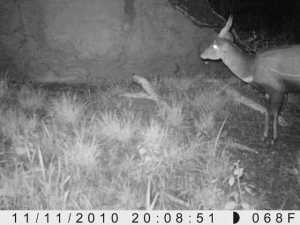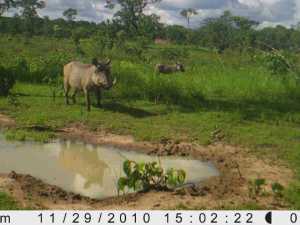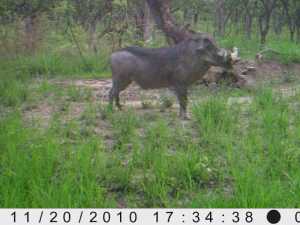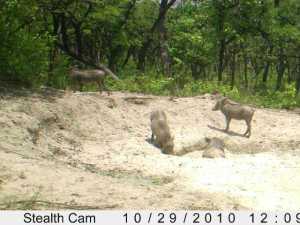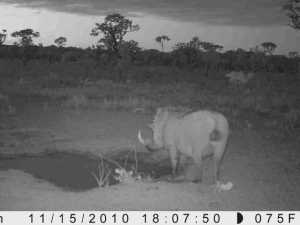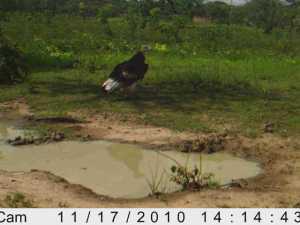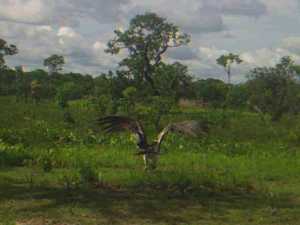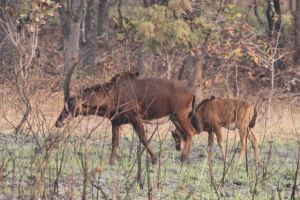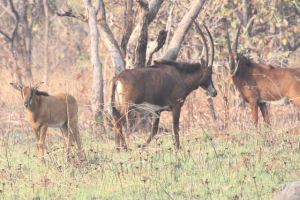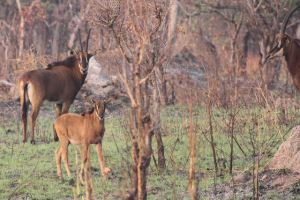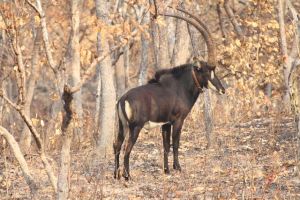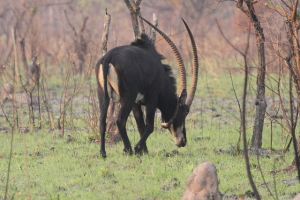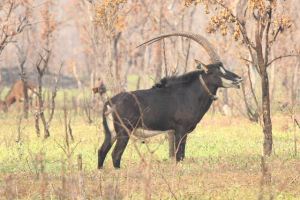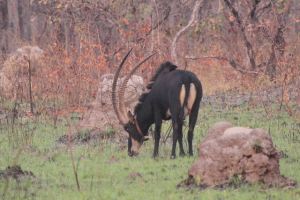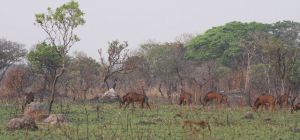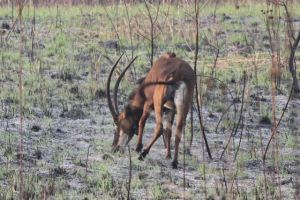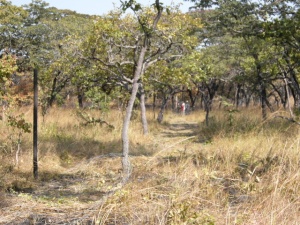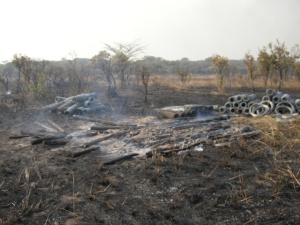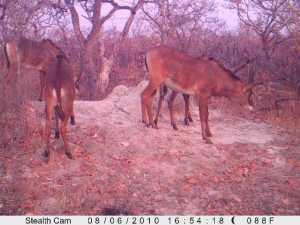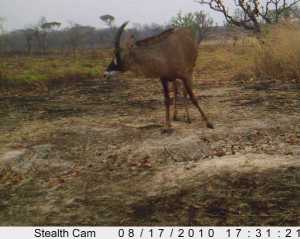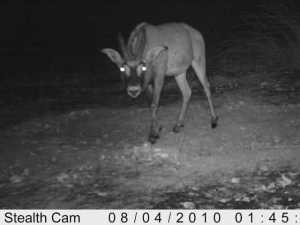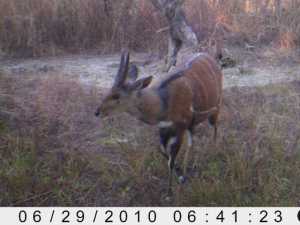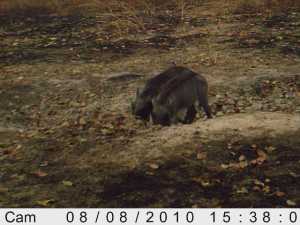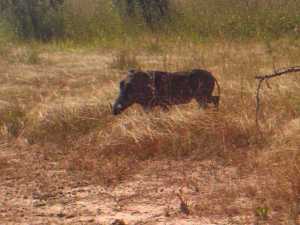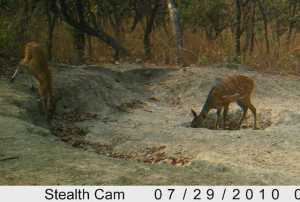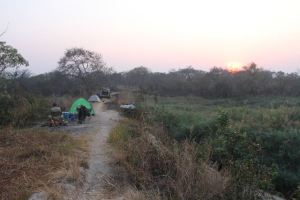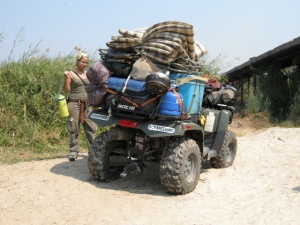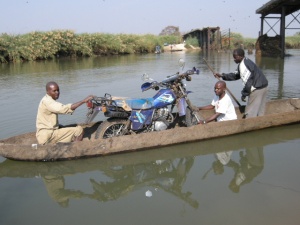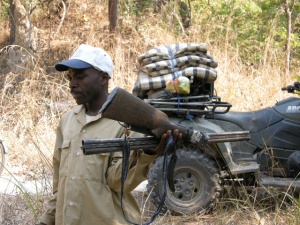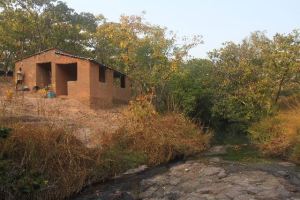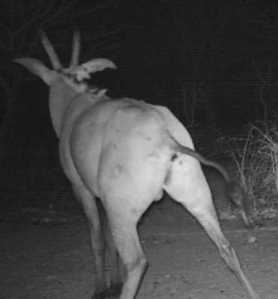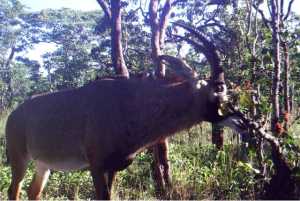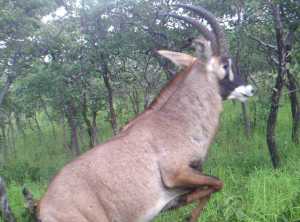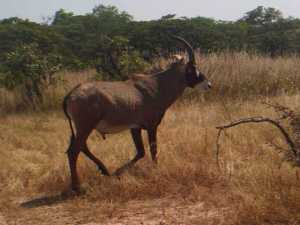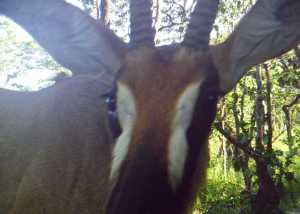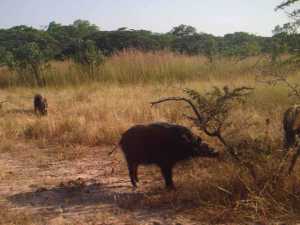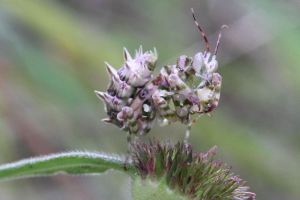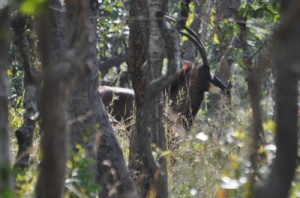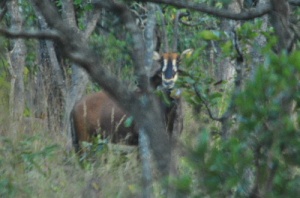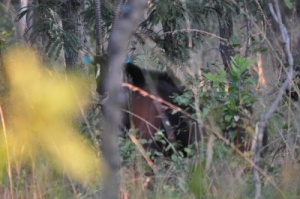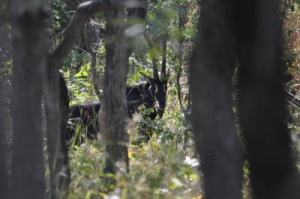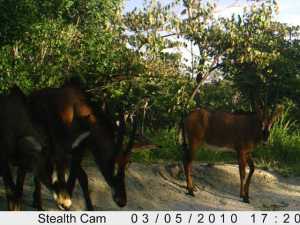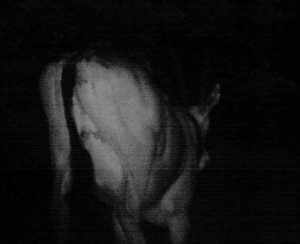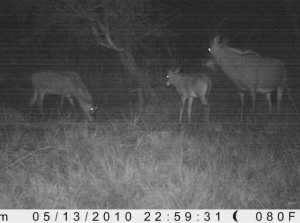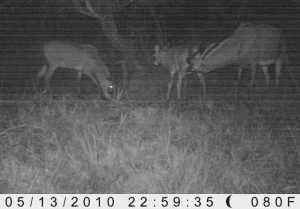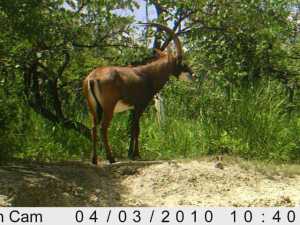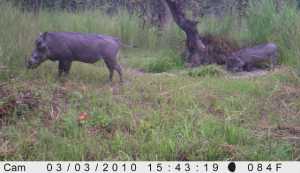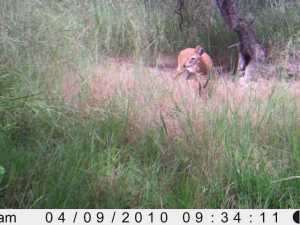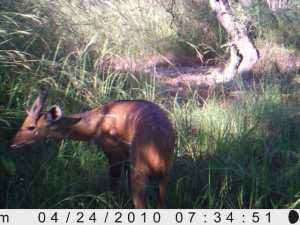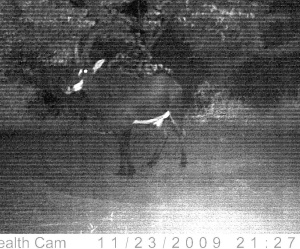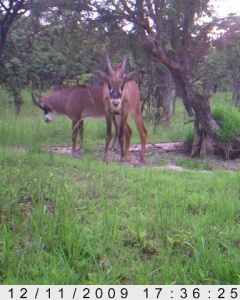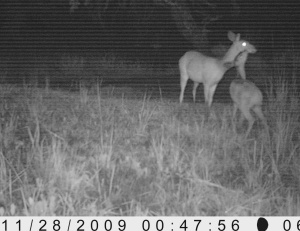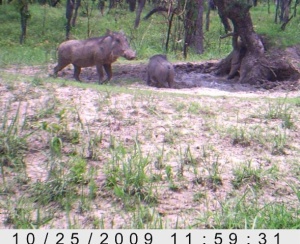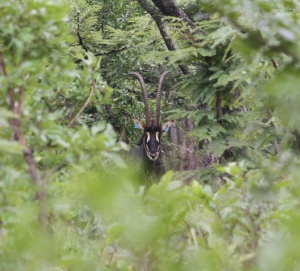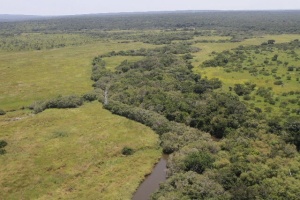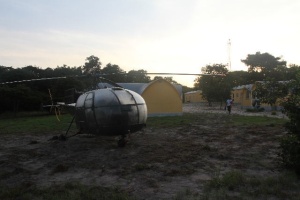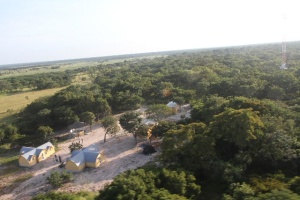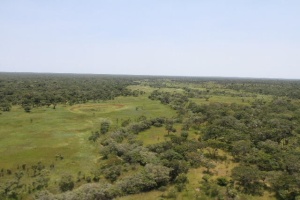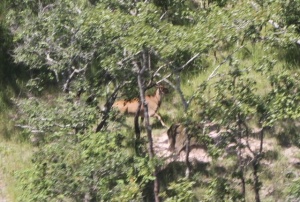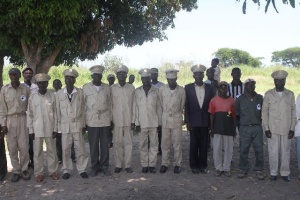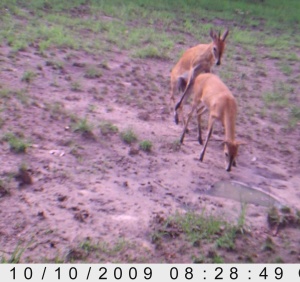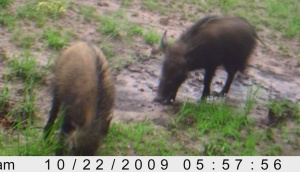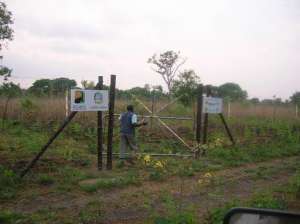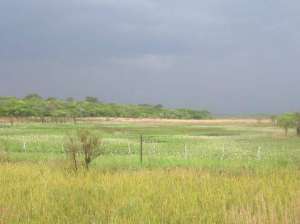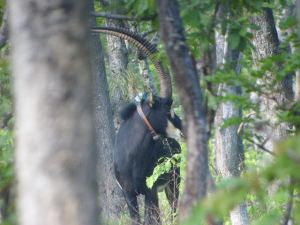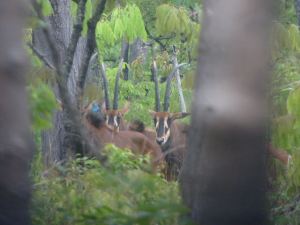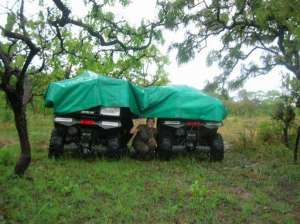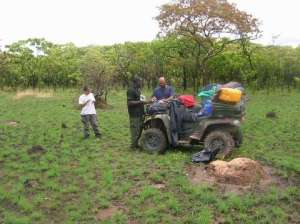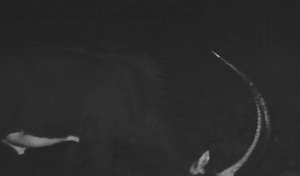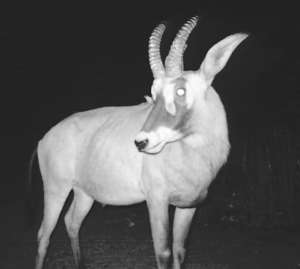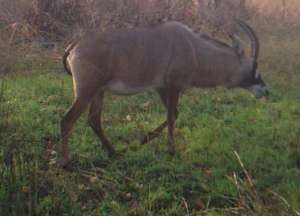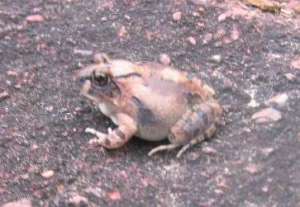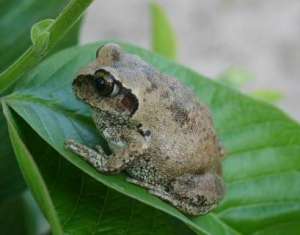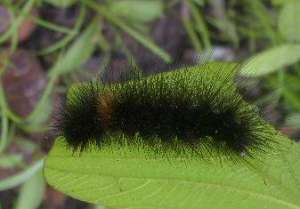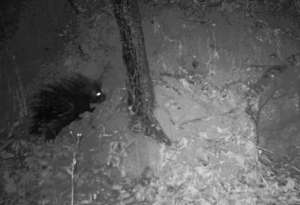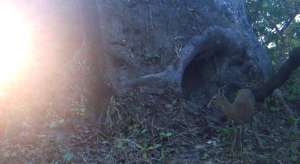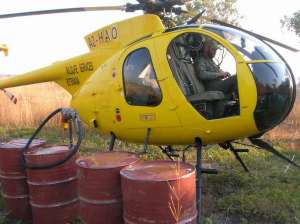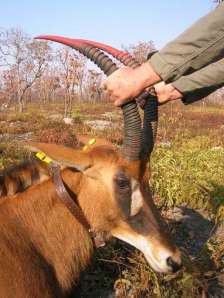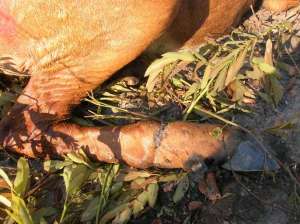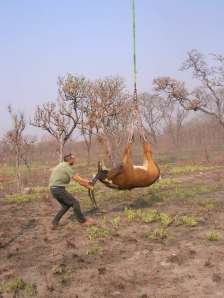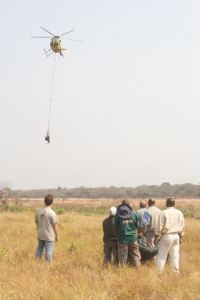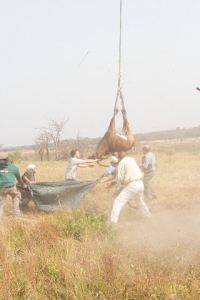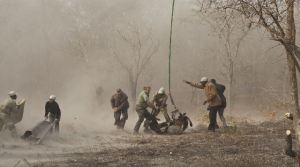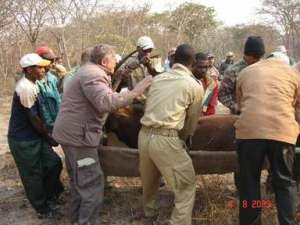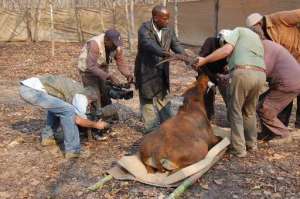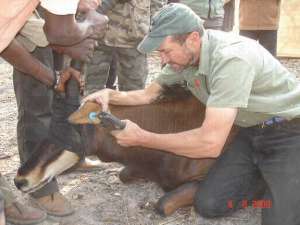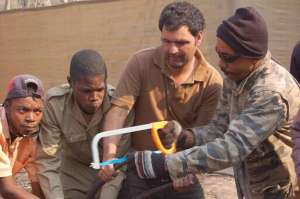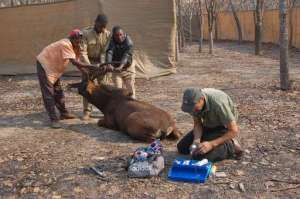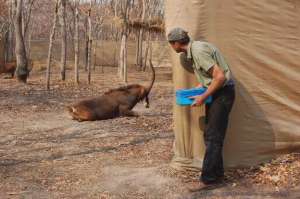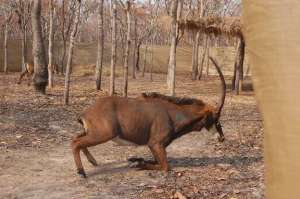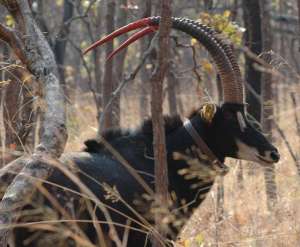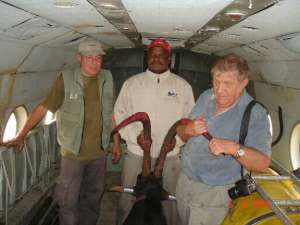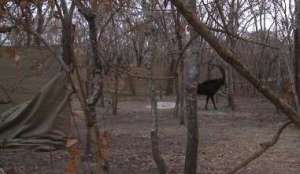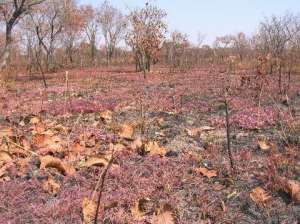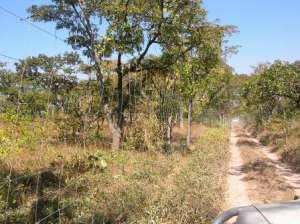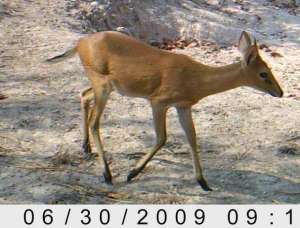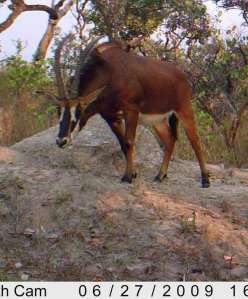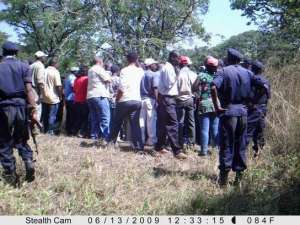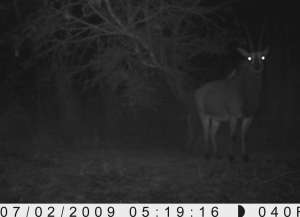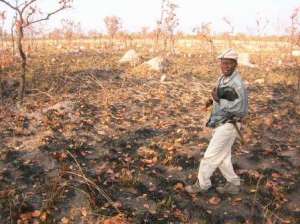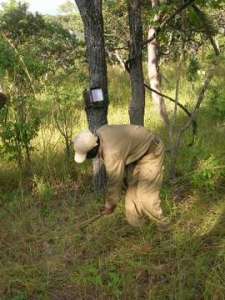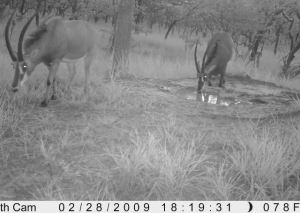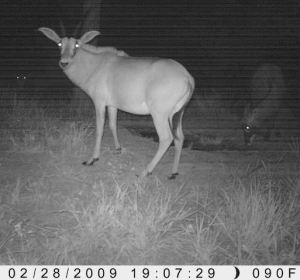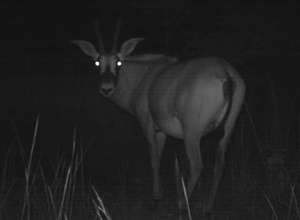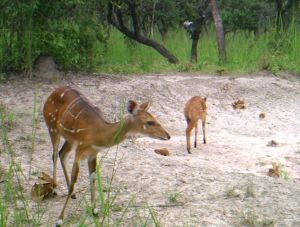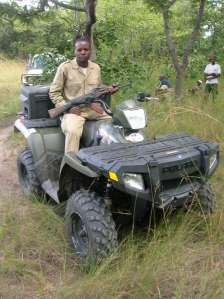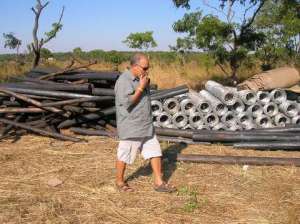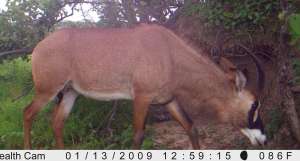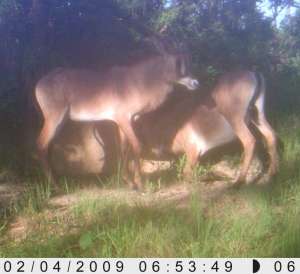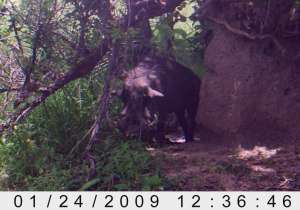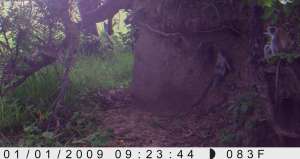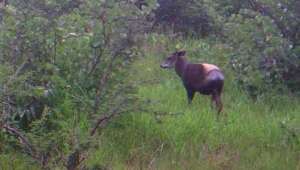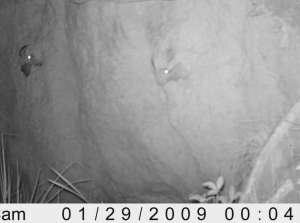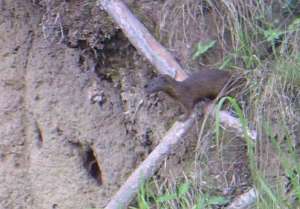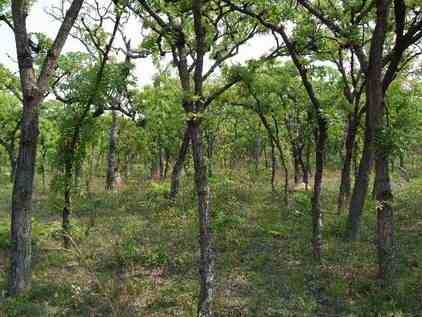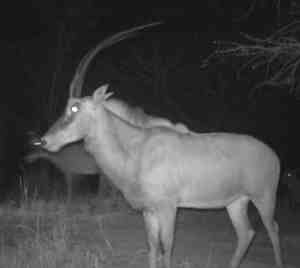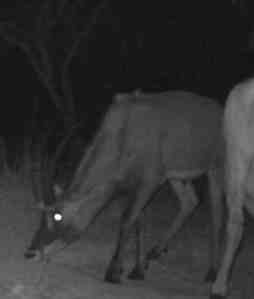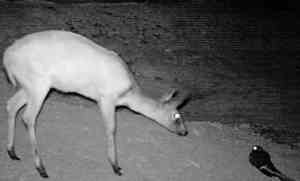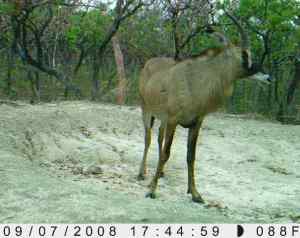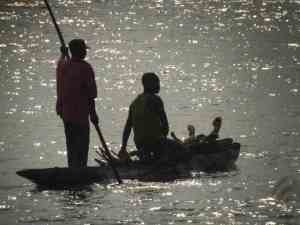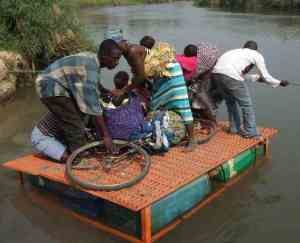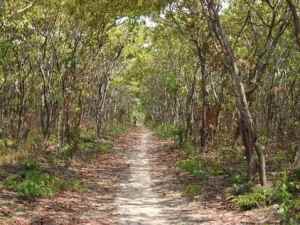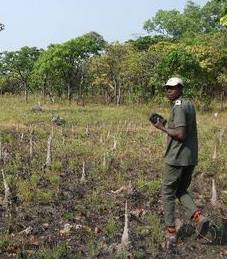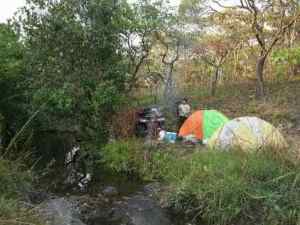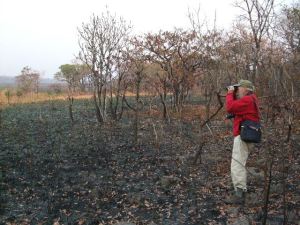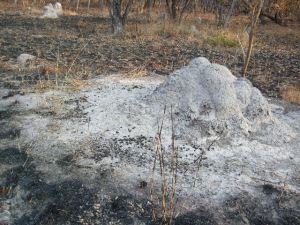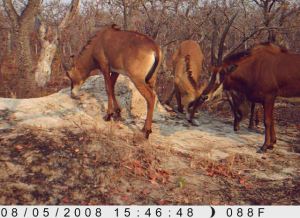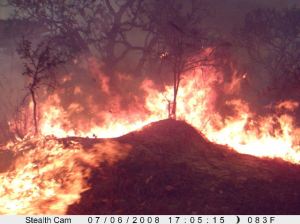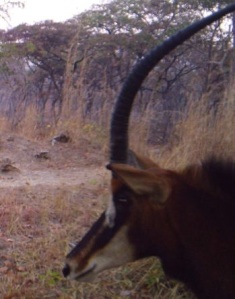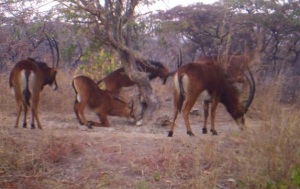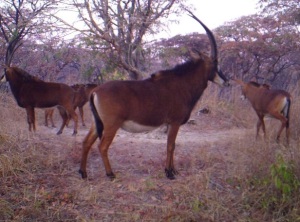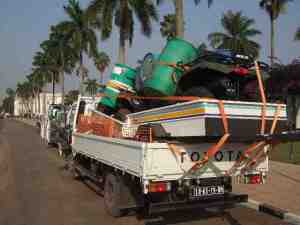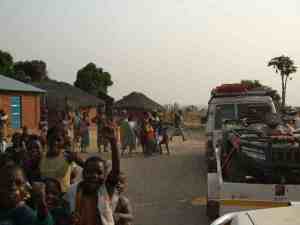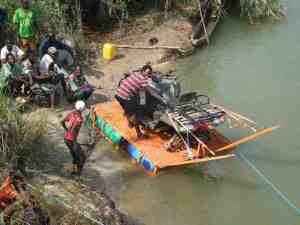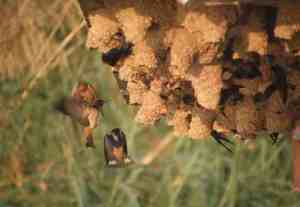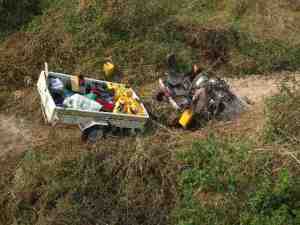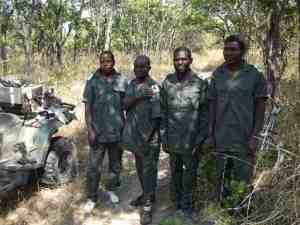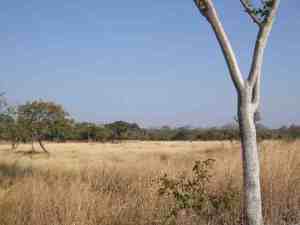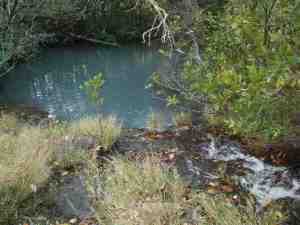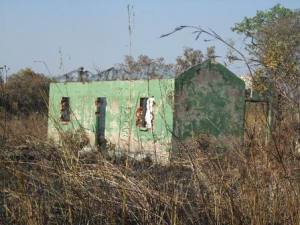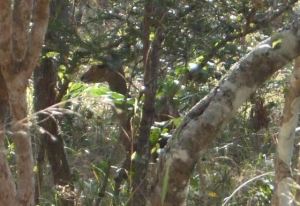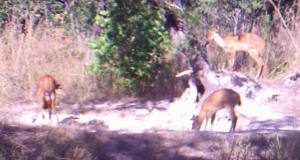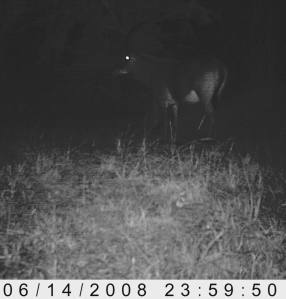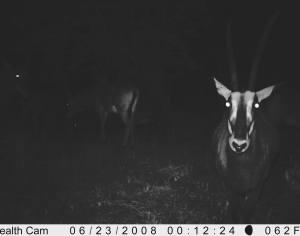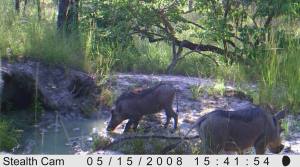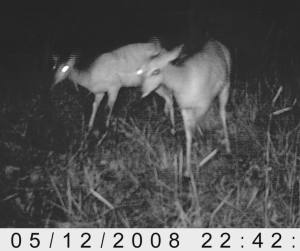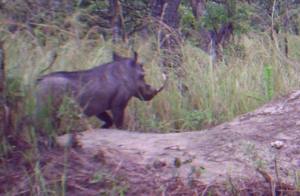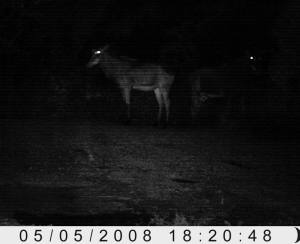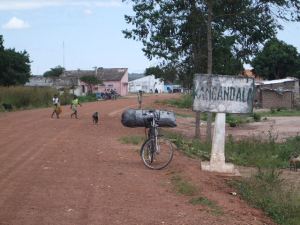The Angola Field Group looks forward to bringing you the latest developments from Cangandala National Park and Luando Special Reserve with monthly updates and photos, on what’s happening with Angola’s national symbol, the Palanca Negra Gigante or Giant Sable. Pedro Vaz Pinto, the man who re-discovered the Palanca Negra Gigante after Angola’s 27 years of civil war, heads up the Conservation Program to protect this animal which is on the list of the world’s critically endangered animals.
Scroll down or click on the links below to read the English and versão Portugês versions of Pedro Vaz Pinto’s reports. All photos and text © Pedro Vaz Pinto.
-
- 2020: 2020 Report (scroll down)
- 2019: Second Trimester 2019 Report, First Trimester 2019 Report and Capture Operation
- 2018: First Trimester 2018 Report, Second Trimester 2018 Report
- 2017: Second Trimester 2017 Report, First Trimester 2017 Report
- 2016: Third Trimester 2016 Report, Second Trimester 2016 Report, First Trimester 2016 Report
- 2015: Fourth Trimester 2015 Report, Third Trimester 2015 Report, Second Trimester 2015 Report, First Trimester 2015 Report
- 2014: Fourth Trimester 2014 Report, Third Trimester 2014 Report, Second Trimester 2014 Report, First Trimester 2014 Report
- 2013: First Trimester 2013 Report, Second Trimester 2013 Report, Special Capture Operation Report – July, Third Trimester – Final 2013 Report
- 2012: Fourth Trimester 2012 Report, Angola Field Group Presentation Video & Notes, Third Trimester 2012 Report, Second Trimester 2012 Report, First Trimester 2012 Report
- 2011: Third Semester 2011 Report , Second Semester 2011 Report , First Semester 2011 Report, January 2011 Third Trimester Report
- 2010: October 2010 Third Trimester Report , July 2010 Second Trimester Report, November 2009 to April 2010 Trimester Report,
- 2009: September & October 2009 Report , July & August 2009 Report, June 2009 Report, May 2009 Report , March/April 2009 Report , February 2009 Report , January 2009 Report
- 2008: December 2008 Report, November 2008 Report, October 2008 Report, September 2008 Report , August 2008 Report, July 2008 Report , June 2008 Report , May 2008 Report
- Read “Hybridization following population collapse in a critically endangered antelope”, an article published in the Scientific Reports published 6 January 2016. Authors: Pedro Vaz Pinto, Pedro Beja, Nuno Ferrand & Raquel Godinho.
- Download a revised and updated e-book edition of A Certain Curve of Horn – written by journalist, conservationist and artist John Frederick Walker
- At the end of this page you can read a selection of recent articles about the Giant Sable
- Click on small map image below to see protected areas in Malange province, the only place in the world where the giant sable is found. The small red area is Cangandala park, the large red area is Luando Reserve:
2020 Report
VERSAO PORTUGUES
Dear friends,Crazy year, with less to document than usual and for this reason only one annual report was prepared and is hereby presented. Due to the global pandemic, and more specifically to the measures adopted by most governments in the world in attempting to crush it – Angola being no exception, field activities were severely constrained. For several months I could not travel to the giant sable areas, and this hiatus covered the entire dry season, precisely the most important period to develop field work. I had never been away from the parks for such an extended period in at least the past 15 years. A hugely frustrating situation. Having several sables carrying GPS satellite collars and therefore tracked remotely from home provided modest compensation, but at least allowed me daily to keep a sort of ethereal link with the animals in the bush. Crucially, we were able to ensure the rangers’ routine work with the least possible disruption and communications were always maintained. Nevertheless, some important work could not be carried out, such as the reinforcement and amelioration of the remote ranger outpost. We had new equipment such as solar panels and batteries, but we could not get additional items and deploy the stuff to the bush before the first rains, so effectively and in this respect one full year was lost.
The extraordinary events of 2020 are also threatening to take a huge toll on the giant sable conservation, which may be nefariously affected in different ways. Most notably, there is an immediate contraction in economic activity which has caused some of our more reliable and long-lasting donors operating in Angola, to announce that they may not renew their contributions and even previously agreed commitments have been put on hold. But possibly even more worryingly, the economic strangulation is obviously much increasing the strain on people’s livelihoods, which in turn makes the prospect of adopting illegal activities such as poaching, more attractive and in some cases unavoidable. Sure enough, an increased poaching pressure has already been felt and is a major cause of concern these days.
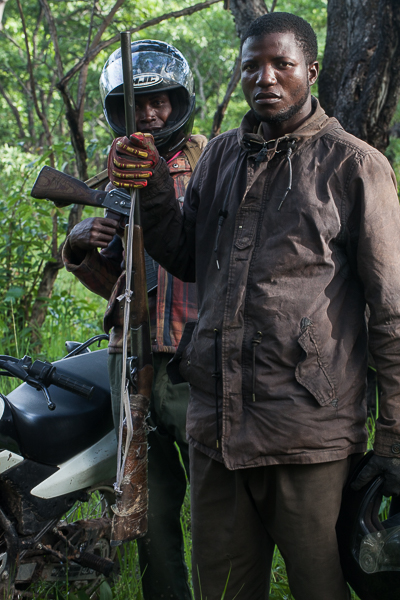
Our ranger Mulundika with shotgun apprehended from poachers.
Adding to all our headaches in 2020, the previous rainy season and for a second year in a row, turned out to be very mild and we ended up facing a severe drought arriving early in the dry season and persisting until recently.
In Cangandala National Park, we were unable to monitor the herd on site throughout the whole of the dry season, which stopped us from recording breeding indicators and much hindered our understanding of the ongoing social dynamics. This was not so much of a crisis in the sense that all giant sables in Cangandala, except maybe some odd escapee, are contained inside the 4,400 ha fenced camp and at least reasonably well protected. So, unless there was some emergency happening, the herd should be progressing relatively well. In Cangandala, and generally, no news is good news.
It wasn’t until early October when I was finally able to assess the situation and track the sables on the ground. First rains had already started in Cangandala Park, and the animals were less approachable than usual, likely a result of many months of “abandonment”. They had understandably became less accustomed to people, and reacting a bit more nervously on the approach of the white Land Cruiser. But this was half-expected, and can soon be reverted. The visit coincided with the peak of breeding season, when sable bulls are most active and tend to converge towards and around the female herds. However, and unlike the previous breeding season when we observed one very large herd concentrated together and comprising of the majority of the female stock and including most bulls orbiting around them, on this occasion it appears that the females were dispersed into smaller-sized groups, and each dominated by a single bull. Difficult to say if this was a temporary arrangement or an inevitable step on a naturally evolving dynamic as the groups tend to break when the herds become larger in number. I’m inclined to believe it was probably the latter and facilitated by increased antagonistic behaviour among females and/or bulls’ insisting and aggressive efforts to chase and isolate some of them.
Interestingly, the oldest bull Mercury was in top form and clearly in charge of one group and apparently undisputed, when at the same time last year he was under a lot of pressure from very impressive younger competitors that seemed to be more aggressive and well capable of overtaking him as number one. And we were able to also find a few young bulls, some hugely impressive, apparently stabilized on new territories.
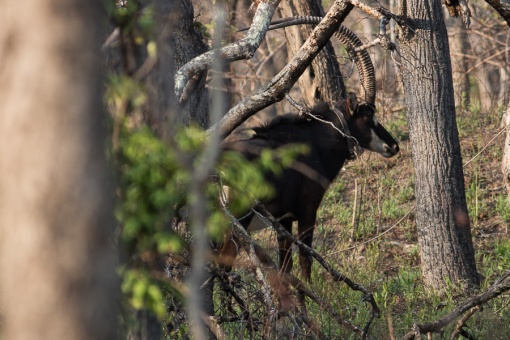
Vicente, very self-confident and imposing at just 5 years of age.
It suggests that most of the breeding season action may had already taken place, including some skirmishes between bulls, and therefore hierarchical relationships might be relatively stabilized in the sanctuary. Of course, this was just a very limited snapshot, a week of data after months of absence, and we are surely missing most of the data to build the narrative. Still, we know for a fact that at least some clashes have definitely turned violent, as the rangers found in July a relatively young bull, estimated age 5, killed as result of fighting – he showed clear signs of having been speared by the horn tips of another bull. It was an unfortunate but quite unavoidable event, and at the end of the day, a natural phenomenon that helps the populations to regulate their numbers while selecting for the fittest, strongest and more driven bulls to pass on their genes to the next generation.

Remains of a young giant sable bull that was killed by an intolerant older bull in Cangandala.
In Luando Reserve and failing the opportunities to monitor the herds properly in the dry season, we were able nevertheless to return in late October, and this time focused on trying to assess the condition of the herds, hopefully by filming them with drones, something we had done successfully in the past but not since 2017. That would only be possible thanks to the kind and enthusiastic participation of Jorge Ferreira, who came along with us and by bringing his drones and skillfully piloting these in the bush.
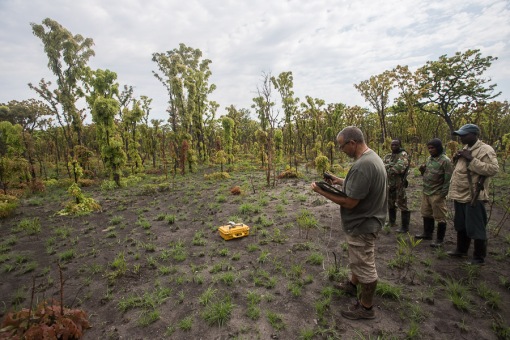
Jorge preparing the launch of the drone in an attempt to fly over a given giant sable herd, which had been previously tracked by GPS satellite, and triangulated from the ground via VHF telemetry.
It should be stressed that this operation could only be feasible because, contrary to the norm, rains had not yet arrived steadily by then in Luando, which following a very pronounced dry season, allowed us to make progress with vehicles outside the few existing roads. The plan relied on our team, which included the head of the law enforcement unit Fox and four more rangers, driving cross-country for about one week with two Land Cruisers and three bikes, to assess the mostly remote core areas of each of the five free-ranging giant sable herds in the reserve.
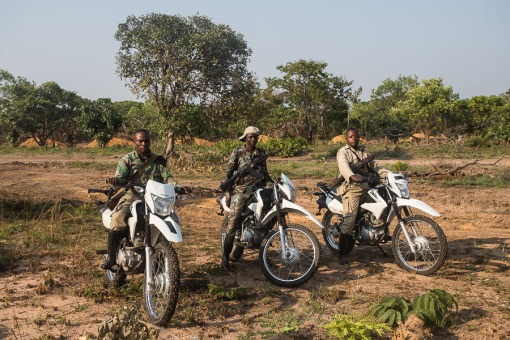
The rangers proudly display their bikes before we initiate our surveillance mission.
Although, and thanks to the daily GPS collar tracking over several years, we now have a pretty good idea of the home range of each herd, the areas covered by them are quite extensive, without access roads and the often thick bush makes visibility poor. We would maintain daily communications via satellite phone, to be informed of the most updated positions for a given herd recorded by the GPS collars. Usually, it took at least four to five hours (one day in practical terms) of off-country driving to get to each of the herd’s area, where we would set camp for the night. Early in the following morning, we would get the latest GPS position and make an approach to track and pinpoint the location of the herd by using VHF telemetry while keeping a “safe” distance estimated at around 500 to 1,000 m; once the first signal is picked, it becomes a straightforward process to do the triangulation. The final push would be sending a drone and trying to locate the herd from above and filming them for a while. Hopefully, this should give us updated metrics on the herd composition and recent breeding success over last couple seasons, etc. The droning process could take several hours, and if successful in filming the herd, we would return to unpack camp and drive off towards the site of the following herd, otherwise we tried again in the afternoon or the following day.
We have only five sable herds in Luando, and because of collar malfunction we lost contact with one of the herds – precisely the one in which only one cow had been collared, soon after it was marked. For this reason, we left this herd for last and focused on the other four groups. We did a poor approach to the first herd, which got spooked and forced us to postpone operations to the following day, but by then they had moved to a much thicker woodland. We eventually managed to film this herd with the drone, counting some 12 animals, but no conclusive data was possible to retrieve, because the tree canopy was dense and because we suspect that the herd being disturbed had split in two smaller groups. The second herd was a hugely disappointing experience, especially more so because we were dealing with the putative largest giant sable herd, numbering 40 animals in 2019. After some effort in locating and doing a proper approach, we then got the drone to fly over them in near perfect conditions, and we shot what we believed then to be beautiful and fairly long sequences with the animals in open ground. Great stuff, except that when we downloaded and tried to play back the films, we were shocked to realize that all the files were corrupted and were subsequently confirmed as non-recoverable! All effort was wasted, except for what we could see from the drone’s bird eye view in real time and which suggested the herd was healthy and probably numbered in excess of 35-40 individuals, including calves. We also did not succeed in obtaining footage from herd 03 but for very different reasons: after several unsuccessful attempts to visualize them from above following ground-triangulation, and during a short lunch break, the herd actually crossed at short distance an open savanna area right in front of us, which allowed for a fantastic sighting and a reasonable count. The group comprised of 21 individuals, plus the usual bull, which corresponded to a slight increase from 19 counted in the dry season of 2019. A herd increase of roughly 10% is within expectations. The fourth herd gave us some good footage, even though it was also a short sequence as they were a bit nervous and we located them with the drone running at low battery. We could only count 22 animals, which is a reduction from 27 recorded in 2019, but it is quite possible that we missed a few sables, especially calves. Overall, and strictly based on our footage and ground data, we believe the situation has remained broadly stable in terms of population numbers. Finally, we had to abort the survey of the fifth herd, as it was located in a much more remote region and without GPS tracking it could prove very difficult to find, but the main reason was that one of the Land Cruisers was overheating due to the radiator becoming clogged with grass and the weather was threatening rainstorms at any moment soon… so we decided best not to push our luck!
A new visit was made in November hopefully to try and approach sables again in Luando, but in the meantime the rains, although arriving late had by then started to fall with intensity.
-
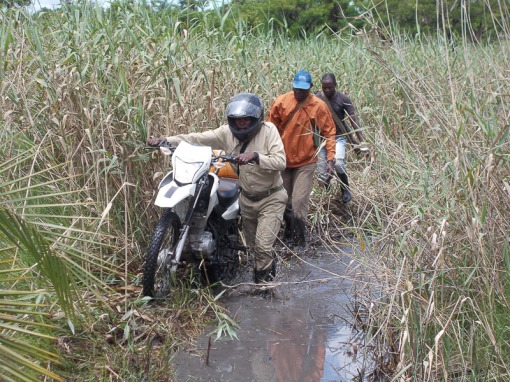
Well into the last rainy season, the water overflowing and flooding roads and grasslands in Luando, making progress for rangers very challenging even with bikes (Photos by Fox).
To make things more complicated, construction works to improve the old roads connecting the main villages inside the reserve were being executed, but the result of these actions was pretty much the opposite. By enlarging the roads and throwing in layers of uncompacted red clay, it was possible to transform narrow and tortuous but well-compacted old roads, into very wide mud tracks where under the rain our vehicles attained as much traction as in an ice-skating ring. I ended up stuck near the main village, and the only way to make progress was on foot or in bikes, and be prepared to endure tough wet and muddy conditions. Field work was very much hampered and trying to approach the herds was out of the question. All I could do, was to enjoy a few days in the bush and spend some time photographing plants and smaller-sized fauna.
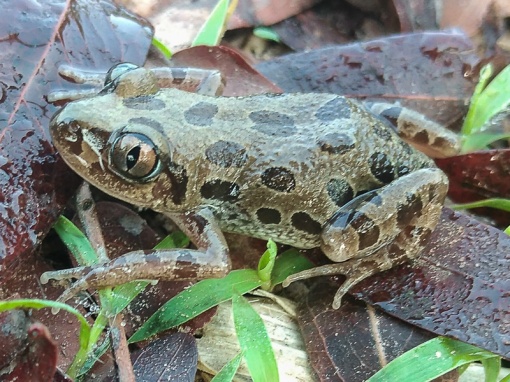
Bubbling kassina (Kassina senegalensis), more often heard than seen.
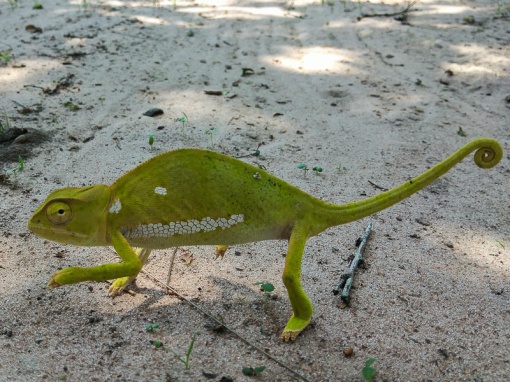
Common flap-necked chameleon (Chamaleo dilepis) on a ground journey.
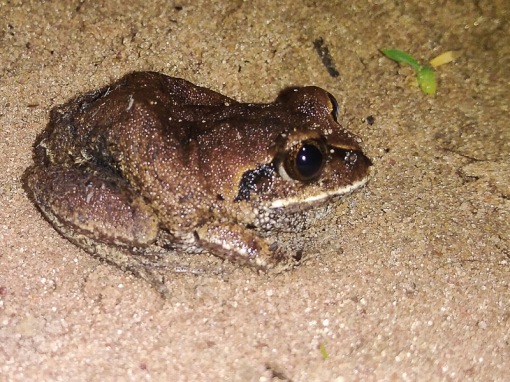
Almost exclusively ground-dwelling Bocage’s tree-frog (Leptopelis bocagii) – following months of concealment buried in the ground, these tree-frogs “explode” in visible numbers by sprouting out of their hidings immediately after the first heavy shower in September or October.
As referred earlier, poaching is still a major cause of concern in Luando, and this in spite of our growing efforts in recent years in strengthening the law-enforcement reach and effectiveness. Of course, poaching is an illegal activity that may never be eliminated, and its incidence is also a dynamic process responding not only to the relative success of our combating actions but also to external factors such as the demand for bush meat and influenced by socio-economic pressures. Given the very serious and partly pandemic-linked economic crisis that we are experiencing in Angola, it is not surprising that we believe to have detected a surge in poaching activities intensifying during 2020. During the course of the year, various poachers were intercepted or detained, and several shotguns apprehended. Crucially, and following the work initiated in previous years, we were able to keep the most important water holes well-secured from traps throughout the dry season. There is little doubt that the herd access to water points in the dry season is when they are at the most vulnerable, and we have long concluded that intense poaching with snares in these strategic sites for several years in a row was probably the single most important mechanism that led to the collapse and near extinction of giant sable in the post-war period, and even more so than the indiscriminate use of firearms. On the other hand, this is not to say that snares don’t still pose a serious threat, and the fact remains that rangers regularly come across “snare lines” – these typically consist of relatively straight artificial blockages arranged with bushes and cut trees crisscrossing the woodland and extending in length for a few hundred meters, in which every 20 to 50m an “opening” is made and duly trapped with a steel-cable snare attached to a 6m long flexible pole cut from a small tree.

Snare line in which we dismantled 16 traps, was found well within the grazing area of one of the sable herds.
These “snare lines” are usually placed in such a way that they surround patches where the grass was deliberately burnt a few weeks earlier to attract ungulates to the fresh regenerating grass. Such a system can be highly efficient throughout the dry season and during the early stages of the rainy season. Although we believe that sables are generally wary of these traps, and we actually witnessed one of the herds making a 90º turn in front of us to avoid crossing a snare line, this learning is surely acquired at a high cost. To illustrate this point, just a few weeks prior to our encounter with the herd and the referred snare line, the rangers had tracked down and observed one cow belonging to this group, with a severely injured leg and not far from the site.
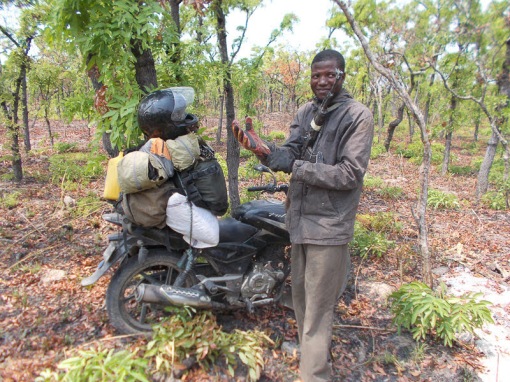
Ranger setting out for patrol in distant areas in Luando Reserve, preparing for several days outing (Photos by Fox).
The battle continues.
Best wishes,
Pedro
P.S. Photographic records and a couple sequences from drone footage can be accessed via the following links:
https://photos.app.goo.gl/BLkAcYqaBp4hEUKXA
https://drive.google.com/drive/folders/1UKTwwjGo3nar4jyHd5F5_7XVsb2i2eiq
- Second Trimester 2019 Report
VERSÃO PORTUGUÊS
Dear friends,Following the July aerial operation implemented in Luando Reserve, we kept ourselves busy throughout the remaining second half of 2019, which included the reinforcement of anti-poaching activities and the remote monitoring of collared sables in Luando, but notably we also carried out a darting and collaring exercise in Cangandala in October.
Looking back, we have moved a long way in Cangandala National Park, sixteen years since our first hesitant and quite unsuccessful on-foot survey. By then we weren’t even sure if giant sable had survived the civil war, and it took us a few years to conclude that only a few old cows were left, and all males had been poached in the park. Ten years have now passed since a bull from Luando reserve was flown from Luando to join the surviving nine females in a fenced camp, and nine years completed since the first little calf was born to mark the start of the new era. Being a male, the calf received the name of Mercury, a roman god of communication, travelling and soul-guiding, and also the planet closest to the sun. A lot of hopes and responsibility was laid on Mercury’s shoulders, but over the years he has certainly risen to the occasion, becoming the master bull in Cangandala and making a significant contribution to the breeding success of the local herd.
We estimate the current numbers in Cangandala to be around 80 animals, all still confined inside the 4,400-hectare sanctuary. All evidence and observations suggest that the herd is doing extremely well, as inferred by physical condition of animals, breeding rate and success, low mortality, and no indications of overgrazing or excess of antagonistic behavior. The last breeding season appears to have been exceptional, and quite well-synchronized, which likely reflects an ideal life cycle and we may interpret as the result of good conditions and adequate management of this population.
Calving peaked in June, and it was quite rewarding to observe in July and August, the formation of a large crèche with many young calves of similar age. This crèche comprised at one stage 20 little ones, which may well be the largest concentration of giant sable calves ever recorded. Adding a few off-season births in subsequent months, gives us good reason to consider 2019 as hugely successful year in Cangandala! Remarkably and confirming previous experiences, the giant sable herd seemed to be quite relaxed and tolerant of our presence when the calves are young and in crèches. The group-behavior appears to give them extra confidence, and even if the calves are still very vulnerable. This is in marked contrast with the period of May/ June, just before and during calving, when females tend to isolate themselves and generally become much more wary, and often not tolerating approach.
September/ October coincided with the onset of the annual breeding period, when males are increasingly more excitable, and females get in estrus. During this period, we witnessed very interesting behavior in Cangandala, some of which somewhat unexpected or at least not text-book material, but quite consistent with drone footage that we had obtained in Luando in previous years. This had mostly to do with the behavior of bulls and how they evolved and interacted within the herd. Instead of an increased fighting among males and dominance behavior that could be expected to lead to an inevitable situation of having one dominant bull removing all contenders from the herd vicinity, and being therefore more exclusive than during the rest of the year, we actually have is a bit of the opposite. We found all males present and cohabiting the same area, including the large master bulls, the younger territorial contenders and even the much younger from bachelor groups. It seems they all converge to the herd and orbit around the breeding cows. Sure enough, they’re not exactly all friends and there are obvious dominance rituals in play, but yet they manage to behave in a much more peacefully fashion than one would think considering their fierce reputation and being in the presence of those beautiful and receptive females. One can clearly see a hierarchy very well established, but everyone seems to know their rank, and its as if they’re not really interested in wasting energy in fighting with the bounty so near. Instead, it’s more of a free-for-all situation, with various bulls trying to corner different cows according to their rank, and we see even very young males sneaking around females when the other bulls are distracted.
This provided an opportunity for us to keep track of many bulls and younger males, including the majority of individuals born in the first few years of the program and some we had not seen in a long time. And we came across no males injured or in bad physical condition. I believe this deconstructs the notion that it is not possible nor advisable to keep more than one bull in a fenced camp with females because various males will waste too much of their focus in fighting, affecting breeding efficiency and will eventually kill each other. On the contrary, I believe that, at least providing the camp is big enough in size and the habitat conditions ideal, keeping the bull population increasing naturally can be beneficial, as the dominance hierarchy is likely an important selection tool to keep functioning which does not necessarily ends up in tragedy and may even stimulate breeding. Besides, it may also distribute the breeding opportunities across a larger number of males, thus maximizing genetic diversity and in a fair (and naturally selected) way. At the end of the day, it is likely that the exceptional breeding success and remarkable calving synchronization may be at least partially correlated to a healthy competition among existing bulls. If there is a lesson to be learned here, is to keep things natural as much as possible. Providing ideal natural conditions, from habitat to keeping social structure, appears to be the way to produce the best results!
Another “natural” development had to do with Mercury’s role in the herd. Assuming that he had been performing well as the main breeding bull for three to four years, we had decided it was probably a good time now to alleviate him of this burden. However, and much to our surprise, by observing the social interactions during the breeding season it became apparent that he had moved down the ladder, being now number three in the bull hierarchy! Not only his younger sibling Eolo is the current number one, but the number two position is now taken by an even younger bull, we estimate around seven years old, and tentatively identified as Ramses, a male we had lost track of a few years back.
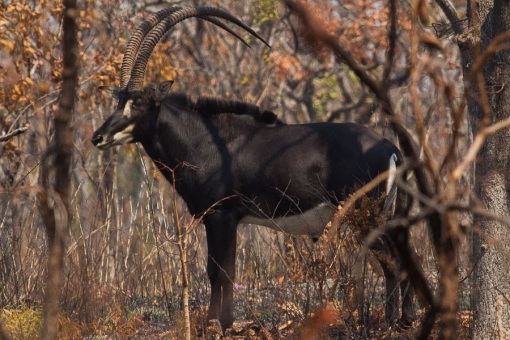
Surprisingly the herd was now being controlled not by Mercury or Eolo, but by a younger, yet quite impressive male – Ramses.
There is still another very large bull and a serious contender for number one in Cangandala, which we saw a couple times far from the herd and apparently not interested in challenging the established hierarchies, and possibly it will be another “lost” bull, Apollo. As for Mercury, in truth he didn’t seem too concerned or demoralized for having been demoted, not even he behaved like a defeated or vengeful bull. He was still as imposing and noble-looking as ever, transmitting the serenity and authority of a true leader, except when Eolo or Ramses approached and lowered their horn tips, in which case Mercury would calmly relinquish his position and move off calmly. Mercury still behaving as the herd bull most of the time, but it’s also as if he feels that it is not really worth it to challenge these young, powerful and testosterone-inflated bulls.
One cause for concern was observing one female with a very serious limp, which was clearly reflecting on her physical condition, and had very recently recently calved.
This female had a badly injured left hindfoot which she constantly licked, and she often stayed behind and struggled to keep up with the rest of the herd. Our previous experience in Luando demonstrate that leg injuries are frequent, but pretty much always caused by snares set by poachers. Would it be possible that there were active snares being set inside the sanctuary in Cangandala, even though we’re dealing with a fenced camp which should be reasonably well-patrolled regularly? We couldn’t believe that! Maybe, an alternative scenario could also explain the injury, like some sort of localized wound followed by infection… we followed the female a few times and took plenty of photos, but the cause remained inconclusive. We would need to dart the poor cow, and the opportunity would present itself in October during the second collaring operation in 2019.
We had initially intended to dart and move a small group of animals, including Mercury, from the main sanctuary to a new smaller camp and destined for tourism. However, frustrating delays in finishing some complementing yet crucial components, such as water hole and support and observation infrastructures inside the camp, adding the start of the seasonal rains, made it unadvisable to translocate these animals in October. On the other hand, we were concerned with the fact that our VHF collars were reaching the end of their battery life, which could soon make regular monitoring and future darting exercises much harder. All considered, we decided too still carry out a darting operation and focusing on marking animals and deploying new VHF collars. As always, and to implement this highly specialized veterinarian effort, we enjoyed the privilege of having Dr. Pete Morkel and this time co-adjuvated by Dr. Charlotte Moueix. We had also a reinforced support team present throughout the operation, with rangers and young researchers from Kissama Foundation.
The plan was to try to approach the herd from the Land Cruiser to dart the animals and deploy up to seven VHF collars, including females and bulls. Charlotte would do the shooting and Pete supervise all veterinarian procedures. We felt confident that it would be possible to approach and dart the first few animals, but if the animals started reacting and responding nervously it could prove difficult to dart more than a few individuals.
The first animal we darted was Nicole, the poor six-year-old female that was limping. Unfortunately, our worst fears were confirmed… she had been victim of a poaching incident, and still carried a steel cable deeply wrapped inside her foot!
It was a nasty injury, and with a cable knot tightly stuck between tendons, it took Pete and Charlotte more than one hour of stressful hard work, to remove the cable. Shocking, terrible stuff. Still, she was duly treated and should make a full recovery now. We estimate the poaching incident to have occurred less than six months ago and, of course, the worst part is now knowing for sure that there is active poaching with snares going on inside the sanctuary. It is hard to ignore that this sort of action in such a supposedly well-protected site, is likely done by locals with the participation or complicity of rangers, so this is a highly sensitive matter which we hope to tackle in the near future. Subsequently we darted a second female that also had been victim of a snare, although it had likely been a nylon rope more than one year ago and she had recovered well. Nevertheless, it proved we weren’t dealing with an isolated incident.
Other than the recorded injuries, the operation went extremely well and beyond our expectations. The darting went like clockwork, as we were always able to approach the herd and Charlotte didn’t miss one shot. Typically, the first Land Cruiser would approach first and dart one sable, which would soon go down calmly near the herd, and we would then park the two vehicles as to semi-block the view and handle the individual, often only a few dozen meters from remaining animals which pretty much ignored our presence. In just a few days we darted a total of nine females and seven males, all measured, photographed and ear tagged. We were able to deploy our seven new VHF collars and recycled two old units. All animals were sampled for future DNA-extraction and we were also able to obtain biopsies from ten additional individuals. We expect this way to fill in the blanks on our studbook and much improve our knowledge on how the diversity of the genetic pool in Cangandala is evolving. Although we didn’t immobilize the two older bulls, in general all males were very impressive, giving us the impression that successive generations of bulls are growing larger and with more powerful horns, possibly as result of increased competition? The largest horns measured were those of Ramses, at 54.5 inch horns, but a young 3-year-old male carrying 46.5 inch horns was equally impressive.
In Luando reserve and during this second semester we focused our attention in remote monitoring of the animals and anti-poaching on the ground. Having sables with GPS collars that can be tracked permanently has proved an invaluable source of information on their habits and movements and ultimately on stepping up their security. In July we had deployed two GPS collars on females in each of the five existing herds, except on the fifth herd (KI) that was only located on the last day of the aerial operation and for this reason in this case we could only mark one cow. In addition, six collars had been used on males, two on young animals in bachelor groups, and four on territorial bulls. Unfortunately, we have been facing some technical problems, and four collars ceased transmitting data before end of December, including precisely the two collars deployed on the young males and the one used on the only female collared in herd KI. The areas were thoroughly patrolled by the rangers soon after the collars stopped working, but we found no signs of foul play, so it was likely malfunction. A bit disappointing the fact that, once again, we lost track of the most elusive of our five herds. To make things worse, it is the largest herd and its home range is possibly in the now less secured area… pity. In compensation, the remaining herds are being very well monitored, and we could even observe interesting group splits in two of these herds, that occurred during the breeding season and have been maintained since. We might be witnessing for the first time how and when new herds are formed, but in alternative the split may also be explained by seasonal changes in the social dynamics. It will be fascinating to keep track of these movements over the next few months. As for the males they’ve been pretty much behaving as expected. One of the males is a herd bull and stays most of the time accompanying the cows, while three others appear solitary and were holding territories not too far from herds.
In order to increase our anti-poaching response, we have installed a brand-new military tent in the advanced post in Luando, and we have also purchased a solar-powered system with solar panels and batteries to be installed on site. Resulting from poaching incidents and poachers that were intercepted by the rangers, two motorbikes, three bicycles and two shotguns were apprehended.
Best wishes,
Pedro
Photos can be accessed through the link: https://photos.app.goo.gl/991JsFdosLnUPKs18
_________________________________________________________________
- First Trimester 2019 Report & July Capture Operation
Dear Friend,
July Capture Operation
In July we carried out the 2019 aerial capture operation, another crucial milestone and the corollary of many months of preparation. Resorting to specialized game capture team, including veterinary services and helicopter rental, it was the fifth such exercised implemented in 10 years. As in all previous operations, the key role on the team was played by our good friend Dr. Pete Morkel, one of the most experienced wildlife veterinarians and a legend in his field.
Just as in 2016, the pilot was Namibian-based Frans Henning. Unlike the previous exercises though, this time we could not hire a Hughes 500 chopper, the machine of choice for this job with our particular conditions. As alternative, we rented a Jet Ranger Bell 206, a somewhat larger, powerful and highly efficient and reliable chopper, but lacking the maneuverability of a Hughes 500.
We take here the opportunity to thank our main sponsors, namely (alphabetically): Angola LNG, ExxonMobil Foundation, Segré Foundation, Tusk Trust and Whitley Fund; and also smaller, and some in-kind, but relevant contributions for this operation, received from: Ecotur, Geigert family, NSCC, Oceaneering, Safari Enterprises and Step Ahead. We also recognize the role played by INBAC and the Provincial Government of Malanje in ensuring support at various levels, and, as always, a very special acknowledgement is due to the Angolan military (air force and army), who have assisted with fuel, logistics and organization details. Finally, we must also thank some individuals, who provided crucial support in organizing, advice, networking and logistics, namely Carlos Cunha, Genls Hanga, Sousa and Traguedo, and the Schaads (David and Ruth).
The 2019 capture operation was to focus exclusively in Luando Reserve and had pre-set the following main objectives: 1) an updated census of the giant sable population; locating the five known existing herds and, through a detailed photographic record, evaluating population demographic parameters such as sex ratios and age structure. 2) dart up to 20 giant sable and deploy up to 15 new GPS/Iridium collars and, if necessary, a few additional VHF collars; ideally, we wanted to put two GPS collars in two females on each of the five herds, and five GPS collars in bulls. 3) an assessment on threats, especially focusing on poaching evidence; an effort was to be made in visiting most of the water holes, and when appropriate, take action against poachers. As an extra, last minute addition, we would try to put a lion GPS collar if, during our operational flights, we were to be given such opportunity.
The operation went exceptionally well and almost all objectives matched our expectations. The only relevant shortcoming was that the lions didn’t come to the party, when none was spotted even though we did make a bit of flying over the areas where they had been last recorded. It would have been nice to dart and collar one lion, a first for Angola, but we knew it would probably be very unlikely and it wasn’t our main focus anyway. In brief, the operation was a huge success! In total, we darted 17 sable and deployed all our 15 GPS collars, distributed in nine females and six bulls.
No casualties, or incidents affecting the health of local animals as result of our actions, was to be recorded. Un updated survey was concluded, plus detailed demographic data and threat assessment.
We collared four mature bulls, presumed territorial, and one of them was accompanying one of the herds.
The territorial bulls were chosen randomly, and their estimated age was six, seven, eight and 12 years old, the latter, Ngola, had been darted but not collared in 2016. All these mature bulls were very nice healthy specimens, with average horns that measured between 52 and 56 inches in length. The largest specimen seen, however, was photographed twice in the first few days, but we didn’t have the chance to dart.
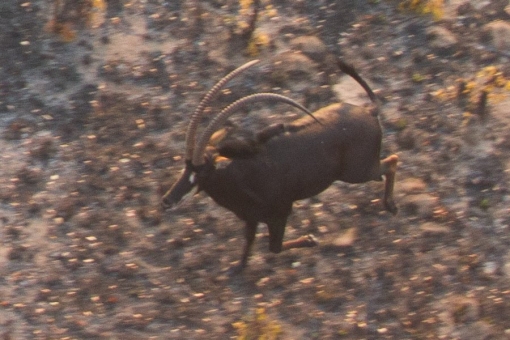
One magnificent territorial bull, surely the most impressive seen in 2019, but which we could not dart.
We also came across several bachelor groups – dispersing young males tend to aggregate in small groups for some time before eventually becoming solitary and establish their own territory. The bachelor groups seen had between two and seven males, of ages three and four.
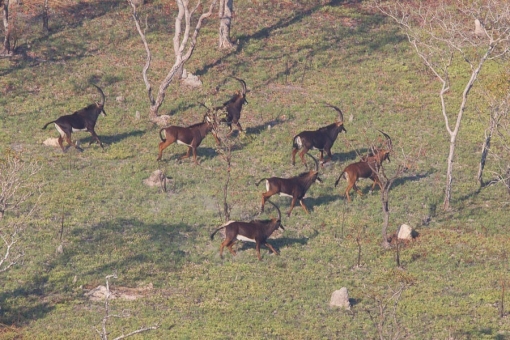
An amazing bachelor group with seven beautiful young males of ages 3 and 4 years old – one would be darted later on.
Although we’ve never done it before, this year we decided to collar two four-year-old bulls from different bachelor groups. They were both very nice powerful young specimens, with horn lengths between 46 and 48 inches. There is quite some risk involved here, as these young boys may roam aimlessly and easily get in trouble – they are surely more vulnerable animals to poaching or may also be killed by older bulls. On the other hand, by tracking a four-year-old we hope to detect and document the moment when they settle down and become territorial, a phenomenon that is still poorly understood. Regarding the bulls, the biggest surprise, by far, was finding Bruno alive, a bull that had been collared in 2013 and then estimated to be around 12, which would make him today 18 years old!
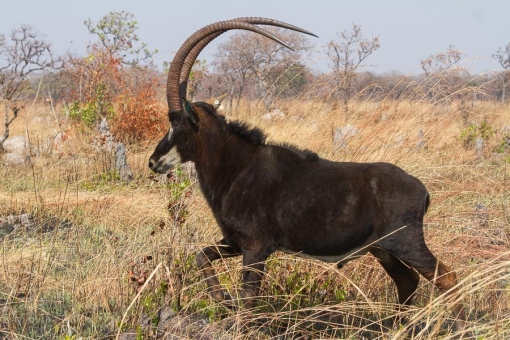
To our surprise we found and darted Bruno, a bull now at the estimated age of 18… he doesn’t have much more time to live; we removed his 2013 collar and wished him a peaceful ending.
Considering that we had never found a bull older than 15, this was quite a shocker. We darted ol’ Bruno and relieved him from his battered neck collar. As one would expect, he was in terrible physical condition, and most of his teeth were worn out down to the gums. He must not have more than a few more months to live… we let him go and wished him luck!
Always fascinating to report on the bulls, but the females are the crucial component, and we were eager to tackle the herds. The first four herds were relatively easy to locate and at the end of the seventh day of flying we had collared two cows on each of these herds, plus a couple territorial bulls.
The fifth herd (named KI), however, proved much harder to find, but very much like in previous exercises. This is the herd that occupies a home range furthest from our base of operations and furthest from the other groups, but it also the one for which we hold less information. Although this is one of our two largest groups and located in a region characterized by extensive anharas (natural clearings) and relatively open woodland, for some reason we tend to struggle in finding them. In 2009 and 2013 we couldn’t locate them, while in 2011 we found only a very small subgroup that had temporarily split, and in 2016 we only got them on the very last day of flying. In addition, we have also been unlucky with collars, as the only two GPS collars we managed to put in this group in the past, lasted only a few months before one collar broke and in the other case it was the female that died. The last remote data from this herd is more than two years old. As result, our knowledge about the routines of this herd is relatively poor when compared with remaining herds. To make things worse, even one additional VHF collar left in 2016 is missing in action (cow likely poached). So early on, we started looking for herd KI, but without much luck… we kept finding bulls in the region but not the females! After several consecutive days and many hours of relentless searches we came to the last effort on the very last day of flying… and that’s when we found them! This was a relief, but just like in 2016, by then we had only one GPS collar left, so we darted two cows and the second was released with VHF only. Now let’s hope we get better luck with these collars!
Comparing 2016 and 2019 demographic data for the five herds, we estimate a population increase of roughly 15%, which I consider a fairly good result. True that a well-protected healthy population could probably grow at a rate of 15% annually, which is how the Cangandala herd is performing, but given the insecurity in Luando and empiric data reporting the continuation of poaching activities, we feared it could be much worse, and even a population decrease could not be ruled out until we now pulled this survey. Equally important was determining that the demographic parameters in terms of age structure and ratios in every herd are now much better than ever recorded in the past 10 years. In short, the number of cows have remained stable or even reduced slightly, but in compensation the average age of females has dropped and the number of yearlings and immatures has increased significantly.
These parameters suggest a much healthier population, with a higher potential for growth in the short term, and one that appears to have suffered a lot less pressure from snaring over the last three years. As we had documented previously, snares affect primarily young animals, and were responsible for an unbalanced population with skewed age structure, when we had more old females than younger ones, and few yearlings made it to adult classes. During this survey, the age of darted females averaged seven years old, and only one cow was estimated to be over 10 years.
The impact of traps can also be inferred from scars carried by survivors.
In previous operations, the average of injured individuals among darted animals has been calculated between 20 to 25%. These have always included specimens with either extremely nasty leg injuries, such as with signs of necrosis or amputated legs, or active wounds that forced Dr. Morkel to perform emergency surgical procedures in the bush to remove ropes and steel cable snares, etc. In 2019, three handled animals had leg injuries, corresponding to roughly 18%, but on this occasion the wounds had healed and the incidents that caused them were estimated to have occurred several years ago. Also, two of the affected individuals – one bull and one cow, were older animals with estimated age of 12, and only the third was a eight year old female. So, the fact that the general population is now on average younger, and yet the older animals carry a much larger proportion of injuries when we know for a fact that young animals are the most vulnerable, is a very encouraging result because it is consistent with a recent reduction in poaching.
We did find less signs of poaching than in previous surveys, and not surprisingly, the herds closest to our new advanced post within the areas that have been patrolled more efficiently, are the ones that show the clearest increase in numbers! This not to say that there were no worrying signs. Especially in the region where the furthest herd resides – KI, and which have been rarely patrolled by our rangers, poaching was still rampant, and we found plenty of traps around water holes.

Although possibly less than in previous years, poaching is still a major concern in some areas, where the water holes were often full of traps aiming to catch sable.
Some of these traps were clearly targeting the giant sable herd, situated within a few hundred meters from where we eventually found the group, and also evidenced by the use of huge poles with steel cables or very large iron gin traps.
We cleared these sites, and a joint incursion with military for anti-poaching was prepared and will be carried out in subsequent weeks. On the other hand, and although we concluded that poaching with snares around water holes – the most damaging method, has been possibly efficiently eliminated in the regions where we have based the rangers, still we did find some poaching camps and it appears that here the poachers are now mostly resorting to nocturnal hunting with spotlights and shotguns.
Overall, the situation seems to have improved, and not only the giant sable population show a perceived increase.
Two other species in particular, appeared much more common than in any previous survey, the roan antelope and the reedbuck, which were easily recorded and daily. It is likely that they are responding well to the increased security in the reserve, and this probably also helps explain the resurgence of lions.
First Trimester 2019 Report
Not only the rains had initiated late in the last quarter of 2018, but they also ended early this year. Although there was plenty of localized variation, with some sites actually receiving a lot of rainfall, in most areas the rain had stopped by mid-March and soon after it had become apparent that we should prepare for a drought in the dry season.
In Cangandala things have remained relatively quiet, with the animals well adapted and protected inside the main sanctuary. The improvements to finalize the construction of the new tourism sanctuary were delayed due to bureaucratic issues and may well compromise the initial plan of translocating in the dry season the bull Mercury with couple young females, as part of his retirement package. Following several years of being the dominant bull, Mercury needs to give way to younger contenders. Of notice in this period, was the arrest made by rangers, of one poacher that had killed one waterbuck in the south of the park.
Regarding Luando we had started the year still battling with the consequences of the December poaching incident, when three poachers who our rangers had arrested red-handed with the remains of a freshly killed giant sable female, were shamelessly set free by the judicial system. Although in the previous report I blamed a judge for the unfortunate outcome, that was an incorrect statement. Instead, they were sent home by a local prosecutor with whom the poachers and respective families, managed to negotiate a friendly release. This of course raises some worrying issues regarding the conduct of local police authorities, but also means that the incident is not necessarily closed from a formal legal standpoint. We have since been trying hard to follow through the process at higher level, and we still hope the poachers will be called back and receive the well-deserved exemplary punishment. At the very least, we need to ensure that a similar chain of events will not happen again!
At least the incident stirred the waters and we felt poaching was temporarily reduced in Luando. On the other hand, it took some effort but we managed to maintain the advanced post with permanent ranger presence throughout the whole rainy season, now completing one full year. Reaching the post to ensure supplies and ranger rotations proved increasingly difficult as the rains progressed and the landscape became flooded, so we had to open alternative routes. In any case this was a crucial achievement, allowing us to much extend our effective security reach and establish a permanent presence within close distance to three of the five local giant sable herds. Before end of the year we expect to much reinforce this post with better equipment, such as a brand new military tent and a solar kit. In the future, possibly during 2020, we expect to expand further our presence by opening a new service tracks and establishing a new advanced post, but first we need to strengthen our management and logistics capacity.
At the end of first semester, still four GPS collars were still active and about to complete three years of work, which is quite remarkable. These included two collars in territorial bulls and another two in females, although the latter were both on the same herd. These collars proved instrumental in allowing us to better understand the whereabouts and behavior of giant sable, and much improved surveillance and targeted security.
If poachers appeared to reduce their activity markedly in our increasing area of influence, the most significant happening was the unexpected return of four-legged predators: lions! It had been a few years since our last recorded evidence of lions, but they now finally made a comeback. The first event took place in early June, when our three rangers based on the advanced post spent a sleepless night subject to the mighty roaring of a male lion. A lion roar can be a frightening experience as it triggers a visceral sense of fear in human beings, and this can be worse when heard for the first time ever. Our rangers are still inexperienced in many respects and for them a lion is a creature of tales, of which they had never seen, heard or smelled! They were totally unprepared, and it is therefore not surprising that they panicked, and then, against better advice, one even made random shots into the woods at night! In the words of one of the brave survivors: ‘- when the lion roared the ground trembled beneath our feet”, and ‘- the roaring was so loud that the leaves were falling from the trees all around us!’ So, a lion male was back! But, remarkably, and even more striking experienced was reserved for another ranger team a couple weeks later, when two rangers that had left the camp for a routine patrol, stumbled onto a pride of lions chasing bushpigs! They saw a male, a lioness, and four cubs. This is the first evidence of resident lion breeding in Luando for many decades! Needless to say, that the rangers got the scare of their lives. They made a hastily return, while setting the grass on fire on their rear. The return of lions can surely pose some risks to the giant sable herds, but it is likely a reflection of the increase in wildlife populations as the local ecosystems may be recovering some of its lost functions. In any case, this new development was most unexpected, and brings up a new set of challenges and opportunities that we expect to tackle in the future.
Best wishes,
Pedro
Photos can be accessed through the link:
https://photos.app.goo.gl/UZ7qyRVGHC8c4H4J9A short video can be accessed here:
https://photos.app.goo.gl/m3y8i2jmkAX7ZvKK7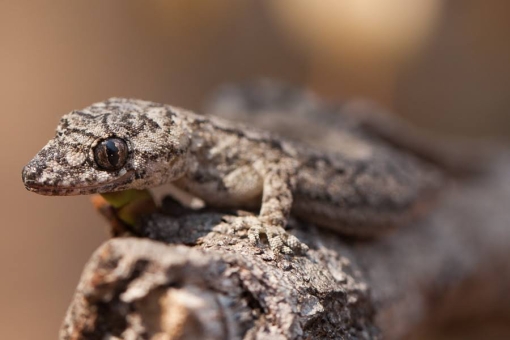
Quite common in the giant sable areas, this leaf-toed gecko appears to be a yet undescribed species and is the subject of ongoing research.
_________________________________________________________________
-
- Second Trimester 2018 Report
Dear Friend,
Second half of the year is typically busier for us on the ground than the previous and this one was no exception. As the dry season progresses and eventually gives way to a spring-of-sorts shortly followed by the early rainy season, the conditions on the ground tend to be the most favourable in terms of our own mobility, while the local ecosystems evolve in remarkable fashion.In July the climate is dry and harsh, the early mornings can be very cold and we witness the last seasonal wild fires; the landscape looks desolate and is marked by the burnt colours mostly greys, black and browns, there is no grass and the naked trees seem deceivingly moribund; this a time when sable cows have just finished calving and the herds reunite and are drawn to the anharas. During August the trees start regenerating the leaf cover and new grass is sprouting in pockets while the days are typically very hot, dry and windy; it is a good time to observe the sables, when the herds feast on the new grass and the little calves can be seen in créches.
September is the closest we have of a spring, characterized by a spectacular explosion of colours in trees and bushes, from light greens and yellows to deep reds; this is when the skies start accumulating clouds and energy and may release the first odd discharges.
It is also the period when bulls become increasingly agitated, challenging each other and moving great distances in search of receptive cows. In October we witness the first serious showers, but these are still very irregular in space and time; the breeding season has reached its peak and bulls remain nervous and excitable. During November the rains finally set in, becoming more frequent and generous, and this is when the bright colours fade and give way to the deep greens; bulls are now exhausted, they isolate themselves and have ceased the harassment of females. December can be considered a typical wet season month – the first of a few more to come, the grass is now well developed everywhere, the soil muddy and waterlogged, and a homogenous green blanket covers the landscape; the sable herds tend now to move deeper into the woodland but spending long periods in smaller areas, while bulls will routinely re-attend and patrol their territories.
In Cangandala we were able to testify once again the excellent results of the previous breeding season, confirmed by the large number of young healthy calves, which were often observed in créches. But possibly the most striking note the abundance of young males that can now be seen, forming several bachelor groups spread across the sanctuary.
Some of these males are quite young, under three years of age and having recently abandoned the respective herds, but others are reaching six years old and are quite handsome, even though they’re not yet ready to challenge Mercury, the resident territorial bull. As the mature and self-confident bull he is, Mercury is a pleasure to watch, as he is very tolerant of our presence and often allows the LandCruiser to approach to within 30 meters.
However, his dominant status can’t be taken for granted anymore and he is spending more time patrolling the territory and less time accompanying the herd. The main reason for his increasing restlessness is surely the presence of Eolo, who’s becoming stronger and more imposing by the day. Mercury is being challenged and by the end of the year it was no longer obvious who was the number one in Cangandala. In fact, one way or the other, Mercury’s retiring time is approaching fast, as we intend to move him in 2019 to a newly built sanctuary.
The recent appointment of a warden in Cangandala NP has proved very beneficial, improving general management in the park and culminated with the detention of a group of local poachers. These were caught while carrying bushmeat from several duikers and bushbucks killed in the park. The poachers were well infiltrated in the local villages and we have reason to believe that they had been doing their business for a few years with total impunity.
It is in Luando reserve, however, that most of our work is focusing these days, and where the tasks are more challenging. But here is also where our progress is becoming more significant. Our recently-appointed head of rangers for Luando, senior ranger whose war name is Fox, is doing an excellent job in training and organizing the sable shepherds and turning them into functional rangers. Our actions are finally having a direct impact in terms of law enforcement in the reserve.
The first crucial tasks that we had devised was fully implemented during this period. We opened up several bush roads and built an advanced ranger post 50 kms into the bush. This camp is situated on a scenic spot near a major temporary stream and a permanent lake, strategically close to three of the five surviving sable herds, and consists of a large tent placed on dry ground under the shade of large Brachystegia trees. Here we stationed teams of four rangers on two-week rotations. In the absence of radio repeaters and cell coverage in the reserve, we keep daily communications via satellite phones. The rangers keep motorbikes for routine transport, and logistics have been ensured weekly, initially by LandCruiser, and by quad bikes since November, when the rains made local roads impassable for regular vehicles.
By using this new post as an advanced base, we were able to penetrate much further in routine patrols and reach critical spots that required investigation. One of our first missions was rescuing two GPS collars from animals we knew had died a few months earlier. We had remotely tracked one bull and one female as they stopped moving, which usually can only mean one thing: death. They should have been both healthy animals, the bull was nine years old and the female was quite young at six years of age. Mature bulls can often fight to death, but in the absence of natural predation, the death of a young female is always a major worry – not only we lose an animal of greatest potential for breeding, but it also is a likely indication of poaching. In both occasions simply by tracing the remote data, we could only infer the death to have been sudden and without warning, so it was inconclusive as for the cause. Ideally, we should have been able to react immediately after the events were identified, but unfortunately it occurred in a very remote location and during the rainy season, and we lacked resources to react promptly. We had attempted a couple previous incursions but failed to reach the sites, which were relatively close to each other. Now that we finally got there, we were shocked to confirm that the female had indeed been poached and it was actually dismembered and smoked on site, and the poachers had camped there for a few days and didn’t even bother to destroy the collar or hide the evidence.

Intervening and recovering evidence on a poaching camp where a giant sable female was dispatched and smoked.
Very sad indeed, and we had arrived too late. We also recovered the collar and remains of the bull, but could not determine any obvious cause of death. It may have been a natural death, nevertheless, being a mere 4 km from where the female was killed is very suspicious, and it appears very likely that both animals were shot by poachers.
We believe, however, that from now on, we are better prepared to react immediately on future alarming signs obtained from GPS tracking, and reach most critical locations within 48 hours after an incident occurs and is detected. We are on standby at the moment, with a permanent team deep in the bush, with transport means and communications in place.
An unusual incident happened in Luando, when local witnesses reported the sighting of an allegedly “ill” big bull that entered some agricultural fields near one of the main villages in the reserve. This was somewhat unexpected as it took place in an area quite far from any recent confirmed records of giant sable. A team was sent to the site and the bull was located, but it had died a few hours earlier. Upon inspection it proved to be a very old bull, and there were no signs of foul play, and nor even fresh injuries that could suggest he had recently battled another bull.
On the other hand, his body condition was poor and his teeth were almost completely worn down to the gums. In all likeliness, this bull must have died of old age, unable to feed as his teeth lost their function once and for all. He was an old warrior with only one horn, as the other had likely been long lost in battle. Still, it was a very respectable horn, well-arched and measuring 57 inches long. Being found relatively far from the remaining sable population is consistent with it being a dispersing old bull, who has lost his fair share of skirmishes and may have been now looking for a quiet retirement spot to end his days.
The step-up of ranger presence and anti-poaching measures produced measurable results in several occasions throughout the past few months. Apart from localizing various temporary poaching camps that were duly destroyed, on one given patrol in October, a group of three poachers were intercepted near a camp site. These poachers managed to escape but their bicycle, ammunition and one shotgun was apprehended.
In their camp we found remains of duikers and warthog. However, we were still preparing for December, a month that is reputed to be the one most preferred by poachers, eager to enhance their earnings before Christmas. Every year it is claimed that poaching reaches a peak during December, so we wanted to be ready this time, and our senior rangers sacrificed their family obligations in favour of staying in the bush without interruption from mid-November till mid-January. And this bold move would produce results!
Benefiting from preliminary undercover intelligence work and with firm collaboration received from local villagers, we were informed in early December, that a serious poaching team had crossed the Luando river and was operating in a given region. The area in question happened to be the most remote location in relation to where our bases are established, and yet too close to our largest giant sable herd. This herd is therefore the more vulnerable, as it occupies a home range about 30km away from the next nearest group, and for this reason it has remained less protected. We reacted by sending our six best rangers to survey the area and prepare an ambush if possible. Sure enough, six poachers were intercepted and following a few shots fired, three got away but the other three were detained, plus one weapon, ammunition and three well maintained motor bikes. Significantly they were carrying various animal parts and remains and included the skin of a giant sable female. This was simply the first time in 50 years that poachers are arrested with evidence of killing a giant sable! Upon interrogation, the poachers confessed killing the giant sable in the previous weekend and reported that the smoked meat had already been sold and sent to local markets in the neighbouring province of Bié. They were returning to resume their activities when we caught them.
The success of this operation was a major achievement, and the rangers were very proud and motivated, and even the local villagers cheered the arrest of the trespassers. We had reasons to be optimistic, but unfortunately, despite all our efforts, subsequent events were to be a shocking disappointment and to cast a dark cloud over the current situation. Although we worked in close collaboration with provincial authorities, government, police and military and we thought that all the necessary steps had been taken to make sure the poachers would receive exemplary punishment, the judge ruled that the poachers should be released upon paying fine of AKZ 250,000.00, which was worth less than US $250.00 per person. This was a ridiculous amount, and worth much less than what they had already profited from selling the bush meat! This ruling blatantly ignored that the act of killing of a giant sable – our natural national symbol, had recently been criminalized and the fine set at the very impressive and dissuasive amount of AKZ 22,000,000. And yet they got away paying only 1% of what the law recommends because the judge took pity of them or possibly didn’t think this was such a serious offense. Needless to say, this was huge blow to the morale of the rangers, and even the local villagers feel frustrated and revolted against the judicial system. We are now trying to minimize the damage, and hopefully use this as leverage to force changes that may take effect in the future.
Best wishes,
Pedro
Photos can be accessed through the link:
https://photos.app.goo.gl/vFMgziEbUhWDZwoq7_____________________________________________________________
-
-
-
-
- First Trimester 2018 Report
-
-
-
Dear friends,
The new year started as it had ended the previous one… wet, very wet! And so continued until the very late end of the rainy season in May. After the drought in the previous year and seasons, the generous rains must have been quite welcomed by the animals, and allowed the regeneration of critical functions within the local ecosystems, by promoting abundant regrowth of the vegetation and replenishing of the water table, with streams and dry rivers coming back to life, filling of water holes and inundation of floodplains. These were excellent news and make us feel and make us feel optimistic for the ensuing recovery of sable populations, but didn’t exactly make our lives any easier on the ground, in terms of field monitoring. Indeed quite the opposite, and this was especially troublesome in Luando Reserve, where progress was slow and critical activities had to be put on hold for a few months.
In Cangandala, the copious rains gave way to abundant grass, a lot of grass really, tall, thick, and everywhere. In the end of May the soil was still too moist and the floodplains full of water, and by mid-June, when we finally could venture the LandCruiser off track, a thick wall of grass made it a nightmare for us to make progress, and the unavoidable tiny grass seeds released in millions quickly clotted the radiator, in spite of double protective nets.
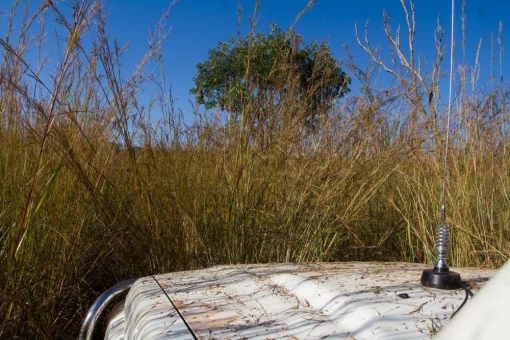
Explosion of grass making progress a nightmare in May and June.
It happens every year, but this season was worst than usual, started later and was more prolonged in time. But anyway, in the park things are simply going very well and at cruise speed. Sable are breeding exceptionally well, they are well protected and the area of the sanctuary is still big enough to sustain a fast growing population. We may have to consider in the future enlarging the full-protection area or releasing some pressure by moving part of animals, but these decisions may wait for at least a couple years.

Lots of young animals make the majority of the herd.
The long and intense rainy season has various and additional predictable consequences, one of which is that the controlled burnings and wild fires are likely delayed and less frequent. Probably a lot less surface will burn in 2018 both in Cangandala and Luando, although there is a risk that if the next rainy season is delayed, then the unusual accumulation of combustible material in the form dead grass may facilitate exceptionally severe wild fires in September, and these should be avoided if possible, particularly in Cangandala. Another not so good consequence, was that in the park we struggled to make preventive fires and controlled burnings to promote mosaic micro-habitats and regrowth of vegetation in strategic places, which tended to be highly favoured feeding spots by sable in the dry season. As the grass remained relatively moister than usual, very little was burned until end of June in the sanctuary. Still, we managed to partially burn some patches on the main floodplain and some small areas on a couple anharas, so these will surely become grazing and browsing hotspots for the animals shortly after in the dry season.
As result of the terrain conditions, we struggled to approach the sable herds in Cangandala, and the visibility was always blocked by the almost impenetrable wall of grass. In addition, the females were also quite dispersed and behaving shyly, surely a consequence of being calving or preparing to calve, or nursing their new-borns. We could confirm that Mercury was still routinely patrolling his favourite area, suggesting he still maintains an undisputed position of dominant bull. Nevertheless, we could testify that Eolo is definitely becoming more impressive by the day… his horns are beautifully arched and more imposing the Mercury’s, but he is also putting on weight and clearly appearing less slender and rather displaying a more muscular build, while showing a darker and shinier coat. It is probably a matter of time until Eolo challenges his elder sibling, and I suspect it may not take that long for him to become number one and the new master bull in Cangandala.
For Luando we had high expectations to increase monitoring and extend security measures across its vast wilderness areas, but the rainy season much limited our movements and as result various activities had to be put on hold. An effort was made in terms of increasing manoeuvrability, and a critical component was to solve the transport constrains. Throughout most of the rainy seasons it is impossible to drive a 4×4 vehicle off road in the reserve, and even the few main sand roads become quickly impassable, so the most efficient solution is resorting to bikes. In February we deployed three brand new Honda bikes, which we hoped would allow the rangers to reach remote locations in the bush, at least by driving through existing foot paths as penetration routes followed by foot patrols.
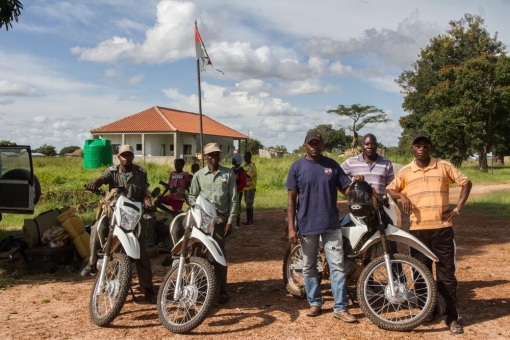
The brand new bikes arriving in Luando.
However, we had underestimated how wet the conditions would become this year, and soon after the bikes arrived it was evident that things would not work out as planned. Although the bikes are performing very well, they are not amphibious, and with the woodland becoming completely flooded in many places, the bikes had to be carried too often and long patrols turned into a nightmare.
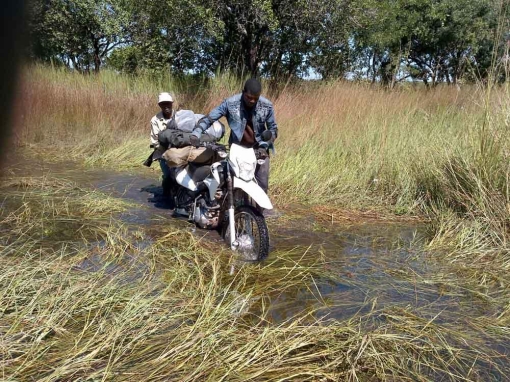
Luando inundated in March during patrols.
This was disappointing, as we had to freeze some important activities, but on the other hand the generous rains are encouraging as they must have replenish by now all the temporary water holes and this might be crucial for the local breeding herds. A new plan is now on the works to be implemented in the dry season, which will evolve around building access roads and deploying advanced ranger camps deep in the bush. These camps will be reached with 4×4 vehicle in the dry season and quad bikes in the rainy season.
In spite of the described constrains in movements, the step up of security measures initiated in the previous year is producing encouraging signs. In particular, the semi-permanent presence of two senior rangers, well equipped and maintained, and fully motivated has been a game changer in the reserve. And the fact that our senior rangers maintain a direct link and have been endorsed by the Angolan military, give us additional strength.
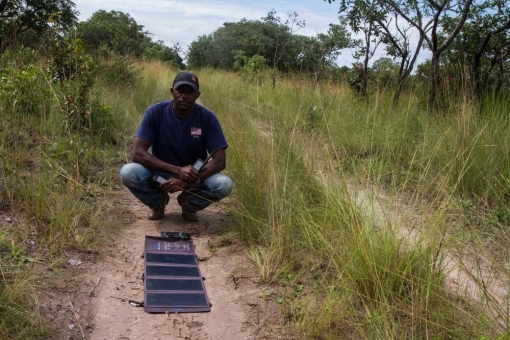
Senior ranger Fox charging the sat phone and GPS with solar panels.
Although so far only minor offenders (small game poachers) have been detained, the senior rangers are already well respected and feared. The message is clear: the giant sable is a national symbol and sacred, so Government and partners want to take seriously the mission to protect the species. Surely there will be problems ahead, poaching is far from eliminated and poachers are likely lurking and readjusting to the increased pressure, but we feel we are finally getting a grip on the situation. With training exercises scheduled to the second semester we hope to further increase security on the ground.
In the meantime, seven animals, four males and three females were still being tracked via GPS satellite collars until the end of June, which was quite rewarding as these collars thus completed two full years operating, sending a GPS position every four hours. They may not last much longer now, but their impact has been extraordinary, by giving us in-depth knowledge and pioneering data on the biology and behaviour of giant sable, and by allowing us to pinpoint with extreme accuracy the home ranges of various herds, the latter aspect being critical to improve security.

Mercury with his collar.
Throughout the first semester we were able to witness how different bulls moved across their territories and interacted spatially with other bulls and herds, and we could even infer interesting breeding and calving behaviour in females.
A lot of activities are planned for the remainder of 2018, and will be dealt with in the next report.
Photos can be accessed at the link:
https://photos.app.goo.gl/Jrwc95p28s7CgFZ38Best wishes,
Pedro
_______________________________________________________________-
-
-
-
- Second Semester 2017 Report
-
-
-
Dear friends,
The year of 2017 was possibly the most atypical in terms of weather conditions that we have witnessed since the start of the project. A most severe draught caused by very little rainfall between January and March gave way to a prolonged and very stressful dry season, which in turn was followed by precocious heavy rains starting in September at full-throttle.
In Cangandala I have sad news to report: Ivan the Terrible passed away on July 10th 2017, inside the sanctuary.The death of an old warrior who lived a most eventful life. Here’s a synopsis of his bio: An imposing bull, massively built and scarred from battles at age 8 when we first found him in Luando in July 2011; was then darted twice, collared, flown inside a military MI-17 chopper, taken for a ride on the back of a pick-up and released inside the sanctuary in Cangandala; within one week upon release he killed a young innocent 2 year-old bull stabbing him several times, and soon after broke through the sanctuary fence and escaped; established his new territory in Cangandala outside the fence and showed little interest in joining other sable – social skills weren’t his strength; proved to be elusive as a ghost, never allowing approach from the ground, and eventually managed to break his radio collar; in May 2012 he fought the patriarch bull Duarte through the fence, leaving the latter in a pitiful state, badly injured and humiliated; but even after defeating the dominant bull Ivan didn’t take the bounty and apparently ignored the unattended females; in March 2013 challenged again the old bull Duarte, who had taken many months to recover, and once more a terrible fight occurred across the sanctuary fence but this time it must have been too much for good ol’ Duarte and he was never seen again – surely Ivan finished him off; in August 2013 we flew several hours with helicopter over his territory hoping to recapture him, but never got a glimpse; before the end of the same year he was victim of a snare trap that barely took his life – he was caught by the left front hock and must have endured immense suffering; throughout 2014 he was a shadow of the former Ivan, skinny and limping, he lost his jet-black coloration and his bravado; by end of 2014 however he seemed to have recovered to a relatively good condition, but then he mysteriously disappeared for over one year – we have no idea where did he go and at the time feared for his life; he resurfaced early in 2016, now apparently fully recovered, and then endured a couple skirmishes across the sanctuary fence with the bull Mercury; in July 2016 we darted him from helicopter and he was then released with a GPS collar; in March 2017 he went into a terrible battle again through the fence, and resulting from it he ended up moving into the sanctuary – after six years of freedom and adventure in Cangandala, he decided to return to captivity, where he finally died. R.I.P. Ivan!
His death appears to have been “natural” and peaceful, although we suspect that it may have been caused by the fight that resulted in his return to the sanctuary in March. At the respectful age of 14 and after having endured so many battles and life-threatening situations, he should have settled down, but I supposed that would have been against his nature: a life on the edge and always to the limit… in that sense one has to wonder how he managed to live this long! Our first suspicion was that he had last fought Mercury, but we have now concluded that most likely it was the latter’s younger sibling Eolo, age 5, who finally defeated Ivan, as he was established in a territory that includes the area where the battle took place. Poetic justice could be claimed as Eolo revenged the death of his father Duarte, which took place when he was just a few months old.
Eolo succeeded in completing the task where his two older brothers have failed – we know that Mercury had a few encounters with Ivan but they never came to anything, likely because Mercury was too smart (or coward?) to push things further; and Apollo has long disappeared without a trace, very possibly killed by Ivan.
Before recovering Ivan’s skull we placed a trap camera, and the absence of specialist scavengers in Cangandala became once again evident, when only warthogs visited the site to pick some rotten flesh and gnaw on the bones.
Sable breeding in the sanctuary is going exceptionally well and the population is steadily increasing. We have surely more than 60 pure animals at the moment and with a very healthy age structure – these days, calves and young make up for the majority of giant sables in Cangandala.
A malfunctioning water pump forced us to manually supply water in basins during part of the dry season, but the animals soon adjusted to the change and were often observed congregating around water. Mercury has assumed his leading role, and inherited the gentle nature, tolerance and serenity from his father Duarte, which exerts a relaxing influencing over the females, and is most convenient in allowing us to approach the herd at close range. We therefore achieved plenty of good group observations.
On one occasion we witnessed a short skirmish between Mercury and Eolo, when the former made an incursion into the latter’s territory. It didn’t last long and had no consequences, as the animals seemed to be probing each other and dispersed when we tried to approach further, but I still got a few lousy photos.
Eolo is more elusive and nervous than Mercury, but he promises to soon become an exceptional specimen: he is still lighter in weight, more elegant and with much less muscular built when compared to Mercury, but he is a beautiful animal and his horns are very impressive and quite larger and more handsomely arched than Mercury’s. Eolo’s horns were measured at 49 inches when he was collared in 2016, but he must now be well above 50 inches in length. We were able once to approach him and get some very nice photographs as he browsed on their favourite species “kinzole” Diplorhynchus condylocarpon.
In Luando the giant sables are being tracked remotely, and the data obtained are allowing us to keep a daily surveillance achieved via satellite communications with the shepherds. We have invested through training in capacitating some of them in the use of new technology.
Basically they have been given a Thuraya satellite phone and have been trained in the use of maps and GPS. The equipment is charged with foldable solar panels and portable power banks, and the system is performing very well. We keep regular communications and a red flag is issued when abnormal movement patterns are detected from the remote data transmitted by the GPS collars. This has allowed us to investigate quickly suspicious events, and at least once this lead to poachers being intercepted and one shot gun apprehension. One freshly killed female, Samra, was located soon after her death and all evidence point to a poaching incident. Analysing the remote data we could see that she stopped moving suddenly, and strangely the collar ceased transmitting upon 24 hours – it would be a strange coincidence if the collar had a malfunction so soon after the animal’s death. When we performed our CSI on the ground we realized that everything was in place but the collar was missing! There was no evidence of snaring as the legs were in perfect condition, and the animal also appeared in good physical shape prior to the incident. We concluded, even if the wounds weren’t obvious, that she must have been shot; then the poachers only found the carcass one day later and decided to abandon the scene (was the meat too rotten, or were they afraid of being caught and accused of killing a giant sable, is anyone’s guess) not before destroying the GPS collar and getting rid of it to avoid leaving traces. It makes it two the number of collared giant sable poached in 2017. On the other hand, our CSI performed to the old cow Jinga led us to believe that she died of natural causes, likely of disease, as she was in very poor condition when she died and even in the previous year she had shown signs of disease.
With two other collars ceasing transmission, possibly due to malfunction or batteries running flat, we ended up 2017 with still 10 active GPS collars, which is not bad at all. These allow us to still keep four of the herds under close permanent surveillance. An interesting finding from the remote data was observing how the herds changed their behaviour in response to the severe draught that affected Luando this year. As all the water holes dried up early in the season, most of the herds shifted their home ranges towards permanent rivers or water courses, with the exception of one herd which, to the best of our knowledge, had no access to water throughout the dry season.
The complete drying up of water holes must have been stressful for the animals and was also disappointing for us, as we had previously invested in mapping them all and had planned a thorough cleaning operation and permanent security monitoring of these hotspots during the 2017 dry season. From our previous experience, these water holes are by far the most dangerous places for young sable, where they frequently fall victim of snares and foot traps, and this time when we were finally prepared to make an impact the climatic conditions changed the rules of the game. The animals moving towards river courses may reduce the risk of them getting into snares, but on the other hand it forced them to explore new areas of sub-optimal habitat and where there’s a lot more chances of encountering people, including poachers. In addition it made it much harder and less efficient for us to patrol them on the ground.
While monitoring on the ground one of the herds that we kept under remote surveillance, the shepherds located two sables that tend to stay apart and eventually got behind when the herd moved a few km away. They reported that one of the animals appeared to be injured and had a severe limp. Over a few days in August we tracked down the herd and photographed these animals. One turned out to be a known adult female, Helena – age 8, which had been darted in 2013 with an amputated leg caused by a snare a few years earlier; and the other a yearling male also limping from a snare injury. The fact that Helena is still alive a few years later, even though three-legged is incredible, and if nothing else it suggests that natural predation on sable is likely insignificant as she would have been an easy target. On the other hand, coming across the yearling male with injured leg was shocking and another reminder of what we’re facing in Luando. We suspect that he must have been caught while attempting to drink in one of the water holes at the end of the rainy season, before they had dried up and before we had implemented the surveillance system in July. Once more providing further evidence to our previous findings, it’s the yearling and 2yo animals the ones most vulnerable to snares.
Another casualty was the one-horned old bull that we droned in 2016 when he was dominating our herd BO and remarkably keeping at bay a couple of monster bulls, including the 59 incher Lucas. On a routine patrol the shepherds came across the skeleton of the one-horned bull, but there were no signs suggesting foul play, and his teeth were worn out, meaning that he must have been a very old bull, likely over 14 years old, and probably died of natural causes.
Once again we flew the drone over two herds, this time in the dry season, and while we intended to do it on all of the five groups during the breeding season we were forced to abort due to sustained heavy rains that made it impossible to drive off-road still early in October. In any case we got good footage of one herd in August, and we were happy to record that it had increased from 21 to 26 animals in one year. This result was mostly due to a remarkable recruitment rate and no mortality of yearlings – at least this group had not affected by snaring.
Following national elections in September, a new President and Government was appointed in Angola. Changes are happening at various levels, some being most promising for the future of our natural heritage, and a special commission was created in December by presidential decree for the protection of the giant sable.
Photos and short video sequence can be accessed via the following link:
https://photos.app.goo.gl/Ma1zh4QaZd1A1A2z1Best wishes,
Pedro
_______________________________________________________________
-
-
-
-
-
- First Semester 2017 Report
-
-
-
-
Dear Friends,
This report is long due, and I apologise for delayed communication. I intend to make up for the lost time and get things back on schedule for the remaining of 2017. Anyway, here goes an update for the past few months.
Following the 2016 capture operation we had plenty of things to do in both reserves. In Luando we started by remotely tracking eight females and seven males. The collared females had been distributed by all five surviving herds, while the males were all solitary bulls. Thirteen GPS collars were still active and going strong by end of May 2017, but we were forced to stop tracking two animals when the signals became stationary. It is almost guaranteed that both specimens have died, but they are located in very remote areas, and until we get the chance to retrieve the collars and inspect the scene we won’t be able to determine the causes. The last few days of activity recorded by these collars did not denounce any suspicious movement patterns. Animals suffering from injuries or sickness tend to leave specific movement signatures, but none was here detected… it seemed like a sudden death! One of the casualties was a seven year-old male, a bull at the prime of his age, although one of the least impressive specimens we had handled. Unfortunately the other casualty was not only a female, 13 year old Jinga, but she happened to be the old dominant cow and only animal GPS collared in herd 5, which in turn proved to be the largest group of sable. So in one sweep we lost access to our largest herd. Although she was an old female, she had been healthy and lactating back in August, and the teeth wear did not suggest she could be approaching her last year.
Very worrying observations obtained from satellite imagery show that based on the water levels and flooding patterns of the upper Kwanza and Luando drainage basins, the last rainy season has been, by far, the driest on our ten-year-long records. Some woodland patches started losing the leaves even before the “formal” end of the rainy season. This means that the dry season that has just started will likely be extremely challenging for the animals, and we may expect more and earlier fires, less food and less water available. Of particular concern is a scenario in which most water holes will dry up quite soon, and the herds will be forced to utilize few, distantly located, suboptimal and dangerous points to drink. We will need to upgrade the anti-poaching measures and take the new conditions into account. A plan is being devised at the moment.
A most spectacular experience was flying a drone over a few sable herds.
I confess that I had been sceptical about the feasibility of filming wild herds with a drone in the remoteness of Luando reserve, but I was proved wrong, indeed very wrong. I travelled to Luando with my good friend and professional photographer Kostadin Louchanski (you can check some of his work on www.angolaimagebank.com), and who is without a doubt a very skilful drone-pilot.
We then used a strategy to approach the herds in stages. Firstly we set advanced camps within the known home range for a given herd. Then early in the following morning we used a sat phone to get in touch with a colleague in Luanda who was monitoring the remote tracking and was able to forward us the latest GPS locations. The next stage was driving the Landcruiser off-track to the given spot, and use the VHF radio signals to triangulate on the ground the herd location to an approximate 1-2 km, close enough to reach with drone and far enough to keep the animals unaware of our presence. Then the final stage was flying the drone slowly towards the sable at around 50 m height, until we saw them and then attempting final approach. This worked very well and results were above expectations. Herd 5 for example allowed us to count a total of 41 animals, which was fantastic. In most cases, the sable reacted a bit nervously when the drone flew over, trotting away as a group but somewhat hesitantly, surely not understanding how much of a threat the drone poses (maybe the sound is reminiscent of a giant bee swarm?). Still, when we push the drone higher the animals get more relaxed and so we obtained nice footage. But when we tackled herd 4, magic happened: a relatively small group composed of females, calves and bulls, entered an anhara (grassland opening) and completely ignored the drone even when we lowered the aircraft to 12 m above their heads! We were able to film amazing behavioural scenes, including hierarchical interactions among three master bulls and pre-mating behaviour with females. Pretty unique stuff!
In Cangandala the breeding signs have been excellent with plenty of calving, and also with a notably increase of many young bachelor males. Ivan the Terrible has been successfully tracked remotely since August on a daily basis, and as always, he never ceases to impress and surprise us. For the first few months he made very interesting movements, sometimes visiting far away sites, but most often spending the majority of his “free” time patrolling the outside of the sanctuary fence. So far so good. But in late March Ivan clicked: he broke through the fence and entered the sanctuary! We still don’t know exactly what happened, other than there was a huge bull-fight through the fence and into the sanctuary. We can’t confirm yet if the fight was with Mercury or with one of the younger bulls, and we can only wonder if Ivan didn’t kill another contender… Coincidentally, it had also been in March a few years back, when Ivan killed the old bull Duarte on a fight through the fence, so let’s hope Mercury didn’t follow the footsteps of his father too far.
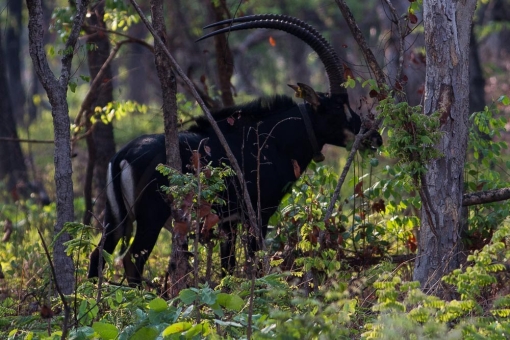
Mercury, the dominant bull, has become remarkably similar to his father Duarte, both in body shape and horn curvature, and also displaying a confident gentle nature; O macho dominante Mercúrio, tornou-se notavelmente parecido com o seu pai Duarte
Interestingly, and since he got in, Ivan has showed little interest in exploring the sanctuary or, apparently, interacting with the herds. Rather, he seems obsessed in trying to get out again, tirelessly patrolling the fence and hoping to return to his former comfort zone. Mad Ivan, was born to be wild, born to be free. Only in the last couple weeks of May, Ivan made some limited exploring inside the sanctuary, but not much. At an estimated age of 14, Ivan is, whether he accepts it or not, a very old bull. He must definitely be declining on his physical prowess, and not forgetting that he had to recover from near-death snare-inflicted wounds in the recent past, so I find it hard to believe that he can remain a threat to the younger boys for much longer… and on the other hand would be nice, or at least entertaining, to have some of his twisted genes passed on to the future generations!
See this website’s home page for two videos taken by the drones in the Luando Reserve. Trap cameras in Park Cangandala capture intriguing images also as per slideshow below:
A very significant event unfolded in December, when our leading giant sable shepherd from Luando, the remarkable Manuel Sacaia, received the prestigious Tusk Trust Ranger Award. The award ceremony took place at the Victoria and Albert Museum in London, and Manuel received the award from the hands of Sir David Attenborough and Prince William, not bad! Manuel Sacaia is most deserving of this recognition, and you can find additional details on the ceremony, and about the person (including a short film) on the following links:
http://tuskawards.com
http://www.telegraph.co.uk/travel/safaris-and-wildlife/tusk-conservation-awards-2016-winners
https://www.youtube.com/watch?v=Anx1qjdethILinks for the report photos and a couple compressed drone film sequences: https://goo.gl/photos/qNoviUh3ce7SrHEz9
_______________________________________________________________-
-
-
-
- Third Semester 2016 Report
-
-
-
Dear friends,
This quarterly newsletter actually reports to July and August, as September will be transferred to the last quarter. Between July and August we carried out an ambitious aerial census and capture operation in Luando and Cangandala, and this alone more than justified this report. This operation had been planned for several months and was only possible with specific international funding received from Fondatión Segré and ExxonMobil Foundation, adding to the local funds of which the two main contributors are currently Sonangol and Angola LNG. Instrumental for the success of this operation, and similarly to the exercises we carried out in 2009, 2011 and 2013, was the reliable support received from the Angolan Army. Particularly FAN (Angolan Air Force) who supplied the Jet A1 fuel drums, and the army in Malanje who provided additional crucial logistics. This activity was integrated into the Action Plan for the Giant Sable Conservation, developed in collaboration between the Kissama Foundation and the Ministry of Environment.

The Angolan military, here represented by General Sousa participated and provided critical support; As FAA representadas pelo Gen. Sousa participaram e deram importante contributo
As usual Dr Peter Morkel was the vet chosen, and of course we (including the sable!) couldn’t have been in better hands. As Barney O’Hara retired and sold his chopper, we arranged for an alternative in Namibia, where we hired another Hughes 500 piloted by the experienced and skilful Frans Henning. The team was set. Technicians from the Ministry of Environment, and local administrators also participated actively throughout the whole operation. Ruth and David Schaad kindly helped us while camping in Luando, and my son Afonso also joined and much enjoyed the ride. The objective for the 2016 capture operation would be, over the course of three weeks, to make an updated sable population census in Luando Reserve and place up to 16 GPS collars and 5 VHF collars on giant sable, both in Cangandala and Luando. A complementing objective was to survey as many as possible of previously identified (from satellite imagery) sable hotspots in Luando, including water holes, critical anharas, while assessing and acting against poaching whenever justified.

Pilot Frans Henning and chopper parked in the woods; O piloto Frans Henning e o helicóptero estacionado na mata
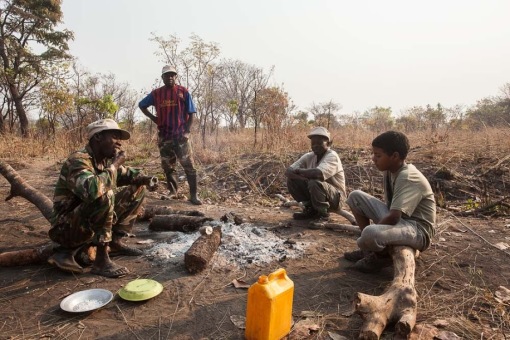
The shepherds Bernardo, Gabriel and Manuel Sacaia, and Afonso at the camp site; Os pastores Bernardo, Gabriel e Manuel Sacaia, e Afonso no acampamento
The environmental conditions this year weren’t easy for the purpose of this operation, particularly in Cangandala, as the abundant rains in the previous season delayed the burnings throughout 2016 and the tree, bush and grass cover was much more luxuriant than in previous years.
In Cangandala National Park there was no need for censing the sable population as it is being regularly well monitored on the ground. Also the poaching situation isn’t brilliant in Cangandala but at least it is fairly under control, besides the fact that with a couple exceptions all giant sables are contained inside the fenced sanctuary. Therefore the flights in Cangandala were done mainly with the purpose of capturing at least a couple young males and put them VHF collars. The flying conditions in Cangandala proved quite challenging because of thick canopy cover, but eventually we were able to locate the bachelor herd composed of four young males. After some effort and some risky chases we managed to immobilize two of them, Apollo (younger sibling of Mercury and the third sable born in the sanctuary, back in 2011), and a younger 3-year old male now called Xyami. Both were released with VHF collars as planned.
Additional patrol flights were carried out outside the sanctuary and, against all expectations, this time we stumbled with Ivan the Terrible! What a nice surprise this was. We hadn’t been able to see him since released in the sanctuary back in 2011, and all we know of his behaviour has derived from his more or less regular appearances in the trap camera record. But this time the ghost couldn’t hide and we reacted promptly – he was captured and then released with a GPS collar! He seems to have fully recovered from the poaching incident at the end of 2013 that almost cost him his life. His injury seems to have healed and although he is limping, at least regained most of his former muscular built. We had discussed previously what to do with Ivan in case we ever found him, and all agreed that it would be too risky to release him inside the sanctuary… he has proven to be a loose cannon and at least he now seems settled and content outside so better let him be, and from now on we can track him remotely – and this might be an interesting task!
Another surprise in Cangandala was coming across a young male forest buffalo which was well seen and photographed. However, a later inspection of the photographs revealed a shocking fact: the poor buffalo had a steel wire snare around his neck! Apart from the obvious poaching proof and the animal suffering, this event brought in two novel elements: it was the first time that we recorded steel fencing wire as material for snare traps (mostly used are steel cables from motor bikes), and the first time we faced neck snares instead of foot snares. Of course there is a good reason for this, as the interrupted and temporarily abandoned fencing work around the park boundary, using steel wire instead of bonnox-type mesh, provided an unlimited supply of this type of wire for snare traps; and the neck snares might simply be an adaptation to the new materials available and presence of buffalos. Sure enough in subsequent days the ranges raided those signalled poaching areas and recovered dozens of snares built with the steel wire stolen from the border fence.
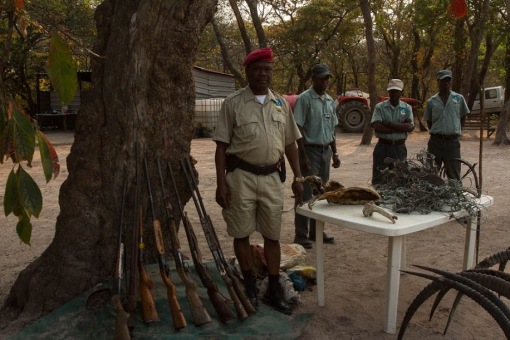
Muloge with rangers presenting traps and guns apprehended from poachers; Muloge e fiscais apresentando armas e armadilhas apreendidas aos caçadores
In Luando the operation was a huge success. Before the exercise we knew of three confirmed herds in the reserve to which we could add two more that remained in doubt (both hadn’t been located in five years and one of them was also presumed to be very small anyway). During this operation we were able to locate the three better known herds and also the two “missing” groups, totalling now five confirmed herds. Not only this but, much to our surprise, the latter group that we thought was very small, actually proved to be the largest giant sable herd! It turns out this group had been much underestimated in 2009 and 2011 and we should have invested more energy tracking them in recent years. It comprised, at the time of our capture in early August, 31 animals but the local number may even increase in forthcoming weeks, until all cows calve and re-join the herd. The other herds totalled 26, 21, 19 and 18 sables (when counting I always include calves present but exclude territorial bulls). On the other hand, the existence of a sixth herd is now ever more unlikely, as many hours were spent surveying adjacent areas of suitable habitat without results.
Interestingly, when analysing the group structure all herds included between 8 and 10 breeding females and 4 to 6 calves (almost half of the cows were still pregnant), but what seems determinant to explain the difference among herds is the number of yearlings and immatures (2-year olds). The largest herd had many and the two smaller herds had few yearlings and immatures. These results very much consistent with our earlier findings that the young animals are the most vulnerable to snare-type poaching and this is reflected in the age structure of different groups according to the poaching pressure they suffer. Young animals are confiding, adventurous and physically not particularly strong so they make ideal victims. The smaller herds are recruiting less than two animals a year into the adult age class and this is unsustainable as the herd becomes progressively older and reducing in numbers. Not surprisingly around the area of these two herds is where we recorded most cases related to snare poaching recently and during the operation.
In each of the five herds we collared two cows, at least one with GPS collar. In total we collared eight females with GPS and two with VHF collars. Nine bulls were darted and seven were also collared with GPS devices. Among these bulls a few were outstanding, including Lucas, carrying over 59 inch horns, and but not least Ngola, with horns no longer than 56 inches, but arguably the most powerfully built, strongest and well proportionated bull we ever handled. Ngola appeared to be stronger than Ivan, a true masterpiece of nature, the ultimate sculptural icon and a worthy representative of this superior antelope! And Ngola was found escorting the largest herd.

The bull Ngola might well be the most powerful we ever handled; Ngola pode bem ser o macho mais poderoso que alguma vez manipulámos
During this operation a lot less poaching signs were recorded as compared to 2009, 2011 and 2013. This may indeed reflect a reduction in poaching incidence, but may also result from a delayed dry season in 2016, and the fact that the local poachers seem to have learned that the presence of helicopter means trouble and immediately react by removing temporarily their snares and hiding the camps. True enough we only found active snares in the first few days of flying and subsequently we only came across half-hiding materials and camps left abandoned in a rush. Unfortunately the effects of poaching to the giant sables are still too evident, and not only reflected in demographics and herd age structure.

One active collar led us to the skeleton of a large bull; Uma coleira activa levou-nos ao esqueleto dum grande macho
One of the first animals darted in Luando this year was poor Dr Morkel had to improvise on Nadia, the young female (born in 2011) that we had tried to dart on foot in October 2015 when, based on the GPS data, we suspected she was injured and must had fallen in a snare trap. Unfortunately this suspicion was now vividly confirmed: she was limping and in poor condition, and carried a nasty wound in her right front foot.gical intervention to be able to remove a steel cable snare that was constraining blood flow in her foot and threatening gangrene and amputation. She must have gone through unspeakable suffering over the last few months. At least we may have at least mitigated her suffering and giving her now a reasonable chance for recovery. Miraculously she was lactating, meaning that she had had a calf recently. This could only be possible because she must have been impregnated just a few days before falling into the trap. It is doubtful if the calf will make it giving Nadia’s poor condition, but at least she has maintained her normal breeding cycle even during her worst year.
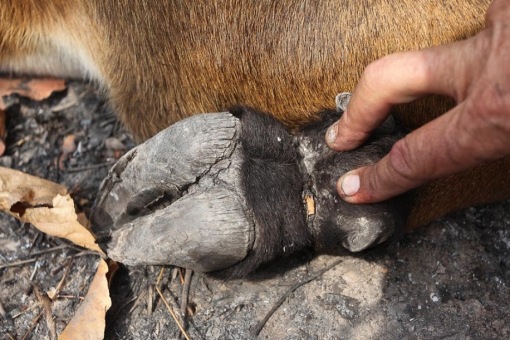
As suspected since last year, Nadia had fallen in a snare trap! Como suspeitávamos desde o ano passado, a Nadia caiu numa armadilha de laço!
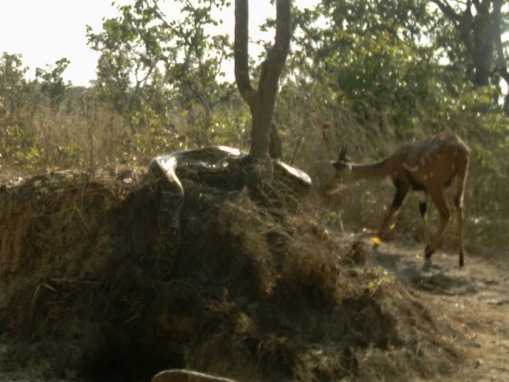
A python digesting a large prey in the presence of a bushbuck!!! Uma jibóia digerindo uma grande presa na presença dum golungo!!!
_______________________________________________________________
-
-
-
-
-
-
- Second Trimester 2016 Report
- Second Trimester 2016 Report
-
-
-
-
-
Dear friends,
The second quarter always marks the transition from the end of the rainy season into the dry season. It is never a period that I look forward to, usually with too much water in April and too much grass in May and only improving a bit well into June. This is however the time when sable calves, with calving peak typically reached in May. Therefore it is hardly surprising that it tends to be very difficult to approach and observe the animals in these months. To make things worse, the abnormally generous rainy season of 2015/2016 in Cangandala and Luando, made conditions even harder with very wet conditions in May and an ocean of tall unhospitable grass right to the end of June.
And if this wasn’t enough the old radio-tracking VHF antenna fell apart and it became pointless to try monitoring the sable on the ground.
Instead we focused on various other activities, supporting management components in Cangandala such as repairing the water hole system and start building a new fenced sanctuary, which will be destined in the future to contain bulls for tourism visits.
The animals were simply monitored indirectly in Cangandala via the trap camera records as usual. Ivan the Terrible was recorded again, marking the territory outside the sanctuary, and at one stage the rangers on patrol reported to have seen Ivan once accompanied by a sole female… he doesn’t seem to enjoy too much the company of females, as he has ignored plenty of opportunities to lead herds, and until now had never been seen near a cow… but we can only assume that being a loner doesn’t make him less of a bull and hopefully the now lonely female will bear his seed!
Inside the sanctuary the most striking records reflect a steep increase in the number of young males. Apollo, just a few months younger than Mercury is back and might soon be a real challenger for the dominant bull role.
A bachelor herd was also recorded with three 2-year old young males (young males between 2 and 3 years old tend to abandon the comfort of their herds and wonder off forming bachelor herds of males before establishing territories later in life and then challenging mature bulls),
and plenty of male yearling and male calves. Mercury’s succession is guaranteed, but we can also expect that the rise in testosterone inside the sanctuary will result in more conflicts, fence challenging and possibly some injuries and deaths of inexperienced bulls. The plan eventually is to remove some of these males to the new sanctuary, as soon as it is finished.
In Luando Reserve a few things have shown progress, but there are a lot of worrying signs suggesting increase in poaching, and we lack updated hard data on the condition and status of different herds. One positive development was the support received in previous months by Angolan military, which has very much boosted the confidence on the shepherds and allow them to make more patrols and to penetrate deeper into less covered areas.
There were a couple of incidents reported of encounters with poachers, and on one of them there were several shots fired, and it ended with a shotgun and an Ak-47 apprehended. On a sad note, some shepherds reported encountering an injured female with a severe leg wound, possibly amputated. They could not see ear tags so it is possible that she was an unmarked female and another recent victim of a snare or foot trap. The shepherds also claimed that the poor female was accompanied by a small calf which would be consistent with a very recent incident.
The next quarter will be crucial as we are preparing for another capture operation, designed to put collars in animals in Cangandala and Luando, but also to make an updated aerial census of herds in Luando Reserve and, with assistance from military, to support anti-poaching activities also in Luando.
Best wishes,
Pedro
Photos can be seen in the following link:
https://picasaweb.google.com/113384424565470443034/6309025463335166961?authuser=0&authkey=Gv1sRgCPDKnZeXw7jz-gE&feat=directlink
_______________________________________________________________-
-
-
-
-
-
-
- First Trimester 2016 Report
VERSÃO PORTUGUES (Download)
- First Trimester 2016 Report
-
-
-
-
-
-
Dear friends,
The 2015 El Niño was being responsible for an extreme drought condition across southern Africa, particularly in Mozambique and South Africa, but in many parts of Angola if anything it’s been the opposite. At least in Cangandala this rainy season has been quite generous, causing over flooding of rivers and constraining so much our movements that in the first trimester we could only access the park between late January and early February, following a short break in the rains.
The rare break allowed us to carry out several activities in the park, reaching for example all the trap cameras. However, and quite exceptionally, this time we couldn’t even approach the giant sable inside the sanctuary, much less see them or photograph them. With few roads at our disposal, we’re often forced to track the animals driving cross country, but this just looked like a terrible idea with waterlogged soils and under threatening skies, and eventually we dropped those efforts.
And tracking the animals on foot wouldn’t make much sense either, they would feel chased and not much to gain from it… Instead I spent extra time looking for birds, reptiles, amphibians and insects, while enjoying some photography.
Without being able to track and monitor the animals on the ground, we had to settle with inferring the dynamics from the trap camera record, keeping me busy for quite a while. As usual we obtained plenty of photos, and even after filtering the data to exclude blanks, we got around 30,000! These included the usual species, such as giant sable, roan, hybrids, bushbuck, duiker and warthogs.
More calves, plenty of healthy females and Mercury dominating the pure herds. All good here!
On the other hand there was a big surprise waiting for us on photos taken outside the sanctuary, which was the resurfacing of Ivan the Terrible. Yes, the crowd’s favourite is alive and back!He had last been recorded in November 2014, and considering the long absence and the high level of poaching in his territory, we speculated that he had probably been killed. He used to visit the salt licks somewhat irregularly but at least every few weeks. The only exception was between June and December 2013 when he went missing while fighting for his life after being caught in a snare trap. Throughout 2014 we were able to observe monthly his steady recovery, as he was slowly regaining some of his former physical strength, before disappearing again. He surely wouldn’t survive another poaching incident… Well, Ivan is now back with us! In the last three months of record he was photographed on five independent occasions. The reasons for his latest long absence are simply unknown, but he seems to be in good physical shape. Maybe it was just his crazy nature that led him to go wondering for so many months, may have decided to take a sabbatical year… Anyway it was a positive development, and we’re looking forward for his future adventures.
We now have ambitious plans for the remaining of 2016, but these will only be disclosed in subsequent reports.
Best wishes,
Pedro
Photos can be seen in the following link:
https://picasaweb.google.com/113384424565470443034/6276490376281083201?authuser=0&authkey=Gv1sRgCOnk8r6Z-4nOrQE&feat=directlink
___________________________________________________-
-
-
-
-
-
-
- Fourth Trimester 2015 Report
- Fourth Trimester 2015 Report
-
-
-
-
-
-
Dear friends,
The last quarter of 2015 was the wettest I have witnessed in the giant sable areas. The rains had started early and to be accurate the first storms were felt still during September, but they steadily increased in intensity throughout the following months and by December the rivers had overflowed in Cangandala, making it almost impossible to drive around. No doubt that this climatic extreme is associated to the El Niño phenomenon, but it is the first time we see such an obvious link in our regions. If this continues we may well be restrained from entering the areas for most of the rest of the rainy season in 2016. This weather might result in more vegetation growth, less or delayed fires in the dry season, more water availability and for longer, but may also yield a raise in insects, ticks and other disease vectors. Probably the net balance in 2016 will be positive for the sable, but only time will tell.

A duiker arriving at the salt lick under a storm.
In Cangandala October started with alarming news: there had been a poaching incident with shooting involved, which resulted in one of the rangers being wounded. One of our best rangers, Domingos “Pau Queimado”, who had been a sable shepherd since day 1 and one of my most trusted men, was shot and penetrated by an AK-47 bullet that entered his left upper leg near his groin and left through his buttock. During a night patrol a team of three rangers was lured into an ambush by two poachers who had left a flashlight turned on and tied to a tree next to a camp fire while waiting behind bushes. When the rangers approached they opened fire without warning and Domingos was immediately hit. A short battle followed but the damage was done and the poachers eventually escaped while our man had to be rescued. Miraculously the bullet didn’t rip through any bone, organs or blood vessels, and after surgery in Malanje and a few days in Hospital, by the end of October Domingos was recovering reasonably well at home when we visited him. This is another sad reminder that even in Cangandala poaching still remains a very real threat, and unfortunately we could not yet capture the culprits. In fact, we very much suspect that they might be the same individuals responsible for trap camera destruction and placing of snares around the sanctuary. They seem to be getting more confident and bold, but it is the general feeling among the rangers that sooner or later they’ll be caught and they will have a score to settle!
Other than this tragic event, things seem to be going well in the sanctuary where at least the sable are breeding well and look healthy.
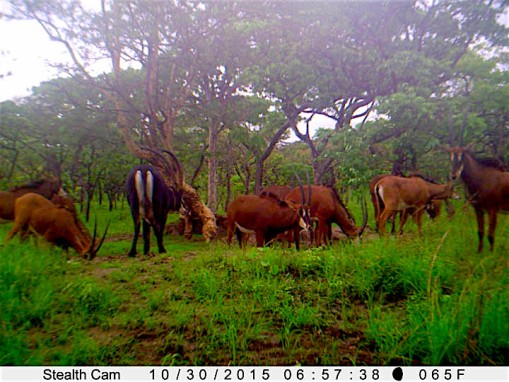
Mercury and his herd. Lots of calves and young in the herd.

Sable females.
The harsh ground conditions and the lush vegetation didn’t allow us frequent and prolonged monitoring of the herds, and particularly because as a result of the constant rains, huge numbers of tsetse flies were hammering the animals, leaving them restless and difficult to keep up with. Nevertheless it was interesting to note, and also confirm with the trap camera record, that several calves had been born relatively late in the season and even that some cows were still pregnant in December.
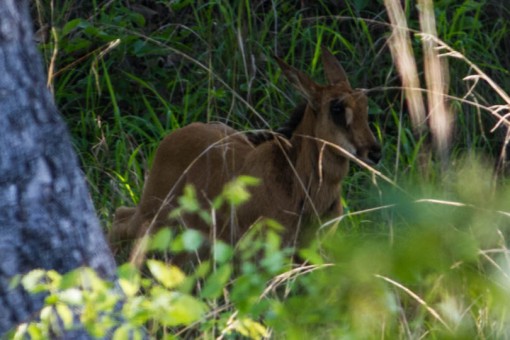
A very young calf born off season.

A very old sable cow and her latest calf!
This is a bit unusual as giant sable tend to display a well synchronized breeding with calving peak in June, but I suspect it might be related to accelerated breeding under optimal conditions. Mercury is still very much in charge in the sanctuary,
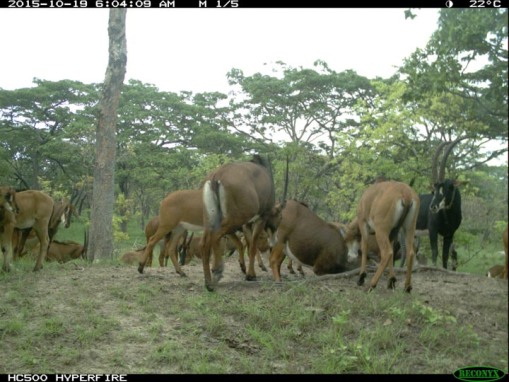
Mercury keeping an eye on his herd.
and once again the trap camera did not record our dear and crazy “Ivan the Terrible”. His last appearance was in November 2014, and considering that one year has passed without sightings, I think it is fair to presume that he is probably dead – well, at least he is literally out of the picture! True, he has surprised us in the past, but I’m not keeping much hope for him at the moment…
Overall in Cangandala and because of the weather and ground conditions, there were not many opportunities for mammal observations, which were compensated by an abundance of insects, birds and of course frogs!
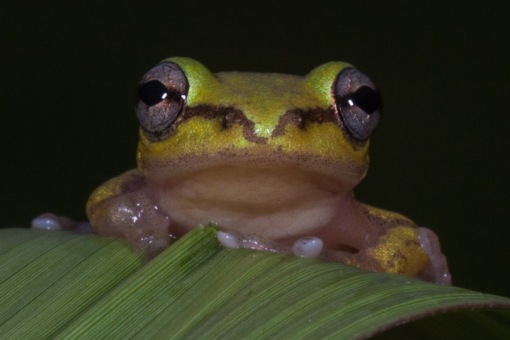
Reed frogs exploded with the first rains.
We did try to revisit our friend the hippo in October before the rivers had overflowed, but we weren’t lucky. The hippo “guardians” at the village tried their best, and it was quite amusing to watch a local kid who climbed a large tree near the lake and started yelling “hipopótamo… hipopótamo!!!” while promising us he would come in response to the calling. Eventually he didn’t show and we offered the village chief the two cabbages I had bought to feed the hippo.
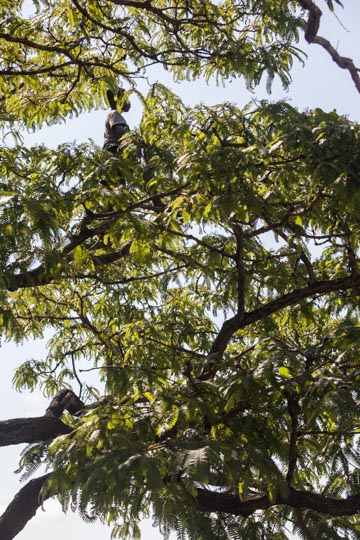
The kid calling from treetop for the hippo.
In Luando there was lots of action in this quarter, not necessarily for the best reasons. 2015 was confirmed as a tough year in terms of poaching in the reserve when it ended yet with another crisis. It all started in the second half of September when one of the few animals still carrying an active GPS collar, a young female named Nadia, suddenly showed a sharp change in behaviour becoming suspiciously lethargic, even if not totally still. But from moving a daily average of 4-5kms sustained over two years, it suddenly dropped the daily log to a few hundred meters or less. This unusual pattern continued for several weeks as we entered October and we soon concluded that she must have got injured. Moreover, and tracing back her movements it was found that her behaviour had changed precisely when she crossed the drainage line where a foot trap had been recovered earlier in the dry season by the shepherds. Therefore we were probably dealing with another mutilated giant sable, tragically a very young female who had been collared in 2013 when two years old, and who should now be attending her second calf. It is another animal lost for breeding, so for the population it is as good as dead. Driving our Land Cruiser into that remote area in mid-October would no longer be possible, so we devised an emergency plan to try to reach the female with aerial means.
As always, the National Air Force (FAN) has been reliable and enthusiastic in providing support, and this time was no exception.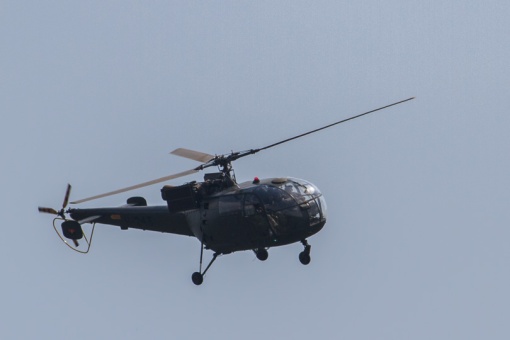
The military Allouette chopper arriving in Luando.
A military Alloutte chopper was deployed to Luando and our small team that included an experienced vet, military and ministry officials, were dropped deep in the bush close to the spot where Nadia had last transmitted. Following the VHF beacon we were able to find and track and get very close to the injured female, but she sensed us and kept moving away, always maintaining a couple hundred meters distance through the very thick vegetation. We could not get as much as a visual and after a few hours we had to abort the mission for operational reasons. The disturbance forced the female to move a couple kilometres that day, but in subsequent days she became very limited in movements once again, and after a couple weeks the signal abruptly ended, likely as the batteries went dead. We believe this female is gravely injured and another victim of increasing poaching in Luando… the second in collared animals alone in 2015!
Making the most of the presence of the military chopper we also tried to locate two known herds in Luando, even if the conditions weren’t ideal this time of the year. The best we could, was locating a small subgroup, composed of one bull and four females, yet three of the five animals were previously marked.

Gabriel and his four cows in Luando.

The old dominant bull, Gabriel
The male was Gabriel, a bull handled in 2009 and estimated to be now 13 years old; and two old cows Andreia and Laura had been marked in 2013 and estimated to be currently 16 and 15 years old respectively. The two remaining cows were “new” (not previously handled) animals, one being a very old female (likely 12+) and the other a relatively young cow (possibly 6-7 years old). We found just one subgroup, and the composition wasn’t brilliant… three out of five were known animals, and four out of five are extremely old animals! On top of it the bull didn’t seem healthy and there were no calves in sight. It may not mean much, but these observations left me a sour taste.
Ending on a positive note, the military decided to step up their support to the shepherds in Luando reserve, making a few ground joint anti-poaching operations with ministry rangers, and subsequently deploying a few weapons to the shepherds who from now on will be better equipped to tackle the poachers.
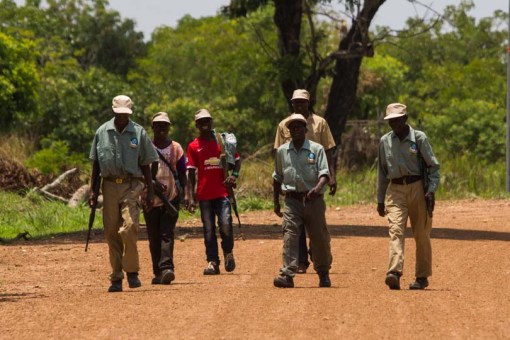
The Luando shepherds feeling upbeat with new weaponry.
Best wishes,
Pedro
Photos can be seen in the following link:
https://picasaweb.google.com/113384424565470443034/PalancaReport4TRIM2015?authuser=0&authkey=Gv1sRgCLmNiM6aiJrUmAE&feat=directlink__________________________________________
-
-
-
-
-
-
-
- Third Trimester 2015 Report
- Third Trimester 2015 Report
-
-
-
-
-
-
Dear friends,
Dry season. Notwithstanding the first hesitant showers that followed a couple thunderstorms at the end of September, most of the trimester went through the peak of a well-marked dry season.
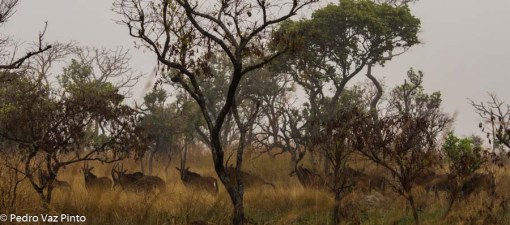
The group heading for cover at sunrise; O grupo encaminhando-se para um abrigo ao nascer do sol.
Still, and as usual, this period is arguably the most heterogeneous and rewarding to do our field trips in the region: in July the grass is long dead and finishing being burnt, visibility is maximum and we can then reach the most remote corners; in August the sables tend to be tamer than in the rest of the year, proudly presently their calves as they come out in the open to graze the fresh grass; by end of August and early September the Brachystegia and geophyte regeneration paint the miombo landscapes with vibrant and unexpected colours; and throughout September the first showers bring back the earthly odours and myriads of flowers cover the anharas.

The stunning colors of regenerating geophytes; As espantosas cores da regeneração das geófitas.
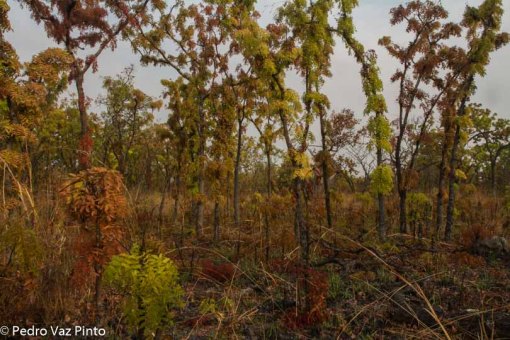
Tree regeneration; Regeneração arbórea.
In Cangandala things are going fairly well with breeding in cruising speed.
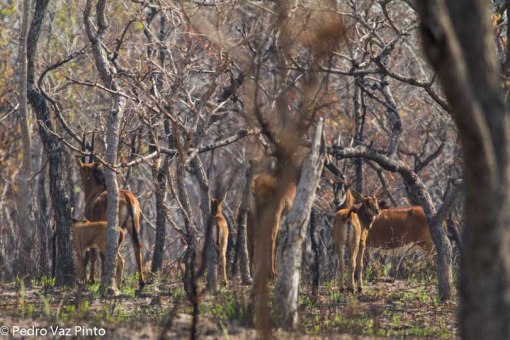
Three newborns! Três recém-nascidos!
The calving season has ended, but quite honestly it is very much difficult to determine the number of new calves. Sables are grouped in at least three different herds, often splitting temporarily in different subgroups. In addition the females marked with ear tags or collars also constitute a minority these days and only one keep an active tracking collar, and as result we can hardly locate the different herds or attribute calves to respective mothers.
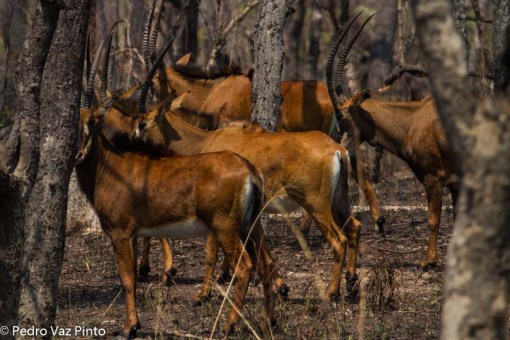
These females are the future of the species in Cangandala; Estas fêmeas são o futuro da espécie na Cangandala.
But this is a good sign of course. Even though the two oldest breeding cows (well over 14 years old) have apparently ceased breeding (still around but accompanied only by her two 2013 male calves), all the young females look very fecund.
Mercury keeps embodying the spirit of a true master bull, imposing yet totally tolerant to our presence.
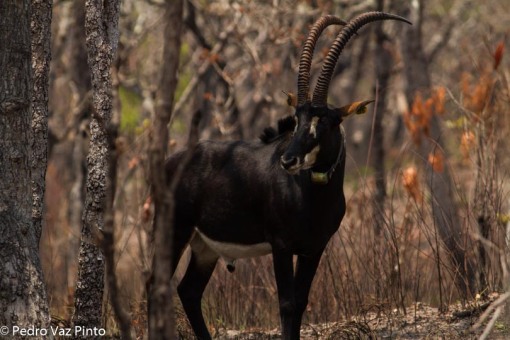
Mercury the Boss; Mercúrio o Boss.
In late September, as we entered the oestrus season, we were able to watch him being quite assertive towards the females, chasing them around insistently in short sprints and holding his head menacingly down, likely as part of the pre-mating loving ritual… although it depends on one’s perspective, no doubt many will call this aggressive sexual harassment. He would go after them one by one for a while, and whenever he embarked on this behaviour the rest of the females in the herd would stay close, yet restless and nervous. After a while he would calm down and everyone relaxed.
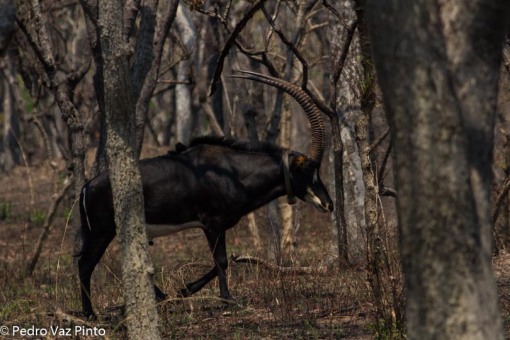
Mercury calmly patrolling his territory; Maercúrio calmamente patrulhando o seu território.
In late September, as we entered the oestrus season, we were able to watch him being quite assertive towards the females, chasing them around insistently in short sprints and holding his head menacingly down, likely as part of the pre-mating loving ritual… although it depends on one’s perspective, no doubt many will call this aggressive sexual harassment. He would go after them one by one for a while, and whenever he embarked on this behaviour the rest of the females in the herd would stay close, yet restless and nervous. After a while he would calm down and everyone relaxed.
Another interesting behaviour was witnessing how loose the herd-bonds seem to be this time of the year. Throughout the day and in consecutive days, we could watch as the main herd would split in different subgroups without any seeming logic – calves would sometimes stick together and without respective mothers, or some would go with other animals and some would stay, etc.
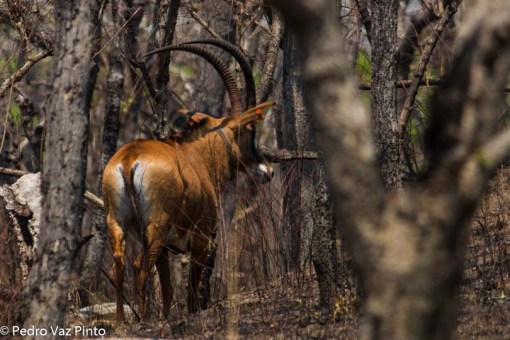
Hybrid Sherikan; Híbrido Sherikan.

Sherikan babysitting a young calf; Sherikan fazendo de babá com uma jovem cria.
On a different herd, young Eolo at age 3 is developing fast and almost totally black by now, soon he may be challenging Mercury’s position. Also in the sanctuary the hybrid group has been photographed often by the trap cameras. Surprisingly a very young calf was recorded once accompanying hybrids, but the presence of a young pure sable female not far away suggests she may be the mother… or so we hope. Outside the sanctuary once again we got no news from ol’ Ivan the Terrible… let’s hope the poachers haven’t finish him off! On the other hand we found a young female, 2-years old, alone on the wrong side of the fence and trying to get back into the sanctuary. We made a plan to bring her in, but unfortunately in the following day she wasn’t to be found again.
Park management in general has improved in Cangandala over the latest months, and the rangers seem now more motivated.
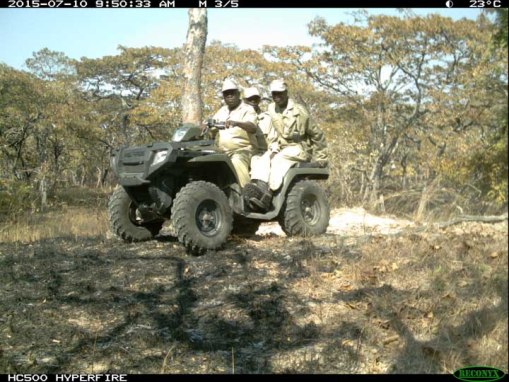
Rangers on patrol; Os fiscais em patrulha.
Some repairs have been conducted on the Sanctuary’s fence, and finally the water hole has been fully functional and is being widely used by the animals.

Herd advancing into the water hole in Cangandala; Manada avançando para o bebedouro na Cangandala.
In the Cuque river, where it crosses the southern areas of Cangandala park, we were offered the most unexpected spectacle: a tame hippo that has made his home in Cuque river near a local village and somehow manages to live in peaceful harmony with its human neighbours.
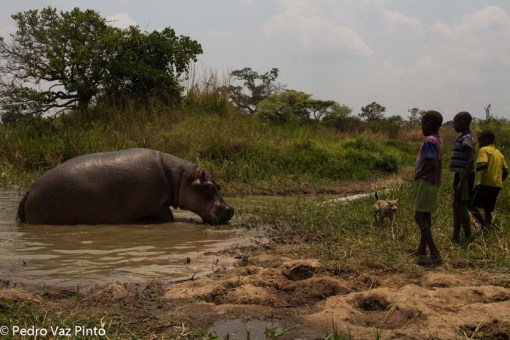
Approaching the kids without fear; Aproximando-se dos miúdos sem medo.
Apparently it all started a few years ago (2010?), when allegedly a hippo calf, possibly coming from the Kwanza river a few dozen kilometres to the south, found its way to the current location in the Cuque within 500mts from the village. No one seems to know how and why this has happened, but one can speculate that the mother may have been poached and the calf wandered far on its own and finally settled down when found water. Actually I had passed through the village a few times before but was unaware of the hippo presence, and as far as I could tell the rangers also didn’t know about it until very recently. What is really remarkable is that, not only the hippo wasn’t chased away or quickly converted into bush meat, but instead was allowed to stay around and with time has grown a sort of bond with the locals. The river is only about 20mts across in its widest part. Women fetch water and wash clothes next to the hippo; the kids call the hippo screaming and engage in all sorts of games around it; while the occasional drunk may also joins the party performing eloquent speeches directed at the hippo.
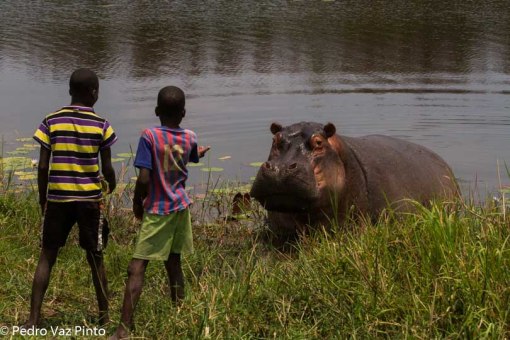
Incredibly he comes to within a couple meters from the kids! Incrivelmente vem até um par de metros dos miúdos!
A bit of all this I was able to witness, and I couldn’t believe how close the hippo got to people. It does come across like a very dangerous exercise, although I must say that at all times while I was there the hippo seemed more curious and friendly than menacing… but of course if one day he decides to charge, at two meters distance no one stands a chance of escape! To add an even more surreal touch, on the day we visited the kids brought with them a small dog to use as decoy – instructing the dog to bark from the margin, the hippo quickly responded and came out of the water to approach the dog as if they were good old friends… he so got to within one meter of the dog, who was understandably nervous and eventually run away. The kids have concluded that dogs must be his favourite food (?!) which is of course nonsense. The hippo just appears to be a friendly lonely fellow desperately looking for company, and in the absence of other members of his species, then humans, dogs and goats will have to do! Let’s just hope that he keeps his good humour unchallenged… Well, in any case it allowed for some really remarkable and unexpected photographic sequences… the beast and the hippo whisperers of Cangandala!

Seems to have developed some weird bond with the village dog; Parece ter desenvolvido uma estranha ligação com o cão da aldeia.
In Luando a lot of things happened, and unfortunately we have to report an escalating of poaching, and this time with a lot of vivid and shocking evidence to support. Firstly there were reports on the use of a new trapping technique in the reserve: foot traps!
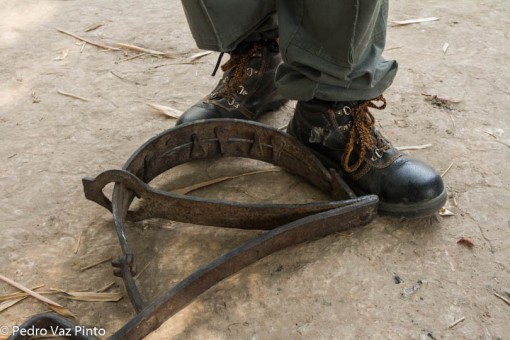
A nasty foot-trap that injured Sacaia; Uma terrível armadilha que feriu o Sacaia.
These are iron made with indented lateral faces and operated by powerful spring coils. They are designed to break the leg of a large antelope such as sable or roan, and were not previously known to be used in Luando reserve. And the first time that Sacaia (our best man) and two other shepherds came across one of these traps, was in dramatic fashion and could have had much worse consequences. While on a routine patrol along the drainage line mostly used by our most important herd in Luando, Sacaia and his mates noticed suspicious tracks around the water hole, indicating that a sable cow had been caught in a trap and had been fighting there for her life a few days earlier. While they were analysing the spoor and looking for snares, Sacaia inadvertently stepped on a foot trap. In a split second when he felt the trap he tried to remove the foot but it was caught squarely half-way through his brand new boot! If it had hit him in the ankle it would have broken his leg, but luckily this way the boot was able to sustain much of the damage. With the quick support from his colleagues, they were able to disarm the trap, and in spite of the pain and injuries he was able to walk back home. If he had been alone he probably wouldn’t have made it. But at least another sable female on the main herd, wasn’t as lucky… A few weeks later, and near a different village, another group of shepherds also recovered a foot trap, so this may be a trend and a worrying sign.
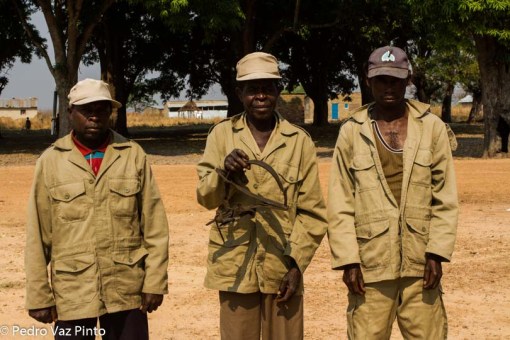
Shepherds recovered another foot trap; Os pastores recuperaram outra armadilha de ferro
And yet, we were in for more sorrow. From the animals collared in Luando in 2013, only two bulls still had active signals and were being regularly tracked, big boys Francisco and Elvis. The former a very old bull (around 14 years old) that limped from a deformed hind leg caused by a snare; but the latter was a magnificent bull at the prime of his age (around 9-10 years old). It happens that for several months now, we strongly suspected that they had died, but it hadn’t been possible to reach the sites where they would be located. This was only feasible in the dry season. This time we did reach those sites, confirmed the deaths and found the skeletons of both bulls. Francisco was very old, probably in poor physical condition and indeed his teeth were much worn-down. It wasn’t possible to find any clues to shed light on what caused Francisco’s death. It may have been promoted by a poaching incident, but it may also as well have been from natural causes… it was an old warrior anyway, and probably non breeding for a while and irrelevant for the population. A totally different story has to be said about our Elvis the King. Not only was he a dominant healthy individual that one wouldn’t expect to die “naturally”, but on site we found enough evidence to point to poaching as the cause.
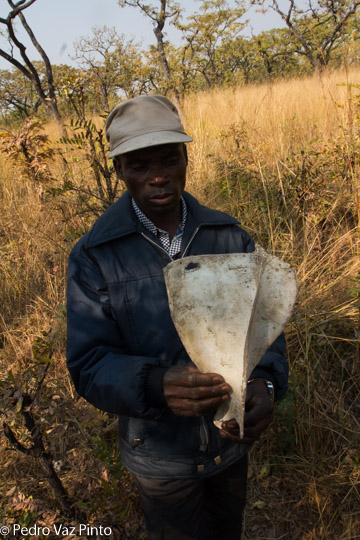
Bullet hole… Elvis was shot in the shoulder blade! Buraco de bala… o Elvis foi atingido na omoplata!
The most relevant was recovering his right scapula (shoulder bone) with a round hole almost surely caused by a bullet; and moreover poacher signs were abundant in the area. The loss of Elvis is a huge setback as he was the dominant bull that attended both our second and third herds in Luando. Symbolically, both Francisco and Elvis were magnificent and imposing animals, carrying perfectly looped horns that measured 58 and 59 inches respectively. Two decent representatives for the most beautiful antelope in the world. Unfortunately it is also one of the most critically endangered mammals…
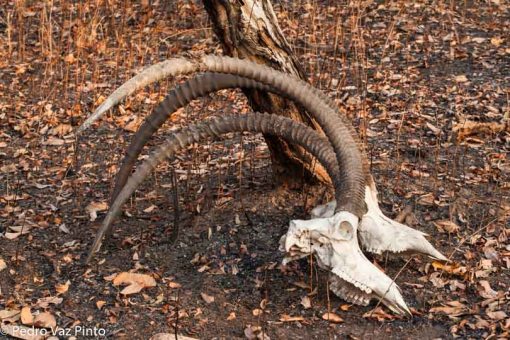
The recovered skulls from our big boys in Luando; Os crânios recuperados dos nossos grandes exemplares do Luando.
During our field trips in Luando we found plenty of steel-cable snare traps, old and active poaching camps, and killed animals – mostly duikers, either being smoked in racks at poaching camps, or simply rotting in the bush.
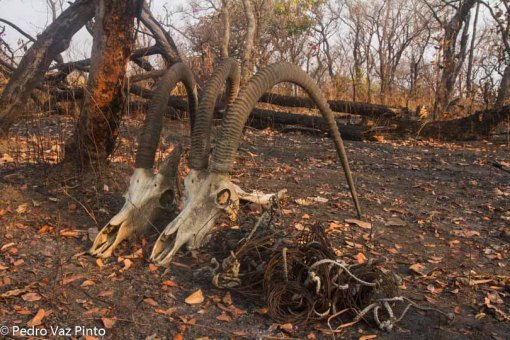
The sable skulls lying next to dozens of steel cables from snare traps; Os crânios das palancas ao lado de dezenas de cabos de aço de armadilhas.
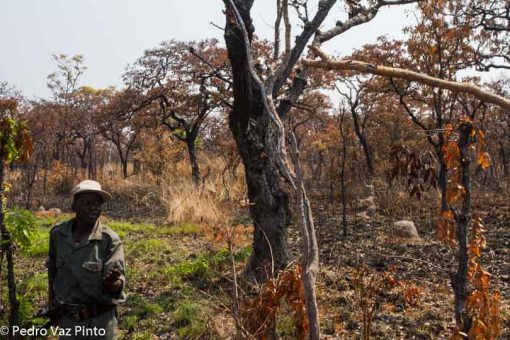
Dismantling snare traps with steel cable, in Luando; Desmantelando armadilhas de laço com cabo de aço, no Luando.
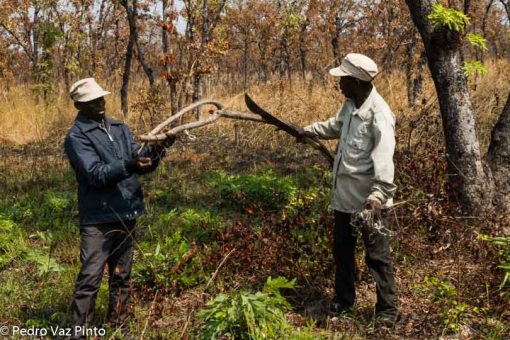
Destroying the traps; Destruindo as armadilhas
But to end the report on a less sombre note, we did receive more news from our old friend the lion, and it was colourful as always. And yes, he did it again! He was reported to have killed and eaten a second poacher! This time the story was that a pair of poachers were operating snare lines near the Kwanza, when at night one of them decided to check on his traps while his colleague stayed in the camp preparing the bush meat. Not only the first guy never returned, but throughout the night the lion was very vocal roaring from the direction the first poacher had disappeared. The following day, the second poacher made no attempt to look for his mate, crossed the Kwanza and told his tale. Well, at least the lion seems happy to prey on poachers and is already a living legend. Besides, specializing in this specific food item (poachers) I don’t think there is much risk that he will ever starve in the reserve…
Best wishes,
Pedro

Herd in a misty morning; Manada numa manhã de nevoeiro.
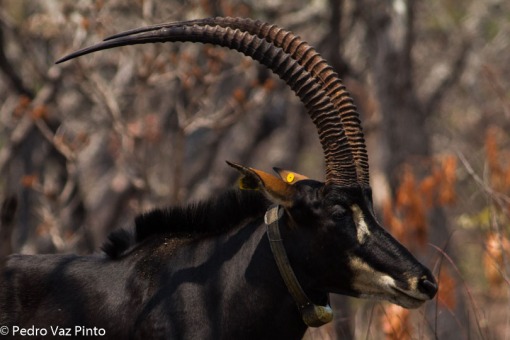
Mercury, our handsome boy; O nosso belo rapaz.

The bull! O Macho!
More great photos and images of interesting park specimens such as those pictured below, can be found at:
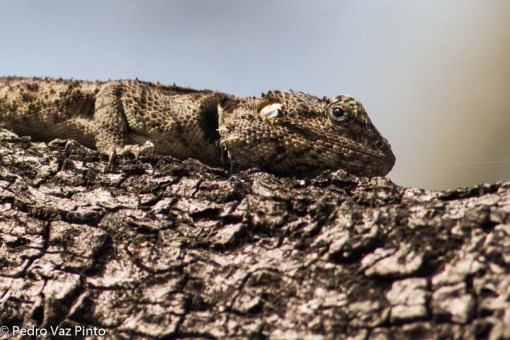
Perfect mimetism; Mimetismo perfeito.

Trying to go unnoticed… tentando passar despercebido…
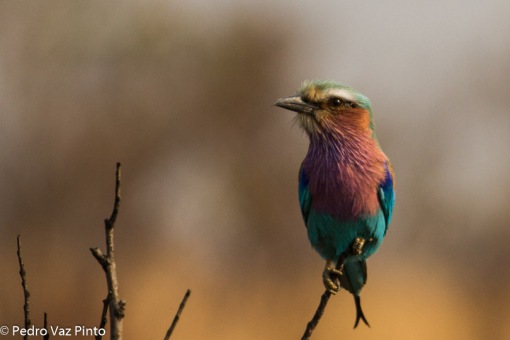
Lilac-breasted roller; Rolieiro-de-peito-lilás.
________________________________________________________
-
-
-
-
-
-
-
- Second Trimester 2015 Report
-
-
-
-
-
-
Dear friends,
The second annual trimester marks the transition between the dry and the rainy seasons. It begins moist and muddy and evolves quickly before ending dry and dusty, but if I had to choose its major defining component, it would be grass, lots and lots of grass.
 Cutting the grass at Salina 10; Cortando o capim na Salina 10.
Cutting the grass at Salina 10; Cortando o capim na Salina 10.It’s the period when grass reaches the peak in development, produce the seeds and becomes moribund. For me it has always been the least charming time to be in the giant sable reserves. The grass covers everything, even the main picadas (sand roads), making it very hard to see any wildlife; then millions of seeds clog the car radiator and enter the windows sticking to one’s clothes and irritating throat and skin, and when we go tracking on foot the dry leaves cut through our exposed skin. In compensation, this is when all roads dry up and we can fully resume our activities in both reserves.
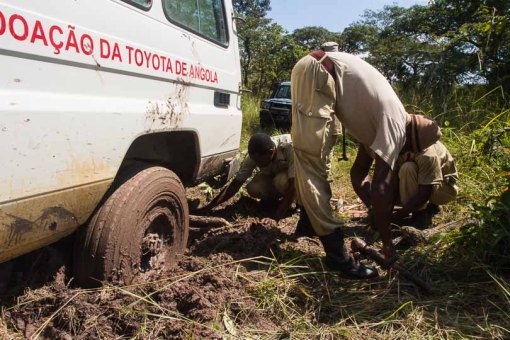
Last mud-stuck of the season; Último atascanço na lama da época.
There is not a lot to report from Cangandala in this occasion, as things have been relatively stable. We were able to track down and approach the animals a few times. Mercury has now fully matured, and his behaviour is what would be expected from a master bull, calmly arrogant and imposing; totally aware of his strength and hierarchical position as undisputed number one.
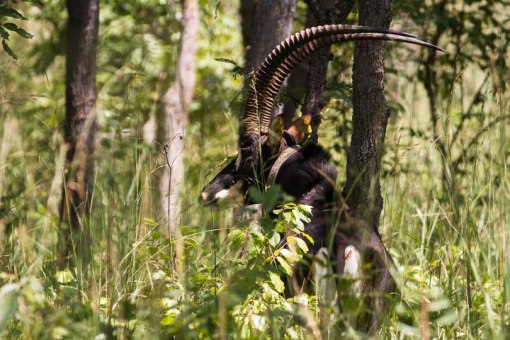 Mercury at close distance; Mercúrio a curta distância.
Mercury at close distance; Mercúrio a curta distância.Most of the occasions when we approached him, he was alone and apparently not looking for company. Only once we found him accompanying a female group, but when they showed some nervousness and left in one direction, he looked up but made no effort to follow the girls. As if saying: “Never mind, they’ll come back sooner or later…” Amazingly he even allowed us to drive the Land Cruiser closer to him than ever before, and on our last visit we shortened the distance to within 15 meters as he grazed very relaxed, and totally ignored us.
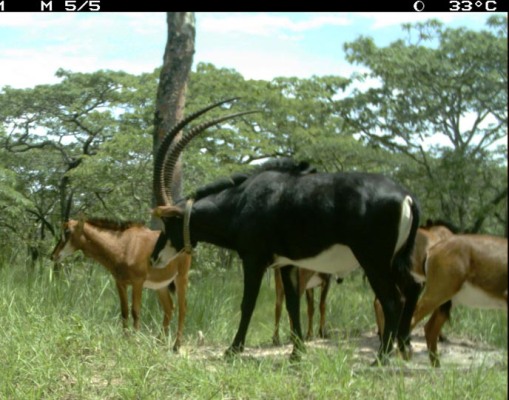 Size and color matters… the youth respectfully moves away; Tamanho e cor importam… a juventude afasta-se respeitosamente.
Size and color matters… the youth respectfully moves away; Tamanho e cor importam… a juventude afasta-se respeitosamente.What seems noteworthy is Mercury’s remarkable resemblance to his late father Duarte. Not only physical, but mostly his behaviour. His serenity, naturally imposing dominance without too much fuss or obvious signs of aggression. Everything he does, he does it slow and in style, in nonchalant manner. Like with his father we have yet to see in him show any aggression that one would theoretically expect from a master bull, like a few short sprints and pushes to herd some knotty females and maintain them nearby, or a few knocks and threats towards younger males to keep them well-behaved and fearful. Nope, not at all. Instead he just walks calmly, and everyone else seems well aware of who is the boss and stays obediently organized and respectful. Like the human father that all it needs to do is to raise an eyebrow, to keep his children quiet and well behaved around the dinner table (I wish I could do that!). I suppose Mercury is the good tyrant type… what a contrast to mad Ivan.
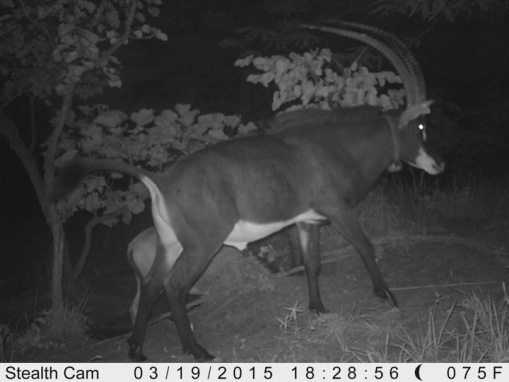 Mercury marking the territory at salina 19; Mercúrio marcando
Mercury marking the territory at salina 19; Mercúrio marcando
o território na salina 19.The trap camera record didn’t bring any surprises. The females seem healthy and most should be calving these days. The two main herds are increasing in number and most of the animals are very young.
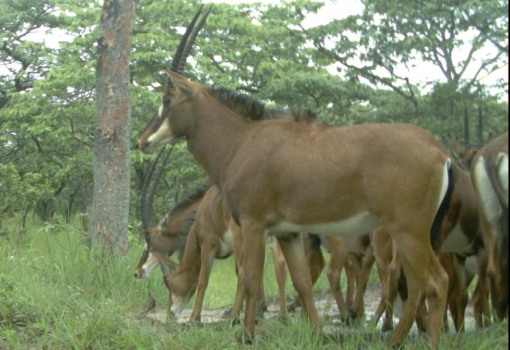 Lots of youth; Muita juventude.
Lots of youth; Muita juventude.The prospects are good for Cangandala in the short term. Consistent with our ground observations, Mercury appeared sometimes alone and other times escorting the females. His younger sibling, Eolo, has also been visiting the salt licks either alone or within the herd, but was never recorded near Mercury. Eolo is maturing fast but he still lacks physical presence and the body language reflects his sub-dominance status.
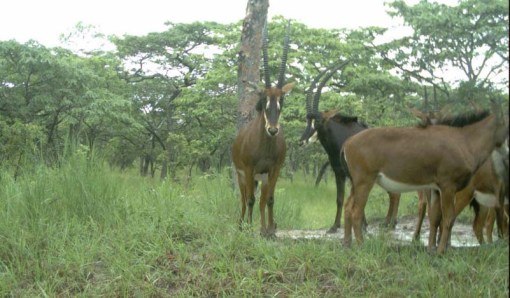 Young Eolo with young females; Jovem Eolo com jovens fêmeas.
Young Eolo with young females; Jovem Eolo com jovens fêmeas.As for ol’ Ivan the Terrible, he didn’t show up this time. However, following earlier poaching incidents that led to the destruction of cameras, we’ve been keeping only one trap camera outside the sanctuary and until security is re-established, and this fact has significantly reduced the chances for us to record Ivan.
 Sable entering salina 2; Palancas entrando na salina 2.
Sable entering salina 2; Palancas entrando na salina 2.Inside the sanctuary and additionally to sable, roans and robles (the hybrids), once again we recorded the tiny reedbuck family, composed of a young pair and their daughter…
 The female reedbuck and her daughter! A fêmea de nunce e sua cria!
The female reedbuck and her daughter! A fêmea de nunce e sua cria!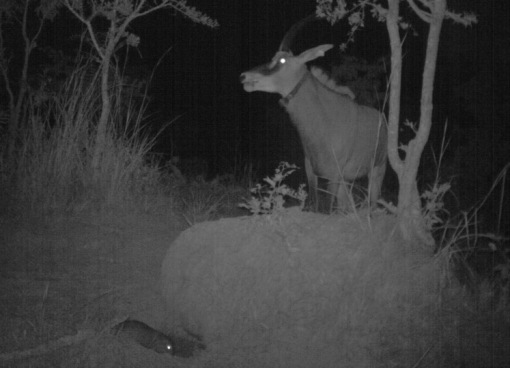 Hybrid cow smelling the presence of the cane rat; Fêma híbrida cheirando a presença da paca.
Hybrid cow smelling the presence of the cane rat; Fêma híbrida cheirando a presença da paca.
… and then plenty of the remaining usual species, namely duikers, bushbucks, warthogs, porcupine and vervet monkeys.
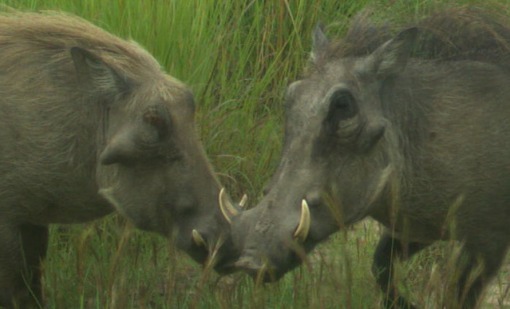 And the dark-haired is the winner! E o moreno ganhou!
And the dark-haired is the winner! E o moreno ganhou!
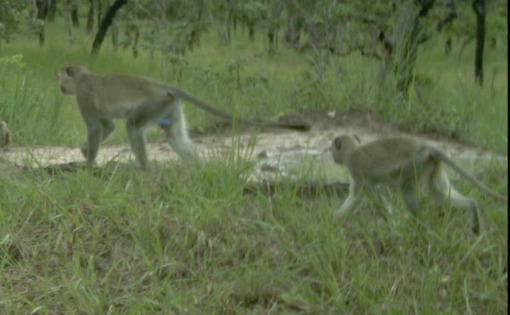 Vervet monkeys visiting Salina 10; Macacos-cinzento visitando a Salina 10.
Vervet monkeys visiting Salina 10; Macacos-cinzento visitando a Salina 10.In June we entered Luando reserve and for the first time we managed to reach Quimbango with two 4X4 vehicles. Additionally we tried to access as many water holes and critical areas as possible, and locate some of the collared animals, but our objectives were hindered by the very long grass. Driving off road was a nightmare, our progress slow and painful and resulting in a couple punctures along the way. We reached only a few water holes, where for a change the poaching signs were not evident (however at the time the snaring season was yet to begin). Contrary to our intentions we couldn’t pick up any VHF signals nor get as far as the locations where we believe two collared bulls died earlier this year… this enterprise had to be postponed to July. At least we very much enjoyed some magnificent bush-camping nights, around the campfire and under Luando’s stunning June starlight!
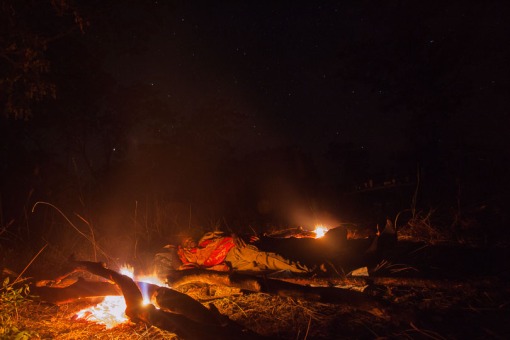 Sleeping between two campfires help resist a chilly June night; Dormindo entre duas fogueiras ajuda a resistir a uma geleda noite de Junho.
Sleeping between two campfires help resist a chilly June night; Dormindo entre duas fogueiras ajuda a resistir a uma geleda noite de Junho.Other than this we verified that the poaching pressure is not diminishing and the rangers feel helpless to counter-act increasing numbers of well-armed and organized poacher groups.
Photos can be found in the following Link:
https://picasaweb.google.com/113384424565470443034/PalancaReport2TRIM2015?authuser=0&authkey=Gv1sRgCJSRk4m5tdKnJA&feat=directlinkBest wishes,
Pedro
________________________________________________________
-
-
-
-
-
-
-
- First Trimester 2015 Report
-
-
-
-
-
-
Dear friends,
The first trimester of the year coincides with the peak of the rainy season which in addition tends to end in crescendo. This fact generally translates into overflowing rivers, muddy roads, frequent storms and lots of green everywhere, and for this reason we always keep low expectations in terms of our bush activity. This is our low season. Nevertheless some routine monitoring activities need to be carried out as usual, and it was a welcoming surprise when persistent absence of rains allowed us to drive inside the park, without getting hopelessly stuck, until the end of February.
This latest rainy season started hard and strong in September and by the end of November the park was waterlogged, but then several weeks of drought followed, and what seemed to be an epic rainy season turned into an average to modest one.
In spite of us being able to penetrate the park, the conditions were hardly optimal and we struggled to track down and approach the animals. We could only obtain was glimpses and a hand full of semi-obstructed photos of sable through the dense miombo vegetation. At least we were able to find and for a while follow Mercury, after tracking the radio signal on his VHF collar. The field observations coupled with hundreds of photographs obtained across the roughly three months since he returned to the sanctuary, revealed a very different Mercury. He is no longer the precocious yet unexperienced young bull that tried to impress and herd the youngest female group… now he has matured substantially, and truly personifies the master bull role for the whole sanctuary, which is evident in both his body language and general behavior. Instead of constantly following one female herd, he now spends most of his time alone marking and patrolling his territory, and only occasionally bursts calmly amidst a group of immediately-turned submissive females, to claim his bounty. His leadership is now naturally enforced and totally unchallenged. All young males, including the next-in-line Apollo, disappear or keep now a safe distance on his approach.
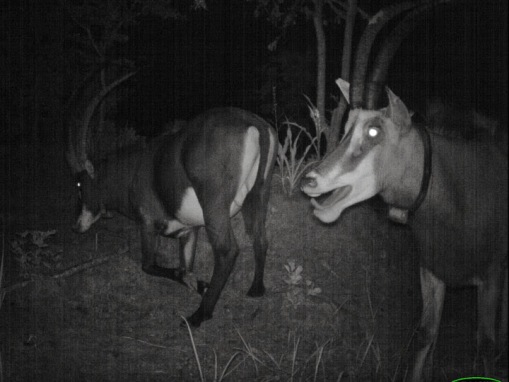
An old female screaming for Mercury’s attention; Uma velha fêmea reclamando por atenção do Mercúrio.

Mercury has long attained a jet-black color; Há muito que o Mercúrio adquiriu uma cor negra carregada.
As for the rest of the animals in Cangandala, we were able to locate pretty much everyone, including the nine hybrids and some old females that we presumed dead by old age. This includes the unexpected resurfacing of the incredible ancient cow Joana, likely turning over 18 years of age at least… I’m not aware of any sable antelope ever reaching this respectable age, and although we can’t be sure of her exact age, when was captured and handled in 2009 she was the elder of the lot and the very experienced vet Pete Morkel estimated her to be more than 12 years of age. Quite remarkable in any case that she is still alive. Also the broke-horned Paula was photographed after a long absence, and even good old Theresa was seen accompanying her 2013 offspring boy. What seems evident is both Theresa and Louise, our only two breeding cows from the original lot, have finally stop producing… for the first time since 2010 neither has bred. Pity but surely resulting from their old age, with some luck maybe Louise may still give us one or two extra calves in the future.
Basically we were able to see or record throughout this trimester almost every known sable in Cangandala, the exception being, once again, young Apollo and one of the young females brought from Luando Reserve in 2011 – Raquel. Considering the long absence from records and a few unconfirmed witness accounts of sable outside the sanctuary, we now believe that a small group may in fact have escaped, totaling a maximum of 4-5 individuals. What is important is to recognize that breeding inside the sanctuary seems to be excellent and we have now reached a point in which it is no longer possible to keep track of new births nor identify individuals in the most recent generations… it’s simply too many of them and almost impossible to distinguish different animals and relate them to respective mothers… what a nice problem! We have at least two good breeding herds, totaling about 30 animals and with a good number of young breeding females… in this regard the prospects in Cangandala are encouraging. Quite remarkable if one considers that in 2009 we were down to nine old mostly infertile cows… a spectacular comeback no doubt! Interestingly we now had at least two calves born at the peak of the rainy season, around the turn of the year. We were expecting an increased synchronized calving around May-June, so this was somewhat surprising especially because it wasn’t from first-voyage mothers… it may result from an acceleration of breeding under unusually benign conditions, although this is speculative.
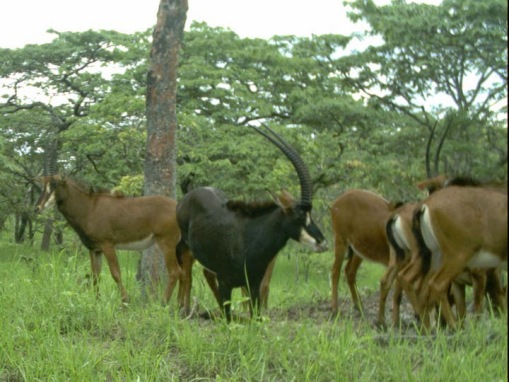
Young Eolo spends most of his time following the girls; O jovem Eolo passa a maior parte do tempo seguindo as meninas.
And now for some additional good news, the crowd’s favorite, mad-bull Ivan the Terrible made a very brief appearance in late December to be recorded on a trap camera outside the sanctuary. He seems now fully recovered and as elusive as ever. He might carry a limp and be less of an imposing figure, but in a twisted way it is reassuring to have him around! Another good surprise was a sequence of photos showing three reedbucks inside the sanctuary! Back in February 2013 we had once recorded one female with a calf, but never a male, and they were never seen again. Now finding three is a sign of breeding, which is excellent news.
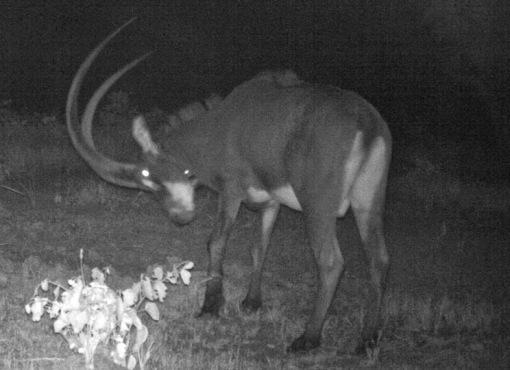
And we finish with crazy ol’ Ivan… he’s back and looks strong! E finalizamos com o velho louco Ivan… está de volta e parece com força!
On a sad note, many poaching incidents were reported, most coinciding with the Xmas and New Year season, typically a favored season for poachers, when the demand for bush meat increases significantly in urban markets. In Cangandala armed poachers were detected inside the sanctuary and shots were exchanged with the poachers, before they eventually escaped. Also yet another trap camera was stolen, highlighting the lack of security in the park. In Luando Reserve, although it wasn’t possible to access the area because of the rains, we were informed by the rangers that poaching is rampant and one of our trap cameras was destroyed by poachers. On the next trimester we will also investigate the probable death of two collared bulls in Luando.
Photos can be found in the following Link:
Best wishes,
Pedro
-
-
-
-
-
-
-
- Fourth Trimester 2014 Report
-
-
-
-
-
-
Dear friends,
As expected the last trimester coincided with the onset of the rainy season. The rains started generously and by end of October it was getting difficult for us to move in the park. These conditions also forced a stop in infrastructure development in Cangandala National Park, but at least the main bore hole was finished with good water flowing and solar pump installed. This means that throughout the next dry season there should be plenty of water available for the animals inside the sanctuary. On the other hand a permanent fence is being erected along the park boundaries, and this work has progressed very well until it was forced to a halt in November because of the rains. Nevertheless fencing should be resumed and finished in 2015.
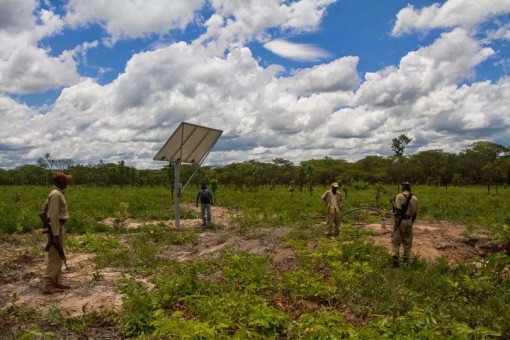
A borehole is finished and equiped with solar power; Um furo está finalizado e equipado com energia solar.
In October and November we were able to track the animals in the sanctuary several times and from close range. The main issue requiring clarification was finding out exactly how many of the females had eventually broken through the fence and escaped the sanctuary in July. Unfortunately we still couldn’t get a definitive answer as very few VHF collars remain active, although there is good reason for us to be more optimistic now. The young females especially, seem to maintain very flexible bonds, leading to the temporary formation of loose herds that often come together and split again with different composition. This means that not always we find the same females together, even if we always track the same individual with active collar. The reason for this behavior probably relies on the breeding dynamics within the group relating to calving and estrus, but there might also be a random effect when the herd grows too large and it may get easier to break when they are foraging in the rainy season. The bottom-line is that all considered in different occasions inside the sanctuary, we have observed in total over the past few months the majority of sables that should exist in Cangandala. Only two young females have not been found. It is possible that a small group did escape the sanctuary but it won’t be a large group, and it is possible that no female escaped.

One of the young breeding females brought from Luando in 2011; Uma das jovens fêmeas reprodutoras trazidas do Luando em 2011.
One interesting and clear pattern is that animals tend to group more according to their age and sex classes, than to their blood ties. It is well known that calves tend to stay most of the day in crèches, but even as they grow a young sable seems to prefer the company of same sex and age individuals than to follow his/her mother. And we found young females from the “old” herd being absorbed into the “new” herd where she could join similar age girlfriends. On the other hand the older females seem more conservative, and for quite a while they had only split in two behaviorally different groups: the non-breeding sable old cows and hybrid females, and the two very old breeding sable cows (Louise and Theresa) and their annual offspring. The old cows have never been seen close to the younger herds, but when their offspring reached a certain age they would split and join the young herds. Unfortunately it now seems that these two very old cows may have reached the end of their breeding career. Theresa has disappeared from the radar, and we fear she may have died of old age. Louise is now seen alone except for the company of the two yearling offspring that she and Theresa raised in 2013, but following four years of successfull breeding she didn’t produce a calf in 2014. Nevertheless these two Cangandala old cows have been heroes and made a fantastic contribution for the recovery program, producing a remarkable 9 calves (6 males and 3 females) between 2010 and 2013! And their offspring include the 3 young males (Mercury, Apollo and Eolo) that have been dominant the dominant bulls in the sanctuary since their father’s departure.
But there were significant developments regarding the bulls, but mostly positive ones. First the background: Over the years the dynamics surrounding the bulls have been often troublesome but always interesting to follow. With crazy Ivan the Terrible settled out of the sanctuary since 2011 and good ol’ Duarte killed by Ivan in the beginning of 2013, our first-born Mercury assumed the leadership inside the sanctuary. Mercury was a most imposing and precocious young male and had all the females at his disposal at age 3. However by the end of 2013 and much to our disappointment, Mercury decided to break through the fence alone and dispersed outside the sanctuary where there are no females and neighboring Ivan’s territory. This opened the way for Apollo, the second-born bull in Cangandala. But his reign in the sanctuary may have been even shorter, and hasn’t been seen since the beginning of 2014. He may still be escorting a couple young females, or he may have dispersed out of the fence or been killed, the fact is we have no idea what happened but he seems out of the picture. For this reason Eolo, the third in line and in spite of his tender age slightly over 2 years old, has been assuming the role of “resident” breeding bull escorting the larger breeding herd inside the sanctuary.
When we got into the park in November we received worrying news. The shepherds reported that the perimeter had been violated once again, and this time it was Ivan who broke through the fence and invaded the sanctuary. The rangers even had a visual report when during a patrol they came across the big imposing dark and proud figure of Ivan well inside the sanctuary. This wasn’t good news. If this was true and given Ivan the Terrible’s notorious and bloody curriculum, he would soon target the young bulls and Eolo in particular wouldn’t stand a chance. This was also unexpected considering that since 2011 Ivan seemed to have established a well-defined territory outside the sanctuary and never showed interest in returning. But the trap camera record told us a very different story: it wasn’t Ivan, but Mercury who returned to the sanctuary! After one year of adventurous dispersal he decided to come back home! Interestingly he did not reclaim his bounty, or at least until now he showed no interest in fighting Eolo and join the female herd as master bull. Mercury was our most impressive young male so no wonder that at the age of four, he has turned into a mighty imposing black bull with massive horns, and this explains why he was mistaken for Ivan. His behavior suggests that he is more interested in establishing a territory inside the sanctuary than escorting females on a permanent basis, leaving that task for the subdominant Eolo. If confirmed this may provide new insights into dominance and territorial behavior of sable bulls. Ivan on the other hand this time has not showed up in the trap camera record, raising some concerns about his condition… but as he has proved very resilient in the past and was recovering from the snare injuries, and therefore we expect him to resurface in future reports.
As always, the trap cameras provided tons photos and some very interesting sequences. The most unexpected by far was framing a python on the hunt ambushed at Salina 7. This was incredible, particularly because the python being cold-blooded even moving would not trigger the infrared sensor of the trap cameras. Because of this fact, the python was only recorded as “collateral” when mammals visited the Salina. It is amazing to see how the python has chosen well the ambush site stretching parallel along a piece of exposed root. It wasn’t a particularly big python, and it was probably waiting for a duiker, bushbuck calf or a cane rat. The first co-visitor we recorded was a hybrid (roble) female. I dare say that the combination of a roble with a python in a natural scenario, got to be a candidate for the most unique and bizarre combination of species ever recorded in a wild photo!!! The following day the python came back for the ambush but had changed to the other side of the root, and the new visitor was a male bushbuck. Once again it was too large of a prey for the python to attack, but amazingly the bushbuck stand less than 30cms from the python but not seeing the snake. Both in the case of the roble and the bushbuck, the antelopes seemed clearly nervous and aware that something isn’t right, looking around in inquisitive manner and lifting the front feet nervously several times before fleeing the site without even feeding. But I suspect that if they had been smaller the python would have strike and they wouldn’t escape unharmed. Needless to say that I was very much anticipating a predation sequence, with the python dominating a duiker or small bushbuck, but unfortunately didn’t happen. Pity, maybe next time!
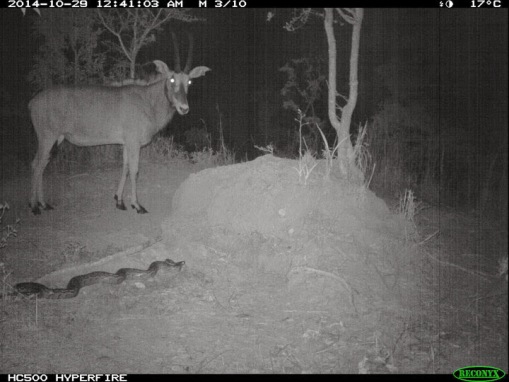
Incredible scene: a python on the ambush, and a very nervous hybrid female!!! Cena incrível: uma jibóia emboscada, e uma fêmea híbrida muito nervosa!!!
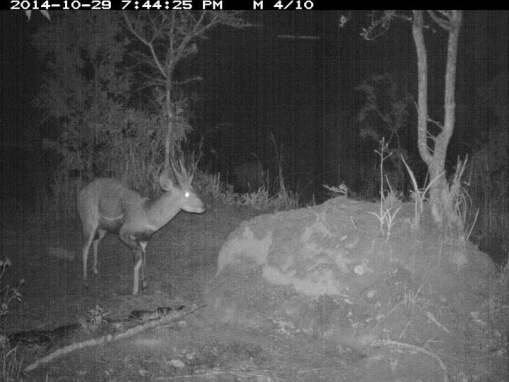
The following night the python again a bushbuck male!!! Na noite seguinte a jibóia novamente e um macho de golungo!!!
In Luando Reserve we were able to move around in the beginning of October, when we attended a few trap cameras placed in water holes. However soon after, the rains settled in, and it became unadvisable if not impossible to drive off-road. We witnessed some massive storms in the afternoons, which allowed for some interesting landscape photography opportunities but it also made it clear that we could not venture further into the bush. Therefore we invested most of our remaining time in Luando in the planning and coordination of activities with the shepherds.
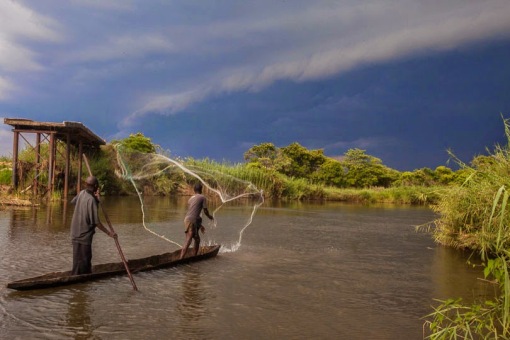
Fishing in Luando river as a big storm approaches; Pescando no rio Luando quando uma grande tempestade se aproxima.
More photos are available at the following link:
http://picasaweb.google.com/113384424565470443034/PalancaReport4TRIM2014?authuser=0&authkey=Gv1sRgCLT_v9CNwvTldg&feat=directlinkBest wishes,
Pedro_________________________________________________________________________________
-
-
-
-
-
-
-
- Third Trimester 2014 Report
-
-
-
-
-
-
Dear friends,
The trimester started off with worrying news from Cangandala. Partially in response to our constant reporting of poaching, the municipal authorities organized with the local police a series of nocturnal operations placing checkpoints at various dirt roads around the park. And on one occasion detained a poacher which was carrying in his motor bike a roan antelope! It was a yearling female and he had chopped out its head, but still it is amazing how he was driving to Malanje with such a large antelope in his bike. He was duly arrested by the authorities, and at least for a while he stuck in jail while awaiting trial prosecution. It is unclear where the roan was shot, and it may have been outside the park’s boundaries, but of course it may be this case may be the tip of the iceberg
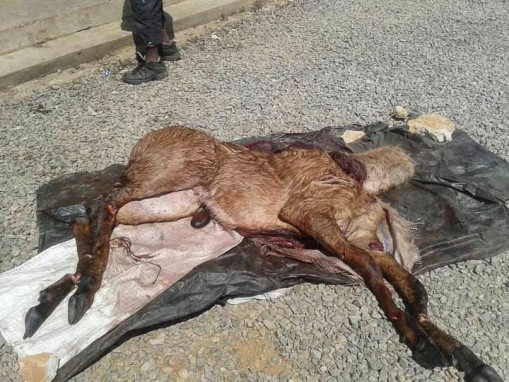
The young roan that was transported a poacher’s bike; A jovem palanca-vermelha que foi transportada na mota dum caçador.
In spite of the generous rains in previous months, the dry season this year was fairly intense in Cangandala, and against our expectations the natural water holes and drainage lines dried up quite rapidly. This caused occasional shortage of water inside the sanctuary which in turn may have contributed to raise the stress on the animals. Probably of result of this there was quite a lot of animal activity and testing along the fence, and unfortunately it was even brought down a few times as some antelopes violated the perimeter. It wasn’t clear to us which animals broke through the fence. In a couple occasions it may have involved roan, but at least once it was suspected that some sable escaped the sanctuary.
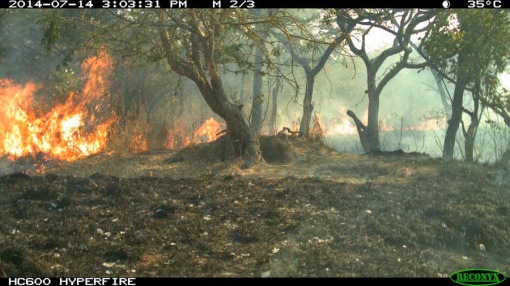
July fire caught in camera when reached a salt lick; Queimada de Julho captada por uma câmara quando atingiu uma salina.
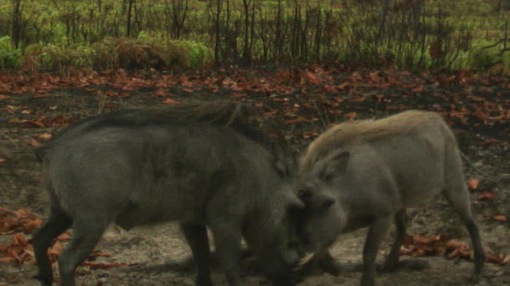
Place your bets gentlemen: The dark-haired or the blonde fighter? Façam as suas apostas senhores: No de cabelo escuro ou no lutador loiro?
Ground observations and the trap camera record proved that the old females and at least most of the hybrids are still contained in the sanctuary and therefore, our concern grew as we fear that part of the young group may have escaped. Unfortunately none of those sable visited the salt licks in recent months, further raising our suspicions. Tracking the animals on the ground allowed us to locate one young group inside the sanctuary, which included the only two functioning collars in young females. This group comprised six females (ages 2, 4 and 5), two yearlings, five calves and it was escorted by Eolo, a young 2-year old male (third in Cangandala-born lineage, after Mercury and Apollo). Eolo is a handsome young boy, yet to turn black but already with an impressive presence.
We were in fact able to approach them several times and get them habituated to our presence, allowing for plenty of nice close-range photos. The composition of this subgroup demonstrates that the initial young herd has split in two, also considering that Mercury had long broken through the fence, the other group likely will be guarded by Apollo and might include five other females and four or five yearlings, plus a few calves. During my visits I could not find the second group, and witness accounts from the rangers are inconsistent (they claim to have seen the group both outside and inside the fence, with irreconcilable numbers and dates). This is a mystery hopefully to be solved during next trimester. Of course the possibility that half of our best breeding sable might be outside the fenced camp, can have major implications on the whole program and force us to propose exceptional response measures. For the time being and until proven otherwise, we will assume the worst case scenario and plan accordingly.
Outside the sanctuary the trap cameras recorded once again our good old friend Ivan the Terrible, patrolling his territory. He has clearly put on some weight and might be recovering some of his lost pride. But hopefully not too much of it. As for Mercury we couldn’t find him, and unconfirmed witness accounts place him patrolling a new territory on the opposite side of the sanctuary, far away from Ivan. I really miss this boy, and it would be a waste if we lose him as a breeding bull. Back inside the fenced camp and after months of frustrating delay it was finally possible to make a bore hole located in a scenic landscape right at the core of the sanctuary, which we will now make sure it will be operational at the onset of the next dry season.

Ivan in better shape, and displaying his magnificent horns; Em melhor forma, e mostrando os seus magníficos cornos.
A shocking development that we need to report in Cangandala relates, once more, to poaching activities. There is little doubt that we have at least one team of two armed poachers, who have been operating the area at least for the past three years. They know the area quite well, and mostly hunt at night with a spotlight near the sanctuary, but we know at least a couple times have ventured inside. They have been photographed by a Trap Camera back in 2012, and every now and then have manipulated, destroyed by fire or even stolen cameras. And they seem to have become progressively bolder in their actions. This time they completely destroyed one camera with an axe and took the memory card. Still, one of them was photographed a couple of weeks earlier on a different camera which they are unaware of. Unfortunately we obtained dark night photos, only useful to confirm we’re dealing with the same individuals but not good enough for precise IDs. We have now laid some traps with cameras hidden high up in trees, hoping to catch them in the act next time. This and more efforts are on the way to see if we can catch these guys.

Ranger placing a trap camera high to monitor poacher trails; Fiscal colocando uma câmara alto para monitorar passagem de caçadores.
Further south, the bridge across Luando River was finalized in July, and therefore we were able to drive the first car into the reserve in 27 years! We did a couple trips in this period to the reserve and each time spent several nights camping in the deep bush. Having the vehicle with us meant quite an improvement in terms of logistics and reach. But of course the bridge is also cause for concern as it facilitates the way for poachers and stimulates the greed for local natural resources. On the first trip we learnt that our old lion friend had returned to the region and created havoc among some locals, to the point that in certain villages people were strongly encouraged not to come out after dark. Another concern for the sable, although I remember thinking that if we’re lucky this could maybe deter or demoralize some poachers… who knows maybe the lion could even catch one poacher.

Our Toyota was the first car to cross the Luando river in 27 years; O nosso Toyota foi o primeiro carro a atravessar o Luando em 27 anos.
In Luando we also tried to approach the sable herds, but even tracking the VHF signals we had limited success. The region is very extensive and remote, and these animals are quite nervous, always on alert for poachers. Therefore the best we could achieve was very brief encounters, and for obvious reasons we decided not to push them further. Most of our time was used to patrol water holes and other hotspots previously identified from satellite imagery. Unfortunately it showed us once again that poaching is rampant in the reserve. We found plenty of poaching tracks, active and inactive traps, recently used cartridges, animal carcasses in traps, poacher’s camps, and even once we came across an armed poacher who got away before we could detain him. As this wasn’t enough the trap camera record were equally enlightening, as apart from roan and smaller antelope pictures, we obtained many photos of poachers, in five independent occasions! This fact was quite alarming.
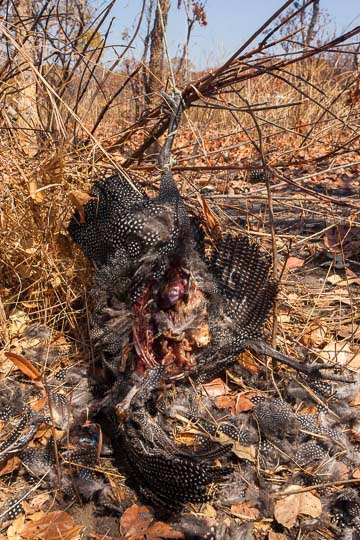
Even a guineafowl can be caught in a snare trap, this one subsequently half-eaten by a bird of prey; Até uma galinha-do-mato pode cair numa armadilha, esta foi depois meia comida por uma ave de rapina.
Now I saved the best for last to end this report on less somber note (even if some might disagree): Before we left the reserve by the end of September we learnt the most amazing news. The lion did it!!! Our big boy caught, killed and had a poacher for supper. And he got away with it. According to the story as told at one local village by a very scared survivor, he and his friend were hunting at night with spotlights, and his companion was in front and carrying a shotgun, when he was ambushed by the big lion who gave him no chance to fight back. The second poacher run away as fast as he could and only stopped at the village, many kms further. He refused to go back to the meal site the following day and disappeared before long. Apparently no one could figure out where the poachers had come from, but were assumed to be diamond diggers operating along the Kwanza River. Now we hope the survivor to tell his tale, and spread it among his buddies.
I must admit that I am starting to see the lion under a different light now. A romantic person could be tempted to accept the lion as an active conservation agent fighting to hold his ground against competitors, while a cynical person could suggest that the lion is simply going for the most abundant prey: poachers! In any case, and however we choose to look at it, my respect for the Big Boy has increased exponentially!!!

The usually hard to find marbled snout-burrower; A geralmente difícil de encontrar rã-escavadora-marmoreada.
More photos are available at the following link:
https://plus.google.com/photos/113384424565470443034/albums/6068878486065664289?authkey=CM6Uiuu3sLCkgwEBest wishes,
Pedro
_________________________________________________________________________________
-
-
-
-
-
-
-
- Second Trimester 2014 Report
-
-
-
-
-
-
Dear friends,
Although this rainy season wasn’t particularly wet, still the rains lasted for longer than the usual, with a lot of rain throughout April and well into May. This fact had several consequences, mostly positive for the animals but not necessarily facilitating our field work. During April and May, many drainage lines became waterlogged, so driving with the 4X4 inside the park was painstakingly slow and muddy, and as result we could only get glimpses of the animals inside the sanctuary.
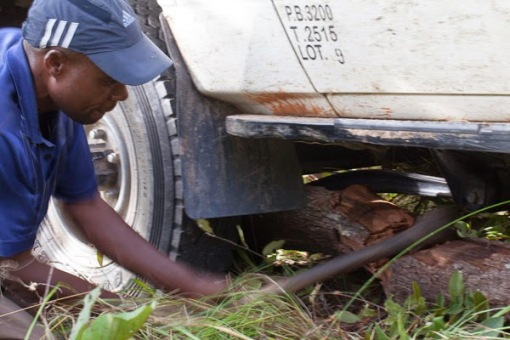
Gently removing a small piece of wood from under the front axle; Cuidadosamente removendo um pequeno pedaço de madeira debaixo do eixo dianteiro.
In contrast when we returned in June, the soils in the park had pretty much dried up completely, but now there was an excess of overgrown grass everywhere. Most of the grass was dead but there was just enough moisture to prevent the start of prophylactic burnings. It felt like 2014 was one month delayed compared to standard years. And this period corresponds to the least attractive annual conditions, in the Cangandala bush, in my opinion. Rather give me rain, mud, wind, cold, heat, bees or fire anytime! But piles of dead grass with millions of tiny seeds getting everywhere and clogging the radiator are much more annoying. And of course it is a bad time to find and watch the sable. In June, and after a few frustrated attempts I eventually gave up on tracking them further.

Predator clash part II… jumping spiders are formidable hunters; Combate de predadores parte II… aranhas saltadoras são caçadores formidáveis.
More important is to recognize that the late rains at least reversed what until then had been a very dry wet season, and this is surely good news for the animals. As we have seen in previous years, good and late rains translate into shorter and less intense dry seasons, with a delay and reduction of bush fires, and more water available in water holes for longer time. And all this also means less poaching pressure and ultimately improved breeding success. This was particularly evident in Luando for the last couple years, when high mortality and low recruitment followed the very dry rainy season of 2011/2012, while the opposite happened last year after abundant rains.
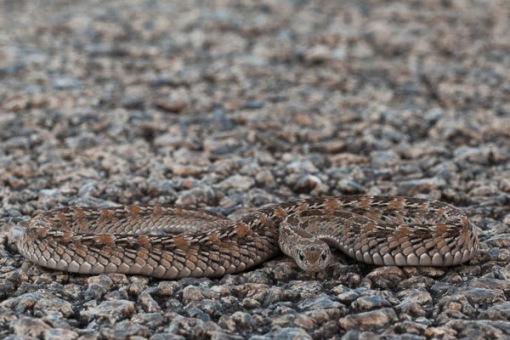
Found on the road, a night adder ready to strike; Encontrada na estrada uma víbora-nocturna preparada para atacar.
Looking at the trap camera record it was a pleasure to confirm Ivan’s physical recovery. Even if it it is doubtful that he will ever be the same powerful unstoppable bull that was flown in from Luando Reserve in 2011. Most likely he will always carry a limp but how much this handicap will affect his proud and irascible nature remains to be seen. In any case it is reassuring to see that he has put on some weight and muscle and is back patrolling his old territory, even if his mane hasn’t yet regained the former pitch black coloration.
Inside the sanctuary we failed to locate Mercury and he also didn’t surface in any salt lick. This started as being annoying, and then developed into an uncomfortable feeling, but finally we were shocked to locate his radio signal outside the sanctuary! Somehow he managed to break through and subsequently couldn’t get back inside… and he probably tried as we found him close and his tracks suggested he had been patrolling along the fence trying to return. This is a major setback of course, and made particularly worse because we were forced to cancel a pre-scheduled 2014 aerial operation for July as result of institutional misunderstandings.
So in less than one year we lost the original old bull on a fight with Ivan, then the later got caught in a snare trap and now we lost, at least temporarily, our most important young bull! And we don’t have the means to put him back in the short term. His escape also explains why in April we found the main breeding herd accompanied by the very young Apolo, barely mature and one year younger than Mercury.
At least the girls are still escorted by one bull, who should be perfectly capable of breeding. And the even younger Eolo, at age two and next in the male lineage seems also to be precocious and is became independent. Basically, even if Mercury never returns, this isn’t necessarily a crisis and it is probably a good thing to have different bulls siring calves every year, but we can surely not afford losing more bulls in the next few months. And of course, we also fear now for Mercury’s future, as security outside the sanctuary is far from optimal and he might also challenge Ivan with uncertain results.
Other than that, we had plenty of photos of the two extraordinary old breeding Cangandala cows, Luisa and Teresa. And yes, they seem to be pregnant once again, while still attending for their 2013 calves, two males that we have named Mars and Jupiter.
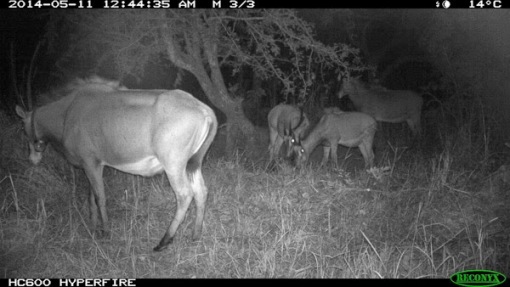
Old breeding cows Teresa and Luisa and her 2013 progeny; As velhas palancas parideiras Teresa e Luisa e sua prole de 2013.
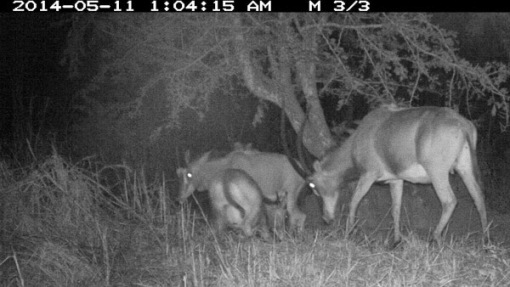
And both seem pregnant again, here Teresa pushing the boys away. E ambas as fêmeas parecem prenhes outra vez, aqui a Teresa empurrando os jovens.
In Luando the most relevant development is that the Provincial Government is building a new bridge that will allow access into the reserve with 4×4, which has not been possible for over two decades. This will be a huge contribution to our field work, but of course it is a double edged sword, as it might also facilitate poaching and other threats.
Photos can be viewed on Picasa Album through following link:
Best wishes,
Pedro Vaz Pinto
_________________________________________________________________________________
-
-
-
-
-
-
-
- First Trimester 2014 Report
-
-
-
-
-
-
Dear friends,
In the beginning of the year a short break in the rains allowed a 4X4 incursion into Cangandala NP, even though the road conditions had deteriorated substantially. It was a good opportunity to put to the test the new LandCruiser kindly donated by Toyota Angola, and sure enough there were plenty of good challenges for us to negotiate our way through the mud.
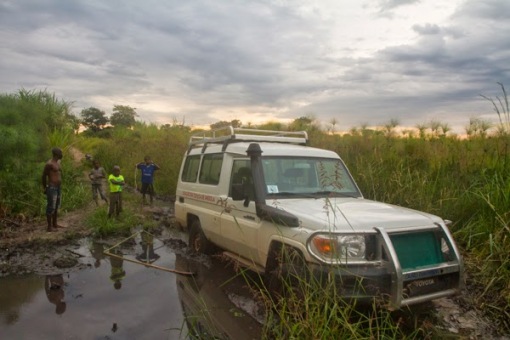
This time of the year the main access gets really bad.
Nesta altura do ano o acesso principal torna-se mesmo complicado.Things seem to be evolving naturally in the sanctuary, with the animals consistently split in two groups, one comprising the old cows and most of the hybrids, and a second herd with most of the young sables. Somewhat surprisingly this time the second group was not accompanied by the bull Mercury, but by his younger sibling Apolo, who at age two is still very inexperienced. More worrying is the fact that Mercury didn’t show up at the trap cameras, nor could we picks up his radio signal anywhere. Maybe he’s been spending some time on his own and it was by chance that he’s gone undetected, but it is a bit suspicious… With Duarte and Ivan out of the picture, and the hybrid bulls castrated, he should be enjoying a comfortable dominance without competition inside the sanctuary, and I can’t think of any reason why he would leave his girls unattended… something to be followed up in future visits.
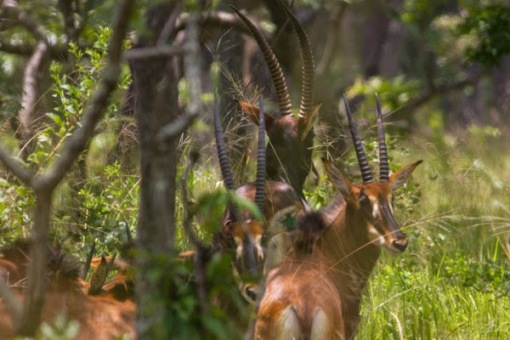
In the absence of Mercury, Apollo seems to be in charge. Na ausência do Mercúrio, o Apolo parece estar a dominar.
We were not able to confirm the number of sable calves, as the long grass, soft terrain and thick vegetation typical of the late rainy season, made it very hard to approach the herds.
The herds were generously photographed in the trap cameras, but not simultaneously and similar aged calves are hardly distinguishable individually. In any case, we believe most calves have survived, and the animals look happy and healthy. Once again we could confirm the presence of several intruder roan bulls inside the sanctuary, but no females.
On the other hand, the roan herds out of the sanctuary have been producing lots of calves, consistently recorded in the cameras. One curious event revealed by the trap cameras was seeing that one old female – Paula, broke her left horn. Females often interact aggressively as they establish their hierarchical positions within the herd, and sometimes it can result in traumatic lesions. The broken horn however hasn’t reached live tissue and should bring no consequences to Paula, apart from hindering her dominance ambitions. And on the other hand it will make her much easier to be identified from now on.
The trap cameras however also brought us a sweet-sour surprise. Remarkably, out most popular character – crazy Ivan “The Terrible” resurfaced! Following an absence that lasted for more than six months we had lost hope to locate him alive and assumed he had probably been another casualty of poachers. Well, he is alive yes, but unfortunately we weren’t that much off target in our fears. He did fell victim of a poaching incident, having been caught in one of the many infamous snare traps that are constantly being mounted in the park and neighboring areas. He has become a shadow of the Ivan we knew, and if it wasn’t for the white ear tags and VHF collar I would find it hard to accept that he is the same individual that now appeared in photos since January 3rd. Our old Ivan, strong and proud, mighty and threatening, undefeated… is gone. He is now a poor masculine figure, humble and skinny, feeble and frightened, beaten. Ivan has lost weight and has even lost his shiny black coat, having turned brown, almost female-colored. He is certainly not the same imposing bull, and on his left front leg carries a nasty ring-shaped scar, evidence of the cable snare that almost took his life. The incident must have happened many months ago and he must have gone through hell before finally attempting an hesitant return to his territorial duties. It is likely that the worst has passed and he will survive, but it is hard to predict if he will make a full recovery. This was yet another shocking proof that the poaching curse is far from resolved, even in Cangandala. It is highly frustrating that in spite of all the effort put into the project by the various stakeholders and the very significant successes obtained over the past few years, still we don’t seem to be winning the war against poaching and the recovery and survival of this magnificent and iconic species hangs by a thread.
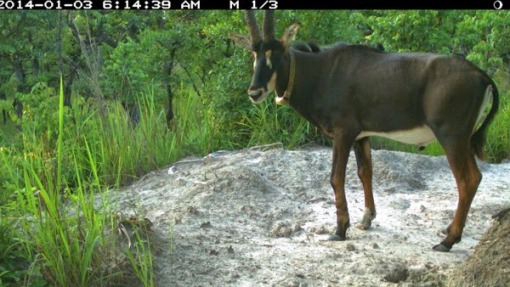
Ivan resurfaced! But he is in shocking condition and hardly recognizable…
O Ivan reapareceu! Mas está em condições deploráveis e quase irreconhecível…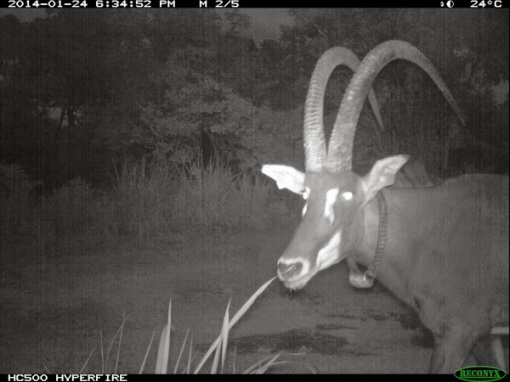
Ivan’s collar used to be tight around his neck…
A coleira do Ivan costumava ficar-lhe apertada no pescoço…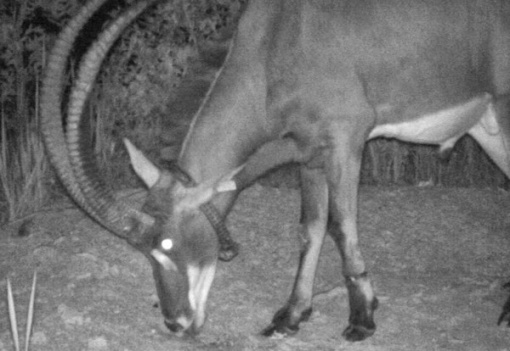
The ring-shaped snare wound is clearly seen on his front left leg.
A ferida circular da armadilha é claramente visível na sua para esquerda dianteira.More photos can be viewed on Picasa Album through the following Link: https://plus.google.com/photos/113384424565470443034/albums/5998067063642775489?authkey=CPbNurKwo66wuQE
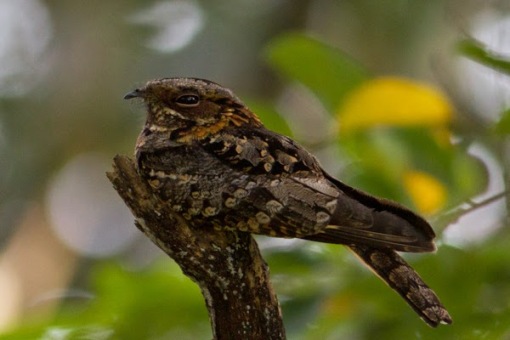
An elusive nighjar, possibly square-tailed (Caprimulgus fossii).
Um esquivo noitibó, possivelmente Caprimulgus fossiiBest wishes,
Pedro
_________________________________________________________________________________
-
-
-
-
-
-
-
- Third Trimester – Final 2013 Report: August to December
- Third Trimester – Final 2013 Report: August to December
-
-
-
-
-
-
Versão Portugêse
Dear friends,Following the July capture operation things stabilized in Cangandala NP. This year rains started early in September and as result of heavy works being done in the park by Government, to put bungalows and bringing new fencing materials, the access roads soon became so damaged, that from October onwards it became impossible to drive across the boundary into the park. For this reason we could only monitor the animals until September and after that we had to rely exclusively on the trap camera records. Inside the sanctuary and by the end of the dry season, a new well and water tank were being finalized and an elevated viewpoint was constructed over the Cazela river drainage.
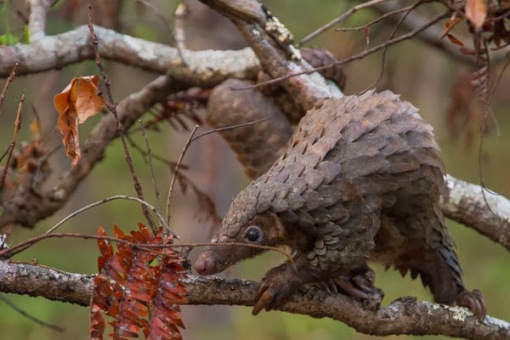
The tree pangolin is a special and rare resident.
O pangolim arborícola é um raro e especial residente.
Young Apollo, at 2.5 years of age, is now becoming impressive. O jovem Apolo, com 2,5 anos de idade, está agora a ganhar corpo.
In late September the animals seemed to be doing very well, with young Mercury proudly assuming his role as the new master bull of Cangandala. The sables are consistently split in two herds, the younger group closely watched by Mercury and the old females lumped with the hybrids and apparently without permanent presence of any bull. In the latter case it still remains unclear if one of the castrated hybrid bulls has any deterrent effect on the pure males, but apparently the much younger Apollo at age 2 is now gravitating around the old cows.
Most importantly we were able to confirm eight new calves born in 2013, the mothers being the six young females brought from Luando in 2011, and from Louise and Teresa, the two very old fertile cows that can’t stop breeding. And we still hope for a ninth calf that may have been produced by Venus, the first female born in the sanctuary back in 2010. Overall, and if we exclude the four problematic and old cows that have lost their breeding potential and never calved, then for the remaining cows the fertility is outstanding and pretty much at 100% since we started the breeding program. This is just one part of the equation as female sable are always expected to be very fertile, while it is the calf mortality during first year of age that often becomes a limiting factor for population growth.
Unfortunately we couldn’t drive into the sanctuary after September and the herds went few times to the salt licks for family photos, and so we couldn’t track properly calf development and success. By the end of the year it also seemed clear that we have permanently lost the two older bulls that had been the main protagonists in Cangandala for the past few years. Duarte was very old anyway and had done his part producing the first pure offspring produced in this park in over a decade. It seems logical that the terrible fight with Ivan back in March was his last. As for our most popular character, crazy Ivan the Terrible, unfortunately he seems to be out of the picture too. In May, Ivan was photographed, healthy and majestic, but in June he had disappeared while his collar was not emitting signal, and this was confirmed in subsequent months. There is no other large bull in the region and no serious wild predators in Cangandala, not to mention that Ivan was the strongest sable we have ever dealt with, so I’m afraid that we have to conclude that he was poached. Either shot by poachers or caught in a snare trap, and then the collar must have been intentionally destroyed.
The rainy season is when the fence is most vulnerable, because of frequent storms with trees and branches falling over. This has been cause for concern, and in addition it became apparent during the last few months that the fence has been challenged several times with animals breaking through. And of course there is no more Ivan to blame. So far it seems that no sable has escaped, but on the other hand at least two new roan bulls have invaded and established inside the sanctuary. This shouldn’t be surprising, as the roan population has apparently increased significantly in Cangandala or at least approaching the sanctuary, as proven by our remarkable trap camera record. Under such circumstances it is only normal that young roan males are naturally dispersing from their herds and finding good shelter inside the neighboring sanctuary. And our fence is clearly not a sufficient deterrent to stop a young roan bull on a mission. We confirmed in the photographs a young mature bull and also a lonely yearling, in two different salt licks. The latter is yet another animal that, miraculously given his age and smaller size, has survived a snare trap, showing an ugly scarred front leg. The unfortunate incident probably explains why he got astray at so tender age. When caught in the snare he must have suffered for a while, then panicked and got lost, before breaking into the sanctuary. Lost and lonely he was now recorded attempting to approach an old sable cow, probably a desperate attempt to find company.

The young roan male shows a clearly scarred front leg. O jovem macho de PV mostra uma pata dianteira ferida.
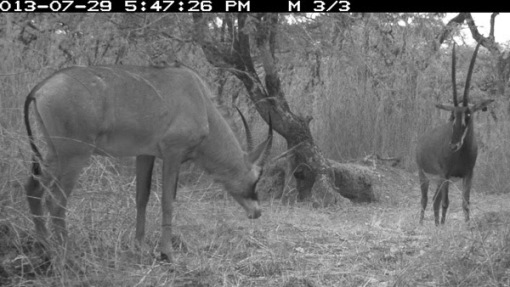
New intruder – young roan male approaching a GS female. Novo intruso – jovem macho palanca vermelha. aproximando-se duma fêmea de PNG
In 2012 and concerned with continuing hybridization risks, we castrated the young and only roan male (Freddy) inside the sanctuary as he had joined the sable cows and we suspected they were poorly attended by old Duarte.
Now the situation has changed slightly and it is not realistic to keep tackling in such radical fashion every new roan invader. Especially because they will probably keep coming and more importantly the sable herds seem now properly supervised by young sable bulls. But we’ll keep watching… On the other hand and even if Ivan’s fate remains open to debate, the injuries on the new young roan prove that poaching with snares is still a major issue even in Cangandala NP, so a lot still remains to be done.
In Luando Reserve the fifteen sable equipped with GPS collars are being tracked permanently and apparently are all safe for now. It seems clear that the most serious threat pending over the last surviving giant sable herds in Luando, are the snare traps planted around the majority of water holes, mainly concentrated between June and August, and aiming to capture by the leg any medium to large ungulate that attempts to approach the site to drink. This infamous technique, often targeting the largest antelopes (mostly sable and roan) seems to be causing huge and unsustainable annual mortality on giant sable. Particularly affected are the most vulnerable, such as breeding cows and young animals, and this is supported by our demographic data. Pregnant and recently calved cows are probably the most dependent on a constant water supply, while yearlings are trusting, adventurous and inexperienced, and many times lack the strength to escape a snare. Old bulls are more weary creatures, less dependent on water and much stronger. This may explain why the bull population in Luando seems to be in better shape than the females and respective herds, and why so many females have serious leg injuries, and also why there seems to be an abnormally low annual recruitment of young animals into adult age, and contrasting with healthy numbers of calves.
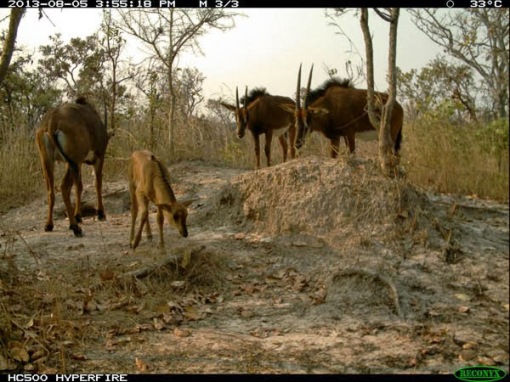
One of eight giant sable calves produced this year in Cangandala. Uma de oito crias de palanca negra gigante produzidas este ano na Cangandala.
In an effort to counteract the rampant dry season poaching we have devised and successfully tested a new strategy, and which we expect will start producing results next season. Firstly we have acquired high resolution satellite imagery, and as result we were able to pinpoint an accurate water network for the whole reserve. Secondly, all water points were provisionally classified according to their nature, size and proximity to known sable territories or home ranges. One interesting surprise was finding that the water network was a lot more prolific than expected or at least perceived from our earlier ground experience… there is a lot more water available than we suspected, and this could be picked up from satellite! Then we conducted a quad bike expedition in September for ground trothing, and fine tuning and further detailed classification of the most important water holes, especially the ones closest to our already defined hotspots.
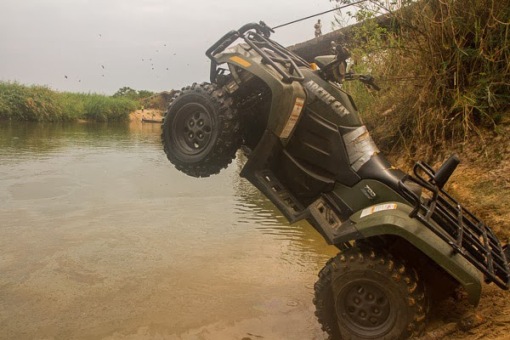
Preparing to cross the Luando River with a diesel quad. Preparando uma moto 4X4 diesel para atravessar o rio Luando.
By the time we did the expedition, most water holes had dried out, while we experienced the first showers announcing the new rainy season. For this reason herds were not visiting the sites for drinking, and snare traps had already been removed. In any case, we were still in good time to evaluate the pre-identified water holes and to determine their importance and levels of threat. Over a few days and quad-biking in cross-country we visited 9 sites (of which only one was previously known by us), less than half than what we expected but we faced some contingency problems that forced us not to continue. Still, results were very promising and above expectations, and proving that we were on the right track. Two water holes, as also suggested by the sat imagery, had limited water retaining capacity and were downscaled as unimportant. Of the remaining seven sites, six (86%) had recent to not-too-old giant sable tracks. And four of those sites (57%) had serious and clear poaching signs. In three water holes we found large poles that had been used during the last dry season, for snares targeting sable and other large antelope. In one of these sites there was a skeleton of a reedbuck that had died maybe a month ago and in the meantime had been consumed by vultures and bushpigs.
In the last site visited the shock was even bigger when we burst into the scene and surprised a poacher calmly drying up meat around the fire on a camp situated less than 200mts from the water hole. He was alone as his other two mates had gone out to poach with shotguns. There were a few freshly killed duikers from the previous day, but we were even more alarmed to find that the two absent poachers had gone in pursuit of a giant sable bull that had visited the site during the night and left unaware of the poachers’ presence. This was easily concluded by the fresh tracks and spoor on the scene. The poacher was arrested and delivered to the local authorities, and his bounty burned. Upon interrogation he confessed that he lives in a village situated more than 100kms away, and they were a team of three and came in two bikes. The plan was shooting antelopes for a few days, drying up the meat, and then take the product to Malanje and sell it in the market.
This incident and some mechanical difficulties forced us abort the mission, as it would be too risky to try to reach some of the more remote sites. But the main objective had been achieved. We now hope to establish network surveillance next dry season, cleaning up and securing all major water holes in the key areas. And this may, hopefully and for the first time in many years, help to start turning the tables in our favor in the fight against poaching. Unfortunately and much to our shock and disappointment, we learned later, that our poacher escaped detention within 24 hours of being arrested and delivered…
Another key milestone on this struggle may have been the renewed commitment from the FAA – Angolan Military Forces (army and air forces), who during October conducted a serious ground and aerial operation in Luando, aiming to serve as deterrent to poaching. For a few days they deployed teams patrolling the reserve, making local villagers aware of the importance to protect the giant sable, and sending the message that from now on, the military will be watchful to protect the national symbol. We collaborated with their initiative, and some awareness flyers and posters were produced and used to Luando. At the end of the operation no poachers had been caught but a clear statement was made.
Nevertheless, a few weeks later we received worrying reports that many armed poachers were still active in Luando, and as compelling evidence the shepherds found a freshly killed roan carcass. It was a yearling male and had been shot by poachers near the diamond areas along the Kwanza River. And yet another worrying report was learning from the shepherds that the big lion was back in business, patrolling and hunting inside giant sable sensitive areas. After the helicopter incident in July he had left the scene for a few months, but finally returned.
To finalize on a positive note, by the end of year we received wonderful news that Toyota – Angola would be donating us a brand new Land Cruiser HZJ … in good time indeed!
Photos can be seen through the following link:
https://plus.google.com/photos/113384424565470443034/albums/5967678625420685505?authkey=CJ6vpfnVq8LXdgBest wishes,
Pedro
_________________________________________________________________________________
Special Report – July 2013
Versão PortuguêsDear friends,
Although the third annual report wasn’t supposed to be released before October, I felt July deserved a special newsletter to report on the 2013 Capture Operation, and hope you’ll enjoy it. This capture operation wasn’t intended to translocate any animals, as it was agreed that the Cangandala population has finally picked up and is breeding well following a slow start. The main objectives set in Cangandala, were: first of all (and if possible…) finding crazy “Ivan the Terrible” to replace his collar and maybe cut off the tip of his horns to make him less lethal; to track down old Duarte to confirm (or not) his death; to place a few new collars on pure sable including at least on the young bull Mercury; and if possible to dart some of the old 4-5 non-breeding cows, check her condition and maybe give them an hormonal boost to see if we can induce a late estrus.For Luando, the main objectives were to place as many new tracking collars as possible; track down known herds and animals collared in previous years while trying to find new groups; and very importantly, to get fresh information on the population trends, poaching activities and other threats. For this operation we counted with the same top-team as in 2009 and 2011, which proved to be as professional and efficient as always, namely the veterinary Pete Morkel and pilot Barney O’Hara and his chopper Hughes 500. They make their amazingly difficult and specialized skills to look easy. It is a privilege to work with them, and as in previous exercises, this operation was a complete success!A lot of logistics had to be put in place weeks in advance. Fuel was deployed to Cangandala NP and to Luando by military truck and by an Air Force Allouette respectively. The collaboration with Administration of Cangandala Municipality and Provincial Government of Malanje was very relevant, and as always the support from Angolan military forces proved instrumental. In preparation, we started by tracking the animals on the ground and checking the trap camera records, but results weren’t very encouraging. We were facing very atypical veld conditions, as the unusually moist and prolonged wet season had delayed the grass decay and seasonal burnings. This was probably good for the animals, providing more cover, graze and water availability well into the dry season, but made our job at finding and observing sable much harder of course. In addition few sable used the salt licks in June, one of the few exceptions being some of the young females brought from Luando in 2011, who were photographed very heavy on their second pregnancy. Surely this to be credited to young Mercury! As for Ivan he simply did not show up on any salt lick. This wasn’t promising as we wanted to have a good feel on his whereabouts before tracking him from the air, but as long as his collars was active we would find him sooner or later…
A lot of logistics had to be put in place weeks in advance. Fuel was deployed to Cangandala National Park and to Luando by military truck and by an Air Force Allouette respectively. The collaboration with Administration of Cangandala Municipality and Provincial Government of Malanje was very relevant, and as always the support from Angolan military forces proved instrumental.
In preparation, we started by tracking the animals on the ground and checking the trap camera records, but results weren’t very encouraging. We were facing very atypical veld conditions, as the unusually moist and prolonged wet season had delayed the grass decay and seasonal burnings. This was probably good for the animals, providing more cover, graze and water availability well into the dry season, but made our job at finding and observing sable much harder of course. In addition few sable used the salt licks in June, one of the few exceptions being some of the young females brought from Luando in 2011, who were photographed very heavy on their second pregnancy. Surely this to be credited to young Mercury! As for Ivan he simply did not show up on any salt lick. This wasn’t promising as we wanted to have a good feel on his whereabouts before tracking him from the air, but as long as his collars was active we would find him sooner or later…
As you probably guessed, Ivan would prove to be as unmanageable as ever, and for the two-week period that the operation lasted he simply vanished like a ghost. His collar wasn’t active anymore (must have ceased to function shortly before the exercise…), and the several hours spent flying over his territory produced no results. Disappointing, although not completely surprising… I suppose his legend continues, but let’s hope Mercury learns to keep away from this maniac! Similarly Duarte wasn’t to be found anywhere, as his collar also wasn’t active, probably result of the serious fight with Ivan that must have taken his life as well.
Other than this, everything else was very successful in Cangandala. We managed to dart and collar young Mercury, and we could confirm “in hand” that he is truly a superb specimen at his tender age – He has just turned three, and while his horns still haven’t curved much and don’t look impressive, nevertheless they are over 40 inches long.
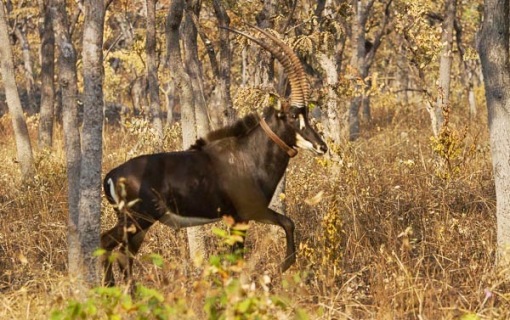
In spite of his tender age Mercury is a worthy leader ; Apesar da sua tenra idade ele é um digno líder
The three young females that had been photographed very pregnant a month earlier, now all had three beautiful young babies, and for obvious reasons we didn’t disturb them any further. On the older group we found the two old breeding cows pregnant, and we managed to dart and collar the four remaining cows (the fifth, named Katia hadn’t been seen for almost one year and must have passed away by now). The non-breeding condition of these 4 old cows was confirmed by Dr. Morkel and so he gave them a hormonal injection. It’s probably too late for them to breed, having wasted a significant part of their lives with roan and hybrids, but we have nothing to lose. Finally and on the last day of flying, we were able to dart young Venus, the second sable born in the sanctuary, in 2010. She is a beautiful girl and probably on her first pregnancy!
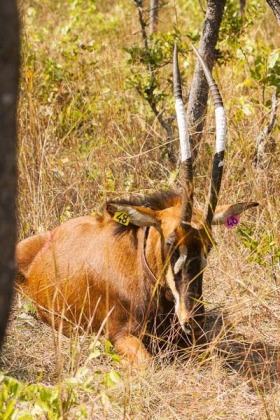
First animal darted in Luando this year was an old female; primeiro animal capturado este ano no Luando foi uma fêmea velha

Pete prepares an hormone shot for an old female; Pete prepara uma injecção hormonal para uma velha fêmea
The bulk of this operation however happened in Luando Reserve. It didn’t take us long to locate the main herd, known since 2011, as it was still on the same area and remarkably even watched closely by the same territorial bull, which had been the first sable found in Luando back in 2009 in that same spot! In subsequent days we relocated a second known herd, and eventually found a new herd, which we had long suspected. However, we couldn’t find two “old” groups, although one is suspected to have been poached out. Various females were darted and collared on each herd, and several territorial bulls were also found, darted and collared. In total, ten females and ten males were darted in Luando, from different groups and different age classes. Several sable bulls were very impressive, and, the seven adult bulls darted, measured between 52 and 58 inches.
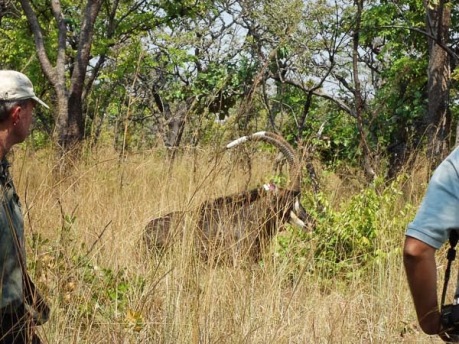
Following drug reversal the bull recovers quickly; Após ministrar o antídoto o macho recupera rapidamente

Often Barney had squeeze his chopper to land it in the woodland! Frequentemente o Barney tinha de espremer o seu helicóptero para o poder aterrar na mata
On the second day of flying in Luando, happened one of the most extraordinary scenes I will ever witness. We had found the main herd on a large “anhara”, and after a very short chase, Pete placed a dart on a young female; as she was part of a large group and they were entering the woodland, we decided to chase them from close distance – to make sure we wouldn’t lose the darted animal if the herd split under tree cover. So far so good, but then, as Barney maneuvered the chopper over the tail of the herd, and as “our” female slightly started to slow down… a huge black-mane lion came out of nowhere, jumping from under the grass to the back of the female and quickly knocked her to the ground! We could not believe our eyes! There was a lion in Luando, and it had attacked a sable right underneath the chopper!!! We were in shock and totally unprepared for that… Everyone was screaming inside the chopper; I was in overdrive taking as many photos as I could, while trying to get rid of the seat belts to find a better observation angle and shouting at the same time. Barney lowered the chopper close over the battle scene while blowing the chopper siren continuously, and eventually the lion must have decided he couldn’t challenge this giant and noisy metal yellow bird, and moved away… The whole scene didn’t take longer than a few seconds, but it was an unforgettable experience. Amidst the battle there was one specific moment we will never forget, and I only regret not having been able to photograph it although is frozen in my mind – when we got down real close on them, the lion twisted on his embrace around the sable’s neck and looked up straight into our eyes, while his dark mane was being blown backwards by the wind projected from the chopper blades. It was a grotesque, creepy and unique sighting. Crazy stuff…
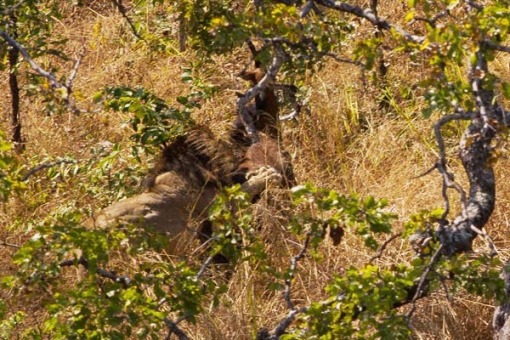
And out of nowhere… a lion strikes, attacking the young girl! E inesperadamente… um leão ataca a jovem menina!

During the short battle the lion brings down the female; Durante a curta escaramuça o leão derruba a fêmea
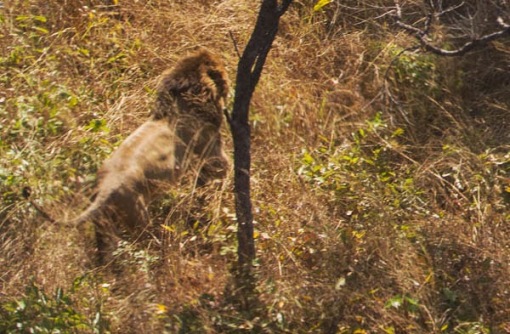
Lowering the chopper and blowing the siren we managed to chase him away! Baixando o helicóptero e tocando a sirene conseguimos afugentar o leão!
Under the effect of M99 drug and being knocked down by a monster cat, the female was prostrated and wasn’t going anywhere. As soon as the lion fled the scene we landed the chopper next to the sable cow and urged to assist her on the ground. We trusted the lion had been sufficiently disturbed and spooked, not to come back and reclaim his prey. Fortunately the big boy didn’t return! It was our chance to inspect the adventurous female, who we named Carina. She was a beautiful young girl, three years of age and well advanced on her first pregnancy! Surprisingly she had suffered only minor injuries, only scratches on the back and neck, and a superficial wound on the belly. There were no bite wounds, and the sable skin had proved to be quite resistant to the lion claws on his first wave of the assault. A few more seconds and it would have been too late for her… The belly wound was bleeding slightly but Pete was concerned that infection could spread quickly and in deadly fashion, as lion claws can be full of bacteria. The wound was abundantly cleaned with water, disinfected and treated with antibiotics. The female was then marked, collared and released.
But she was still in grave danger, as the lion could well return to track her down. To improve her survival chances, after waking up we chased her a couple kms away from the scene. Then we returned and for a while we looked for the lion but we could never find him again. Not surprising, as the long grass makes a perfect cover for a lion. That’s when we started to realize the gravity of the situation, of having an active sable predator on the loose around our most important herd! We may have played the herd into his claws that morning, but there’s little doubt that he must have been there tracking down the sable for a meal. And chances are he’s done it before and will do it again. This can be a real problem. Our numbers are so desperate, that all it takes is one lion killing one sable every few weeks, to compromise the population’s recovery. In retrospect, maybe we should have left the female anesthetized on the ground and focused instead on the lion before he got away… but during those frantic moments all we could think was rescuing the poor girl! At least in subsequent days we confirmed that Carina recovered completely, and in 48 hours had rejoined the herd.
But as dramatic as this scene was, the lion is not our biggest concern. The main predator in Luando walks on two legs, and during the operation we were confronted with new evidence on a daily basis. And as in previous years some of the poaching examples recorded are quite shocking. The fact that the previous season was very wet meant that the poachers had to delay somewhat their dry season snaring activities, as they usually place the traps around strategically burnt grass patches, and water holes. In spite of this, we found plenty of areas trapped, including one given water hole, located deep inside a herd’s territory, and with huge snare traps clearly targeting the sable.
In Cangandala, south of the sanctuary, we found a live duiker caught in a snare, which we were able to release, while in Luando we found two dead duikers that had died snared and left to the vultures. In comparison with 2011 we found less traps and poaching camps, but this may well have been because this operation was done earlier and the dry season is delayed this year. More worrying is the fact that in previous occasions we found most of the snares to be made of nylon and the minority made of cable, but this time the vast majority of 60 snares collected, were made of steel cable, therefore much more lethal.
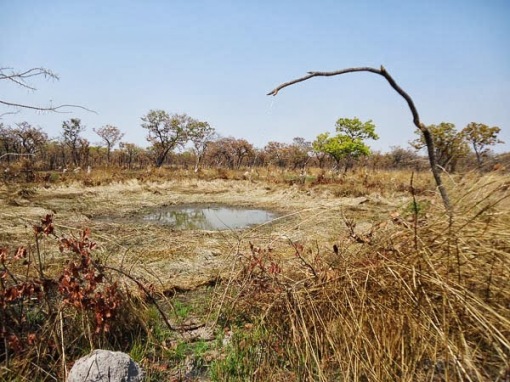
The very long and robust poles with steel cable snares were designed to catch sable; As varas muito longas e robustas com laços de aço foram preparadas para capturar palancas
Just as if finding all those snares wasn’t enough, we had to face several vivid examples of their effects on sable. Two darted females had horrible injuries in the form of amputated legs. One was a poor four year old female with the right front leg amputated below the knee. The accident had probably happened 1-2 years ago and the injury had healed remarkably, but of course she has a serious limp, and has never produced a calf. The other was an older female which had the left hind leg amputated. None of these females will ever breed, and for the sable population they have been wasted. They’re as good as dead… In addition two of the bulls found were limping, and after being darted and inspected, they revealed serious injuries on their right hind legs, also clearly caused by snare traps. Maybe because of their stronger built, or simply because they were luckier, they managed to recover without leg amputations, but they still carry nasty scars resulting in deformed and less functioning legs. It is unclear just how much they are affected but their breeding abilities might well be compromised.
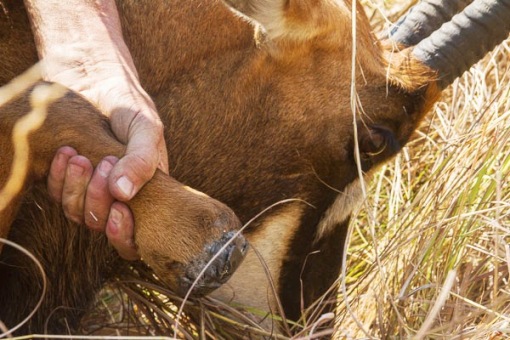
This was a shocking find, and the poor female never had a calf and is lost for breeding; Esta foi uma descoberta chocante, e a pobre fêmea nunca pariu e está perdida para a reprodução
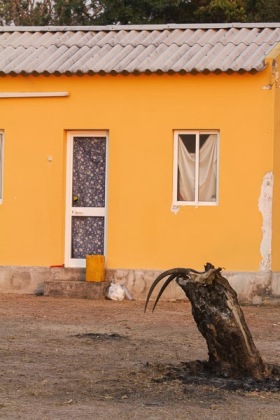
Female sable skull found in the bush drying up in Cangandala camp; Crânio de palanca fêmea encontrado no mato secando na Cangandala
In total, a staggering rate of 20% of all darted animals (males and females) had serious snare injuries. Considering that this might be the tip of the iceberg, representing just the ones that survived, we can have a good idea on the magnitude of this problem. Surely this level of poaching pressure translates into completely unsustainable harvesting. As far as we could tell, some poaching originated in the local villages. But the more organized and most worrying type of poaching, targeting the larger antelopes such as sable, seems to be fueled by a constant demand for meat to supply the diamond outfits established along the Kwanza River.
We now have a very good picture on the real situation on the ground, numbers and location of herds, and the level of threats. Compared to 2011, the sable population doesn’t seem to have decreased further, but it hasn’t increased either. Rather, it seems to have stabilized around low and dangerous figures: there aren’t more than a hundred giant sables left! Over the next few months we expect to implement a series of anti-poaching activities in collaboration with the military.
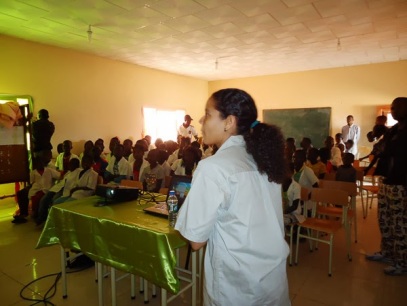
Sendi making a educational presentation for public schools in Cangandala; A Sendi fazendo uma apresentação educativa para escolas públicas da Cangandala
You’re welcomed to enjoy the photos on this link.
Best wishes,
Pedro
_________________________________________________________________________________
Second Trimester 2103 Report
Versao Portuguese
Dear Friends,The second trimester usually marks the transition from the wet to the dry season. It has hardly been a favorite of mine, as April tends to be too wet and waterlogged, while in May and June the dead grass takes over and the bush fires start, making field work uncomfortable and not very productive. It is never a good time of the year to observe the animals as our mobility is reduced and they have plenty of cover. If this wasn’t enough, the abundant rains of the ending rainy season delayed the normal sequence of events at least one month.
Even throughout June, we struggled to drive across the floodplain that defines the western boundary of Cangandala National Park.
And not surprisingly, we had very few sable observations to report. The most we could do, was approaching a few times the young herd, now proudly supervised permanently by magnificent Mercury (the first born of our “new” Cangandala). Attempts to approach the larger herd, comprising old females and hybrids, were not very successful because of the elusive nature of hybrids, dense cover and made worse by the conspicuous absence of ol’ Duarte. In spite our efforts we could not track his radio signal anywhere. Considering the fight reported on the fence in the end of March, we do fear that we may not see the old bull again… A pity, as he had made a miraculous recovery after last year’s challenge, but he was getting too old anyway.
On the other hand Ivan, as the trap cameras confirmed, looks as strong as ever and unscratched. What worries us, is that Mercury will be next in the succession line under Ivan’s radar, and sooner or later might be challenged for battle… and we cannot afford to lose young Mercury!
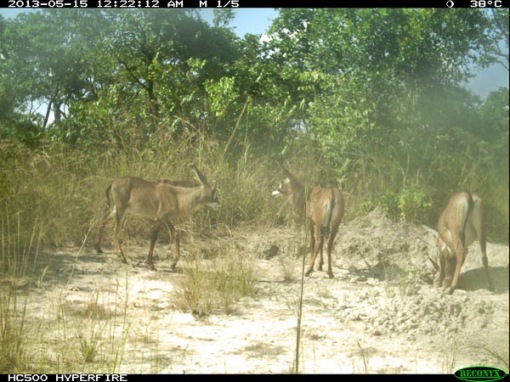
Lots of calves suggest good roan production this year; Muitas crias indiciam uma boa produtividade de palancas-vermelhas este ano.
The biggest surprise in the sanctuary was finding a pair of reedbuck. Over the past two decades reedbuck were almost wiped out in Cangandala (although in Luando they are still common today), and the last sighting had been in 2009 in a floodplain further south. We certainly didn’t expect any reedbuck to had been caught inside the fence perimeter, where the habitat is not the most attractive for this species. Reedbuck in the region generally prefers more extensive open areas associated with drainage lines. However a careful look at the photo record, gave us some hints on how they had ended up here. Being an adult female and a very young male, suggests they are mother and son. A likely scenario would be the female moving into the woodland to give birth, precisely when the fence was being expanded and as result she ended up imprisoned inside the sanctuary with her calf. Even if the habitat is not their most preferred, they will be safe inside the camp, and now bear the responsibility to repopulate the area!
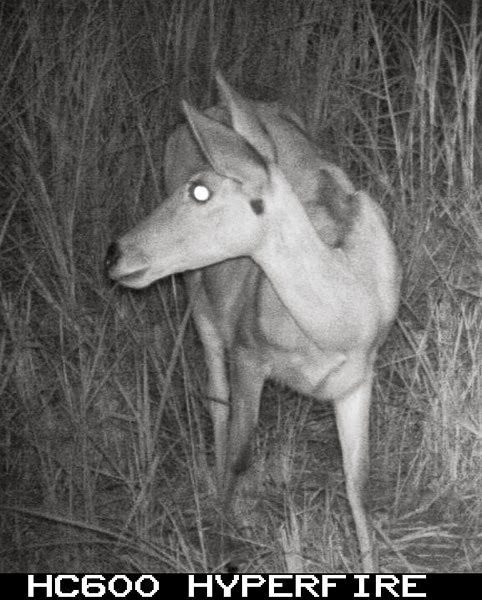
A huge surprise: a female reedbuck inside the sanctuary! Uma grande surpresa: uma fêmea de nunce dentro do santuário!

As if it wasn’t enough, she was in the company of a young male, probably her son; Como se não bastasse, estava acompanhada de um jovem macho, provavelmente o seu filho.
In Luando reserve, rains had also been generous, but the most worrying factor were insisting reports of poaching, brought to us by the shepherds. Poaching does seem to be closely linked with several diamond operations established along the Kwanza river, as they create an increasing demand for bushmeat, and this remains unchallenged. And of course, well armed poachers, not only are a permanent threat to the animals, but they put the lives of our shepherds in danger. Some steps are being taken to tackle this crisis, and I’m hopeful it may produce results soon.
Next trimester we expect to make a new aerial survey and place up to 20 collars on sable in Cangandala and Luando.
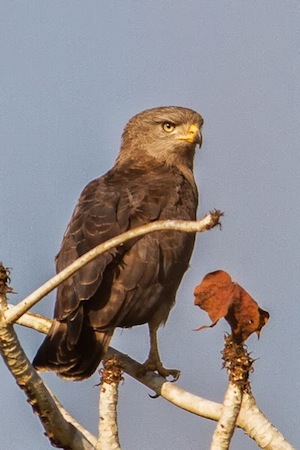
Uncommon visitor to Cangandala: a western banded snake eagle; Um visitante pouco habitual na Cangandala: uma águia-cobreira-listrada.
Photos can be seen as usual on a picasa web album, through this link.
Pedro
__________________________________________________________________________________
First Trimester 2103 Report
Versao Portuguese
Dear Friends,Rains this year have been plenty and generous, and I can’t remember such an extreme wet season in Cangandala at least since the 2005/2006 season. This fact has several consequences that, one way or the other, affect our work. The first and most obvious result was over flooding the rivers, which reduced considerably our mobility inside the park. Actually, and as soon as the rains grew in intensity around mid-January, the park main road was cut-off, and we had to walk across with water above our knees to get in. Approaching the animals in these conditions turned out to be almost impossible, and the only exception was a brief observation and photographs taken still in January.
Nevertheless, the abundant rains might be a blessing, especially following several very dry seasons in a row. It reduces considerably the risk of intense drought, it should also replenish underground water resources and the soils should keep moisture for longer into the dry season; and the lush development of the vegetation should provide lots of grazing material. On the other hand, the constant rains didn’t allow for strategically placed small out-of-season burnings, which in previous years had contributed for a balanced veld management and food provision for the animals. Another concern is that the overgrown grass this year will turn into a huge amount of dead grass – combustible material, thus increasing enormously the risks of hot fires in the dry season, inside the sanctuary. So basically, the weather conditions this year might prove to be good in many respects, but will demand a more carefully planned and assertive management in the next few months.
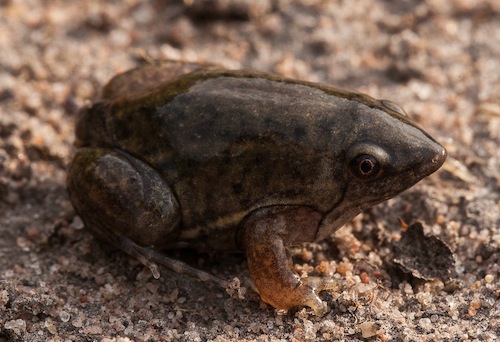
An interesting frog, a shovel nosed Hemisus marmoratus; Uma rã interessante, rã-escavadora Hemisus marmoratus.
As for the animals, as always there are new developments to report, and this time a huge surprise was registered. While observing a herd inside the sanctuary in January, we couldn’t believe our eyes when we spotted Joana among the group! This was a totally unexpected. Joana-the-mad-cow, had proved to be anti-social and escaped under the fence, soon after being captured in 2009. It had since remained outside the sanctuary, behaving in secretive fashion, declined to approach the hybrids when they were around in the first two years, and although we looked for her, we failed to find her during the 2011 capture exercise. And finally, even when having Ivan-the Terrible around, they didn’t seem to “connect”, as they were never recorded together, in spite clearly overlapping their roaming territories. Of course, neither of them seemed to be friendly characters, but we always had hope that they could get along somehow… or at least to meet on a special stormy night… On the other hand we still fear the day Ivan will break through the fence into the sanctuary, but the last thing we expected was Joan to decide to crawl under the fence after 4 years of deliberate isolation!
As the rainy season progressed, the animals did split into several smaller sub-herds, at one given time apparently into 4 groups, one group with old females and the old bull Duarte, a second group with young Mercury and many young females, a third group composed of a couple females a younger male and several calves, and a last group mostly comprising hybrids.
-
-
-
-
-
Other than this, we had to rely on the trap cameras to know what was going on. And here our expectations were fully met. Back in December we were convinced that Teresa, one of our two old breeding cows which had conceived calves in January and February (the other being Luisa), would produce a second calf before end of 2013. Well, not only we could confirm that, but somewhat surprisingly, both cows produced the second calf by turn of the year! That was fantastic, as both cows, in spite of their age, seem now to be well synchronized, and producing calves every 9 months. This brought us to a total 2013 production to 7 calves (where 2 old females alone produced 4 of these), of which 3 were females, 2 males, and the two youngest still undetermined (although at least one of the later seems to be a female). Truth be said, the second male calf born, hasn’t been seen in many months and may well have been killed. Some degree of calf mortality is unavoidable, but if confirmed it was the first casualty in 3 years, and in any case it is better to lose a male calf than a female.
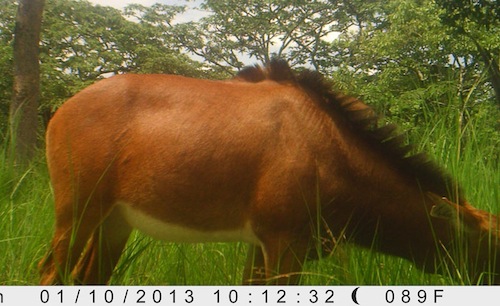
Young 2.5 year old female… has she entered her first pregnancy? Jovem fêmea de 2,5 anos, estará já na sua primeira gravidez?
By end of March, we received disturbing news, accounting for a new fight along the fence, between Ivan and, presumably, Duarte. Once again the fence got quite damaged, and there were clear signs of fighting and blood, but neither Ivan nor any other bull could be found nearby. We still don’t know for sure if any bull got seriously injured or if animals moved across the fence boundary, but apparently things are back to normal and are once again peaceful. For now…
Photos can be seen as usual on a picasa web album, through the following link here.

An artistic shot of an adult white-headed vulture on the wing! Uma foto artística de um abutre-de-cabeça-branca adulto em voo!
Best wishes,
Pedro
__________________________________________________________________________________ Fourth Trimester Report,- Dear friends,The last trimester of 2012 marked the onset of the rainy season as predicted. In Cangandala and Luando, the rains started early and heavy this season, somewhat compensating for the severe drought that lasted for almost one year.
We had several good developments in Cangandala. Firstly, and quite unexpectedly, old Duarte not only survived but made a sensational recovery. Only a few weeks after we had left him in shocking condition, we found him in great shape and looking after his girls.
I must confess that I had been very pessimistic about his future, and I was quite convinced that he stand little chance of making it through the turn of the year. Fortunately I was completely wrong on this one! He no longer is limping markedly, seems to keep well the pace with the herd, looks alert and in good condition; the fur recovered the old shine and, quite remarkably, the ticks are now almost completely gone. Quite amazing how fast the ticks spread and took over his skin when he was beaten and ill, and how quickly they disappeared as soon as he got better… it’s as if ticks sense when an animal is debilitated, and/or somehow a healthy animal has the ability to repel most ticks and keep them under control.
But if ticks were under control, the tsetse flies were a nightmare, probably affecting all living mammals in the region, us included! This was not necessarily surprise, as every year after the first big set of rains, and for about a couple months until the woodland gets too wet even for them, the flies explode in numbers and come down hard mainly targeting the large social antelopes. I have the distinct feeling (I feel it in my veins) that this has become worse every year, which is probably a good sign… more sable mean more tsetse flies! To procure some relief from the relentless flies, every 15-20 minutes the sable herd would suddenly run for a couple hundred meters before resume grazing. It also seemed that the bulls were the most affected by flies (possibly attracted to the dark coloration), and in response they would sit down often inside thick bush.
At the end October the animals had temporarily split in two groups: the old females stayed with the hybrids, while the new females and young were joined by the bulls in a second herd. This worked very well in our favor, as the crazy hybrids are always nervous and almost impossible to approach. Therefore, we focused on the second group and were able to approach the animals several days, providing us not only to monitor closely the most important group, but also to get by far the best photographic sequences to date!
And most importantly, breeding turned out to be better than anticipated. It turns out that all the three young females brought in from Luando in 2011 at age 2, produced one calf each. This brings the total calves produced in 2012 to 5, but it is possible that the old champion breeder Teresa, may have calved again before end of the year (she could not be located). But at least we had 5 calves, of which 3 are females.
It was a pleasure to keep track of this prime herd, with several young beautiful girls, and many calves around.
In addition, Duarte’s successions seems to be guaranteed and in smooth fashion, as both Mercury and Apolo are growing up fast and strong, and so far are well integrated and tolerated by Duarte. They all seem to know their role and position within the hierarchy…But of course boys will be boys, and sooner or later, the youngest should get expelled.
Looking back, the first two years after the breeding program started have been very disappointing, and the breeding frustratingly slow. But now finally things are looking brighter, and for next year we expect an even better breeding performance, as we have now four other females which have just turned 2 year old, and could deliver their first calf in 2013. With two remarkable exceptions (Teresa and Luisa) the old Cangandala females haven’t been up to the challenge, and if it wasn’t for the 2011 operation bringing to the pot 6 new females from Luando, the giant sable population in Cangandala would not have survived! Now, at least we have a chance.
As for mad-Ivan, after almost beating Duarte to death, he has kept low profile, and been peacefully behaved. Of course I don’t trust him in the least, and possibly he is preparing a new surprise… He is still out of the fence and patrolling the boundaries regularly, but as usual we could never get within sight distance. And for the past few months he has even avoided the salt licks, except for one time in which he made a ghostly and brief appearance, as if to say “Beware of Ivan, I’m still around…”
The trap cameras gave us plenty of duiker, bushbuck and warthogs as usual and some roan, but the biggest surprise was a young male waterbuck, quite close to the fence line. These were known from the riverine floodplains in the south, and it was the first time recorded in the heart of the park. Also interesting were a few nocturnal sequences showing us a greater gaçlago and a white-tailed mongoose.
If things went smoothly in Cangandala, it was however very different in Luando where poaching seems to be rampant, and we were faced with a number of shocking cases to illustrate this, in spite of the desperate efforts from the rangers – the giant sable shepherds. Two shepherds on patrol were shot at by poachers (fortunately the poachers missed and no one got injured) and on a second occasion managed to apprehend a rifle, as the poacher escaped and left the weapon behind. Plenty of snare traps are being found and dismantled on a regular basis, but arguably the most shocking incident was when, during a routine patrol, the shepherds found a dead body of a freshly killed giant sable bull. The carcass was getting rotten, but still showed a round bullet on the neck.
With support from the Angolan Air Force we scooped the area on the following day after the incident was recorded, without relevant results, and only a couple weeks later we were able to make a ground expedition to the site, to gather additional information. It was a young healthy bull, at the prime of his life, and had no signs of infection or bone injuries, practically ruling out a snare injury or disease. The most likely scenario points to bull getting away after being shot in the neck by poachers.
We camped near the site for a couple nights, and on one of those nights we actually saw a spotlight in the distance and heard shots, just across a small river from us and about 500mts from where the carcass was! If there were ever any doubts of what killed the bull…

The team of giant sable shepherds crossing the Luando river; A equipa de pastores da palanca atravessando o rio Luando.
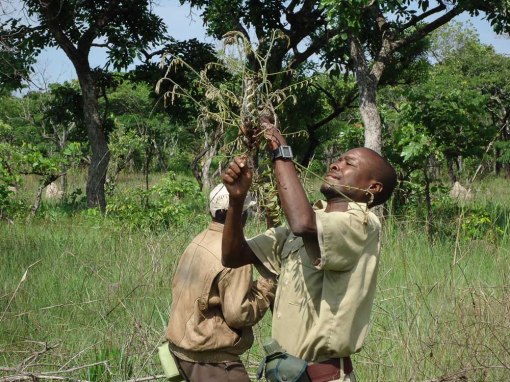
As we progressed cross-country we found dozens of traps; À medida que progredimos a corta-mato encontrámos dezenas de armadilhas.
Compared to a few years ago, we now have a much better understanding of what is happening in Luando. We also have a basic monitoring network on the ground which is producing promising results, and some small steps are being implemented directly against these illegal activities. But we are still far away from tackling the crisis properly and reverse the trend. The situation is quite alarming, but I want to believe that 2013 will be year of change, when the table odds will be finally turned against the poachers and in the giant sable’s favor!

The angolan reed frog is the commonest amphibian in Cangandala; A rela-de-angola é o anfíbio mais comum na Cangandala.
Photos from last trimester can be seen through this link:
https://picasaweb.google.com/113384424565470443034/PalancaReport4Trim2012?authuser=0&authkey=Gv1sRgCN7Uv9-hncmi6wE&feat=directlinkBest wishes,
Pedro
_________________________________________________________________________________
- Angola Field Group Presentation: Biologist Pedro Vaz Pinto presented an update on Angola’s endangered giant sable (palanca negra gigante) to an audience of over 150 members of the Angola Field Group on October 25, 2012.
In the following video (part one of two) Pedro Vaz Pinto provides an overview of the giant sable including the history and place in Angola’s culture and environment today:
In the next video (part two of two) Pedro Vaz Pinto discusses the 2003 launch of the Giant Sable Project and Conservation Initiative in partnership with the Ministry of Environment – the project’s original objective was to locate the giant sable; the creation of the Shepherd Program in 2004; the publication in 2005 of the first photos of giant sable taken since 1982; information about the hybridaztion of the species that has taken place in Cangandala plus more Giant Sable project highlights up to 2008. Since 2009, the bulk of the project’s activities are being implemented by the Kissama Foundation and the main priority now is conservation of the giant sable.
More highlights from the presentation:
2010: The first two calves were born in Cangandala and a new fenced camp of 2400 was created (in the process 10 hybrids were inadvertantedly caught inside).
2011: A new camp of 400 ha was built and a new capture operation was launched; hyrbids were confined in a third camp. The team managed to catch and bring 6 new young females from Luando reserve: three two-year olds and three one-year olds. Two new bulls were also brought in: a young male and one ‘at the prime of life’ named ‘Ivan the Terrible’ due to his uncontrollable nature. Ivan eventually killed the young male and broke through the fence. A third calf was produced.
2012: Two females died of old age; one female became pregnant again and the first calf born in 2010 is now preparing to take over the herd. Currently poaching is the main threat to the giant sable. Snares and pit traps are widely used causing severe trauma and death. A staggering 15% of adult animals captured or photographed had nasty leg injuries caued by traps. About 75% of the Luando reserve is devoid of sables and less than 80 are estimated to survive. The total number of giant sable left is less than one hundred animals making it one of the most critically endangered mammals in the world.

Plan for 2013: Up to twenty giant sable should be darted and released with VHF and GPS tracking devices for monitoring. Infrastructure should be built in Cangandala and the breeding program monitored. Ongoing genetic and ecological research will continue and be reinforced.__________________________________________________________________________________
Third Trimester 2012 Report,
-
Dear friends,
The third trimester tends to be the busiest in Cangandala/ Luando and this one was no exception. We started by making a series of improvements on the sanctuary fence, of which the most important was expanding the perimeter, adding 800ha of prime habitat to the sanctuary area. The fenced camp covers now approximately 4.000 hectares, which we believe, should be good enough for the next 5 years at least.Also importantly, the new design is now more rounded and manageable, and we were able to include one of the best natural salt licks that used to be outside the perimeter and some good grazing areas. We also took the opportunity to build three water holes, two inside and one outside the camp.
Near the central waterhole we placed an elevated tank, to feed water by gravity to the other drinking spots. Before the end of the year, we expect to drill a borehole to supply the elevated tank.
In July we had expected to have the chopper and capture team with us, hopefully to dart some of the non-breeding old cows to give them some hormonal treatment, and also to do a survey and capture/marking exercise in Luando. Unfortunately, and due to last minute unexpected bureaucratic constraints in Botswana, the chopper couldn’t come and the operation had to be canceled. In any case we had Pete Morkel with us, and a vet team from the Huambo faculty, and we used the opportunity to monitor closely the herds while trying to dart one of the old cows. We did not get close enough to the old females, and the best we could achieve was to dart and mark the lonely young roan male that is still inside the camp.
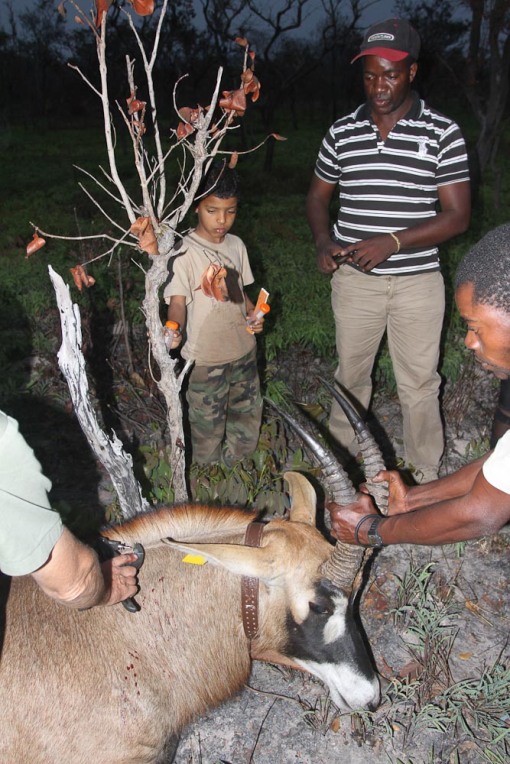
We caught and marked the young roan bull inside the sanctuary; Capturámos e marcámos o jovem macho de palanca castanha dentro do santuário.
If this was somewhat disappointing, at least everything else turned out much better than we had expected. The first good news was finding Duarte still alive. He definitely took a serious knock, but at least survived. As result of the fight with Ivan, he lost an ear tag and now carries a few scars and stab wounds.
Although finding Duarte was fantastic, we must now face the fact that he is beaten and his career as a breeding bull is over. He is limping from the hind legs, lost physical condition, his mane looks dry and dirty, and the ticks are taking over. He allowed us to get really close, but he can’t keep up the pace with the herd. In September his condition hadn’t improved, and I suspect that he won’t live through the next season. A very interesting observation, was noting that he was now feeding mostly on burnt “kinzole” (Diplorhynchus condylocarpon) leaves – we’ve seen healthy animals browsing on green “kinzole” leaves, but not on brown burnt leaves. It could be a result of his teeth wearing off, and therefore looking for less fibrous (but also less nutritious) food, but this is speculative of course.

It might be for medicinal purposes, or simply because is the easiest to chew; Pode ser por razões medicinais ou simplesmente por ser o mais fácil de mastigar.
But if Duarte seems to be finished, still the bull scenario looks to be under control. Not only Ivan is back out of the sanctuary and behaving well for the time being (just patrolling regularly the salt licks in his territory), but most importantly Mercury has, without any doubt, replaced Duarte as the breeding bull. In spite of his tender age (2 year old), he looks impressive and is clearly “the man in charge”. We saw him several times courting the females and trying to mount them, even in the presence of old Duarte, who ignored the scene and simply moved away.
But a much more important finding was realizing that our fears of Ivan having kidnapped a few females had been completely unfounded! We were able to observe and confirm inside the sanctuary, the 6 young females brought from Luando in 2011, and the remaining 6 old Cangandala cows (from the initial 9 cows, two have died of old age and one, Joana, escaped the sanctuary in 2009). So basically, the sanctuary holds pretty much the whole breeding potential. Outside the camp, only Ivan and Joana are established.
The trap camera mounted next to the carcass of the old sable cow, Neusa, who died in early June, produced some interesting sequences. As we suspected, and in the absence of large predators, bushpigs are the main scavengers, and for several weeks a large family of pigs would come to the site almost every night, until there was little left.
The new trap cameras have been taking dozens of thousands of photos, with few blanks or false events, making the job of cataloguing the camera record a very time consuming task, and storing the photos is becoming a nightmare. The usual species were photographed many times, plus a few unexpected customers, such as mongooses, hares and hornbills.

First time caught on camera: a white-tailed mongoose! Pela primeira vez apanhado numa câmara: um manguço-de-cauda-branca!
On the other hand, in July and August we had a few problems, which included several suspicious bush fires, one camera being handled by trespassers and one camera got stolen. It was the first camera stolen since we started in 2004. We have good reason to believe that poachers were behind these incidents and we are investigating the matter.
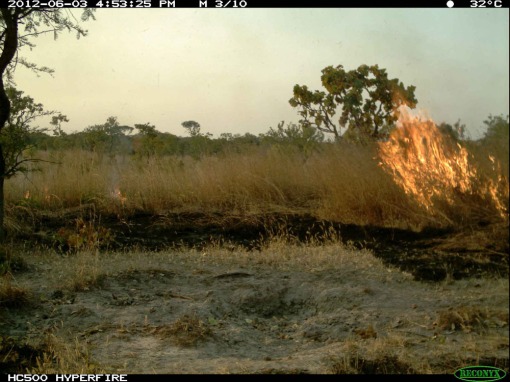
A small prophylactic fire done in June to protect the camera; Uma pequena queimada profilática feita em Junho para proteger a câmara.
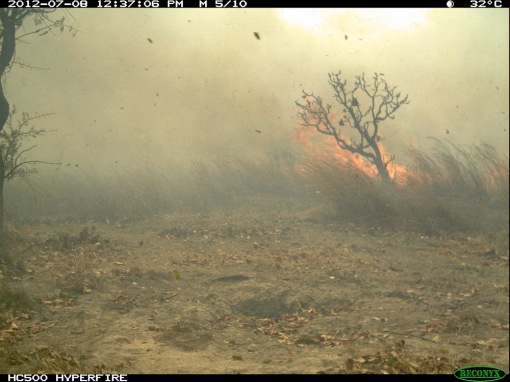
When a real bush fire came in July, the camera survived; Quando um grande incêndio chegou em Julho, a câmara não sofreu.
With the capture chopper grounded in Botswana, we were able to organize a couple of flights over Luando and Cangandala on a military Alloutte. The Angolan Air Force has always been an enthusiastic supporter, up to the challenge and should be an example to other institutions. And after all, the giant sable is a national symbol and well deserves the commitment! We then managed to track down and locate two of the Luando herds, and do a reccie, focusing on sensitive areas and known poaching hotspots, such as various water holes. Poaching is still clearly the biggest threat in Luando, and far from being controlled. What we can attest at this point is that the largest herd seems for now to be doing well, with about 75% recruitment rate of calves into the herd from 2011 to 2012. Or put in other words, we may have had around 25% mortality of calves last year, which is an acceptable result, within “normal” expected rates.
Still, the situation is so delicate, that all it takes is a couple poaching incidents, and everything goes down the drain, and beyond recovery.
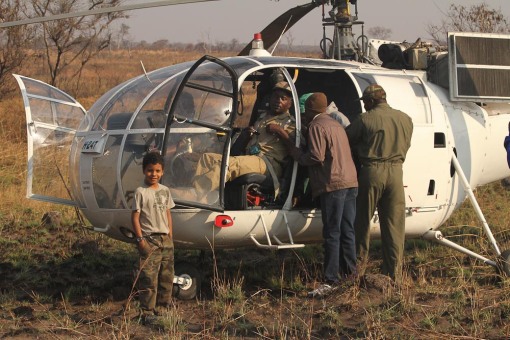
The military Allouette preparing for a flight over Luando; O Alloutte militar preparando o voo sobre o Luando.
Back in Cangandala, in September, we had more good news. First by finding another newborn! The mother is one of the young females, and the father may have been Duarte, but requiring confirmation.
And then surprisingly or maybe not, Teresa once again, is showing clear signs of pregnancy. What a wonderful cow! She will produce her fourth calf in little more than 3 years, in what is a remarkable breeding performance. It will be interesting to determine the father, as it may have been any of the three bulls present.

A magnificent martial eagle, one of Cangandala top predators; Uma magnífica águia marcial, um dos predadores de topo na Cangandala.
More photos can be found on this link:
Best wishes,
Pedro
_______________________________________________________________________________
- Second Trimester 2012 ReportVERSÃO PORTUGUÊS Dear friends,The second trimester marked the end of a very dry wet season, and the few showers experienced in April were too little too late. As result, we are now facing a serious drought this year. This fact made focus our attention on the need to provide water to the animals inside the sanctuary in consistence manner. Until now we have resorted to plastic containers filled manually twice a week during the dry season, but this of course is a poor system. We have now just concluded a geophysical and hydrological survey in Cangandala Park, and we hope to dig a borehole and install several water points this season.
On a short trip to Luando Reserve in May we were able to meet with all the shepherds, pay them the due subsidy, motivate them, and coordinate and distribute their tasks for the following months.
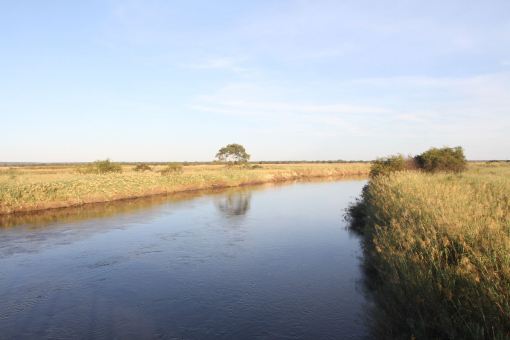
The Luando river beautiful as always in the early morning; O rio Luando bonito como sempre ao romper da manhã.
Back in Cangandala and as usual during May, it was tough to drive off-road and make progress because of the accumulation of dead grass.
In spite of this we were able to monitor the breeding herd a couple times, although briefly and not from close range. The old bull Duarte was escorting the mixed herd (pure females and hybrids) as usual, while the two old breeding cows had not yet rejoined. More importantly and as we hoped for, the trap cameras confirmed the two new calves! The two old cows Teresa and Luisa, had joined efforts and kept both newborns and their 2011 calves in a separate group, forming a crèche in what can be considered as typical behavior in sable. Keeping the calves together might be a good anti-predator strategy, until introducing them later into the herd.
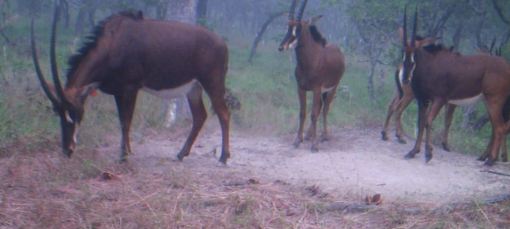
The best breeding group led by Teresa e Luisa; O melhor grupo reprodutor liderado pela Teresa e Luísa.
Interestingly, the first calf born in the sanctuary, in 2010, the young male approaching 2 years old – Mercury, had split from both groups and joined the 4 young females brought in from Luando in 2011. Confirming his precocious nature, he was now in charge of his own herd, and possibly establishing a territory. In spite of his young age he must be already fertile, so this was excellent news indeed. And for a colorful touch, this young and promising group was also joined by one of the castrated hybrids.
Outside the sanctuary, we were able to localize Ivan the Terrible a couple times near the fence, but as usual he did not allow us visual contact.
In any case, things then seemed under control and of course we could not anticipate that hell was about to break loose… In the beginning of June, Ivan decided to break into the sanctuary and started creating havoc. We found clear signs of a fight near the fence and a blue ear tag was recovered from the ground. Ivan ear tags are white, but Duarte’s were blue. This could only mean one thing: Ivan had fought Duarte and, being younger and stronger, most likely had beaten him. Frustratingly, over several days we could not locate Duarte, as his radio signal couldn’t be picked up anywhere: presumably the collar got damaged during the fight. More worryingly, the main herd was left unattended, which means that Duarte probably got killed or is injured and recovering in a secluded place.
As this wasn’t enough, Ivan the Terrible found the two old breeding cows and their 4 offspring and broke through the fence once again. We only hope he didn’t take the party with him…
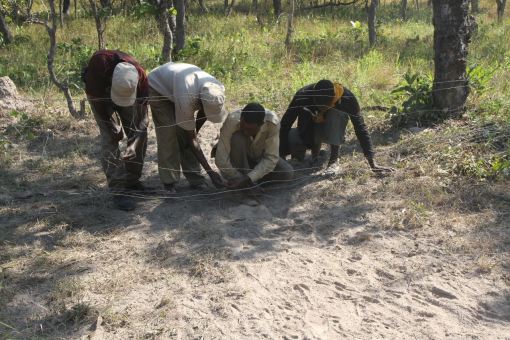
The place where Ivan broke out of the sanctuary leading the herd; O lugar onde o Ivan rebentou a vedação para sair e levar consigo a manada.
This was disappointing and a bit worrying, and Ivan proves to be a loose cannon. It is amazing the contrasting characters of these two bulls, and I don’t know if we were extremely lucky with the first one or very unlucky with the second. In hindsight it may now look questionable the decision of bringing Ivan… on the other hand we definitely needed new blood, and Duarte at age 13 was over his glory days and shouldn’t be expected to last much longer as a breeder anyway, so Ivan taking over must be seen as the culmination of a natural and needed process. And maybe Ivan will prove to be a much more efficient breeder than Duarte was?!
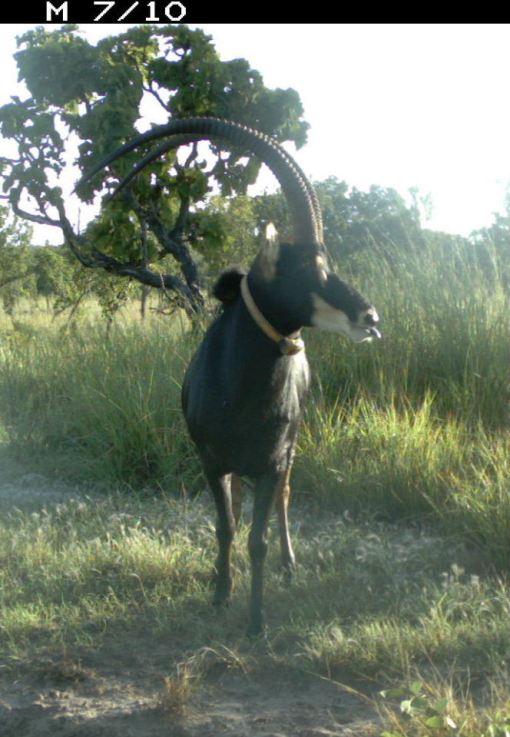
Ivan being rude: showing us the tongue – “See if you can catch me!”; O Ivan sendo mal-criado: mostrando-nos a língua – “Vejam se me conseguem agarrar!”
What is a shame is that it was Duarte’s gentle nature that allowed us to get close to the females, and with him gone the animals are less approachable. On the other hand, the fact that Ivan has brought to perfection the skills to break through the fence, making it into a nasty habit, means he is virtually uncontainable, forcing us to invest much more in fence management and security in Cangandala. However, and at this point, the situation is a bit uncertain, and it will be over the following months that we will know for sure what has really happened.
Yet, there were still more bad news to come. While looking in vain for Duarte, fortuitously we ended up finding the corpse of our older pure female, Neusa, who used to be the alpha-female on the main herd. She had been dead for only a few days, and we couldn’t find any injury or signs of predation. This female was at least 15 years old and had not been able to produce any offspring for the last few years, nor were we expecting that she could in the future given her advanced age. Sable are known to live up to 18 years in captivity, but they rarely surpass 15 in the wild, and the fecundity is expected to decrease as the females grow older. All things considered her death wasn’t unexpected and has no impact on the giant sable breeding potential in Cangandala, but nevertheless we all felt sad.
But the June wouldn’t end without a pleasant surprise, when trap camera records revealed a newborn on the young female’s herd! This was totally unexpected, as the group included 3 young girls brought in at age 2, plus one yearling from Luando last year. Females become fertile after two years of age, and these shouldn’t have had the opportunity to get pregnant. Or so we thought. As the calf was born at end of May and sable pregnancy is estimated at 8.5 months average, conception must have happened at the beginning of September 2011… and this coincides precisely with the few weeks in which Ivan stayed inside the sanctuary before breaking out for the first time! He was never seen near the 2.year old females and therefore we had assumed they never met. But evidently they did, as Duarte at the time was contained inside the smaller enclosure which was only opened in October.
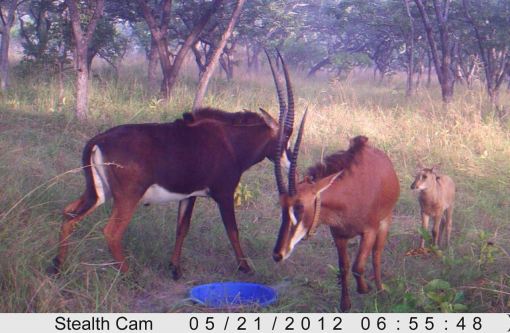
And the big surprise: A little newborn calf with her young mother! E a grande surpresa; uma noca cria recém-nascida e a sua jovem mãe!
This was excellent news indeed. Means that the young females are starting to breed and, not less importantly, it means that Ivan is not a bluffer! He is certainly not much of a gentleman, but as long as he keeps siring offspring I won’t complain.
Best wishes,
Pedro
_____________________________________________________________________________________
First Trimester 2012 Report - VERSÃO PORTUGUÊS Dear friends,The beginning of 2012 was as dry as I could remember. The rainy season usually reaches its peak by February/ March, often over flooding the wetlands and making the roads muddy and frequently impassable. The last few years had witnessed generous rains, isolating Cangandala park for weeks or months, generally between January and April. This rainy season however has been very atypical as most of the country experiences a severe drought, so when we scheduled our trip to Cangandala in March, and following insisting reports about the drought, we were confident that we would be able to enter the park and accompany the sable movements on the ground.
But, and as you have probably guessed by now, things wouldn’t be that easy. True that the landscape was shockingly dry, without mud or water in the temporary streams, while the grass was half-grown and already dry and moribund – the park hadn’t seen a drop of water in months! But just as we arrived in the evening and settled in the camp, and sat down for dinner, it started to rain. First just a drizzle, then more steady and heavily. We went to bed while it rained, and it rained all night without stop. And it rained. And it was still raining in the morning while we had coffee, and now things started to look not so good.
The rain only stopped half-morning, but we were already on-wheels and the damage was done anyway. Over the next couple days we were able to reach all the trap camera sites, to replace memory cards and batteries, but at the cost of slow progress and hard work. We got stuck countless times on the dirt roads inside and outside the sanctuary, and most salt licks had to be reached on foot. At least we were able to recover all the memory cards, but tracking the herds off-road was completely out of the question under those conditions.
So the trip turned out to be a half-disappointment, and this update report had to rely mostly on the various trap cameras’ photographic record.Speaking of cameras, the new trap camera model we planted last December is performing exceptionally well, almost too well I may add. These have better image quality, are smaller and lighter, seem more reliable, and are much more energy-efficient with batteries lasting up to several months of continuing use. But they can also take literally thousands of photos per week, stored in 8GB cards, which is fantastic but also a curse in disguise. If we used to struggle with screening, managing and storing the photos, now this problem has been inflated several fold! This trip alone rendered dozens of thousands of photos, of which “only” a few thousand showed sable, roan or hybrids.
The main herd seems to have split in small groups, which is presumably a seasonal behavior during the rainy season, but may also result from specific social dynamics like females calving and young males dispersal. One interesting example was realizing how our best breeding female Teresa, just before calving, separated from the herd while taking with her the three young calves. By mid-December she was extremely pregnant, and surely her latest calf must have been born around Xmas. It’s only a pity we couldn’t see her since and she didn’t go back to the salt licks. In any case she is our main star, being the likely mother of three hybrids and having had now three pure calves just over two years of confinement – an exceptional performance! On the other hand, it also highlights just how poorly the others have performed (maybe Luisa had by now her second calf, but all the remaining 5 old females in the sanctuary have produced zero calves).
Very interesting to note that during her last days of pregnancy, Teresa became extremely dark in color, of a deep brown that almost resembles a bull. This is even more evident as she wasn’t a particularly dark female. Must be a physiological response resulting from hormonal changes, prior to calving. Also noteworthy the fact that the first calf, the young male Mercury, is now turning very dark in color, and at a very young age, under 2 years old. He seems to be very precocious, with impressive horns for a yearling, and already darker in color than most of the herd females. Maybe the lack of competition stimulates young males to develop faster?
Going in opposite direction are the castrated hybrid bulls, particularly the mature ones, which in a few months since castration have passed from an attractive dark golden-brown coloration, to a dominant pale-roanish color, mimicking now almost in perfection the color pattern of the female hybrids! Again, reflecting serious hormonal changes – testosterone has been proved to enhance the darker coloration on sable.
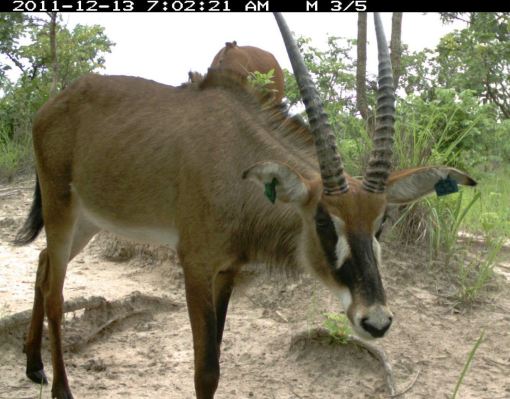
Jaffar, the 3 year old hybrid male, a backcross – 75% roan and 25% sable; Jaffar, o macho híbrido de 3 anos, um backcross – 75% ruana e 25% negra.
Outside of the sanctuary Ivan has been regularly visiting the salt licks, although mostly at night, while patrolling his new territory. And on January 1st he showed up accompanied by Joana (the old female that had escaped the fenced sanctuary in 2009), thus confirming our suspicions. On the other hand, we saw none of two young females that escaped the sanctuary following Ivan, and at this point it is unknown if they have teamed up with Joana, or wondered off on their own.

Ivan is so strongly built that the radio collar looks dwarfed around his neck; O Ivan é tão musculado, que a coleira quase desaparece ao redor do seu pescoço.
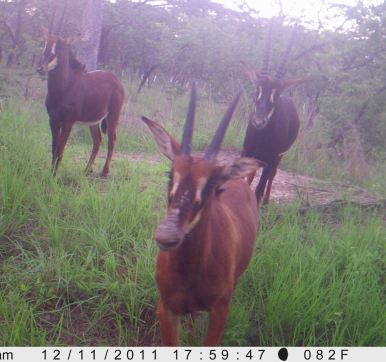
The three first offspring in Cangandala breeding program; As três primeiras crias do programa de reprodução da Cangandala.
Link for the photos: http://picasaweb.google.com/113384424565470443034/PalancaReport1stTrimester2012?authuser=0&authkey=Gv1sRgCNio65et0tG5fA&feat=directlink
Best wishes,
Pedro
Back to top of page_____________________________________________________________________________________________
Third Semester 2011 Report – Sept-Dec 2011
VERSAO PORTUGUESEDear friends,The last four months of the year had been greatly anticipated, as the giant sable breeding program in Cangandala NP was entering a new and more exciting stage. After all, and as result of the very successful capture operation that took place in July and August, we had now two breeding groups in two fenced camps. In spite of our high expectations, I’m afraid there is never a smooth ride in Cangandala, and over and over again we are forced to react to unexpected events and change route. At best, these last few months had been sour-sweet.The main culprit for our most recent headaches was Ivan “the Terrible”, that most impressive and aggressive giant sable bull that we had recently brought in from Luando Reserve. He had been released into the 2,800 ha camp with six young females and a 2-year old young male (“Miguel”), and within the first week they had all found each other.
-
- Dear friends,The last trimester of 2012 marked the onset of the rainy season as predicted. In Cangandala and Luando, the rains started early and heavy this season, somewhat compensating for the severe drought that lasted for almost one year.
-
-
-
The hybrid herd was also inside this camp but both groups didn’t mix. The two males were seen together a few times, but on the second week Ivan’s irascible nature became all too obvious when he chased down Miguel and killed him mercilessly. The young male was stabbed several times and at least twice in the chest… it must have been a very quick and brutal clash. This of course was a huge disappointment for everyone, as we had assumed the young male was still too young to be seen as a threat.
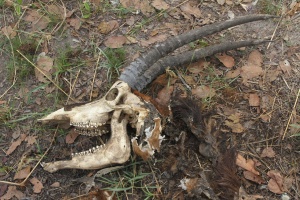
The skull of Miguel, the young male killed by Ivan the Terrible; O crânio do Miguel, o jovem macho morto por Ivan o Terrível.
Territorial bulls are generally intolerant creatures, often fighting contenders, and deaths derived from fights are not uncommon. Maybe Miguel would have been tolerated by a different bull… but not by Ivan the Terrible. Anyway, and as cruel as this may sound, this young male was the least important animal and he had been brought strictly as a plan B, a replacement male in case something happened to the older and dominant bulls. Losing Miguel isn’t a crisis for the breeding program.

The death of Miguel was a very sad moment for everyone; A morte do Miguel foi um momento muito triste para todos.
But Ivan wasn’t yet happy, and a couple weeks down the road he broke through the fence by brute force, opening a huge hole and escaping the sanctuary on its southernmost boundary. He took with him two of the yearling females, leaving behind a third yearling and the three 2-year old females. Why only two of the six females got away remains a mystery, although one is tempted to speculate that maybe the other didn’t approve Ivan’s manners. The escape of these animals was of course seen as a major blow to our plans. Especially as we immediately assumed that Ivan would either start migrating south in a suicidal attempt to find his old territory in Luando, or would at the very least go astray in unpredictable manner and cross the Park boundaries once and for all with the two young girls. But just as we had taken these grim scenarios for granted, that’s when Ivan started to surprise us on a positive way! It turns out that once free from captivity’s ball and chain, Ivan decided to calm down and established his new and wild territory right outside the fence. Over the last few months we have radio-tracked Ivan and he really appears settled and always within a few kms from the fence line. Unfortunately his elusive nature has kept him out of sight, and we also decided it would be wise not to push him anyway.
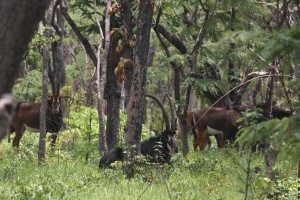
When the bull rests, the herd relaxes and tends to stay nearby; Quando o macho descansa, a manada relaxa e tende a ficar próximo.
Although we couldn’t yet confirm, it seems Ivan has kept the two young girls with him. Just as importantly, it turns out that the area where he has based his new territory is precisely the area roamed by “Joana”, the old pure female that escaped under the fence in 2009, and since then she had been on her own.

Joana, always wary and lonely outside the fences, is photographed for the first time in day light; Joana, sempre arisca e solitária fora das vedações, é fotografada pela primeira vez à luz do dia.
I can’t help thinking that it is more than a coincidence that Ivan settled nearby Joanna… surely they must have found each other by now… and maybe her presence is what drove Ivan through the fence?! Now, that would be quite a twist in this story. If Joana manages to keep Ivan and his girls around, constituting a new breeding herd, even outside the relative safety of the sanctuary, it might even turn out as a better and more natural scenario!
Given what happened with Ivan, we decided to immediately open the smaller enclosure of 400ha, ending up now with one single large 3,200 fenced camp. It wouldn’t make sense to keep the first breeding group contained longer in a sub-optimal area, now that the second bull was out of the picture. Moreover, we had now a group of four young pure females desperately needing the company of a bull, preferably a gentle giant such as our older bull “Duarte”.
In the meantime, the castrated hybrid bull “Scar” had joined and been accepted into the pure herd. Not quite as “one of the girls”, but not quite as a stallion either… well, I’m not sure what one should expect from a castrated hybrid, but this one surely looks and behaves funny! He is now a very nervous and hesitant individual (I was tempted to say that he looks a bit hysterical at times…), but he seems quite harmless. Sometimes he is seen running on a brief chase after a pregnant or low ranking female, as if trying to establish his position within the female hierarchy. But more often than not he follows Duarte around, and enjoys climbing up the termite mounds as if to watch guard as the herd peacefully grazes.

The hybrid Scar displaying his peculiar behavior of observing us from the top of a termite mound; O híbrido Scar cumprindo o seu peculiar ritual de nos observar a partir do topo de um morro de salalé.
It’s as if Scar wants to be Duarte’s personal assistant, but almost always he is completely ignored by the old bull, who certainly doesn’t see the castrated hybrid as a challenge worth wasting energy. On rare occasions we saw Scar gayly approaching the bull a bit too much, but when this happened the later, in his typical nonchalant manner, simply lowered his head showing the tip of his long horns and Scar immediately jumped and run off to a safer distance.
As expected, once the separating fence was removed, it didn’t take long for the breeding herd to take advantage of the larger camp, and the hybrid group was quickly absorbed. After all, the area was well known for the old females, and the hybrids were their own offspring. It wasn’t also a surprise realizing that the four young females from Luando weren’t accepted into the herd. Sable live in a matriarchal system, in which the herd is led by top ranking, usually older females, and “alien” females are seldom accepted into the group. Ironically, our old females feel more comfortable with a bunch of freak hybrid ugly beasts, than with these new beautiful looking young girls from Luando! I guess it doesn’t matter what people say, they will always be beautiful for their mothers!
Anyway, the fact that they didn’t all join in one single large group is not a problem, and may even be irrelevant. All we need is the bull, once and a while, to spend some “quality” time with the girls. And sure enough, Duarte was already seen leaving the larger herd and joining the four females.
As for the breeding performance of the original herd, it is still well below par and we have no new calves confirmed to announce. On the other hand and as we enter now the third year, a clear pattern is emerging. Out of the seven females, only three seems to be breeding. The star of the show has been the oldest (and also dominant) female “Neusa”, who following the natural giant sable breeding cycle has calved successfully in May (2010 and 1011, unfortunately for us males in both occasions). And sure enough, in last September/October she was again in oestrus and we could witness Duarte excitedly smelling her urine and even making a feeble attempt to mount. We only hope the breeding effort won’t be too much on her, as she was now a bit weak and limping.
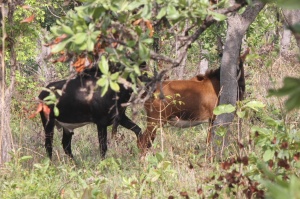
After calving twice already (Mercury in May 2010, and Apolo May 2011), in late September Neusa was again in estrus, and the old bull makes here an attempt to mate; Depois de ter tido já duas crias (Mercúrio em Maio 2010, e Apolo Maio 2011), no final de Setembro a Neusa estava já outra vez no cio, e aqui o macho faz uma tentativa para a montar.
Then we have two females “Louise” and “Teresa” who also are breeding, but on a 6-month off-cycle. They have entered oestrus late and showed off-season pregnancies. This is not too much of a crisis, as long as they keep reproducing. In fact, both females were heavily pregnant in 2010, although only Luisa produced a female calf. We assume Teresa’s calf must have died soon after been born. In 2011 they were again both obviously pregnant in October and November, and in December Luisa had left the herd (assumed calving), while Teresa was showing a nervous behavior and had a remarkably swollen udder so we expect her to have also calved by now.

While Louise stares at us, the old bull is smelling Neusa’s urine, possibly to test her estrus condition; Enquanto a Luísa nos fita atentamente, o velho macho cheira a urina da Neusa, possivelmente para testar a sua condição de cio.

On a second stage of the ritual, the old bull raises the head and extends the lips, while the younger male (Neusa’s son Mercury) approaches with curiosity;

Mercury, just one and a half year old, is developing fast and is already darker than most females; Mercúrio, com apenas um ano e maio de idade, está a desenvolver-se rapidamente, e já é mais escuro que a maior parte das fêmeas.

Teresa failed to deliver us a calf in 2010 (in spite of late pregnancy), but in last October was showing again evident signs of pregnancy; Teresa tinha falhado em dar-nos uma cria em 2010 (apesar de gravidez tardia), mas mostrava em Outubro novamente sinais evidentes de gravidez.
All this would be fine, if it wasn’t for the fact that the remaining four females haven’t yet showed any clear sign of pregnancy, although they look well fed, healthy and relaxed. So, for the second year in a row, we have one well timed breeding female, two other females breeding off-cycle and four females not breeding at all! This can’t be a coincidence and I think it is clear now that we can’t also blame the bull or any other exogenous factors. Under normal circumstances, giant sable breeding should be pretty well synchronized (most females calving at the same time, around May/ June), and the fertility rate should be at least around 90%, so something has gone very wrong. We believe the explanation for this abnormal breeding rate, is almost surely a result of a decade of breeding hybrids or non-breeding at all. Not one of the females have had a normal and healthy “breeding history”, and the consequences become now painfully obvious, with more than half of the females not even going into oestrus cycle. If our suspicions are confirmed this needs to be tackled in 2012, possibly darting and administering hormones and thus hoping to induce oestrus on those four problematic females.
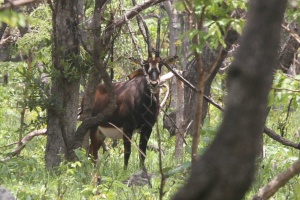
Louise, mother of our female calf Venus, was now again clearly pregnant; Luísa, mãe da nossa cria fêmea Vénua, estava agora novamente grávida.
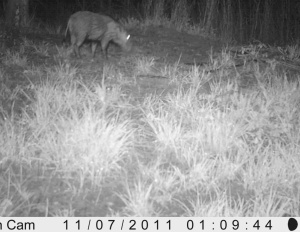
Inside the breeding enclosures, bushpig is photographed for the first time in Cangandala; Dentro dos santuários, um potamochero (javali africano) é fotografado pela primeira vez na Cangandala.
More photos can be seen on Picasa here.
Finally I must refer that the year of 2011 ended in the most tragic fashion, when unexpectedly our dear friend Kalunga Lima, passed away. He was a remarkable filmmaker and photographer who had just about finalized his documentary on the giant sable project. We had made several trips together in the bush, both in Cangandala and Luando, and I feel privileged to have shared those moments with Kalunga. If I lost a great and true friend, the giant sable lost one of its most enthusiastic and relevant supporters. And the country lost simply the best professional in his field, one that cannot be replaced in the foreseeable future.
Best regards,
Pedro
Back to top of page.
_____________________________________________________________________________________________-
-
-
-
-
Second Semester 2011 Report
VERSAO PORTUGUESEDear friends,
Again, I am following a bit behind on my reporting and for that I apologize. But I hope the nice photos and interesting contents can make up for the delay!
As anticipated these two months were the busiest in the year, during which we did the 2011 capture operation. Expectations were high and results didn’t come short. The core team was the same as in 2009, with Barney O’Hara and his Hughes 500, and Pete Morkel as leading vet. We also had our friends the Traguedo’s and local vet Ary Jeronimo to assist throughout the campaign. As in 2009, the Angolan Air Force proved to be a most reliable partner, and provided for heavy logistics including making available a heavy-duty military chopper MI-17. With the third fence completed in due time, just before the start of the operation, the last minute preparations included building temporary bomas and distributing drums of Jet A1 on different base camps in Cangandala and Luando.
In the first few days we erected a large funnel with plastic boma material, as we hoped to be able to chase with the chopper the hybrid herd through a 200mt gate into the third camp. However, chasing the hybrids inside the larger camp proved to be a much harder enterprise than we expected. First thing we realized was that as soon as we approached the herd the dominant hybrid bull would break away and take a different route. Catching the hybrids while leaving behind the bull would be highly unsatisfactory as the latter posed the most immediate threats to the pure sable. Therefore we decided to capture the bull first. This was done cleanly, and he turned out to be a superb specimen, even if of a non-existing species. With dark brown skin color, black face, hints of gold in the mane, 40’ long horns and powerfully built, he could be a worthy type representative of a new Hippotragus breed!
This bull was the younger of two half-brothers born in 2006 which we knew very well by now. We had named them Sherikan and Scar respectively, as all our hybrids were named after Disney villains. They had been raised together within the sable mixed group till late 2008 when the older Scar became dominant and chased away Sherikan. The later wasn’t seen for quite a while, but earlier this year he had broke through the fence and invaded the larger camp and subsequently fought and replaced Scar as dominant bull in the hybrid herd. This was a surprise as we had assumed Scar to be still in command, although if we had checked the photos carefully we would have picked up the swap before (they are very similar but have a slightly different facial mask). But what had happened to Scar? He could have been killed by Sherikan, or chased out of the camps through the fence… or he could even be somewhere inside the big camp, although we hadn’t picked him in the photos for quite a while.
In any case, we dealt with Sherikan according to plan: castration. Relieving of his masculinity should quickly transform his mind set, making him more docile and unwilling to fight other bulls, not to mention that sterility is from now on physically enforced and guaranteed. We then released him with a VHF collar and as final touch we painted his ear tags of pink color (sorry, I couldn’t resist).
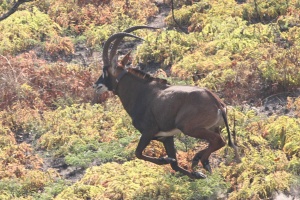
After a few days Sherikan had recovered fine from his surgery and was proudly showing off his pik ear tags.
In the meantime flights in Luando had begun very well, and following the on-the-ground info gathered by our trackers in previous weeks, we quickly located what is likely the largest surviving giant sable herd, numbering over 20 animals, including a dominant bull, breeding females, calves and some young animals. Over the following weeks we did dozens of operational hours over Luando, covering the best terrain and areas where we had reasons to believe there could be giant sable groups. We located a few other, smaller herds and we darted in total 18 different individuals. On the other hand, huge areas of prime habitat in Luando where giant sable used to be common are now empty of sable, but small herds of roan still persist. We reached this conclusion following long operational flights, in conjunction with ground information and witness reports. Roan antelope somehow seems to have resisted to the last decades of uncontrolled poaching and are now slowly recovering in the reserve.
As result of the last few months’ efforts we know now much better than ever before, the real situation on the ground. I believe we know how many herds there are left, exactly where they are all located, how many animals in each herd, and even the detailed population structure. There must be no doubt that this magnificent creature is in desperate condition, on the verge of extinction.
For security reasons I will rather not divulge much more information about the giant sable in Luando, other than we have few herds left, totaling less than 100 animals. We do have a fair number of animals being permanently monitored, and with assistance from the military forces we are implementing action against poaching but also preventive measures against animal theft attempts. For obvious reasons, details about these operations must remain confidential.What does come across very clearly is that not only was excessive poaching that reduced the giant sable population to the current condition, but also it is still very active at the moment and has been impacting the population very severely during the last few years. The most widespread technique is the use of leg snare traps laid around natural water holes and fresh grazing spots. The snares are made using nylon ropes or steel cables, attached to long wood poles cut from trees. In 2009 virtually all the water holes were trapped and the animals were dispersed and under enormous pressure. Since then the situation improved slightly in the areas within the influence of the local shepherds, but not much elsewhere. This year we still found quite a lot of snares, but even more alarming was finding several mature females with leg injuries, some in shocking condition, like one we photographed very weak and with the lower leg in advance stage of necrosis with an obvious snare scar – she had just survived a snare encounter but she wouldn’t live much longer. As sad as it sounds, there wasn’t anything at all we could do to save her.
The observed population structure is also very informative to help us understand what has been going on. The structure shows a time glass type, with a lot of old animals, a good number of young calves but very few animals in intermediate age classes. This shows that in recent years very few young animals have been recruited annually into the herd. This exaggerated young mortality rate is almost certainly resulting from the poaching pressure as calves and yearlings are the most vulnerable to snare trapping.
On a positive note, it seems that, unlike 2009, this time the climate has worked in our favor. Turns out that in 2011 the rainy season extended well beyond average, with the last rains coming as late as June, just after the calving period. During the operation there was still lots of water available and the seasonal burnings and associated poaching were just about starting. In late July most of the calves were about two months old and not yet cornered by poachers. As result of all this and with the emergency measures we’re setting on the ground, I believe we came just in time to save the 2011 annual production. If we sustain this for the next few years we might have fair chances of saving the species.
Back in Cangandala we successfully replaced the non-functioning VHF collar on the old breeding bull “Duarte” with minimum distress. We manage to approach the pure herd and dart the bull from the car without him even realizing he had been hit by a syringe. We only had to wait for him to go down and we quickly replaced the collar.
Next we carried out tackling the hybrids. These bastards persisted being very wild, stubborn and of unpredictable nature making the chopper chases a risky business. When it comes to running and avoiding the chopper pursuit the hybrids are much more roan-like than sable-like, and after a few frustrated attempts we gave up on the plan of chasing them all to camp 3, and instead we decided to tackle them individually and sterilize them. In the meantime and while focusing on the large camp we had assumed Scar would probably be out of the scenario, but in an incredible twist he made a huge mistake when he literally came into the picture! We had left one camera monitoring the sable herd in the smaller breeding camp and while doing a routine check of photos during the operation we were shocked to find Scar! After being defeated by Sherikan he had broke through the fence into camp 1 and was now sniffing around the pure group – precisely what we feared the most! He only passed in front of the camera for a few seconds and it were just two lousy photos at night, but was enough: Scar was alive and well, and inside camp 1. He had to be caught! It took us several hours for several days to find him, but we finally did and he was also castrated.
Eventually all 9 hybrids were darted and marked. We believe there are no more hybrids left in Cangandala, with the possible exception of a yearling which hasn’t been seen for several months now (may well be dead).
The other critical phase of the operation was to constitute a new breeding group in Cangandala. This required us to catch sable in Luando and bring them to the fenced camp in Cangandala. To do this we built one plastic boma site for release of the animals in Cangandala, and decided to build another one as temporary holding pen in a very wild and remote location in Luando reserve, but reasonably equidistant to several herds. The idea was to catch a few animals and put them in the holding pen until we could prepare the trip for the military chopper, which could then bring 2-3 animals on each trip. It would be the safest and more efficient method.
Following the first weeks of flights we knew already which animals and from which herds could be caught. It soon became clear that we shouldn’t try to catch adult females. Most of them were very mature or of old age and either rearing a young calf or heavily pregnant. Ideally we should then try to catch 2-year old females, as these still haven’t bred and will soon enter their first estrus. Unfortunately, and as result of the very unbalanced population structure there were only three such females available which we then caught. We also identified four yearling females of which we caught three. In the process we decided to also bring in a young 2-year old male as future replacement bull. And finally we needed to bring in the new big boy.
During the surveys we had found three solitary bulls (these were the ones seen alone and not accompanied by the breeding herds), one being a recapture from 2009. The other two were truly remarkable specimens. One (Hugo) was a estimated 12- year old bull with 55’ horns, while the other (Ivan) was a 7/8 – year old, with 54’ horns but everyone agreed was the most powerfully built animal we have seen so far. It was well covered with muscles and the neck was so thick that for the first time we struggled to get the VHF collar around its girth – it ended up being a very tight fit high in the neck and using the very last hole. This one was a sable on steroids! He also seemed to be full of testosterone, with his body carrying recent scars from fighting with other bulls.
We then decided that the new bull to bring should be “Ivan the Terrible”. Mostly because his relatively young age should make him an ideal replacement for Duarte as the later grows older. On the other hand we thought that Ivan being of a much wilder nature might be a good thing to stimulate Duarte and some of the old females of Cangandala.
First we started by catching and releasing 4 females and the younger male in Cangandala, and on a second stage we had two last yearling females waiting for the big boy to be also released together. Between the military chopper landing site and the releasing boma, the animals were transported on a pick-up truck. However, and as the pick-up wasn’t available on the first run, as plan B we ended up putting two 2 – year old females and one male inside the back of my hardtop Land Cruiser… wouldn’t believe it myself if I hadn’t been there, and I have now a couple holes in the roof as reminder!
Bringing in Ivan was quite a task. After a tricky chase he eventually went down in a well wooded area and 300 meters from the nearest clearing. Considering its enormous size and difficult terrain it wouldn’t be possible for Barney to lift him with his Hughes 500. The alternative was bringing in the military chopper to land in the clearing with a support team. It took us 10 men and an enormous effort to carry that beast on a stretcher across 300 meters of tall dead grass, hidden termite mounds and fallen wood. It’s a shame we couldn’t weigh the bull but most guys agreed he may weigh well over 300kg!
Once inside the release boma next to the two yearling females, we had hoped to keep him for 24 hours minimum, maybe up to 48 hours if he was well relaxed… Well, Ivan soon started breaking the wood walls of the inside cover and opened a hole in through the first plastic curtain door. As it became clear we wouldn’t be able to keep him for longer, we were forced to open the gate and let him out with the girls just a few hours upon arrival. What a piece of work, Ivan the Terrible! We started then wondering if he was indeed the best choice of bull…
In any case, the operation was a huge success. We managed to establish a new breeding group in Cangandala, including a new bull and six young females. Although three of these females are still too young to breed and cannot have their first calf before mid-2013, their tender age should ensure a quick and satisfactory adaptation and we should expect a long productive breeding life ahead of them. They are probably the ideal complement the current aged and not so well productive herd.
In terms of other wildlife seen, the first mention goes to roan antelope. We did find quite a few herds, notably one with 26 animals in Luando and one herd of 18 in Cangandala. These are large groups as roan are generally less sociable than sable. Contrasting with the giant sable, the roan herds seemed to be much better balanced with plenty of animals of different young age classes.
We darted and collared two roan yearlings. The plan was subsequently catch a small group of young roan and translocate them to Kissama NP, where this species used to be abundant but eventually became extinct. The animals were to be driven to Kissama on a military truck and a special container had been donated and customized for this task. Unfortunately this part of the operation was temporarily blocked due to miscommunication between Governmental agencies, and by the time we received the green light it was simply too late to start over. This was a disappointment, but we may still do it in the future, who knows next year. At least we know we have plenty of roan and where to find them.We failed to find buffalo or eland, but on the other hand it was rewarding to see and photograph red lechwe and oribi – two species I hadn’t yet seen in Luando.
And I was also able to take nice photos of the elusive yellow-backed duiker.
A final mention to the fact that the team that had to spend a few nights camped in the bush guarding the sable in Luando next to the temporary boma, had to face lions roaring around the camp for several nights. Ary in particular had a couple sleepless nights but came back with a few stories to tell!
See more photos at See photos: https://picasaweb.google.com/113384424565470443034/PalancaReport2_JulAgo2011?authuser=0&authkey=Gv1sRgCMbnoOXs-_ngKw&feat=directlink
Best wishes,
Pedro
Back to top of page.
_________________________________________________________________________________
-
First Semester 2011 Report
VERSAO PORTUGUESE
Dear friends,I must start apologizing for lack of comms for so long. This rainy season was particularly wet in Cangandala, over flooding the rivers and cutting road access to the park, and as a result I spent several months without visiting the park. In addition, the first trip was a bit disappointing and I thought it made more sense to include a couple more trips and make a semester report. To compensate for the loss, I decided to spend a little more time preparing the photographic package, which is now made available as a Picasa web photo album.
Hope this works better… CLICK HERE TO VIEW THE WEB PHOTO ALBUM.
The first trip was indeed frustrating. We were hoping to spend a few days watching the bull, his eight old ladies (we hoped the injured female to be still alive, and the ninth female had disappeared for over a year now), and his progeny. And maybe new calves?
Locating the herd shouldn’t be a problem, with three animals collared… However, Luisa – mother of second calf, had a VHF/GSM collar and these are suppose to last half of the standard VHF kind (2 years instead of 4) so sure enough, the batteries were dead by May. Second collar was working fine but it was on Quitéria, the injured female, but in this case she was the one dead! The collar led us straight to the skeleton and this of course was a sad moment, even if not completely unexpected. She had died at least one month earlier. There was no obvious cause of death, but I guess it is safe to assume it was related to the injury that made her limp for so long.
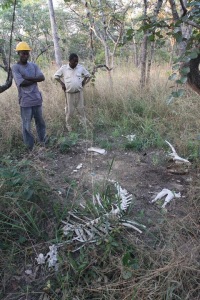
The old limping female managed to survive for almost two years, before dying quietly… this was a sad day, even if not totally unexpected.

Under moist and warm conditions, a dead animal will decompose quickly. The VHF collar led us to the skull and bones of Quitéria.
As if that wasn’t enough, over following days we could not pick up the signal on the last VHF collar, the one on the dominant bull. This was totally unexpected as this collar should be at least half way through the batteries’ life. On top of this, and as it is usually the case at the onset of the dry season, the bushes and grass are overgrown, making it impossible to drive cross country and realistically find the animals. It made us wonder if the bull couldn’t have gone under the fence and escaped the sanctuary… there were plenty of fresh tracks inside and the bull wouldn’t leave his girls, would he? But still, how could we be sure? We located a good spot and planted a trap camera there, but we would have to wait a few weeks for an answer…
On the second fenced camp we located the hybrid herd, or at least the female “Judah” as her VHF collar was still functioning fine, but the collar on Ursula, a GSM/VHF was not active anymore. Visual contact with the hybrids wasn’t possible due to long grass, but there was no reason to push things anyway.
The trap camera record since mid December 2010 showed lots of interesting stuff, and confirmed that the hybrid group was in good condition and stood together. But the real surprise came from outside the fences, where one isolated pure sable female showed up. It wasn’t clear when she first appeared in December, but subsequently it became obvious that she was the lost female, Joana. She had managed to escape from Sanctuary 1 a year ago without a trace?! At least she wasn’t dead. She must have crawled under the fence, breaking away from the rest of the group… Interesting to note that she had been the first female caught in 2009 because even then, she was the first to break from the herd when we started capturing, and she is also a confirmed mother of hybrid (DNA proved that she fostered “Judas” in 2004). So she’s always been a rebel! A romantic soul might be tempted to believe that she went back in search of her true and only love… the roan bull!!! Surely not… but let’s hope we don’t find her soon raising a new bastard!

Near Xmas a pure sable female showed up on a saltlick located outside of the fenced camps! This was a total surprise. Could this be an unsuspected animal, or maybe “Joana”, the female that had mysteriously vanished a year earlier?
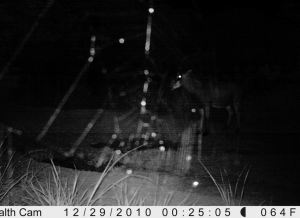
The second visit of the mystery female suggested it could be Joana, as a dark spot on the left looked as it could be a eartag, maybe… unfortunately a spider had decided to build her web in the wrong place, wrong time…
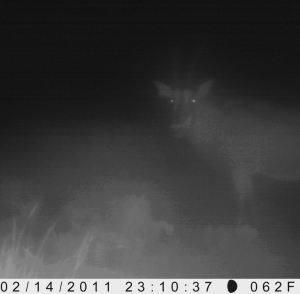
On Valentine Day the doubts were finally dissipated: the mystery animal was indeed Joana, as the eartags were visible. And she was still alone.
In June we started building a third fenced enclosure with 450 hectares and this is where soon we expect to move all the hybrids to.
In later trips we managed to track down and see the pure herd, and thus confirm that the sable bull was as tame as ever and looking strong and healthy, and the radio collar was indeed dead.
But the best news came from the trap camera placed inside the sanctuary: we had a third calf. The previous two were growing healthy, and it was now possible to determine the sex of the calves. They were male – female – male, on this order. Three calves (and only one female born) in one and a half years of breeding is no doubt a poor result, but 2011 is still going and once we enlarge the sanctuary we expect the breeding success to improve significantly.
And on the second enclosure we rechecked the hybrid herd a few times, and once even got a few lousy photos as the group fled.
On a brief visit to Luando, we met with the shepherds and planned for the crucially important next couple months. So far, news are encouraging. A day spent at the river provided for great birding and to enjoy and explore the area a little bit and we were even shown a group of five hippos.

This male scarlet-chested sunbird was the first season visitor to the red-flowered miombo tree in the camp. Many more should follow in upcoming weeks.
Next month will be quite busy, pulling a new ambitious capture operation. We expect to move all the hybrids to the third enclosure, constitute a new breeding group in Cangandala with sable caught in Luando, make a survey on some of the more remote areas in the reserve, to mark up to twenty animals with collars, maybe capture other wildlife and make some anti-poaching interventions. And even more strongly than in 2009 the National Air Force will play a major role in the operation.
Well, enough for now, hopefully next report will be a juicy one.
Best regards,
Pedro
Back to top of page._________________________________________________________________________________
- January 2011- Fourth Trimester Report
2011 Trimester 1Dear friends,2010 wouldn’t end before we received more good news. In late October, one of the two females that looked very pregnant in September (Luisa – nº12) started behaving differently than usual, much more wary and nervous (she used to be one of the most relaxed females), and abandoning the herd often. These we immediately interpreted as probable signs of calving. And because Luisa is one of the females carrying a VHF collar, we were able to track her down occasionally, when she was away from the herd, and not surprisingly her signal led us to the thickest clump of forest inside the sanctuary. We decided it was best not to disturb her then, so we had to wait a few more weeks, till mid-December, to confirm and see the second calf born in Cangandala.
-
-
-
-
So far it wasn’t possible to determine the sex, as the calf is very small and the vegetation is now too lush too allow us reasonable observations. Until the sex becomes obvious we decided to treat it as a she – positive thinking! In several photos we can see her standing next to her proud and protective mother and older half-brother.
Not only the older calf is healthy and developing fast…
but somewhat surprisingly, the seriously limping female made an impressive recovery. She is still limping, but she put on some weight, the coat looked shinier than a couple months earlier, and she seems better accepted within the herd. When in September she appeared to be in a desperate condition. Possibly the recovery is simply due to the change of season, with more and better quality of food available to the animals these days, and this affecting primarily the injured female, but in any case it was a bit of a relief. As for the bull, he also looks as strong and healthy as ever.
On a less positive note, the female that disappeared in July is still missing, and we must face that she is probably a casualty on our breeding program. She either managed to crawl under the fence, or more likely, she died discretely. The fact that she was the oldest female in the herd can’t also be seen as encouraging… We’ll keep an eye open for her, but until proven otherwise we’re down to eight potentially breeding females.
As for the calving success, and in spite of the joy of facing the second newborn, it was disappointing not to have had more calves in the sanctuary in 2010. Females that at one point seemed to show pregnancy signs ended up not delivering the goods. All in all and concluded the first year, we were left with a bitter-sweet taste… there was breeding but below expectations. Or maybe we set the standards too high, as a first year of breeding of wild antelopes held in semi-captivity is always risky and unpredictable. Anyway, we are focusing in the new year, and now that they are fully adapted, the animals should have a much better breeding in 2012.
We have now established an ambitious plan for 2011, which includes building a third enclosure where all the hybrids could temporarily be relocated to, and then bring more sable, females and males, from Luando, so that we can establish at least two breeding herds in Cangandala. Still early days, as the activities are still being discussed among the various stakeholders. In any case, 2011 will probably witness a lot of action and constitute another landmark for the species’ conservation.
The trap cameras in Cangandala are still located in natural salt licks, both inside the larger enclosure (Sanctuary 2 – where we have the hybrid herd) and outside the fences, where we know to have roan but need to keep an eye for any surprise. Well, the record from the last trimester gave us some nice photographic sequences, but these simply confirmed what we already knew. In the referred enclosure we only found hybrids, in a total of ten individuals…
These include one dominant bull…
… and the two young males born in 2009 and 2010.
The rest are females of different ages, and two of them carry VHF collars.
We still can’t say who is the father of the younger calf and why he looks so sable-ish, but it is really interesting to note the contrast with the other young male as the later looks very roan-ish indeed! Surely sooner or later our study on the genetics, will shed some light on this subject. At least now we are pretty sure that we have a hybrid herd inside the enclosure that totals probably ten animals (maybe up to eleven or twelve maximum), and we still couldn’t find any evidence of something else, like a roan bull. This is important data to assist us in the planning to sort out the problem later this year. Outside the enclosures we also only obtained photos of roan, as this roan bull sharing a salt lick with a bushbuck.
We still have no evidence of hybrids or sable outside the fences. It really looks like somehow we managed to fully and perfectly separate and fence-off the three “species” in Cangandala! The pure sable in sanctuary 1, the robles in Sanctuary 2 and the roan outside. Truly amazing indeed. The remaining photographs showed the usual customers, such as duikers…
… bushbucks …
… and warthogs …
and for last a surprising newcomer – a white-headed vulture.
Best wishes,
Pedro
Back to top of page.
_______________________________________________________________________________________________-
-
-
-
-
October 2010 – Second Trimester Report
Cangandala NP
Years of hard work and recent months of expectations finally paid off when, in July 27th (precisely one year since we caught the first giant sable – bull in Luando), we were shown by the proud herd in the sanctuary, a little calf! The first pure calf in years to be born in Cangandala NP, and reason for renewed hope. It is a motivating milestone, and living proof that we are on the right track. A nice young male. In truth what we need right now are female calves to maximize future breeding, but he was nevertheless much welcomed.
As the dry season progressed, and in spite being joined by the little one and its mother (the dominant female, Neusa nº10), the group got grew more relaxed, and we managed to get them used to our regular presence from close distance. The early burning in the drainage line allowed for crucial fresh grazing throughout the season, bringing the sable daily out of the woodland in the afternoons to graze in the open, and thus giving us plenty of opportunities for nice photos. This of course will not last, as the approaching rainy season will soon send the animals back into the thick bush.
For at least a couple months while we have been following the group, the most striking aspect has been the conspicuous absence of one female. She (nº10) was a healthy animal so we can only guess that she might be calving or rearing a young calf. So we hope she will soon rejoin with company… As for the remaining herd, most animals look healthy enough and two females in particular (nº12 and nº20) clearly seemed to be pregnant when we visited them last, in late August (in the meantime, bureaucratic constraints have interrupted the regular monitoring – but are expected to be resumed very soon).
On a sad note however, the limping female (nº17) seems to be getting considerably worse, showing a very swollen hock, and as she struggles to keep pace with the rest of the group, her physical condition has been plummeting fast. Some sort of intervention seems inevitable, and options are being discussed now.
A very important task that was concluded successfully (although not quite as planned), was the expanding of the enclosure. We intended to build a second fence perimeter, 16km linking to the sanctuary and in similar fashion, and then, once finished, we would open the dividing fence. This would step up the sanctuary from 400 to 2,900 hectares, improving enormously the habitat conditions for the animals. Everything went more or less smoothly till the last few days of fence-building, when a poaching incident (a few shots were fired) southeast of the fence line induced the whole hybrid group to cross into the perimeter, jumping the fence where it was still laid down.
By the time the work was finished, we realized that we had involuntarily managed to catch the hybrid group! We had been a bit concerned about the possibility of catching an odd roan, but grabbing the hybrid herd looked like a very long shot… Needless to say that if we tried to pull out such a trick on purpose, we would never succeed. But as result of this stunt, we are, yet again, forced to devise a new plan, and hopefully making the most of the ever-more-bizarre circumstances. But opening the devising fence now, is obviously not an option.
Among several options being considered, an interesting plan could be building yet a third enclosure in 2011, and then proceed to translocate all the hybrids (while sterilizing the males) from the current enclosure to the new one; simultaneously we would try to bring a couple more bulls and a few females from Luando, and manage carefully the first two enclosures for separate breeding. The third enclosure could be temporarily used to contain not only the hybrids but also the non-breeding pure bulls, and this could be developed for tourism, while keeping the breeding enclosures protected and quiet. Still early days, but it seems clear that 2011 will see a lot of action once more.
As for the hybrid herd itself, I can only guess that the group is complete, but at this stage we cannot rule out the possibility that it includes a roan or, unlikely but not impossible, a lost pure sable female. We tried a few times to get close, but the area is relatively large and the animals are very nervous, so the most we could get were short glimpses. In any case we could confirm that the herd comprises of at least 10 animals (maybe more). As we estimate the hybrid numbers to be between 10 and 12, that wasn’t totally unexpected.
We were very curious to check the trap camera record, especially hoping to have a better look on one of the suspected second-generation hybrid calves. One camera was lost as result of the seasonal fires, taking some impressive shots just a few seconds before being consumed by flames. We had struggled to keep the fires under control this year, and it even slowed down the fence building when a pile of new wooden poles also disappeared up in smoke.
The hybrid herd was photographed a couple times …
… and yes, we did record a calf! But only one photo, and didn’t look anything like what we expected. Again a surprise. We were guessing it would be a very ugly beast, probably an F2 with crazy phenotype combination between both species – maybe a freak having barely managed to survive through gestation and just lucky to be alive. Or maybe it would resemble a roan, if it was a backcross hybrid X roan… But instead, this calf in fact resembles a pure sable calf!!! It’s a shame we only got one usable photo. The head does look like perfect giant sable calf, if anything maybe the legs are a bit too long?…
In any case this was a shocker and as I see it, we have three ways of explaining this:
1) It’s a backcross between one of the hybrid females and the lone young giant sable bull that we know should be around somewhere, although not seen recently or ever near the hybrids. We would be facing a calf that is 75% sable and 25% roan, and this would be the worst case scenario in terms of the species conservation.
2) It’s a crazy F2 (hybrid female X hybrid male). After all, who knows how an F2 should look like in the first place? Could result in an ugly freak, but I suppose it could as well resemble in phenotype any of the original species…
3) It would be a pure giant sable. This of course would only be possible if we still had at least one pure cow among the hybrid herd, and somehow she had managed to find the lonely pure bull and produce offspring. We can’t rule out this possibility, but as much as we would love to believe it, so far we have found no evidence to support it. It’s a one in a million shot, but we won’t rest until we have all the individuals singled out and identified.As for the rest of the camera record, we obtained the usual species such as roan, duiker, bushbuck, porcupine and warthog. Interesting to see on one occasion, were one duiker and bushbuck females eating soil simultaneously.
Luando Reserve
In the reserve, our focus has been strengthening the still very modest law enforcement system, while trying to monitor the giant sable group already localized and attempting to find more animals. We traveled to Luando, taking with us a couple shepherds from Cangandala who are more experienced and better trained, to assist the shepherds in Luando reserve.
We also took the opportunity to deploy two new bikes for the senior shepherds (two other bikes had already been placed in Cangandala), and these are expected to make a huge improvement on the law enforcement activities in the reserve. While there and during a routine patrol, we were able to detain a poacher and apprehend his shotgun.
In Quimbango, we have been recuperating Estes’ old house by the beautiful Quimbango stream. It is a tribute to the great scientist, but it will also become the central research base, while providing support for law enforcement in the mean time.
The trap camera record in Luando was as frustrating as ever. Cameras placed in new salt lick locations spread out over hundreds of kilometers produced similar results: a lot of roan and no sable! We obtained about twenty independent roan records and not one single sable event! This of course can’t be a good sign. A modest consolation was obtaining some really interesting behavioral sequences, including scent marking by a bull in one day, and then being picked up by a young male a few days later.
Other wildlife included warthogs, bushpigs, duikers, reedbuck and waterbuck.
Best regards,
Pedro
Back to top of page.________________________________________________________________________________________
- July 2010 – Second Trimester Report
-
Dear Friends,
The second trimester marks the end of the rains and beginning of the dry season. If I could choose this is clearly the least appealing of periods in the palanca woodlands. In April the climate is hot and moist, the rivers are over-flooding, the soils waterlogged and the fast growing grass is often impenetrable.
All this makes the process of moving around across the region, a very painful exercise at best. Then the weather changes sharply as we enter May, when the rains come to a sudden halt. And throughout May and June, the most annoying factor is, no doubt, the long and hard dry grass. The dead grass blocks visibility, hiding tracks and roads while clotting the car’s radiators and its sharp edges cut easily through human skin when we’re on foot.
In any case we were entering a crucial phase in Cangandala, as the cows in the sanctuary completed the first 9 months of confinement in the company of our master bull, so from now on anything was possible… meaning calving of course! In the best case scenario they could calve in May, but I suppose that would be wishful thinking and it just hasn’t happened yet. The animals must require some extra time to adjust to their new condition in semi-captivity and I’m confident that we will have our first pure calves in the next trimester.
In spite of this, there are some very promising signs that we registered on several visits. The first thing to note is that the females, although still packed together, seemed to be more sensitive and not allowing our approach as before.
In sharp contrast, the bull seems very relaxed while protecting the herd. Every time we approached the group, the bull would calmly stand in between us and the females while allowing them to quickly vanish into the thick forest.
While providing us with some nice views of the bull, this became a very frustrating exercise as we were focusing on getting a clear view of the females. We did however obtained glimpses, and the overall impression was that they did look shiny, healthy and curvy… and on a few photos they do seem to be pregnant …
On the other hand, the routine monitoring of hybrids in the remaining park through the trap camera, revealed a big surprise: the hybrids may be capable of breeding after all!
This was quite unexpected as we detected no evidence of it for the past few years. The first troubling record was a photograph of Anastacia (the first hybrid caught – also known as our Judas as she was the one who betrayed the herd during the capture operation), alone at one salina and showing a clearly swollen udder.
It is still unclear if she did calve, but it strongly suggested breeding behavior and pregnancy (either successful or not). But the shocker wouldn’t take long, when a sequence showing the remaining hybrid group, in which one of the older females was joined by a small two month calf.
And as if to clarify any doubts we might had still, they clearly interacted, behaving like every mother and calf do.
It’s a fact: the hybrids are capable of breeding!
The immediate obvious question, to which I still don’t have an answer, is: who the hell is the father of that little calf? Or, in other words, what sort of new hybrid do we have now? So far all hybrids were presumed to be F1’s (the product of a cross sable X roan), but now we must have something else, either a F2 (hybridF1 X hybridF1), or a backcross (hybrid F1 X roan or sable). The later of course would result on an animal which will be 75% one species and 25% the other species. The implications of being one or the other type of hybrid can be relevant. While an F2 proves the hybrids can, at least occasionally, breed among themselves, a backcross poses an immediate and real threat of contamination into one of the parent species.
My gut feeling is that we’re dealing with F2’s, mainly because the hybrid group has been consistently seen escorted by an impressive hybrid bull.
In the past, the herd was lacking a mature “resident” bull, and this is what must have led the pure sable females to seduce roan bulls, but since last year this young hybrid bull grabbed the empty seat as dominant male. We shouldn’t however rule out just yet, the possibility of having a backcross with a roan bull (or even with the stray sable bull – this seems a remote possibility but it is also the most worrying one).
All this makes it obvious and unavoidable the need for a serious genetic study, to clarify all these issues, and assist us to manage the recovery of the giant sable breeding group while controlling (and understanding) what is happening with the hybrids.
The following months should be interesting…
Best wishes,
Pedro
-
November 2009 – April 2010 (Trimester Report)
Dear Friends,
2009 ended on a positive note. It had been a year of great achievements, and the introduced bull in Cangandala seems to have adjusted extremely well to the new environment and, above all, to semi-captivity in the company of our 9 pure females!
The removal of the nine dominant pure females caused initially some understandable disturbance on the behavior of the remaining herd (hybrids) as they dispersed, before ended up reuniting to form what is arguably one of the most bizarre group of mammals ever recorded! Without pure individuals, we have now a herd of at least seven first generation (F1) sterile hybrids including one dominant bull, three adult cows and several young of different
ages. One would be tempted to see a nice healthy herd of… an undescribed new species of *Hippotragus*!!! However as a “breed” they constitute a dead end, doomed to grow old and disappear, one by one, without reproduction.A totally unexpected but welcomed surprise, was recording one of the three young pure males that had dispersed and last photographed on Christmas Eve 2007, then at age 2 and a half. He had now turned into a nice 4.5 year adult bull and had lost the company of his half brothers… he is now solitary and possibly on the look out to establish his own territory. Somehow, it might not be a coincidence that he showed up only after we removed the pure females, as interestingly, the photographic record at the existing Salinas do suggested some changes on the pre-existing territories, herd movements and structure.
Not only the now full hybrid group readjusted, but the roan herds seem to have done some changes, including one group that has now moved into the main core area. Of course this is very speculative, but these changes may have triggered a response on our not yet well established solitary bull.
It was a great joy to record in the park this now mature bull, following years of frustrations without any. It will be fantastic to keep him in the park, and have him establishing a territory. However, the role we expect from him, in terms of assisting the recovery of the Cangandala sable populations is very modest, or even null. The giant sable in Cangandala constitute an extreme population, that was reduced to less than a dozen breeding animals for quite a while and must therefore be severely inbred. Also because of this it was important to bring a giant sable bull from Luando, to restore the breeding vigor. This Cangandala male was fostered by one of the existing cows and by a related bull (we believe his father was a young male, also fostered by one of the old cows, themselves likely strongly related). So the inbreeding rate must be huge among these animals, and it would be foolish to allow this young bull now to have contact with the herd, as the reproductive success rate would almost surely suffer.
Unless we come across an opportunity to bring some females from Luando (hardly justifiable at this point), this male will be destined to become a territorial bull without competition, or females. It will be interesting though, to see if he challenges the hybrid bulls for the company of the hybrid cows. Aside the sable male, roan and hybrid herds, the trap camera record in Cangandala also provided us with plenty of other stuff including some featuring our Judas female hybrid and the usual customers, duiker, bushbuck and warthog.
The generous seasonal rains have made significantly more difficult to access Cangandala, but this has also allowed the vegetation to recover, and the park is now dominated by different shades of green. As the woodland presents itself lush and moist, there is plenty of food for our herd inside the 400ha sanctuary. The animals seem to graze happily, and not being forced to move much every day inside the fenced area. The nine females keep together as a group and always diligently led by the bull. Whenever we approach he will watch and stare at us while the females stay relaxed.
So far so good. It is a very good sign, that up until early March, no female has shown signs of advanced pregnancy or calving. If that was the case, it would have meant that they would produce a hybrid calf, as there wasn’t enough time to blame it on the new bull! All we have to do now is wait a bit longer, as before June we don’t expect any calves.
The herd’s movements is also being remotely monitored, as our female n12 is equipped with a GPS/GSM collar, recording twice a day its coordinates which are sent by SMS through Unitel network.
The present abundance of food could however lead us to a false sense of security. The ecosystem will change sharply after May, as the dry season steps in, as water will disappear, the grass will turn thick, dry and unpalatable, and the burnings will temporarily remove further vegetation, not to mention the trees stating to lose the leaves and canopy cover. It is a real concern that the 400 hectares enclosure can in fact be too small for the group in the dry season, which may then be subjected to sudden changes in food and water availability and by fire, in such a way that will affect the breeding success, or even the animals’ survival – it is crucial to provide more space to the animals. Therefore we are planning to expand the current enclosure as soon as possible, but it will only be finished by the end of the dry season (a sponsorship by Statoil and Block 15). In the meantime, a few complementary measures need to be implemented.
One of the measures is burning small patches of grass as soon they become combustible. These strategically located early burnings allow for the fresh regrowth to appear and develop at different stages inside the enclosure. Simultaneously they serve as safe zones and fire breaks, in case of uncontrolled and undesired burnings that could burn the whole area in one sweep and even corner the animals against the fence. A couple of unusually dry weeks in February, allowed us to burn a couple of hectares near the fence main gate.
In March we made an aerial survey with an *Alloutte*, on a joint operation with the FANA – the Military Air Force and who, as always, proved to be a reliable, competent and enthusiastic partner. An MI-8 previously took a few drums of jet fuel to a village in the reserve, where we then refueled the *Alloutte* in the following days.
Although this time of the year is hardly the best to spot animals from the air, considering the long grass and thick canopies, it was important to try to locate some of the collared animals. In Cangandala we located the collared female pacassa (forest buffalo) in a thicket near a river, and she had moved out of the park, and more than 30km away from where it had been captured in August. Then we located and flew over the hybrid herd, confirming that the two collared hybrid cows stick together.
In Luando we located the female and one bull collared, but we were unable to see them because of thick forest. They were relatively close to where they had been initially darted.
A huge surprise however, was finding an eland! It was an old cow, apparently alone, but this was totally unexpected. Eland were never common in the reserve, and were by now presumed extinct! It shows how resilient nature can be at times, but I doubt there are enough to constitute a viable population… we’ll see.
The people in the village benefited from the fuel spoils and we were received by the elder (sobas – local chiefs), to whom we expressed our concerns about continuing poaching records. They in turn, mentioned that a lion had moved close to the village and could be heard every other night.
The trap camera record in Luando was modest in number and quality of photos, but included some really exciting ones. We got a glimpse of one of the marked territorial bulls, in which it is just possible to see an ear tag. But the biggest surprise here, was recording an old female with a newborn calf on November 7th! Under normal circumstances, calving on sable should be pretty much finished by September, although very late calving is not unheard of. In any case, and even being a poor quality photo, it is our first photographed pure giant sable calf!
Remaining photos included some duiker, bushpig and even an always welcomed ground hornbill.
On the way back to Cangandala we flew over a nice group of seven roan in a fairly open savannah, which provided for some excitement and nice photographic sequence.
Best wishes,
Pedro
________________________________________________________________________________________________________________________________
-
September & October 2009
Dear Friends,
Cangandala National Park: Resulting from the successful capture operation, the routine has changed dramatically in Cangandala, as our effort is now focused in keeping the animals under surveillance within the fenced area. The shepherds keep a daily watch around the fence making sure it remains in good condition and unchallenged by the animals. Keeping the water basins filled is no longer an issue, as the rains have been increasing and following the first two weeks of confinement when the animals used the water basins daily, they have now totally given up on them. It rains now almost every second day, and there is plenty of moisture available.
The females don’t look as fat as they used to when they were captured, but this no reason for concern, as it may be a more natural condition now. Pete Morkel thought they looked unusually fat when we handle them, probably a result of several years of almost no breeding stress. The animals had shiny coats, and looked alert and healthy.
More importantly, as probably what everyone wants to know, the bull seems to be a competent master. He is always near the females, leading them in the daily routines, but securing the back and guarding the herd from intruders. The females seem to submit to his guidance naturally and joyfully. They’re in love, and no, I don’t know if they are pregnant yet – we’ll have to wait a few more months!
Approaching the herd with our 4×4 is now possible, tracking their radio signal, as several animals in Cangandala are wearing a VHF collar. However, considering the thick woodland in the area, the minimum and maximum distance for a sighting is 100-150 mt, and this makes the observations done in poor light and difficult to identify and record individuals. Even so, following several trips and various days of continuous approaches and observations, we are getting the animals increasingly accustomed to our presence, allowing sometimes for more than one hour observations.
What really came across in a very obvious manner watching their behavior was the vulnerability of males to poachers, making it easier to understand (although we suspected it) how we ended up in such a desperate situation, with one group left of females and no male available. It doesn’t mean the poachers were targeting males, but it wasn’t also a lucky draw – it happens that they are much easier to kill! In fact, their black figure stands out in the forest quite prominently, and most of the times when we approached the herd, it’s the bull we see first. Besides, he tends to be patrolling around the herd. Even worst, when the herd feels uncomfortable or suspicious, they tend to walk away but the bull will stay behind and often he even walks towards the intruder, thus challenging a potential predator. This happened a few times when we approached the herd. It is surely what caused the male poaching to be more effective, and led an isolated herd to be left without a breeding bulls.
The trap cameras located in the old Salinas produced no sable or hybrid photos, but this wasn’t surprising. We were hoping for some hybrid shots to check on them, as we assume there are no pure sables left in Cangandala. Instead we got some roan photos, plus the usual other mammals such as bushbuck, duiker, warthog and porcupine.
We realize that as result of the capture operation and the removal of all the pure (and oldest) females, the social implications must have been huge, so it would be interesting to determine if the hybrids have rejoined as group. In one occasion we got close to the two collared hybrid cows, tracking them on foot, and at least these two were together.
Luando NSR: In October we did another trip to Luando reserve which as usual proved to be a logistical challenge but was also an extremely exciting and rewarding trip, even if producing modest results in terms of sable records.
We drove for 400km with the quad bikes inside the reserve, most of the time cross-country and navigating with GPS. This took us through magnificent pristine landscape, and we fly-camped in the most remote locations. The highlight of the trip was probably driving the quads along beautiful drainage lines with small herds of reedbuck running in front of us in their typical undulating fashion.
The area where a sable herd had been located earlier in the year is of course our main focus and it is being monitored regularly. This group of animals in Luando is apparently the last stronghold of the subspecies, and requires full and unconditional protection. Security is a serious issue, and we are setting on the ground the necessary elements to ensure the animals are not threatened by poachers or others. The local shepherds feel motivated and we are including the local civil and traditional authorities, police and military in a network specifically aimed at ensuring the main sable herd is kept safe.
As important as securing the only naturally occurring giant sable group known is trying to find a new herd. If there are any other groups left somewhere in the reserve we must find them before it’s too late. Of course by now, we have a pretty good idea of the most likely and least likely areas to find sable, and we have now 14 digital trap cameras monitoring different salt licks and hotspots. In spite of this effort, the results were disappointing. The fact that the cameras are distributed over more than two hundred kilometers of remote wilderness, makes it impossible for me to keep a regular on-site maintenance of the cameras. Because of it, some cameras are under-performing for a number of reasons, from poor choice of placement to battery failure, etc.
One camera placed in the area where we have the sable herd located, produced just a few photos of a nice mature bull plus a few roan shots.
This wasn’t a surprise and it was nice to get for the first time some trap camera shots of a mature bull, after years in Cangandala of females, calves and… hybrids. The remaining cameras scattered all over the reserve produced only roan, in ten occasions and six different sites.
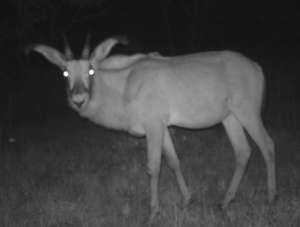
This was hugely frustrating. Unless there is some unknown reason that makes sable less dependent on Salinas in the reserve, we must accept that their population has crashed in Luando and somehow roan has coped better with poaching pressure.Best wishes,
Pedro
- Back to top of page
-
-
-
-
_______________________________________________________________________________________
-
-
-
-
-
July & August 2009
Dear friends,
Months of preparations finally culminated on the crucially needed capture operation, and the results were staggering and above expectations. A huge success! In the last couple of weeks before the operation, we made necessary improvements on the 8 km fence (delimiting the 400 hectare sanctuary) and dealt with all the red tape issues and logistics. The seasonal burnings had arrived later than in previous years, but the woodland seemed in good condition to meet our requirements – good aerial visibility with the trees mostly leafless, and the area almost cleared of grass. In the meantime we had Luis Veríssimo, based in US, monitoring the daily burnings in Cangandala and Luando through the MODIS satellite, and producing weekly maps showing the progress of burnings in both reserves. The latest trap camera shots recorded the sable/hybrid herd in mid-July, and with little surprise they were at S3C, usually their favorite salina in the dry season. Furthermore, lab results on mtDNA from dung pellets collected on a certain anhara in Luando reserve the previous month, confirmed what we suspected and hoped for: they were of Hippotragus niger variani – Giant Sable!
By the end of the month everything was ready, and the operation officially started on July 24th, with the arrival in Malanje of Barney O’Hara on his well equipped Helicopter Hughes 500, from Botswana. Pete Morkel was with us once more, as the leading vet, and had arrived a few days earlier. Later on, Jeremy Andersen and Richard Estes, also spent a few days in Cangandala to kindly assist us with their outstanding expertise on these animals. The capture operation was sponsored by a Block 15 (Sonangol as concessionary, Esso as operator, and other associated companies) grant, but a special mention is due to several people who kindly assisted with logistics on the ground such as Henriette Koning, as to the company Oceaneering and the Angolan military FAA, who facilitated the fuel acquisition and transport to the park. The operation was fully recorded on HD video for documentary, by our friend Kalunga Lima from the local producing company LS Produções, and he did obtain some really spectacular footage. And the local television TPA also kept a team on the ground for a couple of weeks and was able to obtain great informative footage that was subsequently broadcasted nationally and generated great enthusiasm.
During the three and a half weeks that the operation lasted we were based in Cangandala NP and doing morning chopper flights every day. The main objective was of course to find and capture as many of the last pure cows in Cangandala as possible, and transport them into the 400ha breeding enclosure. Secondly and more ambitiously, we wished to locate some sable in Luando and, if we’re lucky, to dart and bring a bull to Cangandala. One of the crucial preparations during the first week of the operation was, under the demanding and perfectionist supervision by Morkel, building a temporary holding pen, a sort of quarantine site where we would keep the females adjusting under close monitoring for a few days, before definitive release.
Typically, we would start flying as soon as the weather allowed, which would be between 6h30 and 8h30, depending on the morning mists, and each daily flight would last from 2 to 4 hours, sometimes with a quick stop for refueling, and often having to land to handle animals or check things on the ground. On every flight, Barney would be skillfully piloting his chopper on the front seat and I would be seating on his right and carrying the maps; Pete, being left-handed, was positioned directly behind Barney, from where he would aim and shoot to dart the animals. Occasionally a fourth passenger would seat next to Pete.
Whenever an animal was spotted and we decided he should be darted, we would keep the visual contact from a distance for a couple of minutes, while Pete would “make” is dart – basically preparing the cocktail of drugs and put them into the dart. When the dart was ready, Barney would gently lead the animal into a nearby open area (generally an “anhara”), and the next stage would be a vertiginous chase culminating with Pete darting from a few meters above the animal. The chase itself most of the times lasted less than a minute, but was always an adrenaline-full ride, showing the pilot’s amazing skills in spectacular fashion.
Once the animal was darted (and very few shots were missed by Pete), we would back-off immediately and monitor the animal from a safe distance while waiting for the drug to produce its effects. The animal would go down between 3 to 7 minutes. Then the chopper would land as close as possible, so that we could rush to the site, where the animal would be handled quickly. The standard procedure was to check the animal’s condition, remove the dart and treat the wound, check for ticks and treat the skin with insecticide, plus inject general antibiotic and de-worm medication. The teeth would be checked to estimate age, and females would be checked for any signs of breeding. The horns in bulls were measured, and on the females that were to be relocated into the sanctuary area, the horn tips were removed to avoid injuries during social interaction in the quarantine area. On the darted animals in Luando we sprayed the horn tips with red paint to make them more easily identified in subsequent flights. All the darted animals were marked with color ear brinks, and some animals were released with VHF and/or GPS/GSM tracking collars.
Handling would last just a few minutes, after which the animal was ready for the last stage: release or transport into the holding pen. The release was a very straightforward process, injecting the antidote, and literally within seconds the animal would recover fully and move off, confused but probably feeling nothing more than a mild hangover.
Translocating the animals was a different story altogether and quite an exciting exercise. The sable would be flown a few kilometers suspended by their legs 30mt below the helicopter, to a drop-off area where other participants and visitors would be waiting. Here, the animal would be landed on top of a stretcher, and then driven in the back of a pick-up truck into the quarantine area, where the antidote would be finally given. During the whole process, the animal would be drugged, blindfolded and with ears blocked with cotton, so it would be totally unaware of all the commotion surrounding.
On the first day of flights we headed towards the prime area in Cangandala, and five minutes into the flight we saw the dominant roan bull (yes, the shameless liberal bull, that has been messing around with our sable females for so long!), but after a split second hesitation, we decided not to dart him (to be castrated) just yet, thus saving his masculinity. Although we didn’t see him again, that proved to be the right decision, as a couple hundred meters ahead we headed into the main herd. The group was larger than anticipated, totaling 16-17 animals between sable cows and hybrids. We chose a hybrid female which was cleanly darted and quickly released back with a VHF tracking collar. Sticking to our main plan, the idea was to use her in a few days, to lead us to the pure females, one by one.
This hybrid was of course a well known beast; she was in fact one of the oldest hybrids and the same female that had been caught in a snare trap back in December 2007, and which we knew to had barely survived. The wound had healed by now, but the animal kept a nasty scar and her right hind leg was still clearly swollen
In any case, and over the following weeks, this poor hybrid proved to be a very competent Judas and crucial to the success of the operation, leading us every odd day to all the pure females. We identified in total 9 pure sable females in the group, and we managed to capture them all! This was a result clearly above our conservative expectations. We were quite sure there were less than 10 pure sable in Cangandala, but suspected there could be as few as 4 or 5, so finding more and getting them all was superlative. We can’t exclude completely the possibility of existing one or two more pure sable females somewhere in the park, but this seems highly unlikely. Nevertheless, the trap cameras will keep the area under surveillance, as always.
It was no surprise to learn that all the females were relatively old with estimated ages between 8 and 14 years, and the youngest cows being born in 2001.
Although being old, all the females were in excellent physical condition, healthy fat, with shiny coats and showing no ticks. This is probably result of the abnormal present circumstances in Cangandala, with low predation pressure, low levels of competition, and bizarrely low breeding rates. Only one female had a bit of an udder and had produced a calf (hybrid of course) a few months back. The remaining cows showed no sign of pregnancy either.
In spite of their relatively old age, Pete estimates that even the older females should give us at least 2-3 years of breeding before their teeth wear out to the point where she will starve to death (thus dying of old age). The early success in Cangandala set the tone for even more exciting surprises in Luando, where we focused while Judas was left undisturbed for a few days to rejoin the group.
Like in Cangandala we were right on the money, and as we flown the first time to where we had collected the giant sable dung back in June, we couldn’t believe our eyes when we saw at the edge of the anhara, the unmistakable dark silhouette – a giant sable bull! He was cleanly darted and handled on the ground, and of course it was a very special moment to grab and feel those massive and spectacular horns for the first time. It was no longer a creature of myth – it was there, bones, flesh and horns. And what a fine specimen it was!
Half an hour later and not far, we also darted an adult female. She was also apparently alone, but a full udder indicated that she had recently calved, so a small calf was probably hidden somewhere nearby. Subsequently we witnessed as the cow was joined by the calf after a few days, a week later with another female with calf, and a couple of weeks later with another female, a couple yearlings and a territorial bull. This is normal behavior in July/ August as the females have recently calved on their own, and slowly start to regroup and reestablish the social bonds. Again, in marked contrast with the situation in Cangandala, where all the females (and hybrids) were found together, during what should have been their breeding season.
In the following weeks our lucky strike continued, not only with the referred fêmeas in Cangandala, but ending up finding and darting in Luando a total of seven territorial bulls, plus one other found in a group of 7 bachelor males (bachelor herds are a classic sable social unit, formed by bulls who don’t own a territory, usually young males recently expelled from the female herd).
Not in our wildest dreams we would have expected such extraordinary results! If anything, we were just a bit surprised to find so many bulls and very few females in Luando (only the ones referred in the previous paragraph), but this was probably caused by a combination of seasonal elusive behavior due to calving, and their less conspicuous color and posture.
None of the bulls darted could be considered as a remarkable specimen but they were all good examples of the “giant sable type”. The horn lengths were somewhat disappointing, and of course it would have been nicer to dart a really big bull with 60+ inch horns but it wasn’t to be. Six of the bulls were mature with pitch-black coats, with ages estimated between 8 and 12 years, and their horn lengths ranged between 50 and 54 inches. The remaining two were young bulls and still brown-colored, a 4 year old with 43’’ horns, and a 6 year old 49 incher. They may have been pretty average for a giant sable, but still more than enough to embarrass sable from elsewhere in Africa. Going through the record book of Rowland Ward one can verify that the record trophy for a non-Angolan (non-giant) sable was a 55 incher shot in 1898, while only eight specimens ever measured over 51 inches, and none was in the past 30 years!
With the pure females being darted and translocated into the holding pen in Cangandala, the next obvious thing to do was bringing a bull from Luando. It was decided that bringing more than one bull would almost surely lead to confrontation between them which could be disastrous – better to bring one and let him focus on the pretty, even if not terribly young, cows. To bring a bull and being more than 100km away from Cangandala seemed an insurmountable problem in terms of logistics, so we resorted to the Angolan military Air Force and their participation was outstanding – very professional, competent and enthusiastic. As in other occasions when we searched for the giant sable, they were one of the key partners, and this time Genl Hanga (chief of staff of air force) even spent a few days assisting us in the field.
One bull, chosen because he was caught relatively closer to an intermediate landing site (village), had been released with a VHF transmitter, so when the time came, he was recaptured and airlifted by the Hughes 500, as was done with the females.
Then he was off-landed in the village, where a military Russian-build MI-8 was on standby. He was then loaded onto the MI-8 and flown to Cangandala, where the pick-up awaited to take the bull to the pen.
The whole exercise lasted less than two hours and went flawlessly. Catching a bull and bringing him to Cangandala was of course a major accomplishment, and understandably led to huge excitement among all the participants, including local villagers, officials and represented authorities. The national TV obtained excellent and unprecedented footage, which opened all the news reports the following day and featured in major newspapers.
The females (and bull) were being regularly introduced into the holding pen, sometimes one-a-day, or every two days but on three occasions we were able to catch two in a row on the same day. During the 9 days we had animals inside the pen, we managed to get them to drink water in good quantity in plastic water basins buried in the ground, but providing them with fresh graze and browse proved to be a much more challenging task. We struggled to gather significant amounts of fresh palatable grass every day, and the animals seemed to eat just a small portion. Not that this was unexpected, given the artificial conditions inflicted upon these until now totally wild antelopes, but forced us to release them soon after the ninth and last female had been captured. The holding pen serves various purposes. Firstly, allows us to monitor the animals to make sure they have recovered fully from the capture exercise, or identify any abnormal behavior or condition; secondly it forces them to make or reestablish crucial social bonds, reducing stress levels and allowing them to be released all together as one group; lastly is may make them a bit more used to captivity and human presence, like getting them to feed and drink on artificial containers. All this had been achieved, and from early observations it was clear that the females had accepted and naturally submitted to the male dominance, following him everywhere he went inside the pen.
One extra benefit of keeping the animals inside the holding pen, was being able to show them, in a very controlled way of course, to dozens of people who visited the park during that week, including the media. More importantly, the Minister of Environment herself Excellency Dr. Fátima Jardim made sure to be present with the Governor of Malanje Excellency Dr. Boaventura Cardoso, plus their most notable deputies.
Finally on the afternoon of the ninth day, we opened the door and left quietly. We later learned from a video camera left rolling near the pen door that the bull was the first to come out, closely followed by the females in order of hierarchy.
Over the following days the animals were radio-tracked from a safe distance, confirming that they were all together in one group including the bull. They patrolled the fence and got habituated to its presence, while they have been browsing and drinking water in good quantity everyday from plastic basins, strategically placed near the fence, and refilled daily. In the last few days of operation we went for the hybrids, but only managed to dart a second hybrid female. By then we had caused too much disturbance and the herd without the old females had completely lost the cohesion. The hybrids were now all over the place and our Judas finally did not join with other animals.
In total we darted nine pure females and two hybrids in Cangandala, plus one female and eight bulls in Luando. A totally unexpected bonus was a female pacassa (Angolan form of the forest buffalo), darted and collared in Cangandala.
Over more than 60 hours of operational flights, other wildlife seen included several herds of roan in both reserves; one herd of waterbuck in Luando; some sitatunga, reedbuck and yellow-backed duikers (surprising quite a few of these) in Luando; a lot of bushpigs in Luando, but warthogs mostly in Cangandala; a few bushbucks and hundreds of common duikers everywhere. A highlight was flying over a leopard out in the open in broad day light in Luando – a really spectacular view. Species like lechwe, and eland were not seen, but in any case they are presumed extinct as result of war. This is particularly sad in the case of red lechwe as there used to be easily seen in thousands on the Luando floodplain.
In spite of the moderate numbers of wildlife seen, we also saw plenty of poaching signs, which included dozens of snare-lines and several poaching camps, some of them active. On occasions we landed near such camps in Luando, where we would find sometimes dozens of animal’s carcasses, drying skins and smoked meat, traps and shotgun cartridge shells. In one camp we collected 170 snare traps! The remains that we could identify were of duiker, bushbuck, reedbuck, bushpig and warthog, rabbit and various birds. No traces of sable in the camps, but for obvious reasons when a sable is killed, the evidence must be eliminated. In any case the snare traps don’t make distinction among prey, and most of the natural water holes we visited were totally trapped, surrounded by trap lines, some of which using 6mt long poles, clearly design to catch large antelopes (sable or roan).
Some of the poaching in Luando seems to be well organized, and we still managed to set on fire some of those poaching camps. Although this was alarming, we have since been in close consultation with the military, and some actions are already being prepared with them to tackle this situation.
By any standards the operation was an utter success. We found, darted, handled and transported more animals than we had hoped for; there was not one single animal seen that we wanted to dart and ended up failing to; all the animals we wanted to translocate we did; there was not one single injury on people or animals to report; there is not one single decision made during those three weeks, that I regret; nothing went wrong – it was simply the perfect job! Of course that for this remarkable outcome all participants and partners contributed somehow, but notably the much impressive piloting skills of Barney O’Hara and the remarkable veterinarian expertise of Pete Morkel, they both proved to be the right people for the job – a winning team no doubt.
The funding for this operation was made possible by a grant from Block 15 (Esso – operator, Sonangol – concessionaire, and partners), although it had been prepared since 2007 and started then with a grant from TUSK Trust. We must now prepare for a new level of responsibility, as the animals in Cangandala now require a much more demanding and intense management, and the same applies to Luando. The Government is also now becoming ever more active, and we expect management structures to be appointed and deployed to both reserves soon.
Best wishes,
Pedro
Back to top of page___________________________________________________________________________________________________________
-
June 2009
Dear friends,
In June we did a couple of trips to Cangandala and one expedition to Luando. It was time to make up for the long rainy season. In both reserves the seasonal fires ignited the woodland but, especially in Cangandala, on a slower pace than in previous years, surely result of the late rains that kept the grass moister throughout May and early June.
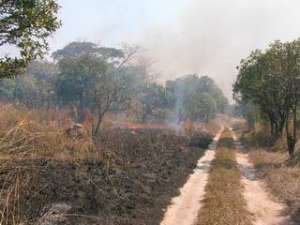
In Cangandala we just about finalized building a 2X2 Km fence that will be used as secure breeding enclosure. The idea is to capture and contain inside the fenced area the last remaining pure sable females that occur in this park and thus separating them from the intruder bulls. Of course, a pure male will have to be found and captured, to join the party. All of this will be attempted during July and August on a very ambitious capture operation that will be pioneering in Angola, and which we hope will be a landmark for rescuing the giant sable antelope from imminent extinction.The cameras in Cangandala continued producing thousands of photos, and as usual no surprises came out of it. If anything, roan seems to come more often to the salt licks, compared to sable, but this wasn’t unexpected and must reflect the differential fertility rate of these two species. Roan herds are healthier and on the increase, while the sable group is genetically polluted and struggling to survive.
Most recorded Hippotragus were well known individuals, but some photos were quite enjoyable, including lots of bushbuck and duiker shots, and quite a few roan and the usual hybrids.
Especially impressive was one of our older pure females hesitantly arriving at one salina, before allowing her two-year old hybrid offspring to join (photo below).
In mid June the new Governor of Malanje visited the park for the first time, and the cameras registered the arrival of the delegation to salina (salt lick) 2.
In spite of all the disturbance caused, the animals soon retuned to the site and a couple of weeks later we recorded there one of the old pure sable females (photo below).
I couldn’t wait to get back in Luando strict reserve, following months of isolation for most of the rainy season when the flooding kept it effectively out of our reach. A week long expedition was arranged, and we prepared to reach and explore new regions in the reserve. We wished to head further south well into the Mulundo region but also, most importantly, to reach the northern section for the first time and where a lot of anecdotal evidence promised we could find there at least one sable herd. We were in for some 300 km of off-road quad biking.
In the first couple of days we serviced the quads in Quimbango and gathered the 15 shepherds based in the central-southern areas in the reserve. The memory cards for the past few months from all the remote cameras had been brought in for download and replacement. A few new natural salt licks had been located and the cameras had been moved around accordingly. Needless to say, we had high hopes of obtaining the first sable photos from Luando, although moderate given the previous record. The season wasn’t also ideal, as the past few months coincided with the maximum vegetation growth, thus often interfering with the camera’s performance (long grass tends to trick the camera’s sensors into wasting the photos and recording mostly blanks). The fact that the cameras had to be left unsupervised for so long only made it worse.
Indeed, the 8 cameras produced thousands of blanks and little else. The exception being a few porcupine, bushbuck, bushpig photos and… more roan on three occasions.
Frustratingly the only kind of Hippotragus we keep finding is roan antelope, instead of sable. We are now forced to recognize that this can hardly be a coincidence, and a proper explanation is required. One possibility is that we have been focusing our effort in areas more suitable for roan, but this goes pretty much against the historical record; another alternative would be to consider that, at least in this region, sable need or use less the natural salt licks when compared to roan, but again and until now our comprehensive data from Cangandala has never suggested any sort of differential use of salt licks among these two species; a third explanation that we cannot ignore, is that roan may simply be a much more resilient species when subjected to hunting, and over the past twenty years they may have simply coped better with the severe poaching pressure to the point that they may now clearly outnumber sable in the reserve. If the last scenario is true, the situation can be much worse than anticipated, and the sable population may have been reduced to a few isolated and cornered pockets. A comprehensive census for the reserve is urgently needed, and we are looking into establishing an intensive survey program based on non-invasive methods (such as analyzing the mtDNA from faeces to differentiate species), but a few technical details must be resolved in the meantime.
On the other hand, exploring the northern section of the reserve gave us new renewed hopes on our quest. We met with the first time with the local shepherds, and two of them proved to be arguably our best elements. One of them, Manuel Sacaia, a young man then, used to work a cook to Richard Estes in Quimbango in 1970, before becoming a ranger. Unlike most other shepherds we have in both reserves, they seemed to be quite experienced and comfortable about differentiating roan from sable. Most importantly, they had reportedly located a large sable herd last year and had even subsequently been able to show the animals to a few other people who confirmed. This year, they still hadn’t seen the sable but were monitoring the area and recording animal’s movements based on signs and spoor. They made an early May controlled burning in the most promising anhara, and we were able to visit the site and camp there. Up to a week old Hippotragus spoor was visible around the area, and we managed to place a trap camera near a moderate-used salt lick. This will be our new focus area. Also, because the relative proximity to Cangandala may allow us to translocate a bull from here in the future, if a herd is located.
These shepherds also proved to be a valuable source of information to help us trace back the history in Luando for the past couple of decades. When in the early eighties Unita troops took control of the region that included Luando reserve, Manuel Sacaia as a Governmental ranger was arrested, but later managed to escape his captors and spent weeks in the bush and swom across the Luando river before reaching safety. Over the years he was kept well informed and returned as soon as the war ended. He described the troubling scenario that endured the war years. In spite of the Unita command giving instructions not to kill the giant sable, these were poorly enforced on the ground and had little effect. More so, the routine procedure was having the troops quarteled in camps, which would be supplied of fresh and dried meet, by professional hunters recruited from the local villages. These hunters would poach anything that moved and making little distinction among species. This quickly led to the almost complete dissapearence of hippos and lechwe on the Luando river, while eland, puku and big predators driven to extinction in the woodlands. All other antelope species’ populations plummeted, and the giant sable went in for the ride. Just like everything else, they were just meat on hooves… lets’s hope we can still revert the situation.
Best wishes,
Pedro
- .
____________________________________________________________________________________________________________
-
May 2009
VERSAO_PORTUGESE
Dear friends,A couple of trips to Cangandala in May reflected a sharp change in the landscape as the rainy season ended and abruptly gave way to the dry season “cacimbo”. In the first week of May we still experienced one last stubborn sower and the park was hot, lush and humid. Most of the time we had to battle our way through overgown thick grass, and occasionally overcome wooden bridges in disrepair. In contrast at the end of May, the grass and land had dried throughout and the first smoke columns indicating the seasonal bush fires were visible in the distance, cloudening the afternoon skies.
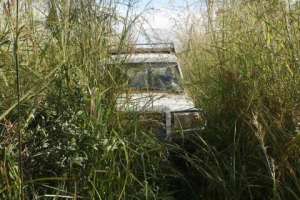
As the remote cameras had been left unattended for more than two months, we had plenty of photos to process and interpret. Even considering the less than optimal conditions between February and April (the fast growing grass, which especially in windy days, tends to interfere with the remote movement sensors, triggering the cameras and producing hundreds of “blank” photos), we still obtained a few hundred photos of Hippotragus in eight independent events from six different salt licks.We feel the situation in Cangandala is so well understood by now, that we expected no surprises, and sure enough we obtained none. The four trap cameras located in the core area gave us four events with the “main” group, showing pure adult females and hybrids; and two events with roan antelopes, reinforcing the presence of these newcomers as they seem to be taking over the last stronghold of the giant sable in Cangandala.
A closer look at the photographic record allows us to identify 7 hybrid individuals and to count 4 pure females. This probably amounts to ¾ of the total sable/hybrid population in Cangandala NP these days! The younger animal being the hybrid yearling born in August ’08. In sad contrast the roan group mostly showed calves and young animals, reflecting a healthy growing herd.
The two trap cameras placed at marginal areas (where we keep an increasingly smaller hope of finding one day stray pure sables), gave us roan in both sites.
The rest was the usual bushbuck, duiker, warthog and porcupine sequences.
Later we received in the park two new quad bikes donated by GTZ , and the fencing material finally arrived imported from Namibia, and was inspected on site. We will now focus on getting the 2X2km sanctuary (fenced enclosure) built over the next couple of months, and before we start with the capture operation schedule for the end of July. The fence was arranged by the Ministry of Environment and the capture operation is being mainly sponspored by the Block 15 (Sonangol, Esso and oil exploration partners).
Best wishes,
Pedro
Back to top of page————————————————————————————————————————————
-
March/April 2009
VERSAO_PORTUGUESE
Dear friends,- Following a hesitant beginning, the rainy season this year continued on a crescendo and ended up in style, at least in Malanje province. So much so, that during March and April it became impossible to reach Cangandala NP with a 4×4 vehicle. Although the region has an average rainfall of around 1,400 mm, it tends to be relatively well absorbed by the dominant sandy soils. The tends to be negotiating the rivers and floodplains, especially in wet years such as 2009. As result, and for the first time in the last five years, we simply couldn’t cross the overflooded Maúbe River.I suppose this will allow production of good and abundant grass later on, and availability of water for a longer period than usual, so animals will be satisfied. Still, it was a bit disappointing for us, not being able to get in the park, not to mention that for the capture operation scheduled for dry season we would prefer to have the animals concentrated in a small area, rather than dispersed over several good grazing sites. In the end of the day it’s just another variable we’ll have to manage.If Cangandala was off limits, one could well imagine the situation in Luando Reserve to be much worse. Indeed people coming from the later area reported that the Luando floodplain was totally inundated across a stretch of nearly 5km at our main crossing site, where the villagers took now several hours on a rudimentary canoe to reach the other margin! Even our barge had now disappeared under the water.Even so, we were able to collect from the local administrator of Quimbango, all the memory cards in use on the trap cameras since December. We have 7 cameras mounted in salt licks, scattered over more than 100 km of woodland, and the shepherds had been instructed to check the batteries and replace the memory cards regularly. The first disappointment was realizing that the external batteries had failed to perform, having lasted on average 2 months operational, when we were expecting 4 months. Comparing with the 45 days we get with commercial type C alkaline batteries, that’s not much of an improvement. And for now we decided to revert back to alkalines, and enough of these were sent to the reserve.We had high hopes about getting our first sable photos in Luando, but no, it wouldn’t be that easy, not with the giant sable… this mysterious creature seems to be always more elusive than expected, as if teasing us all… so it wasn’t this time, but we’ll get them sooner or later! The really annoying result was that, while not finding the sable, once again we did obtain photos of their cousins the roan antelope. Photos revealed two new groups of roan, quite far apart from each other and from the first roan site we had found in December. One sequence gave us some nice close-up shots of a lactating female, evident from the pink swollen nipples.
The second sequence allowed us to distinguish at least four young animals, including two female calves, one yearling female and one young male nearing 2-years old.
I must say that the third consecutive and independent record of roan against zero sable, is disturbing and not expected. It has always been assumed that the sable population in Luando, if anything, should be larger than roan… Of course, a sample of 3 is ridiculously small for us to draw any conclusions, but again, one can’t help wondering if we’re just being unlucky or what? Over the next few months we will definitely gather a lot more information on this.
As for the rest, at least we obtained quite a few interesting and sometimes not expected sequences of other animals, including some species we had not yet photographed. We had some of the regular customers such as warthogs (an impressive male) and a common duiker (one female was recorded on a funny sequence when she climbed on top of the termite mound and then hesitated for a while before getting down again).
Also some porcupine and a group of vervet monkeys which in some photos were clearly seen eating the soil directly from the mound (this was the first time we saw evidence that the monkeys also feed on these salt licks).
On the more forested salina, we failed again in getting photos of forest buffalo, but we did get lots of bushpig …
… and, for the first time, of yellow-backed duiker. This elusive creature, a huge forest duiker the size of a bushbuck, is seldom seen, much less photographed so we were excited about recording it.
One sequence even showed a mother visiting the site with a very young calf (bottom right in photo).
Also worth mentioning some unexpected sequences and visitors such as groups of fruit bats eating soil at the mound walls. We had photographed bats before at the Salinas, but had never “caught them in the act”.
Also interesting was recording occasional flocks of birds, mainly seed-eaters such as these yellow-fronted canaries, and they kept perching on the termite wall, an indication that they should be eating soil just as everyone else.
The surprise newcomer was a slender mongoose, although he most likely must have been stalking a prey or just exploring. Still, this was our first predator! Maybe not the most impressive or the largest of carnivores, but definitely one of the most successful and bravest of our predator fauna.
The following few months will be busy and may also be decisive for the future of our conservation efforts.
Best wishes,
Pedro
Back to top of page______________________________________________________________________________________________________
-
February 2009
VERSAO_PORTUGUESE
Dear friends,
As the wet season approached the zenith, the storms become more frequent and intense. The generous rains made several rivers and streams to over flood and of course our movements in the park are now more restricted.
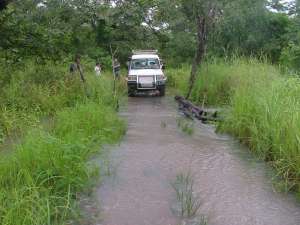
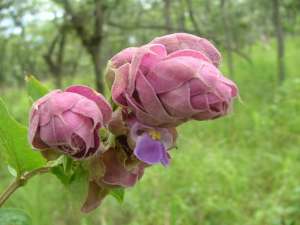
A blooming flower nourished by the rains

A protea plant
With limited access to extensive areas of the park, we had not only to focus on monitoring the trap cameras but also prepare for the dry season and the important activities we are scheduling.
As we are planning to erect a fenced sanctuary in Cangandala, so we took the necessary time to study the design and details of the fence, and walk the full perimeter.
Although we had now a couple new Salinas trapped with digital cameras, we didn’t expect anything new, or at least no new pure sables. Over the past months we have grown skeptical about the prospect of finding new sables in Cangandala, and the camera record once more were pretty much in line with our modest expectations.
Of course we got the usual customers such as porcupines, warthogs, bushbucks and duikers. The only novelty being a one-eye-blind common duiker sharing a salt lick with a male bushbuck. We already had a bushbuck female with a blind left eye, and now we also have a duiker with a blind right eye. This sort of occurrence seems to be more frequent than we would ever expect…
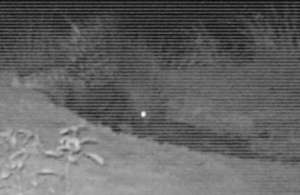
Porcupine photographed on the stealth-cam
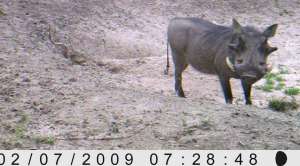
Warthog
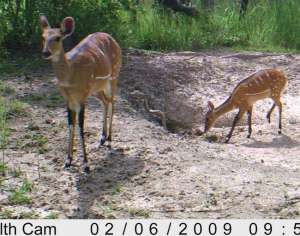
Bushbuck mother and calf
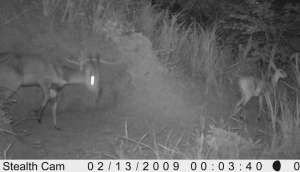
Male bushbuck and a blind duiker
We obtained no photos of roan this time, but we did get on five independent events, sequences partially showing our remnant groups of sable cows and hybrid offspring, including some occasions in which adult female hybrids or pure sable came isolated to feed on the natural salt lick. In total, only two pure sable and five hybrids were recorded and identified. Once again, just a tiny sample of well known individuals, and yet the hybrid/pure ratio is anything but encouraging.
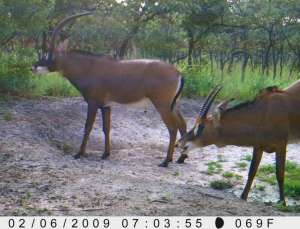
A pair of hybrids
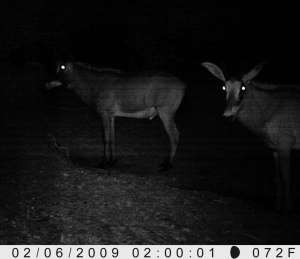
Hybrid pair at night

Pure female sable
The older of two hybrid males born in 2005, at the age of 3.5 years old is turning into an impressive bull even if from a freakish genealogy and probably being sterile.
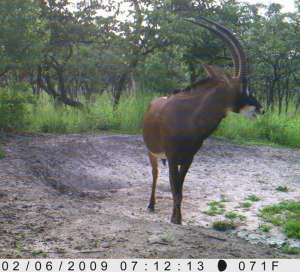
Hybrid bull
Much more rewarding was observing a remarkable sequence of a pure female that couldn’t resist being as curious as to inspect the camera at close range. She ended up sniffing and looking right into the lens for a while, who knows if puzzled by its own reflection? I guess one could be tempted to wonder instead if she wasn’t trying to look us in the eye on her desperate plight for this population’s survival – Hello, Is There Anybody Out There?

A pure female comes in for a close-up
As result we obtained what may well stand as the ultimate close-up photographs ever taken of a sable antelope in the wild! Again, the giant sable story proves to be fertile in irony… just as the pure sable population dwindles dangerously in Cangandala, becoming more elusive and mysterious than ever and yet we get one of the last pure female, extreme full frame, and at closer distance than any other animal else we’ve seen…
As for the rest the situation has remained calm in the park, without new poaching incidents.
Best wishes,Pedro
Back to top of page____________________________________________________________________________________
-
January 2009
Dear friends,
A new year brings new hope.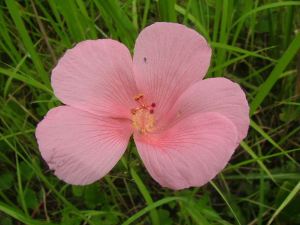
Spring arrives in Candangala.
The rains in December and early January were generous and the park presented itself in lush green colors. The rain demanded the most of our 4x4s and driving skills, but we couldn’t avoid getting stuck once and a while. Traditionally the end of the year is the most sensitive time regarding poaching, as the demand for bush meat increases during the festivities of Christmas and New Year. However and maybe as result of the poaching incident that involved the Police in November, the situation remained calm, particularly in the core area of the park.
As for the animal populations present, we have them better monitored than ever before. We now have seven digital trap cameras operational and have extended the network to a few Salinas recently discovered which are proving to be excellent sites. With more than 5,000 new photos, we had plenty of information to digest.
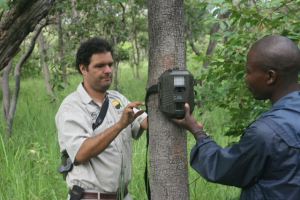
Pedro and a shepherd with a digital trap camera.
A significant part of the photographic record showed reliable customers such as bushbucks (including “old friends” like the one-eye-blind female), duikers (including the one that carries a severe skin disease) and of course the warthogs.

The park’s ‘one-eye-blind’ bushbuck.
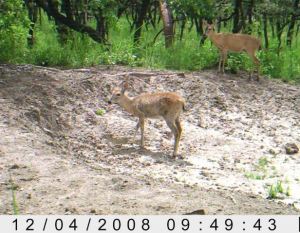
Duikers, one with skin disease.
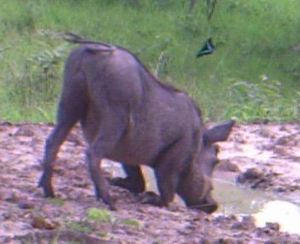
Beauty and the beast…
As for the giant sable population in Cangandala, the situation seems to show no improvement what so ever, but it is not at all surprising giving the recent trends. We counted 3 pure sables in three different occasions, all of them adult females as expected.

Pure female sables.
One female was accompanied by the youngest hybrid calf- until proven otherwise the only calf born in 2008.
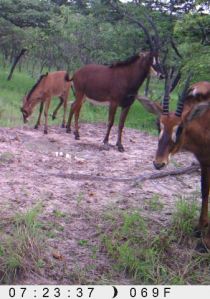
Pure female stands beside her hybrid calf.
The hybrids are all well identified, and we recorded seven individuals in total, including the five youngest – two males born in 2006, two females born in 2007 and the calf – and two adult hybrid females, apparently now isolated. Even with such a small sample, getting a 1:2 ratio in terms of pure sable/ hybrids is depressing.
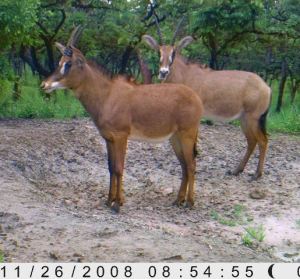
Young hybrid females.
As the sable population struggles, ironically, the roan population seems now to be exploding. Until now we knew of a few isolated individuals. Initially we had a young female and an adventurous bull mating with the sable; more recently a few more individuals, male and female appeared, but irregularly and still isolated. But this time, and apart from the isolated individuals, we got one full herd of roan. Contrasting sharply with the sable herd, this herd seems to be a very healthy group, with a mature bull, several adult females, several yearlings and three young calves. These animals must have originated from neighboring areas adjacent to the park and may be filling in the void left by the sable absence, while benefiting from the protection we are providing in the core area.
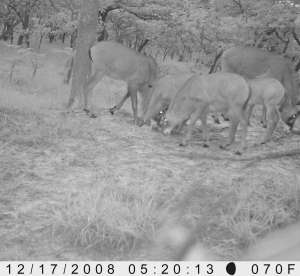
Roan herd including calves.
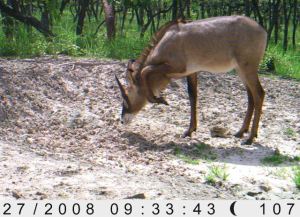
A young female roan.
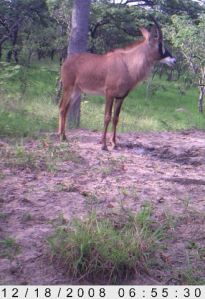
Young roan male.
What a disappointing trend: we started off with a few sable and almost no roan, and we are now in the process of having the later totally replacing the former in Cangandala. It’s as if the first roan bull acted as the Trojan Horse, introduced in the vital area of the sable where it replaced the sable bull, and via his poisoned love he totally contaminated the sable herd which was left sterile and helpless, so the time was now finally ripe for his original roan family to move in and take over the territory!
Best wishes,
Pedro
Back to top of page________________________________________________________________________________________________
-
December 2008
Dear friends,
Before the end of 2008 we had to go back to Luando Reserve. As the rainy season progresses the access routes become more precarious, and soon the region will be off limits for a conventional (on the ground) approach. I took Miguel Gullander, Bebeca and the three Luando shepherds who had just finished a training program organized by GTZ in Kissama National Park. As in previous times, we camped the first night near the broken bridge at Luando River, where we left the Land Cruiser.
The region had witnessed little rain the previous week, but the Luando River was already rising noticeably, and the current was steadily picking up speed, compared with our last visit. Our barge was still operational, although the main rope linking the margins was half submerged under the river’s murky waters. We loaded the barge with most of our gear including all the hi-tech gadgets, and I jumped in with Miguel and Nicolau, the shepherd from Camitungo. We clearly underestimated the current force and the fact that the rope was blocked by wooden debris in mid-river. We also forgot to tie in a back-up security rope, and the combination of these factors resulted in us momentarily losing grip with the main rope, and being left helplessly drifting down river while hoping to keep our precious cargo aboard and dry! Not the start we hoped for… We then used our hands and a machete (of all things) to slowly paddle our way until reaching the other margin 300 meters down.
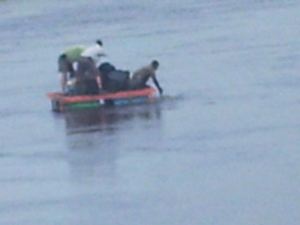
Drifting down the river by barge
The exercise slowed us down a few hours, but in the end no harm was done and eventually we carried on as planned. We then crossed the Luando floodplain and grabbed the two diesel quad bikes at Capunda. Our three shepherds based at Capunda gave us very vague information about animal movements in the area, and still hadn’t located Salinas, so we decided to move on southwards.Resulting from a few consecutive rainless days over these well drained soils, riding the bikes was easier than expected, especially considering this was December. This allowed for quick progress, but I confess I felt a bit disappointed. No waterlogged valleys, no muddy sections, no need for serious 4×4 skills, no adrenaline punch… I wonder when we’ll be able to really test these machines?!
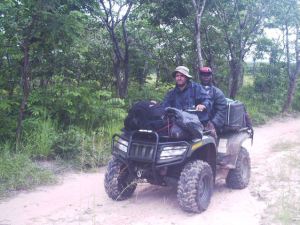
Quad riding
When we got to Quimbango we recovered the Yamaha quad after repairing the flat tire, but ended up leaving behind one of the diesel Arctic Cat with a clogged fuel filter… I suspect someone adulterated one of our diesel drums… we’ll service it next time.
We set our base camp at Quimbango River as planned, enjoying a nice river swim every day in the evening, and being spoiled by “Dona São” who cooked dinner for us every night at the Administrator’s place!

Miguel Gullander, Dona São and Bebeca
Over the following days we explored the area with our shepherds, riding a total of 300km with quads and tracking a bit on foot as well. We replaced memory cards and visited new Salinas. We also brought in three new digital trap cameras and external 12V batteries to supply power in a more efficient fashion. Hopefully these external batteries will last for at least 4 months, thus relieving us from the burden of having to replace internal batteries every month. This may be especially relevant now that we likely won’t be able to access the reserve until June. Having the shepherds to just replace memory cards every 45 days makes it for a much easier task.
We had high hopes about the four cameras we had left in the reserve, placed more than 20km apart from each other. I was hoping to get sable photographs, and maybe, just maybe, our first giant sable bull photo… but again, these beasts proved to be a lot harder to get! One of the cameras didn’t perform well for some reason and filled the memory with false events; a second camera gave us photos of duiker, warthogs, birds, and even a mongoose, but no larger customers; the third camera recorded duikers and (a first timer) a family of bush pigs.

Common duiker

Bush pig family
The remaining camera was the one we kept higher expectations as the shepherds insisted there had been a sable herd feeding on the spot… but the result was… roan antelope?! Some of the photos were very nice and included an impressive bull but it was a huge disappointment! It proved we all (shepherds included) can be mistaking roan tracks for sable, which also means that the sable population in Luando can be smaller than we predicted earlier when assuming most tracks were sable and roan was scarce in the reserve.
On a new site we visited to mount a new camera, on a salina at the edge of a large anhara, we were shown plenty of spoor and tracks, allegedly from sable, but a closer look convinced me otherwise… given the size and shape I’m pretty sure it’s also roan spoor. The shepherds weren’t convinced so we made a bet – next time we’ll check the photographic record and see who wins. They also showed us a poaching camp that the shepherds had recently dismantled a couple of weeks earlier, and it was interesting to discover that the roan (sable?) herd had subsequently been visiting regularly the abandoned camping site.
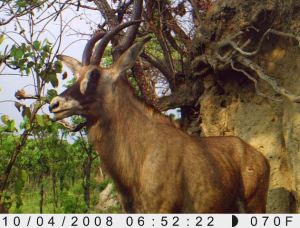
Roan bull antelope
We were back at square one in the reserve, but I guess it’s just a matter of persistence until we hit the right spot. We may have been extremely unlucky, but most likely this may indicate that the sable have become more elusive than roan, or maybe it is more vulnerable to poaching? And it might be a combination of factors…
It was hard to say goodbye to this magnificent piece of territory, knowing that it will be out of reach for the next six months… Although the weather remained surprisingly benign during our stay, with only a couple of showers recorded, on our return we were emphatically reminded of just how misleading this drainage can be during the rainy season. When tracking on foot back to the car site we found the floodplain beginning to fill with water over flooding from the Luando River.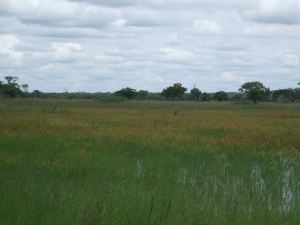
Luando flooding
Our last two kilometers were done walking on water, over muddy ground and sometimes with the water line reaching our waist, while we desperately tried to keep our belongings dry (I must confess that I performed quite poorly in this regard). In January this region will be filled with water five kilometers across and 200 kilometers long, making the Luando River one of the most spectacular wetlands in Africa !
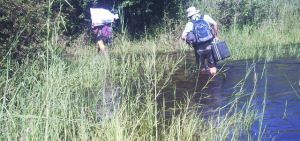
Tracking through the water
-
- Back in the car we were shocked to realize that the car had been broken in, as someone had smashed a back window and took some of our gear, a mattress, sleeping bag, clothes and a cooler box with food. We informed the police at the village of Rimba who were very professional and eager to help. Bebeca suspected of an unfamiliar face he has seen on the first day near the river, and on our way back from Rimba he actually recognized the character and detained him, while the burglar was naively carrying my swiss knife stolen from the car! He soon confessed and we recovered most of the goods with the help of the police and Administrator. If it wasn’t for the broken window it would have made for a funny episode!Enjoy Xmas and all the best for the new coming year!Pedro
- ——————————————————————————————————————————————
November 2008
Dear friends,
November was time for another attempt to capture the first sable and mark it with a GPS collar. Once again we had Peter Morkel with us to be in charge of all the necessary veterinary procedures. Jeremy Andersen also joined for the trip and assisted on evaluating the park’s needs in terms of management and future fencing. Nito Rocha and Miguel Gullander completed the group. We stayed for 10 days in Cangandala Park, over which we did all in our power to dart the first sable. The rains had been generous so far, allowing the annual resurgence of mushrooms and the first few days were quite wet and muddy, but in the last few days the rain stopped completely and the land quickly dried out. It was still possible for us to drive throughout the park, but just.

Mushroom season has arrived!

In spite of our effort, and Pete’s effort in particular, once again the sable proved to be too elusive and unpredictable and we failed once more. After all, these animals are the last surviving individuals of a cornered breed, subjected to long years of intense and ruthless poaching. The first few days were consumed locating the sable/hybrid herd, sending a couple of shepherd teams on different directions. Once this was achieved, we then spent 6 consecutive days tracking down the herd, always following more or less fresh spoor. Every morning we would pick up the spoor from the previous day and track all day long, sometimes but not necessarily interrupted by a quick brunch break. Every day the main tracking team would be the “assault team”, composed by Pete Morkel and two of our best shepherd trackers.
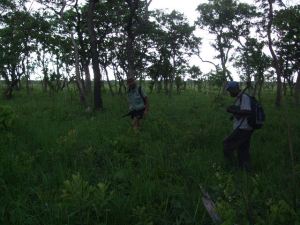
Tracking spoor in the early morning
The support team would be me, Miguel and a couple more shepherds. The support team joined for a few full trails, but often we stayed behind to make sure the car would be deployed to a more convenient location at the end of the journey. Communications were ensured with satellite phones, and we also assessed their location through the VHF collar. The plan was to make sure that every time we got within very fresh spoor, only Pete and one of the trackers would continue. At one stage we also tried to play back a sable calf distress call taped in South Africa, but we ended up giving up on this as we weren’t sure if we were arousing the animal’s curiosity or simply alerting them… this can be an interesting tool and certainly requires some more trials.
The average daily tracking would be more 20km, usually following a very tortuous line of progress, often zig-zagging and even forcing us to cross our own earlier path and in one occasion making an almost perfect “8”. The fact that the herd was moving so much, in such an unpredictable fashion allied to frustrating ever-changing winds, made the final approach to the animals almost impossible without alerting them to our presence. The best chance possibly came on our first day of serious tracking when in the heat of the day we got quite close to their resting spot in the shade. We had been tracking for a few hours, and although we knew we were getting closer, still we underestimated just how close we were. When the shepherds saw the animals resting, it all happened to quickly, and while Pete tried the approach, hidden behind termite mounds, a sudden twist on the wind direction blew us the whistle, and the herd was gone in seconds. On the first two days of tracking the herd, the occasional rains kept the soil moist and following the spoor was relatively easier. As the tracking progressed without rain, it became harder to read the signs and the animals started moving greater distances, making us struggle to catch up with the daily movements. As result of this, Pete saw the animals on four occasions on the first two days of tracking, but not since, and never got within darting distance (70 meters). I had a glimpse of the herd on day 1, but an unexpected encounter was reserved for day 4.
On the fourth day of trail-tracking, after a quick lunch break we left the assault team to resume the tracking, and decided to move the LandCruisers to a different location. We then parked the car on the edge of an anhara as it seemed to be a nice spot to wait for a while and keep track of the guys. Well, soon after we got out of the cars we had the sable group, 5 to 6 animals, running from us not more than 100 mt away among the trees. The horns and general shape were clearly distinguishable and at least the last two seemed to me to be pure adult females. It wasn’t a first sighting for me or Bebeca and much less for the shepherds, but Miguel could barely believe his eyes… as by that stage he had interiorized that his chances of actually seeing a giant sable on his first trip were little more than zero! Jeremy wasn’t as lucky as he was too slow to come around his side of the LandCruiser, and Nito had already left to Luanda on the previous day – he’s been in Cangandala more than a handful of times and still he hasn’t seen one sable!
We later determined that the herd must have been calmly watching us as we drove passed the group at less than 40mt, and they only decided to flee when we stopped and got out of the vehicles!
If anything, this operation taught us a lot about the sable behavior in Cangandala, and it became evident that they move quite a lot throughout their home range (the area used by the herd). We were not only able to confirm their assumed home range but actually extended it slightly on the southwestern boundary. In total the sable herd seems to roam over an area of about 10.000 hectares. Somewhat surprising was to verify that at least some of the animals moved around the whole territory in less than one week.
Analyzing the trap-camera record we also discovered that on the third day of tracking, the herd split in two subgroups, and while we followed one, the second subgroup took a different route and ended up showing at Salina 3C – less than 24 hours since we had returned there to check if any sable were present!

Herd at Salina 3C
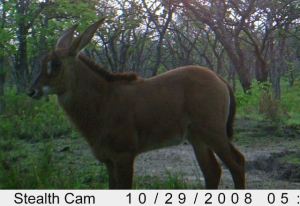
Hybrid calf
This subgroup included most of the hybrids and our youngest member – a young hybrid calf born earlier this year around August. She hadn’t been picked up before because she was probably too young to be with the herd. This was neither unexpected nor good news.
The salinas produced hundreds of good quality photos, particularly of the sable/hybrid herd.
In total we can clearly identify ten animals, six of them being hybrids, and only four pure adult female sables. As for other species, we obtained photos of roans and also of a nice waterbuck herd including an impressive looking bull. The rest included the usual customers, like bushbucks, warthogs, duiker and porcupine.
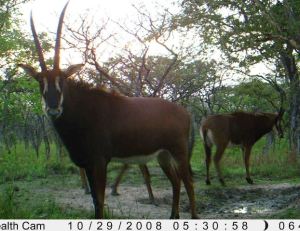
Pure adult female Giant Sables
Another positive result of our intense tracking was finding 7 (!) new salt licks, this way confirming that there must be dozens of undiscovered salinas in the park. A couple of cameras were moved to new salinas.
Before we left the park some very disturbing news came to our knowledge, as the word quickly spread through the local villagers. While we were in the park, a couple of poachers entered the north of the park near Culamagia (as usual the most severely impacted area by the poachers), and somehow mistaking him for an antelope , one of the poachers managed to shoot his partner with a Mouser rifle! The unfortunate poacher had to be transported to the Hospital at Cangandala town, and was later transferred to Malanje given the severity of his wound (the bullet entered his back and ended up on his thigh. This could not be ignored and the shooter was immediately arrested (more for having shot someone than for poaching inside the park I’m afraid).
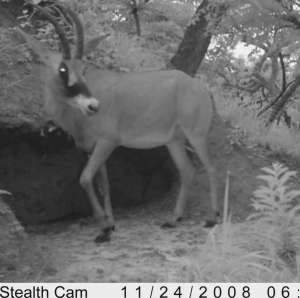
Roan antelope
However, this story became even spicier, as the shepherds inquired and Bebeca could later confirm interviewing the injured poacher. It turns out that it was the police chief of Culamagia who supplied first an AK-47 for the poachers to collect some fresh meat in the park.
Apparently the weapon wasn’t performing well,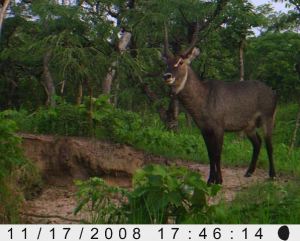
so the poachers eventually got back to the police chief and then swapped the gun for a mouser rifle. This situation is even more serious considering that these weapons have been recently confiscated from locals, on a laudable effort, still ongoing, conduced by the authorities to collect weaponry held by civilians throughout the country.
Last I heard from Malanje the police chief had a bike accident and later was missing… I hope that an example can be made out of this incident, but still fear this can be hushed.
Best wishes,
Pedro
Back to top of page————————————————————————————————————————————-
-
-
October 2008
Dear Friends,
In October we did only a short trip to Cangandala National Park. It was mostly a routine visit to monitor the cameras and supervise the shepherd’s work, in preparation for the next couple of months when we expect to increase our field activities. The rain had intensified as expected but the weather remained mercifully dry during our stay. However the roads had become muddy and even before entering the park we had to rescue a 4×4 belonging to the company building the communications tower. Small ponds could be found easily, particularly on the “Salinas”.Arriving in the park, different sort of news awaited us. Firstly, we were delighted to see that the 40 meter physical structure for the communications tower was now finalized.
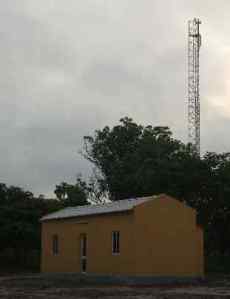
It was now only waiting for the technical teams to install the solar panels and repeater to distribute the UNITEL cell signal over most of the park. This will allow us to keep track on the animal’s movements by satellite, once we succeed in capturing and collaring the first sables. Moreover, we will be able to install a VHF repeater to ensure radio communications within the whole park. This will surely boost the ranger’s moral and their efficiency on anti-poaching operations!
However our good mood wouldn’t last long, as the shepherds reported a disturbing poaching incident on the previous week. While on patrol in the northwest region of the park (usually the area more exposed to poachers and where sable and roan have already been wiped out completely), the shepherds came across three poachers. One was imitating the call of a baby antelope and the other two were on standby armed with AK-47’s. When discovered, a short pursuit followed and several shots were made from both sides. Eventually the poachers managed to escape, but not before one had stumbled and left behind his weapon that was therefore retrieved.
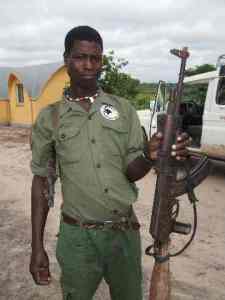
A closer look revealed that the gun was hit twice; one shot perforated the magazine and the other split the wooden handle. It is unlikely that the poacher might have escaped unharmed, and confirming this assumption a few drops of blood were found on the handcrafted wooden stock. We knew that one day this sort of fighting could happen, and fortunately it was the poacher to get hit. Hopefully this incident will send a strong message that the giant sable shepherd’s mean business!
A few days earlier and on a routine operation not far from “salina one” (S1,) the shepherds came across the skull and bone remains of a sable. As evidence the shepherds brought back the skull, still with one horn attached.

Looking at the skull, horn size and structure, one can tell the unfortunate animal was a mature giant sable female. The teeth were well worn (see photo at end of paragraph) but this individual should have been at its prime, still under ten years of age. It is not easy to determine when it died and for how long it has been there. My first impulse was to give it 1-2 years, but often I’ve been surprised with how fast the decomposing process takes place in this region, possibly resulting from the generous rains. For example, when a jackal died near S8 last year, in three months all the bones had vanished (except for the skull that I had already retrieved). Interestingly, we had recorded vultures soaring over this region back in March, so this could be more than a coincidence. We’ll get more details next month, when we intend to perform a sort of CSI on site. Until then, there is nothing we can say about the likely cause of death…
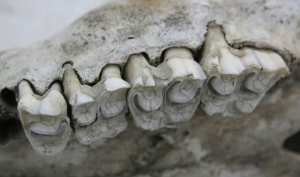
The trap cameras record this month was very disappointing, but also reserved a new surprise. At S2 and for the first time in many months, there were no records of sables, just the usual bushbucks and duikers and warthogs.
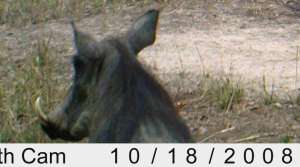
At S4B, as in the previous month we recorded the visit of the three roan calves and once again without showing the adults.
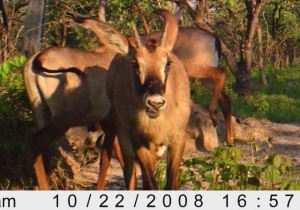
Finally at S3C we also didn’t get any sable or even hybrids. The first to be recorded was our well known territorial roan bull.
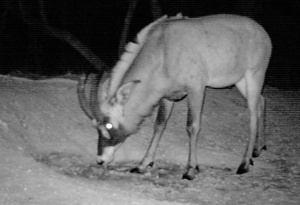
But then quite unexpectedly we obtained two sequences of a small roan group! It included one mature female and three calves, being one of very tender age.

These animals had never been recorded before and we suspect they may be newcomers, having moved in recently from a neighboring area. At least having roan females present should keep the territorial roan bull more focused in its own kind, and less prone to mess around with our sable females…

Next month we’ll have another attempt at capturing the first sable in Cangandala. Time is running short, and we need to start tackling the hybrid crisis as soon s possible. Hopefully, we’ll have better luck this time.
Cheers,
Pedro
Back to top of page__________________________________________________________________________________________________
-
September 2008
Dear friends,
In September we were able to visit both Cangandala and Luando. Eddy Brock came with me and this time Bebeca couldn’t join us as went instead to Mozambique for a training program. Three shepherds from Cangandala were also sent for training in Kissama NP.
Cangandala National Park
The park had just been exposed to the first seasonal rains when we arrived. This didn’t bother us and in fact was a pleasure to witness the ecosystem awakening to the new spring. The trees were now mostly covered with fresh leaves; the soil was soft and aromatic; the flowers and insects were omnipresent.This is arguably the most enjoyable time of the year to spend time in the bush in the region. Remarkably, this time we saw close to 20 duikers, many more than we use to, which was very promising. The smaller antelope populations really seem to be recovering well and there is no doubt we see more of these today in Cangandala, compared to a few years back. Too bad we can’t say the same about the giant sable…
The visit to Cangandala was mostly to monitor the cameras. The shepherds had seen the sable herd a couple of times on routine patrols, but nothing unexpected was recorded. The cameras worked very well, recording a few more thousands of wildlife photos. S2, as always, recorded hundreds of bushbuck sequences and a few more of duiker and warthog.As it is also customary, the main sable herd visited the site, although they did it only once and between 01h30 and 02h30, definitely not the best time for quality photos. In spite of the late time and dark night, the fact that we had placed a second camera at S2 shooting at close range, allowed for some interesting and useful close ups. Nothing exciting or surprising was recorded, as all the individuals are well known by now. I can distinguish four to five pure adult females and five hybrids, including our four youngest animals, two males born in 2006 and two females in 2007.
Apparently confirming our suspicions, there seems to be no calves born this year. Also no sign of any of our young pure males born in 2005 (not that we expected of course, given the zero breeding rate at the moment), and no territorial bull – there must be one somewhere keeping young males adrift, and most likely will be a sterile hybrid bull… The young hybrid male born in January 2006, is approaching 3 years old and starting to look impressive, so it shouldn’t take much longer for him to be kicked out of the area. After all, the pure males were expelled in 2007 short after completing two years of age.
S3C gave us a full 2GB memory card, totaling about 2,000 photos of game. The usual numbers of duiker and bushbuck photos, some during the day but most at night. Quite interesting was observing the constant presence for a few weeks of a pennant-winged nightjar, who would stubbornly perch on the same spot on the ground, while watching the ungulates feed on the soil. This led to some funny sequences, like a female grey duiker curious about that odd-looking bird.
Two days after they had been at S2, our polluted herd visited S3C, and the animals were once more photographed, only this time mostly the young hybrids and one adult pure female. The other pure adult females must have kept themselves nearby. But the big surprise was a new addition to our mess: a young solitary male pure roan! Another roan, not exactly what we need at this point… but not entirely unexpected, if we consider the dynamics in the park. He appears to be a two year old, right at the age when young males get evicted from respective herds and he really seemed to be a new kid on the block. He came across the salt lick on August 29th, and over the period of 2 weeks he returned to the spot 5 times, both day and night.
All our Hippotragus individuals typically spread over their territories, rotating regularly on a number of salt licks and making their presence on a given site quite unpredictable. From our records sable or roan have never visited even the most “attractive” salt licks, more than twice over the period of one month. So, this roan is probably a newcomer who happened to find the lick and is keeping himself close by, unaware of alternative sites. S3C is well inside the territory of the old hybrid bull (the one who has fostered the hybrids), so it will be interesting to note for how much longer this young contender will be tolerated.
The cameras near Cuque River , where we were hoping for some waterbuck, produced no results, but the southern camera at S4B gave us more to play with, and to worry about. At this site, we have long ago given up on the illusion of finding sable, so I expected some waterbuck and maybe roan shots. The waterbuck didn’t show, but the roan did. The roan herd visited the site twice and therefore we obtained a couple of sequences, one of them in broad day light. Interesting was that in both occasions only three young calves approached the site to feed. The adults must have been observing nearby, giving full priority to their latest offspring. It is our conviction that it’s this healthy roan herd, the origin of the roan males who once and a while show up near the sable group, 20km further north.A much more worrying photographic sequence was recorded soon after the first herd’s visit: a poacher! The herd had come deep in the night of September 3rd, and on the following morning, this poacher appeared. He entered the salt lick cautiously spent some time interpreting the signs. He almost surely got there following the spoor and fresh trail left by the roan herd. He was carrying an axe, a spear and some ropes. He was probably considering putting a snare trap on the salt lick, when he realized the presence of our camera. He must have reconsidered, and after looking carefully into the lens, he moved away suspiciously.
Looking on the bright side of the encounter, at least he wasn’t carrying an AK-47, and he didn’t smash the camera, but this just brings to light how much we still have to do in order to bring safety to these remarkable creatures. And no wonder why the animals so often seem to be hesitant about entering and using the salt licks – the place might be trapped!
Luando Strict Reserve
I was looking forward for another Luando expedition and it fully met our expectations. As planned, we left the LandCruiser near the Luando River where we camped the first night.The following morning we crossed the river on the still operational barge, carrying or basic equipment and food for a week. We hired three locals to help us carry our bags and boxes and headed to Capunda, an 8km walk, crossing the huge Luando floodplain and ending uphill. In Capunda we mounted the quad bikes and headed south.
The rains still hadn’t started in Luando, the woodland looked marvelous and our progress on those beautiful roads was fairly easy. We were recognized in all villages and people felt encouraged with the ongoing program. We were approached by lots of candidates to become shepherds, and we had to manage this enthusiasm cautiously, to avoid raising too much the expectations. On one of the first villages we stopped, we rescued a baby greater galago (Otolemur crassicaudatus) who was about to be cooked for supper (his twin brother already had been eaten). We brought him along for company and managed to keep him alive feeding him powder milk.
Once in Quimbango we met with some of the shepherds, and we very happy to learn that not only had they been busy for the past few weeks, but they had indeed found lots of spoor and located 8 natural salt licks! Quite an improvement when back in July they didn’t know of any salt lick in the region, in spite of my frustrated attempts to explain what they were and how they should look like. So much so, that I had left Luando in July, considering the possibility that sable in Luando simply didn’t recur to special places to eat soil. The shepherds were motivated, and this produced wonders. Also we recruited 6 new shepherds, totaling now 15 in Luando. What we saw in the reserve this time left me much more optimistic than before. Extensive areas where locals had claimed there were no sables left, now after being patrolled by our shepherds (or in certain cases by candidates to become a shepherd!) it turned out there was spoor and frequent signs of sable. Of course we still can’t prove we’re dealing with sable, as we can be misinterpreting roan tracks, but it is promising. Roan was always considered less common than sable in Luando, unlike Cangandala where they occurred in similar numbers. The shepherds defend that roan and waterbuck are currently rare in the reserve and confined to other areas where we are not exploring at this point, so we should mostly get sable results. We want to believe this of course, but we must remain cautious, given the Cangandala experience…
The camera we had left near a water hole produced no results because the vegetation close by undulating under the wind quickly filled up the memory card with false events. In any case there were no signs of large antelopes coming to the site. On the second month the camera had been moved to a natural salt lick, but still no results yet. This salt lick, as all the others found in Luando, proved to be very similar to the ones in Cangandala, basically a large termite mound (from Macrotermes termites) where the animals gather to eat the soil. The mounds seem to be chosen by their high contents of certain minerals, particularly sodium. From our preliminary assessments these sites are regularly visited but don’t seem to get more use than the ones in Cangandala, so it will be a matter of patience (and number of cameras) until we obtain the desired photographic results: new herds of giant sable, and a master bull! This camera was left on site near the Luce River, and second was placed 20km north in an area where the shepherds had found no less than 5 new salt licks and one water hole. I visited two of the sites, and placed a second camera. The site seemed even more promising than the first one, clearly eroded by the animals and we could see plenty of fresh spoor, less than a day old.
Back in Quimbango, we visited another salt lick, and placed my third camera. Again, we could see plenty of spoor, and signs of regular use. We were now done with the cameras, and there was still on site to visit in the region of Camitungo, some 25km north of Quimbango. From Camitungo we reached yet a new salt lick, maybe the most interesting of all. It was located in a more densely wooded area, showing some sable-like tracks as the previous ones, but also quite a lot of forest buffalo, bushpig and yellow-backed duiker signs. It would be great to get some of these reclusive species photographed! Unfortunately it will have to wait, until I can send over a new camera.
This trip was very demanding physically (having done 250km of quad bike riding and a few dozen of walking) but also extremely rewarding.
A typical day (another day at the office I guess) would start around 5h30am, waking up with the earlier birds singing all around us, and prepare coffee and breakfast on the remains of the previous night campfire; then we would pack the tents and equipment on the bikes and ride most of the day, mostly using the old trails but often off-road to approach the salt lick areas; we would make a quick midday break for a can of sardines and cookies and back riding the bikes; and there would be a few kilometers of trekking on foot to access the sites; in the afternoon we would have a swim in the river before calmly enjoying the sunset hours and setting up camp for the night; we would have a hot meal cooked in the fire and retreat to the tents around 8h30pm under an unbelievably loud cacophony of frog and toads calls ; I would be asleep at 8h31pm, and Eddy somehow also managed to sleep sharing his tent with the baby galago, jumping around all night long! The best camping site where we spent two nights was no doubt located near the Quimbango river, a real special place.
The only thing missing was (seriously) an ice cold beer, must sort this out in the future, somehow… As for water, we managed boiling water from the Luando and smaller streams, but we drank straight from the Quimbango.
Best wishes,
PedroBack to top of page__________________________________________________________________________________________
-
August 2008
Dear friends,
We had great expectations for August, as we were hoping to dart and collar the first sables, but the capture operation turned out to be little short of a disaster. Following months of planning and effort, we couldn’t deliver, and in the process we had deeply involved dozens of stakeholders such as sponsors, Governmental authorities, friends and supporters, media, resident communities and scientists. Until the last few days everything was going well, and all the hurdles were overcome with more or less difficulty, but everything went down the drain in such a way I was incompetent to predict: the Namibian operator contracted for the job was unhappy with the 2-day delay of his truck to clear customs at the border, and when we finally got the final clearance and green light from customs (following quite a lot of political involvement and commitment from authorities in Luanda), the operator simply and unexpectedly ordered his truck to turn back and return to Namibia!
We knew customs would be a tough nut to crack but we had it covered all along, and as per our earlier agreement with the contractor we had a few days cushion just in case there were any delays. The contractor had the best of professional reputations in Namibia and I don’t question his honesty, but I clearly overestimated his willingness to carry out this venture, and I spectacularly failed in assessing his character. We were all stunned and disappointed, but I in particular still feel embarrassed for the failure. Even worse is realizing that this blunder may have seriously compromised our desperate attempt to save the giant sable residual population in Cangandala NP. The truck was bringing a plastic capture boma, diverse equipment, a trained capture team, a Hughes 300 Helicopter and respective fuel. The truck’s “disappearance” meant we were left without a viable alternative, as everything had been planned for “chopper capture”. On the other hand it was too late to call off completely the operation, as we had Richard Estes and John Walker flying in from the States, and after a few hours of hesitation I decided to bring in Pete Morkel anyway. Pete is one of the top vets in the wildlife sector, and his perseverance, knowledge, professionalism and full commitment throughout the 10 days he spent with us was simply outstanding.
At least we would make the most of having with us in Cangandala such illustrious guests, and would take the opportunity to assess the situation on the ground, brainstorm with cool heads (mine was still warm!) and plan a new strategy. In the process we would try to approach the sables on foot, and hopefully dart one to release with a GPS collar. If only we could get one single animal collared, the operation would have been at least a mild success, as it would allow us to get them all later on. In any case we knew this was a long shot, considering we have very few and elusive animals, hardly approachable on foot, and conditions in early August are lousy for tracking (little bush cover; animals moving more than usual; hard dry leafy soils difficult to read tracks and noisy under our feet).
Ironically, conditions on the ground revealed ideal for our original plan, and all our preparations on site had worked perfectly. Namely, the timing couldn’t have been better chosen for chopper flights, as the trees were virtually all leafless (and this can last for just a couple of weeks), allowing maximum visibility from the air; the burning program had been perfectly executed by the shepherds, having recently burned a huge belt to contain the herd, and left strategic pockets of vegetation to provide cover to the animals; on the other hand a couple of early burnings during the rains had stimulated new grass growth, that the animals now visited almost daily; the shepherds had been keeping an eye on the animal’s movements, and their information proved accurate enough; finally weather and wind conditions were also benevolent.
Conditions were optimal. So much so, that Pete Morkel told us he was convinced that had the chopper and capture team come, we would have captured fairly easily the herd or most of the animals on the very first day! Needless to say, this did little to improve my state of mind at the time! As we expected, tracking the animals on foot for darting proved to be an insurmountable task, in spite of Pete and the tracker’s heroic efforts. We tried ambush at the best grazing spots, and tracking them down but they kept frustratingly out of reach.
Several times we had the feeling we had been really close, but it was as if they always knew what our movements would be, keeping one step ahead of us. When we sent trackers one way, sometimes they would see the animals, but then they would disappear before Pete got to them, and reappear later on a different spot or on the original place as soon as we were gone. Some of the misses were almost funny, if it weren’t for what was at stake. In particular once when during a break after the usual early morning track we visited Salina 7 to replace batteries and memory disk on the trap camera. Not surprisingly this site produced no results (last sable hit on S7 had been in November), but we left it mounted anyway. The next day while Pete was tracking the herd again in the area, we found what seemed to be a territorial marking spot for waterbuck 15 km south (see photo below), so we decided to remove the non-productive camera from S7 and place it at this new site.
To our surprise on our return to the spot S7 showed evidence of sable presence, and the camera actually registered a sequence of 4 relaxed animals -one adult female and 3 young hybrids- entering the salt lick (see photo below) within 4 hours of our previous visit! And on top of this, Pete and the tracker were at that very moment tracking them down and within a few hundred meters? Unbelievable. We knew then we couldn’t win this time?
On the last night we tried a desperate move, leaving Pete and the tracker the whole night alone in the bush waiting for the animals to show on th most promising grazing spot, where they had been often at night, but of course they decided to go elsewhere? the only visitor being a surprised bushbuck that barked at them for a while.
The trap cameras were monitored during our stay and we placed a few cameras in the southern region, where we expect to record sequences of roan and waterbuck for a change. For the past few weeks the woodland had been subjected to extensive burnings, including the areas where the cameras were located which even produced some spectacular fire photos, so we didn’t expect many results even on the best Salinas.
If the sables had been persistently visiting the salt licks under the cover of night for the past few months, now that the bush was mostly burned, the trees leafless and the woodland looking desolate, they would surely not venture during the day? but we were proven wrong! To our surprise, we did obtain a fantastic sequence of the sable herd at S2 in broad day light with more than 200 photos, most of excellent quality.
Analyzing the photos we got no bad surprises, but no reason for optimism either. We can identify at least 5 mature pure females, and 5 young hybrids. All the animals recorded are “old acquaintances”, and we couldn’t see one single calf from this year, confirming our suspicions that 2008 is another year lost in terms of sable reproduction in Cangandala. If one of the young pure males had succeeded in defending a territory and fertilize some of the females we would have had young calves by now? The exceptional physical condition of the beautiful mature females (see photo below: they’re relaxed, well fed and with shiny coats – they could hardly look more impressive) at the peak of the dry season is ironically a bad sign, telling us that they haven’t bred for a while.
Before the end of the year, we will try our best to have at least the first sable collared, so that we can start tackling the hybrid problem soon after.
Best wishes,
Pedro
Back to top of page_____________________________________________________________________
-
July 2008
Dear friends,
In July we skipped Cangandala but finally got started in Luando. Reaching the reserve was almost an epic journey, and was the culmination of weeks of preparations and hard work. It was absolutely worth it, and should be considered as another benchmark achieved by the project.
The Luando Strict Reserve, in spite of constituting the core area of the giant sable distribution, and being historically the most famous and promising area where most giant sables have been photographed, studied or hunted, have remained frustratingly out of reach for us. The land between two rivers, as it was often called, is a depressed territory stretching for more than 250 km between the mighty Kwanza and the Luando rivers. Because of broken bridges, broken ferries, roads destroyed or with suspicion of land mines, or by a combination of those factors, the only way we have been able to enter the reserve has been by air using helicopter and/or microlights. But this time we were determined to get through by land.
Having failed a couple of years ago to cross the Kwanza river from Bié province, we now decided to go around east of Malanje. The main problem is that we would face two rivers to cross, without bridge or ferry, the Jombo and the Luando. In order to make this expedition we obtained, sponsored from our partner the Ministry of Environment, 2 quad bikes 4×4 Arctic Cat 700 Diesel and a couple of trailers. The company Oceaneering donated transportation and customs clearance of the equipment, and Harold Roberts the company’s manager in Angola rode one of the quads. Bebeca also participated, using our third quad, donated by Tusk, and brought in from Cangandala. To cross the rivers we built and brought a metal barge disassembled and six plastic drums. We met in Malanje with the local village administrator of Quimbango, and he joined the party on his Chinese bike.
It took us one long day of driving from Luanda finally to arrive late at night at the Jombo river crossing, 250km southeast of Malanje, and carrying all our load, Landcruisers, quads, barge and logistics.
The next morning we were pleased to find out that a construction company was actually finalizing the repair of the bridge, and if we waited a few hours we could cross the new repaired bridge even before its official inauguration scheduled for the next week. Not bad for timing! In the afternoon we were the first vehicles to cross the Jombo River since 1992. The second night was spent 25 km southwest, at the Luando river, having driven across a road and villages that hadn’t seen a vehicle in 16 years. Our party was cheered as we progressed.
The third day was all spent building the barge and crossing the equipment to the other side and into the reserve. This proved to be quite a challenge, and at one stage we almost managed to lose one of the quads when the barge inclined dangerously to an impossible angle until we could abort the crossing. In the end we succeeded to cross the bikes safely, after removing the wheels, and thus lowering their center of gravity.
We camped the third night on the left bank of the Luando, finally inside and carrying all our gear. The Luando river forms a truly spectacular riverine ecosystem, extending for more than 200 km and several kilometers wide, with virtually hundreds of lakes of different sizes in both sides, while the river slowly meandering through a maze of channels. In the rainy season the whole region becomes flooded, with thousands of micro-islands covered with trees or termite mounds. The abundance and diversity of bird life is outstanding, and this should be regarded by its own right as one of the most relevant wetland in southern Africa.
The following day was used to reach our final destination, the village of Quimbango. On the way we spent some time at Capunda, doing some PR, meeting with political representatives and the traditional authorities. Our progress was also slowed by a few temporary setbacks, such as a couple of punctures on the trailers forcing us to leave them behind. We also spent a few hours dismounting and cleaning filters and tubes, after having filled a diesel tank with petrol by mistake.
It took us four long days but we were finally at Quimbango! In the evening we met with some of the local informal volunteer “shepherds” who have been reporting sable movements. Only then we learned that the area where they claimed there were a few herds left was still 50km away from Quimbango. So on the following day we left with our quads before sunrise and reached the giant sable region around midday. At last… After meeting with the local volunteers, we were shown anharas where giant sables have been reported often. We could see lots of spoor, fresh and not so fresh, and the site really looked promising. Our assistants didn’t seem to understand what I meant by “natural salt lick” where I wanted to place three cameras brought from Cangandala. It was as if, the antelopes in this area didn’t need to eat soil on natural licks. Maybe the vegetation and soil are richer anyway in the region… or maybe they just aren’t aware of the fact. Anyway this posed a problem, because in order for the cameras to perform, we needed to identify one very well precise and specific spot where the animals go… eventually we were shown a small spring/ pond where according to our guys the sables like to drink almost daily in August and September. We cleaned the area and left there one digital camera, the first in Luando.
Unfortunately, it wasn’t possible to find other promising sites for trap cameras, so we ended up bringing back the two remaining cameras. Between Quimbango and the area where the giant sables were located, we appointed and hired the first nine shepherds, all of them were the volunteers already appointed to do this job for the last two years. Six uniforms were given, and we left the men motivated and proud to assume their responsibility as the new giant sable shepherds in Luando reserve.
The support received by the local administrations was outstanding, and everyone wanted us to do more and start as well in Capunda, Cunga Palanca, Mulundo and throughout the reserve! We took the decision of starting in Quimbango, and then slowly extend the program step by step. On the next trip, we can implement the program in Capunda and next year further north in Cunga Palanca.
As for the conditions of the animal populations we found no reason to be optimistic, it seems that the war really impacted severely the sable populations, and the subsequent years haven’t reversed the trend. If the remoteness of the reserve provides some relative protection against the commercial bush meat trade, on the other hand, the reserve has been exposed to a different sort of phenomenon, namely illegal diamond mining along the Kwanza and occasional presence of military forces to expel the “garimpeiros”. All this seems to have affected negatively the animal populations in general and the giant sable in particular. This year a relevant effort is being undertaken by the government aimed at collecting weapons within the local communities. Within the first few weeks of duration, already 52 weapons had been collected from communities around Quimbango. It is fair to assume that for the past 6 years these guns have been used exclusively to shoot animals. Even near the giant sable site we visited, where a few locals were sable-protectors volunteers and we felt a positive will to support the giant sable conservation, on a 10 km walk we did through an area with lots of sable spoor, we collected about 10 snare traps, most of them done with cable wire. This sort of traps makes no distinction among antelopes, and a cable snare can easily kill a palanca.
As a result of this, it is no surprise to conclude that the giant sable is under a lot of pressure in Luando, and if nothing is done very soon it will be on the verge of extinction. My best guestimation based on the few data available, points to a maximum population left around 200 hundred palancas. It seems clear that the giant sable has completely disappeared from extensive areas in the reserve, including some where they used to be particularly common, like most of the area between Capunda and Quimbango, where no one remembers seeing a sable in recent years. In other areas they are seen as occasional visitors, and they seem now to have been reduced to isolated pockets in some of the most remote or more suitable corners of the reserve. It is doubtful that each of these pockets can contain more than 1-3 viable herds. Based on indirect data and witness accounts, which require further research and confirmation, we have preliminary identified three of these pockets, evenly spread over close to 150km long of woodland! It is possible and maybe likely, that a couple more pockets exist over this distance, but requires more data. We also have left close to 100km long (covering maybe 300.000 hectares) for which we have no information at all, but nothing suggests a better scenario.
The habitat in the reserve seems to be in excellent condition, given the abandonment of agriculture over the past decades. However, we saw a lot of small villages spread along the main road, and dozens of children everywhere. It is unclear how sustainable model for the reserve can be implemented in the long term, integrating an explosively growing human population, its legitimate needs in terms of available land for agriculture, and the future of this unique and sensitive creature…
Anyhow, this was a very successful trip. We hired the first shepherds, placed the first trap camera, and started involving local administrations and resident communities. The reserve is a marvelous piece of territory, with beautiful woodlands, magnificent anharas, spectacular rivers and wetlands, and even unsuspected fast flowing clear water streams with natural pools, like the one around Quimbango where Richard Estes lived for one year when he studied the palanca. That site is indeed so special that I have elected it as our future definitive camping spot!
I feel definitely hooked by the reserve, and with the exception of Iona National Park I believe there is no other conservation area as spectacular as this one in Angola. And it is the home of the giant sable, no less!
Our next trip to Luando will be in September, and I can´t wait!
Next month will be sable capture/ marking time in Cangandala.
Best regards,
Pedro
———————————————————————————–
-
June 2008
Dear friends,
We are approaching a critical time, and preparations are being finalized so that in the following months we may be tackling some of the most urgent issues. July and August will be time for action in both reserves, including exploring new areas, expanding largely ongoing programs into Luando, and subsequently marking sable and dealing with the hybrids in Cangandala.
June marked the beginning of the dry season in full force on the Angolan plateau, with flatly hot dry days followed by freezing cold nights. Watercourses and dambos are now lacking water and moist, allowing for an easy driven access throughout the park. The veld is dry and the grass overgrown, although most trees are still hanging on to their leaves but, probably resulting from the unusually late rains that extended well into May, no fires had been recorded yet in Cangandala. This fact, led us to devise a preventive burning program, to be implemented in the beginning of July. One reason is that trying to keep the whole park untouched by fire will be risky, leaving it quite vulnerable to late season hot fires (a lot of dry accumulated fuel load), which could spread out of control and become quite damaging; but the other reason is that we expect to undertake a capture/ marking operation in early August, and we will try to have the woodland more or less “customized” to our needs, keeping large open areas without grass and leafless trees, as well as some refuge areas, and above all, minimizing the risk of untamed fires at the worst possible time.Work is in progress at various levels in the park. The local cell provider UNITEL had a team on the ground putting up a 40-meter communications tower, as promised earlier. Apart from a VHF repeater, the tower will ensure, through a repeater operated by solar power, GSM coverage over much of the southern and central areas in the park. This will facilitate communications in the park but also allow for GPS/GSM collars to be efficiently used on sable. The work is expected to be concluded by the end of July.
As for the roads, the improvement has been significant. We can now access the northern areas for the first time in many years, and it was very interesting to visit Culamagia, and the old main post of Cangandala NP. An old advanced post house was still half-standing, but the buildings of the main post where the warden used to live and nearby houses built for park use and tourism, were completely destroyed and burnt down to the ground, work of UNITA during the war. The walls were all gone and we could barely identify the old house divisions from the tiles and floor.
Symbolically, the only structure left standing, was one single half-pillar with a beautiful carved relief of a giant sable head. Was it intentionally spared by the rage of UNITA soldiers, maybe fearful of its totem status or out of respect for the national icon, or was it just pure luck? We may never know the answer, and it will likely remain as one of so many marvelous and bizarre events that mark the history of this mystical creature.
The area of Culamagia shows already worrying signs of human encroachment, and the people there claim that giant sables haven’t been recorded in the area lately, and particularly none seen north of the main road for a very long time. This was no surprise and is consistent with all our failed efforts of locating new herds in the northern park for the past few years. Our presence here should at least now start being felt more often, also because most of the poaching either originates in this area, or the poachers cross the area on their way south.
Also good news meeting with a ground team sent by the Governor of Malanje, making an assessment of road conditions, so that a proper repair on the main access roads can be done as soon as possible. Another pleasant surprise was observing a young bushbuck female, very calm and relaxed, for a couple of minutes, just a few meters from the car in broad day light. Doesn’t look like much, but it was the first time in five years that we actually come across a tame antelope at close range, usually they disappear within seconds of perceiving human presence. Definitely an encouraging sign…
As for the trap cameras, basically we got a few hundred new photos of bushbuck, including our habitué one-eyed-blind female and respective calf. A closer look reveals that not only she is blind on her left eye, but her left ear is also missing a piece – she may well have survived a predator’s attack at some stage…
We also got a nice photo of a young male showing some sort of display/marking behavior, desperately trying to get a female distracted from her calf.
It was also interesting to see a common duiker using the salt lick, simultaneously with a bushbuck couple. It is the first time we record two species of antelope at the same time, and until now I would have assumed that the bushbuck would not tolerate a duiker nearby when feeding…
The camera that was monitoring a small riverine forest pond produced nice photos, but not of the species we were expecting. We were hoping for some bushpig and maybe some blue duiker, species that we know to occur and that haven’t been photographed, but instead we got lots of nice images of common duiker, bushbuck, warthog and our newest client (photographed for the first time by the trap cameras): vervet monkey.
At S3c we got some shady porcupine shots and nothing else. At S2, and apart from hundreds of bushbuck photos, we finally got some action from sable, although nothing spectacular as the animals kept their recent trend of only visiting S2 well under the night cover. In total we obtained about 900 sable photos, most of very poor quality. The first to come was our lonely hybrid adult female (the one who has recovered from snare-caused leg injury) on the night of June 14th/15th. Then she came back one week later, alone as always.A female bushbuck was then chased away, this time size mattered. Interesting was noting that after a couple of hours she left, but about an hour later the herd arrived at S2, including a few pure females and young hybrids. This suggests that the lonely hybrid female stays relatively close to the herd, but somehow may not be accepted by the group.
We then proceeded to remove three out of the seven cameras we had planted on the ground. I will bring these three cameras to Luando reserve in July, where hopefully we will find suitable sites to mount them. The expedition to Luando is being prepared and will involve three 4×4 quad bikes, trailers and a homemade barge to cross the Jombo and Luando rivers. We will appoint the first shepherds in the reserve, and they will be trained to operate and maintain the trap cameras. All arrangements are in place, and contacts have been made with the local administrations. The time has come for the project to expand to Luando, where we expect to locate as soon as possible a few viable herds and, of course, the so elusive bull…
Best wishes,
Pedro
—————————————————————————————————————
-
May 2008
Dear friends,
The month of May marked the beginning of the dry season, as the last seasonal rains are supposed to come in April. This season turned out to be quite atypical, again. Not only did it rain in April more than in the previous three months put together, but this time the rains even extended into the first couple of weeks of May, which was quite unusual to say the least.
When we got to Cangandala, the rains had already finished, which is not to say that we didn’t feel the effects of those late showers, and crossing the Maube River with the Land Cruisers tested our 4×4 skills and provided some moments of fun.
The grass was now fully grown throughout the park, but of course not yet dried, so the shepherds haven’t been able to set a couple of controlled fires as we intended. A few well timed fires on key sites would promote the new growth early in the dry season and help us keeping the animals well monitored.
The team in the park had been busy reopening some of the old park roads, included the access to the north via Culamagia. This route had been cut off for more than twenty years, and will allow us in the future more mobility, and the possibility of connecting to Malanje from the north, as the bridges are being rebuilt. Of course this will also bring new threats to the park and we must be prepared to deal with them.
Having concluded our soil sampling in the park, we had supplied some salt rocks to some of the lick points, and it was interesting to note that some of the rocks had been well licked and eaten. We had 8 digital cameras throughout the park but they didn’t all produce results. One seems to be malfunctioning and took no pictures. Three of the remaining cameras were placed in various new sites where we hoped to get Hippotragus visiting, but this turned out to be wishful thinking… and they recorded nothing at all. We got a bit more of the usual customers, like duikers, bushbucks and warthogs.
Worth mentioning was several visits by the one-eyed blind female bushbuck, even during the day and showing off her handsome juvenile daughter… And another visit from the “master warthog of Cangandala” with his impressive tusks, only this time 8 km south from his previous sighting back in January, suggesting that he rules over a pretty large home range.
As for palancas, we obtained few photos and of very poor quality this time, taken in dark nights. Even so, we were pleased to have recorded on one occasion a small group of three individuals, in which we can distinguish one of the young 3 year-old pure males and their “sister”.
The third animal in the background is almost surely, one of the remaining young male “brothers”. As we know, all too well by now, 2005 was the last “happy year” in which there was production of pure sables in Cangandala (a giant sable bull was still present in 2004), and the herd had then 5 newborns, 4 males and one female. They are all now 3 year-olds and they can well be sexually active. They play a central role in our hopes to save this population, and we have been recording some of them regularly, the last being in February. It is however the first time we saw the young female with at least one of her “brothers”, and that can only be a promising sign…
The road from Malanje to Cangandala town is now well graded, and this means a huge improvement for our trips. On the other hand, the increased circulation rates are also putting more pressure on the natural resources in the area, and the charcoal production is getting totally out of control, thousands of bags being exported by truck and bicycle every day, in spite of a “theoretical” legal prohibition to produce charcoal in Cangandala . The region holds after all, the last remaining pockets of pristine woodland relatively close to Malanje.
This trip also served as a preliminary check of on-the-ground conditions, for the sable-marking operation we hope to pull out by the end of July/beginning of August. It is too soon for details on this, more later… Important arrangements are being put in place, such as building of a 40 meter tower and installation of repeater, kindly sponsored by the cell provider Unitel, and we have a couple of GPS/GSM collars being finalized in South Africa. They will be mounted on sable necks, and the animals will transmit their GPS coordinates through GSM. Basically, two sables will have a collar and a Unitel SIM card, and they will send regularly their positions to a base station by SMS.
On another level, we are also about to start activities in Luando, which will include very soon a series of low altitude flights over the reserve, kindly offered by De Beers. And we are making the final arrangements for another expedition into the reserve, in which we will use bikes and quad bikes, considering that it is not yet possible to put a car inside the “land between two rivers”. To make this expedition possible, our partner the Ministry of Environment has sponsored the purchase of 2 diesel quad bikes, and these have just arrived in Luanda.
All exciting stuff…
Best wishes,
Pedro
- MORE ARTICLES ABOUT THE GIANT SABLE:
- ‘Angola’s Giant Sable Makes A Triumphant Comeback’ – Click here to download a 4 page PDF of an article written by Journalist, conservationist and artist John Frederick Walker, in the Fall 2010 issue of SWARA, the East African Wildlife Society’s Journal. This article is reproduced with permission of the author, all rights reserved.
- ‘Operacoa de regaste da palanca negra gigante’ – Click here to download a 3 page PDF of an article written in Portuguese in the Angolan newspaper Novo Jornal (20 Agosto 2009) about Pedro Vaz Pinto’s work. This article is reproduced with permission of the author, all rights reserved.
- ‘Icon on the Brink: Angola’s Giant Sable Antelope’ – Click here to download a 3 PDF of an article written by journalist, conservationist and artist John Frederick Walker about tracking giant sables in Cangandala Park with Pedro Vaz Pinto and biologist Richard Estes, in the May/June 2009 issue of Wildlife Conservation magazine. This article is reproduced with permission of the author, all rights reserved.
Back to top of page
-
-
-
-
